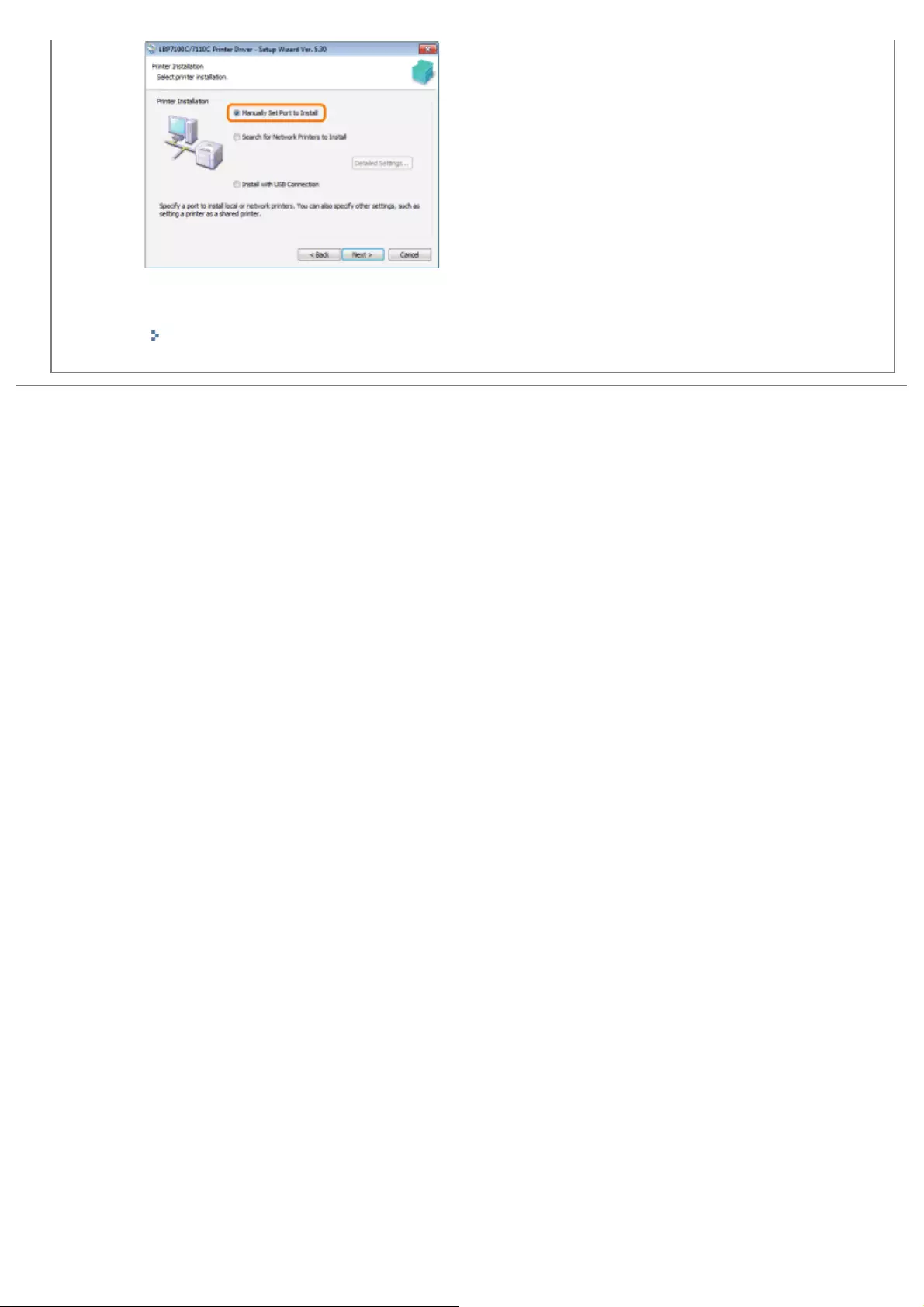Table of Contents
- LBP7100Cn/LBP7110Cw
- Before You Start
- Important Safety Instructions
- About This Printer
- Maintenance
- Printer Installation
- Driver Installation
- Basic Printer Operations
- Printing on Various Types of Paper
- Useful Printing Functions
- Displaying the Setting Screen
- Scaling Print Output
- Layout Printing (N-page Print)
- Printing an Image Larger than A4 (Poster Printing)
- Adding a Watermark to a Document to Be Printed (Watermark Printing)
- Printing Borders, the Printing Date, and so on
- Printing a Color Document in Black and White
- Combining Data before Printing
- Changing the Output Method According to the Print Data or Number of Copies
- Adjusting the Image Quality or Colors
- Registering the Printing Preferences
- Configuring the Network Settings (Sharing the Printer)
- Checking Your Printing Environment
- If You Use the Printer by Direct Connection
- If You Use the Printer in the Print Server Environment
- Managing the Printer
- Security Settings
- Troubleshooting
- Printing Cannot Be Performed
- The Printer Pauses during Printing, and then Printing Repeatedly Starts and Stops
- You Cannot Turn the Printer ON
- All the Indicators on the Network Interface Are Off
- You Cannot Install the Printer Driver
- You Cannot Uninstall the Printer Driver
- The Printer Driver Settings Cannot Be Changed
- "Profiles" Cannot Be Selected or Edited
- Paper Jams
- Indicators on the Printer Are On/Blinking
- A Message Appears in the Printer Status Window
- Poor Printout Results
- Paper Curls
- Paper Creases
- White Streaks (Lines) Appear
- Streaks (lines) Appear in Gradated Portions
- Thin Lateral Streaks (Lateral Lines) Appear
- Printing Is Uneven
- Printed Pages Have White Specks
- Colors Are Uneven or Not Printed Smoothly
- The Toner Does Not Fix onto the Paper Well
- The Printed Paper Has Smudge Marks
- Smudge Marks of Spattering Toner Appear around the Text or Patterns
- The Back of the Printed Paper Has Smudge Marks
- The Overall Print Result Is Dark
- Residual Images Appear on Non-printed Areas
- White Dust Is Attached to the Printed Transparencies
- The Overall Print Result Is Faint
- Printing Is Faded
- Colored Text Appears Blurred
- Data Is Not Printed in the Correct Color (Specified Color) Due to Color Mismatches
- Thin Lines or Fill Patterns Are Not Printed with the Specified Colors or Do Not Appear At All
- Shaded Patterns Are Not Printed in the Correct Color (Specified Color)
- Photographs and so on Are Printed in Different Colors from Those Displayed on the Monitor
- Fill Patterns and Borders Are Not Printed in the Correct Color (Specified Color) Even When the Same Color Is Specified for Them
- Square Areas That Cannot Be Seen on the Display Appear around Lines or Text and Are Printed in a Different Color from the Other Areas
- Adjusting the Color and so on for Printing
- The Printing Position Is Skewed
- A Portion of the Page Is Not Printed (Printed Data Lies Outside Paper)
- Data Is Reduced and Printed
- The Next Page Is Printed from Halfway across the Previous Page
- Blank Paper Is Output (Nothing Is Printed on the Paper)
- The Overall Surface of the Paper Is Printed in a Particular Color
- The Flap of the Printed Envelope Sticks
- Multiple Sheets of Paper Are Fed at a Time
- Printed Bar Codes Cannot Be Scanned
- If You Cannot Solve a Problem
- Appendix
Canon LBP7110Cw User Manual
Displayed below is the user manual for LBP7110Cw by Canon which is a product in the Laser Printers category. This manual has pages.
Related Manuals

㻝㻌㻛㻌㻡㻝㻠

Before You Start 8
Legal Notices 9
Legal Limitations on the Usage of Your Product and the Use of Images 11
Using the e-Manual 12
How to Use the e-Manual 13
Operating Environment 14
Installing the e-Manual 15
Uninstalling the e-Manual 19
Screen Layout of the e-Manual 22
Top Page 23
Topic Page 25
Site Map 26
Search Method 27
Viewing the e-Manual 28
Disclaimers 30
Copyright 31
Trademarks 32
Important Safety Instructions 33
Important Safety Instructions 34
Installation 35
Power Supply 36
Handling 37
Maintenance and Inspections 39
Consumables 41
Wireless LAN Regulatory Information (LBP7110Cw Only) 42
About This Printer 46
Printer Specifications 47
System Requirements for Printing 50
Names and Dimensions of Each Part 51
Control Panel 53
Printer Status Window 56
Introduction of the Utilities 59
Energy-saving Mode 60
Sleep Mode 61
Auto Shutdown 62
Cautions for Handling the Printer 63
Consumables 64
Checking the Consumables Status 65
Maintenance 66
Toner Cartridge Replacement 67
Attention (Toner Cartridge) 69
Replacing the Toner Cartridge 71
Storing Toner Cartridges 75
Moving the Printer 76
Cleaning the Printer 78
Adjusting Colors and Correcting Color Mismatches (Calibration/Color Mismatch Correction) 79
Adjusting Color (Calibration) 80
Correcting Color Mismatches (Color Mismatch Correction) 82
Auto Image Quality Adjustment Settings 84
㻞㻌㻛㻌㻡㻝㻠

Cleaning the Inside of the Printer 86
Cleaning the Fixing Roller of the Printer 87
Cleaning the Transfer Belt of the Printer 89
Cleaning the Outside of the Printer 90
Attention (Cleaning) 92
Location of the Serial Number 93
Printer Installation 94
Attention (Printer Installation) 95
Confirming the Supplied Accessories and Checking the Installation Location 97
Removing the Packing Materials 99
Installing the Printer 103
Driver Installation 105
Installing the Printer Driver 106
Easy Installation 108
Connecting the Printer and Computer 114
Attention (Wired LAN Connection) 117
Attention (Wireless LAN Connection) (LBP7110Cw Only) 118
[Select Printers to Install] Screen 120
[Printer Information] Screen 122
After Installation 125
Uninstalling the Printer Driver 127
Basic Printer Operations 133
Usable Paper 134
Precautions for Paper 137
Printable Area 139
Paper Loading and Output 140
Loading Paper 141
Attention (Paper Loading) 144
Registering the Paper Size and Type 145
Basic Printing Procedure 147
Attention (Basic Printing) 151
How to Use Help 152
Canceling a Job 154
Canceling a Job Being Printed or Waiting to Be Printed from the Computer 155
Canceling a Print Job Being Printed Using the Cancel Job Key 157
Checking the Printer Status 158
Printing on Various Types of Paper 159
Printing on Plain Paper, Heavy Paper, or Index Card 160
Printing on Transparencies (Black and White Printing Only) 161
Printing on Labels 162
Printing on Envelopes 163
Printing on Coated Paper 165
Printing on Custom Size Paper 166
Registering a Custom Paper Size 167
Paper Loading Orientation 169
Useful Printing Functions 170
Displaying the Setting Screen 171
Scaling Print Output 173
Layout Printing (N-page Print) 175
㻟㻌㻛㻌㻡㻝㻠

Printing an Image Larger than A4 (Poster Printing) 177
Adding a Watermark to a Document to Be Printed (Watermark Printing) 179
Adding, Editing, or Deleting a Watermark 181
Printing Borders, the Printing Date, and so on 184
Printing a Color Document in Black and White 186
Combining Data before Printing 188
Changing the Output Method According to the Print Data or Number of Copies 192
Printing with a Gutter 193
Selecting the Paper Output Method 195
Printing with the Page 180 Degrees Rotated 197
Adjusting the Image Quality or Colors 199
Performing Printing Appropriate for Particular Print Data 200
Adjusting the Toner Density 201
Adjusting the Toner Density of Each Color for Each Density Range 203
Printing with Brightness and Contrast Adjusted 205
Adjusting the Color 207
Matching the Color with the Screen 209
Registering the Printing Preferences 212
Changing the Default Values for Printing Preferences 213
Saving Frequently Used Printing Preferences (Adding/Editing/Deleting a "Profile") 215
Selecting a "Profile" 219
Configuring the Network Settings (Sharing the Printer) 220
Checking Your Printing Environment 221
If You Use the Printer by Direct Connection 222
Basic Network Settings 224
Switching Between Wireless LAN and Wired LAN for the Connection (LBP7110Cw Only) 225
Specifying the Connection Settings 226
Setting a Port and Installing the Printer Driver 227
Changing the Network Settings for the Printer 240
Configuring the Protocol Settings 241
Attention (Protocol Settings) 243
IPv4 Settings 245
IPv6 Settings 250
Other Protocol Settings 256
Specifying a Dedicated Port 264
Specifying the Waiting Time Until Connected to the Network 267
Specifying the Wired LAN Communication Mode and Transmission Speed 270
Checking the IP Address of the Printer 273
Checking the MAC Address of the Printer 274
Checking the Wireless LAN Information (LBP7110Cw Only) 275
Configuring and Changing the Port 278
Changing the Port Configuration 284
If You Use the Printer in the Print Server Environment 287
Configuring the Print Server 289
Checking the Settings of Your Network 294
Installation on Clients 296
Installing from the Printer Folder 297
Installing from [Windows Explorer] 304
Managing the Printer 305
㻠㻌㻛㻌㻡㻝㻠

Software That Can Be Used for Managing the Printer 306
Remote UI 307
Starting the Remote UI 308
Attention (Remote UI) 311
Screen Layout of the Remote UI 312
Displaying or Changing the Support Link 315
Changing the Display Language of the Remote UI 318
MF/LBP Network Setup Tool 320
Directly Starting the MF/LBP Network Setup Tool 322
Managing Print Jobs 324
Checking the Printer Settings 327
Printing the "User Data List" 329
Specifying the System Manager Information 330
Specifying the Device Name and Installation Location 333
Specifying the Time Zone and Daylight Saving Time Settings of the Printer 335
Initializing the System Settings 337
Initializing Using the Remote UI 338
Initializing Using the Reset Button 341
Security Settings 342
Restricting the Users Who Can Print and Specify Settings 343
Monitoring/Controlling Devices by SNMP (SNMP Settings) 354
Specifying Keys and Certificates/CA Certificates 360
Creating Keys and Certificates 361
Installing Keys and Certificates/CA Certificates 365
Checking Keys and Certificates/CA Certificates 373
Deleting Keys and Certificates/CA Certificates 379
Initializing Keys and Certificates/CA Certificates 383
Setting the SSL Encrypted Communication Function 385
Attention (SSL Encrypted Communication) 390
Setting IEEE 802.1X Authentication 391
Attention (IEEE 802.1X Authentication) 402
Troubleshooting 403
Printing Cannot Be Performed 404
Printing Cannot Be Performed (USB Connection) 405
Printing Cannot Be Performed (Wired LAN Connection) 408
Printing Cannot Be Performed (Wireless LAN Connection) (LBP7110Cw Only) 413
Printing Cannot Be Performed (via the Print Server) 418
The Print Server for Connection Cannot Be Found 421
The Shared Printer Cannot Be Accessed 422
The Printer Pauses during Printing, and then Printing Repeatedly Starts and Stops 423
You Cannot Turn the Printer ON 424
All the Indicators on the Network Interface Are Off 425
You Cannot Install the Printer Driver 426
The Printer Is Not Recognized Automatically 427
The Printer Cannot Be Searched for 428
You Cannot Uninstall the Printer Driver 430
Starting the Uninstaller from the CD-ROM 431
Uninstalling the USB Class Driver 434
The Printer Driver Settings Cannot Be Changed 437
㻡㻌㻛㻌㻡㻝㻠

"Profiles" Cannot Be Selected or Edited 439
Paper Jams 441
Attention (Paper Jams) 442
Clearing Paper Jams (Paper Drawer) 443
Clearing Paper Jams (Output Area) 445
Clearing Paper Jams (Inside the Rear Cover) 446
Indicators on the Printer Are On/Blinking 447
A Message Appears in the Printer Status Window 449
When <Service Error> Is Displayed 454
Poor Printout Results 456
Paper Curls 458
Paper Creases 460
White Streaks (Lines) Appear 462
Streaks (lines) Appear in Gradated Portions 463
Thin Lateral Streaks (Lateral Lines) Appear 464
Printing Is Uneven 465
Printed Pages Have White Specks 466
Colors Are Uneven or Not Printed Smoothly 467
The Toner Does Not Fix onto the Paper Well 469
The Printed Paper Has Smudge Marks 470
Smudge Marks of Spattering Toner Appear around the Text or Patterns 471
The Back of the Printed Paper Has Smudge Marks 472
The Overall Print Result Is Dark 473
Residual Images Appear on Non-printed Areas 474
White Dust Is Attached to the Printed Transparencies 475
The Overall Print Result Is Faint 476
Printing Is Faded 477
Colored Text Appears Blurred 478
Data Is Not Printed in the Correct Color (Specified Color) Due to Color Mismatches 479
Thin Lines or Fill Patterns Are Not Printed with the Specified Colors or Do Not Appear At All 481
Shaded Patterns Are Not Printed in the Correct Color (Specified Color) 482
Photographs and so on Are Printed in Different Colors from Those Displayed on the Monitor 483
Fill Patterns and Borders Are Not Printed in the Correct Color (Specified Color) Even When the
Same Color Is Specified for Them 484
Square Areas That Cannot Be Seen on the Display Appear around Lines or Text and Are Printed in
a Different Color from the Other Areas 485
Adjusting the Color and so on for Printing 486
The Printing Position Is Skewed 487
A Portion of the Page Is Not Printed (Printed Data Lies Outside Paper) 488
Data Is Reduced and Printed 490
The Next Page Is Printed from Halfway across the Previous Page 491
Blank Paper Is Output (Nothing Is Printed on the Paper) 492
The Overall Surface of the Paper Is Printed in a Particular Color 493
The Flap of the Printed Envelope Sticks 494
Multiple Sheets of Paper Are Fed at a Time 495
Printed Bar Codes Cannot Be Scanned 496
If You Cannot Solve a Problem 497
Appendix 498
Points to Make Full Use of the Printer 499
Basic Operations/Various Information for Windows 501
㻢㻌㻛㻌㻡㻝㻠

0F40-001
Product Name
Safety regulations require the product's name to be registered.
In some regions where this product is sold, the following name(s) in parentheses ( ) may be registered instead.
LBP7100Cn/LBP7110Cw (F163600)
EMC requirements of EC Directive
This equipment conforms with the essential EMC requirements of EC Directive. We declare that this product conforms with
the EMC requirements of EC Directive at nominal mains input 230 V, 50 Hz although the rated input of the product is 220
to 240 V, 50/60 Hz. Use of shielded cable is necessary to comply with the technical EMC requirements of EC Directive.
Laser Safety
This product is certified as a Class 1 laser product under IEC60825-1:2007 and EN60825-1:2007. This means that the
product does not produce hazardous laser radiation.
Since radiation emitted inside the product is completely confined within protective housings and external covers, the laser
beam cannot escape from the machine during any phase of user operation. Do not remove protective housings or external
covers, except as directed by the equipment's manuals.
The label shown below is attached to the laser scanner unit inside the machine.
CLASS 1 LASER PRODUCT
LASER KLASSE 1
APPAREIL À LASER DE CLASSE 1
APPARECCHIO LASER DI CLASSE 1
PRODUCTO LÁSER DE CLASE 1
APARELHO A LASER DE CLASSE 1
LUOKAN 1 LASER-TUOTE
LASERPRODUKT KLASS 1
CAUTION
Use of controls, adjustments, or performance of procedures other than those specified in this manual may result in
hazardous radiation exposure.
International ENERGY STAR Program
Legal Notices
㻥㻌㻛㻌㻡㻝㻠

As an ENERGY STAR® Partner, Canon Inc. has determined that this product meets the ENERGY STAR
Program for energy efficiency.
The International ENERGY STAR Office Equipment Program is an international program that promotes
energy saving through the use of computers and other office equipment.
The program backs the development and dissemination of products with functions that effectively reduce
energy consumption. It is an open system in which business proprietors can participate voluntarily.
The targeted products are office equipment, such as computers, displays, printers, facsimiles, and
copiers. The standards and logos are uniform among participating nations.
WEEE Directive
Only for European Union and EEA (Norway, Iceland and Liechtenstein)
This symbol indicates that this product is not to be disposed of with your household waste, according
to the WEEE Directive (2012/19/EU) and national legislation. This product should be handed over to a
designated collection point, e.g., on an authorized one-for-one basis when you buy a new similar
product or to an authorized collection site for recycling waste electrical and electronic equipment (EEE).
Improper handling of this type of waste could have a possible negative impact on the environment and
human health due to potentially hazardous substances that are generally associated with EEE. At the
same time, your cooperation in the correct disposal of this product will contribute to the effective usage
of natural resources. For more information about where you can drop off your waste equipment for
recycling, please contact your local city office, waste authority, approved WEEE scheme or your
household waste disposal service. For more information regarding return and recycling of WEEE
products, please visit
www.canon-europe.com/weee.
IPv6 Ready Logo
The protocol stack included in this machine has obtained the IPv6 Ready Logo Phase-1 established by
the IPv6 Forum.
㻝㻜㻌㻛㻌㻡㻝㻠

0F40-002
Using your product to scan, print or otherwise reproduce certain documents, and the use of such images as scanned,
printed or otherwise reproduced by your product, may be prohibited by law and may result in criminal and/or civil liability. A
non-exhaustive list of these documents is set forth below. This list is intended to be a guide only. If you are uncertain about
the legality of using your product to scan, print or otherwise reproduce any particular document, and/or of the use of the
images scanned, printed or otherwise reproduced, you should consult in advance with your legal advisor for guidance.
Paper Money
Travelers Checks
Money Orders
Food Stamps
Certificates of Deposit
Passports
Postage Stamps (canceled or uncanceled)
Immigration Papers
Identifying Badges or Insignias
Internal Revenue Stamps (canceled or uncanceled)
Selective Service or Draft Papers
Bonds or Other Certificates of Indebtedness
Checks or Drafts Issued by Governmental Agencies
Stock Certificates
Motor Vehicle Licenses and Certificates of Title
Copyrighted Works/Works of Art without Permission of Copyright Owner
Legal Limitations on the Usage of Your Product and the Use of Images
㻝㻝㻌㻛㻌㻡㻝㻠

0F40-003
Even if you do not have the supplied CD-ROM at hand, you can view the e-Manual any time if you install it on your
computer beforehand.
For the efficient use of the e-Manual, you can use several search tools to find the desired content.
How to Use the e-Manual
Operating Environment
Installing the e-Manual
Uninstalling the e-Manual
Screen Layout of the e-Manual
Top Page
Topic Page
Site Map
Search Method
Viewing the e-Manual
<To find the desired content>
Selecting between the category icons
From the top page, select a category icon you want.
"Top Page"
Searching from the site map
On the site map, you can view the list of whole sections of the e-Manual sorted by category. You can directly
display sections in a category.
"Site Map"
Whole text search function
You can search by keyword in the e-Manual. You can display the desired description from the search results by
entering a keyword you want to search. This function supports AND search.
"Search Method"
Using the e-Manual
㻝㻞㻌㻛㻌㻡㻝㻠

0F40-005
You need a Web browser to use the e-Manual. Operation of the following Web browsers is guaranteed.
Internet Explorer 6.0/7.0/8.0/9.0/10.0
Firefox 2.x/3.x/4.x/5.x/6.x/7.x/8.x/9.x/10.x/11.x/13.x/14.x/15.x/16.x/17.x/18.x/19.x
NOTE
Enabling the script function and cookies
Enable the script function and cookies for the Web browser before using the e-Manual.
Operating Environment
㻝㻠㻌㻛㻌㻡㻝㻠

0F40-006
Install the e-Manual included in the supplied CD-ROM on your computer using the following procedure.
This function is not supported for Macintosh.
1
Insert the supplied CD-ROM "User Software" into the CD-ROM drive of your computer.
2
Click [Custom Installation].
If the above screen does not appear
"Basic Operations/Various Information for Windows"
If the [AutoPlay] dialog box appears
Click [Run AUTORUN.EXE].
If the [User Account Control] dialog box appears
Click [Yes] or [Continue].
3
Perform the following procedure.
(1) Clear the [MF/LBP Network Setup Tool] and [Printer Driver] check boxes.
Installing the e-Manual
㻝㻡㻌㻛㻌㻡㻝㻠

(2) Click [Start].
4
Read the contents of License Agreement, and then click [Yes].
ĺThe installation starts.
Wait a moment until the installation is complete. (It may take a long time to install the e-Manual.)
5
Click [Exit].
㻝㻢㻌㻛㻌㻡㻝㻠

6
Click [Next].
7
Click [Exit].
When the following screen appears, you can remove the CD-ROM.
Displaying the e-Manual
Double-click [LBP7100C 7110C e-Manual] created on the desktop.
㻝㻣㻌㻛㻌㻡㻝㻠

When a security protection message appears
Perform the following procedure.
1. Click the information bar, and then select [Allow Blocked Content] from the pop-up menu.
2. Click [Yes].
NOTE
Displaying the e-Manual directly from the CD-ROM
You can also display the e-Manual directly from the CD-ROM without installing it in the computer you are using.
1. Insert the supplied CD-ROM "User Software" into the CD-ROM drive of your computer.
2. Click [Display Manuals].
3. Click [ ] button next to [e-Manual].
Depending on the operating system you are using, a security protection message is displayed.
Allow the contents to be displayed.
㻝㻤㻌㻛㻌㻡㻝㻠

0F40-007
The process of removing the e-Manual to restore the computer to the same state as before the e-Manual was installed is
referred to as uninstallation. To uninstall the e-Manual, perform the following procedure.
This function is not supported for Macintosh.
1
Insert the supplied CD-ROM "User Software" into the CD-ROM drive of your computer.
2
Click [Additional Software Programs].
If the above screen does not appear
"Basic Operations/Various Information for Windows"
If the [AutoPlay] dialog box appears
Click [Run AUTORUN.EXE].
If the [User Account Control] dialog box appears
Click [Yes] or [Continue].
3
Click [Start] in [Manual Uninstaller].
Uninstalling the e-Manual
㻝㻥㻌㻛㻌㻡㻝㻠

4
Click [Uninstall] to start the uninstallation.
Please wait a moment until the uninstallation is complete. (It may take a long time to uninstall the e-Manual.)
5
Click [Exit].
6
Click [Back].
㻞㻜㻌㻛㻌㻡㻝㻠

7
Click [Exit].
When the following screen appears, you can remove the CD-ROM.
㻞㻝㻌㻛㻌㻡㻝㻠

0F40-008
This section describes the screen layout of the e-Manual.
The page displayed right after the e-Manual starts is called "Top Page" and the manual description is called "Topic Page"
in this section.
"Site map" is displayed from [Site map] which is located on the upper right of the e-Manual.
The search panel is used to make search through the e-Manual.
The screen layout is different for each page, so click the following links to see the instruction.
Top Page
Topic Page
Site Map
Search Method
Screen Layout of the e-Manual
㻞㻞㻌㻛㻌㻡㻝㻠

0F40-009
(1) [Handling the Printer]
This section describes the precautions and maintenance methods for handling the printer, and so on.
(2) [Printing]
This section describes a variety of printing methods, such as basic printing and advanced one that uses the various
printing functions.
How to load paper is also described here.
(3) [Configuring and Managing the Printer]
This section describes how to specify the network settings, how to manage the printer, and so on.
(4) [Frequently Asked Questions]
Frequently asked questions are featured.
For details on the solutions for the other problems, see [Troubleshooting].
(5) [Installation]
This section describes how to install this printer, how to install the printer driver, and so on.
(6) [Search]
The search panel is displayed by entering keyword(s) and clicking [ ].
For details, see "Search Method."
(7) [Points to Make Full Use of the Printer]
This section describes software tasks and functions supplied with the printer to maximize the use of the printer.
(8) [For Macintosh Users]
Precautions when using Macintosh are explained.
(9) [Top]
The top page of the e-Manual is displayed.
(10) [Site map]
The entire contents of the e-Manual are displayed.
(11) [Help]
How to use the e-Manual is displayed.
(12) [Disclaimers]
The disclaimers are displayed.
(13) [Copyright]
Top Page
㻞㻟㻌㻛㻌㻡㻝㻠

The information of copyrights is displayed.
(14) [Trademarks]
The trademarks are displayed.
(15) [Third Party Software]
The information about the third party software is displayed.
(16) [Office Locations]
Inquiries for this printer are displayed.
㻞㻠㻌㻛㻌㻡㻝㻠

0F40-00A
(1) Chapter contents
This is the list of the contents in the chapter. Clicking each item displays the description in the topic page.
Click [ ] to expand a menu, and click [ ] to collapse a menu.
Alternatively, click [ Expand all] to expand all menus, and click [ Collapse all] to collapse all menus.
(2) Topic page
The descriptions of each item are displayed.
The current location of the displayed topic is displayed at the upper left of the topic page. Click a link to move to a
higher level.
(3) [Chapter] menu
You can select a different chapter from the pull-down menu.
(4) [Contents] tab
Click to display the chapter contents panel.
(5) [Search] tab
Click to display the search panel.
For details, see "Search Method."
(6) [ ]
Click to display or hide the chapter contents panel/search panel.
(7) [Previous]/[Next]
Click to move to the previous or next topic.
(8) [Print this topic]
Prints only the topic page currently displayed.
(9) [Print all]
Prints all the contents in a chapter.
Topic Page
㻞㻡㻌㻛㻌㻡㻝㻠

0F40-00C
(1) Categories
Shows the chapters of the e-Manual. Click an item to view the detailed list of the chapter.
(2) Whole contents
Shows the all chapters and sections of the e-Manual. Click an item to view the contents.
Site Map
㻞㻢㻌㻛㻌㻡㻝㻠

0F40-00E
(1) Search
Entering a character string in [Search] on the top page or in the [Keyword] text box on the search panel and then
clicking [ ] displays the search results.
The AND search is available in the e-Manual so you can refine the search results by entering two or more
keywords. When entering keywords, enter a space between the keywords.
Example: Toner Replacement (if you want to display pages which include words, "Toner" and "Replacement")
(2) Search result
The search results for a keyword are displayed.
If there are more than 10 search results, you can see the other results by clicking [ ], [ ], or the number
which is located below the result.
(3) [Search options]
Click to display the search options.
The search options can be used to specify the chapter to search, case sensitivity, and whether to differentiate
between one- and two-byte characters.
Click [Search with these conditions] to search with the specified conditions.
Search Method
㻞㻣㻌㻛㻌㻡㻝㻠

0F40-00F
Symbols Used in the e-Manual
The following are descriptions of warnings and cautions used in the e-Manual to explain handling restrictions, precautions,
and instructions that should be observed for your safety.
WARNING
Indicates a warning concerning operations that may lead to death or injury to persons if not performed correctly. To use
the machine safely, always pay attention to these warnings.
CAUTION
Indicates a caution concerning operations that may lead to injury to persons if not performed correctly. To use the
machine safely, always pay attention to these cautions.
IMPORTANT
Indicates operational requirements and restrictions. Be sure to read these items carefully to operate the machine
correctly, and avoid damage to the machine or property.
NOTE
Indicates a clarification of an operation, or contains additional explanations for a procedure. Reading these notes is highly
recommended.
Indicates an operation that must not be performed. Read these items carefully, and make sure not to perform the
described operations.
Keys and Buttons Used in This Manual
The following are examples of how control panel keys and on-screen buttons are depicted in the e-Manual.
Type Depiction in the e-Manual Example
Control panel keys [Key icon] + (Key name)[] (Cancel Job)
Buttons on
computer operation
screen and so on
[Button name and so on] [OK]
Screenshots Used in the e-Manual
The contents of the screenshots used in the e-Manual are the default settings.
Depending on the system configuration, the contents of the screenshots may partly differ.
The functions of the printer driver may be changed due to upgrade.
Illustrations Used in the e-Manual
The illustrations used in the e-Manual are those for the LBP7110Cw unless mentioned otherwise.
Though not shown in the illustrations in this manual, the control panels are labeled with names in certain countries
or regions.
Viewing the e-Manual
㻞㻤㻌㻛㻌㻡㻝㻠

Although the power cord used in this manual is as the one in the following illustration, the form of the power cord may
differ depending on the country or region.
About the Supplied CD-ROM
Although the e-Manual states that this printer is supplied with CD-ROMs, in certain countries or regions the printer is
supplied with a DVD-ROM in place of CD-ROMs.
If your printer is supplied with a DVD-ROM, please take each mention of "the supplied CD-ROM" or "the supplied CD-
ROMs" in this manual as referring to "the supplied DVD-ROM."
Abbreviations Used in the e-Manual
Abbreviations of Operating Systems
In the e-Manual, operating systems are abbreviated as follows.
Microsoft Windows XP operating system Windows XP
Microsoft Windows Vista operating system Windows Vista
Microsoft Windows 7 operating system Windows 7
Microsoft Windows Server 2003 operating system Windows Server 2003
Microsoft Windows Server 2008 operating system Windows Server 2008
Microsoft Windows operating system Windows
㻞㻥㻌㻛㻌㻡㻝㻠

0F40-00H
The information in this manual is subject to change without notice.
CANON INC. MAKES NO WARRANTY OF ANY KIND WITH REGARD TO THIS MATERIAL, EITHER EXPRESS OR
IMPLIED, EXCEPT AS PROVIDED HEREIN, INCLUDING WITHOUT LIMITATION, THEREOF, WARRANTIES AS TO
MARKETABILITY, MERCHANTABILITY, FITNESS FOR A PARTICULAR PURPOSE OF USE OR AGAINST
INFRINGEMENT OF ANY PATENT. CANON INC. SHALL NOT BE LIABLE FOR ANY DIRECT, INCIDENTAL, OR
CONSEQUENTIAL DAMAGES OF ANY NATURE, OR LOSSES OR EXPENSES RESULTING FROM THE USE OF
THIS MATERIAL.
Disclaimers
㻟㻜㻌㻛㻌㻡㻝㻠

0F40-00J
Copyright 2013 by Canon Inc. All rights reserved.
No part of this publication may be reproduced or transmitted in any form or by any means, electronic or mechanical,
including photocopying and recording, or by any information storage or retrieval system without the prior written
permission of Canon Inc.
Copyright
㻟㻝㻌㻛㻌㻡㻝㻠

0F40-00K
Canon, the Canon logo, LBP, and PageComposer are trademarks of Canon Inc.
Adobe, Adobe Acrobat, and Adobe Reader are trademarks of Adobe Systems Incorporated.
Apple, Mac, Mac OS, OS X, and Macintosh are trademarks of Apple Inc.
Microsoft, Windows, Windows Vista, Windows Server and Internet Explorer are either registered trademarks or
trademarks of Microsoft Corporation in the United States and/or other countries.
Ethernet is a trademark of Xerox Corporation.
Other product and company names herein may be the trademarks of their respective owners.
Trademarks
㻟㻞㻌㻛㻌㻡㻝㻠

0F40-00L
Read these "Important Safety Instructions" thoroughly before operating the printer.
As these instructions are intended to prevent injury to the user and other persons or destruction of property, always pay
attention to these instructions.
Also, as it may result in unexpected accidents or injuries, do not perform any operation unless otherwise specified in the
manual. Improper operation or use of this machine could result in personal injury and/or damage requiring extensive repair
that may not be covered under your Limited Warranty.
Important Safety Instructions
Wireless LAN Regulatory Information (LBP7110Cw Only)
Important Safety Instructions
㻟㻟㻌㻛㻌㻡㻝㻠

0F40-00S
WARNING
Do not install the printer in a location near alcohol, paint thinner, or other flammable substances. If flammable
substances come into contact with electrical parts inside the printer, this may result in a fire or electrical shock.
Do not place the following items on the printer.
Necklaces and other metal objects
Cups, vases, flowerpots, and other containers filled with water or liquids
If these items come into contact with a high-voltage area inside the printer, this may result in a fire or electrical shock.
If these items are dropped or spilled inside the printer, immediately turn OFF the power switch (1) and disconnect the
interface cables if they are connected (2). Then, unplug the power plug from the AC power outlet (3) and contact your
local authorized Canon dealer.
CAUTION
Do not install the printer in unstable locations, such as on unsteady platforms or inclined floors, or in locations
subject to excessive vibrations, as this may cause the printer to fall or tip over, resulting in personal injury.
The ventilation slots are provided for proper ventilation of working parts inside the printer. Never place the printer on
a soft surface, such as a bed, sofa, or rug. Blocking the slots can cause the printer to overheat, resulting in a fire.
Do not install the printer in the following locations, as this may result in a fire or electrical shock.
A damp or dusty location
A location exposed to smoke and steam, such as near a cookery or humidifier
A location exposed to rain or snow
A location near a water faucet or water
A location exposed to direct sunlight
A location subject to high temperatures
A location near open flames
When installing the printer, gently lower the printer to the installation site so as not to catch your hands between the
printer and the floor or between the printer and other equipment, as this may result in personal injury.
When connecting the interface cable, connect it properly by following the instructions in the e-Manual. If not
connected properly, this may result in malfunction or electrical shock.
When moving the printer, follow the instructions in the e-Manual to hold it correctly. Failure to do so may cause you
to drop the printer, resulting in personal injury.
"Moving the Printer"
IMPORTANT
At high altitudes of about 3,000 meters above sea level, or higher
Machines with a hard disk may not operate properly when used at high altitudes of about 3,000 meters above sea level,
or higher.
Installation
㻟㻡㻌㻛㻌㻡㻝㻠

0F40-00U
WARNING
Do not damage or modify the power cord. Also, do not place heavy objects on the power cord or pull on or
excessively bend it, as this can cause electrical damage, resulting in fire or electrical shock.
Keep the power cord away from all heat sources. Failure to do so can cause the power cord insulation to melt,
resulting in a fire or electrical shock.
The power cord should not be taut, as this may lead to a loose connection and cause overheating, which could
result in a fire.
The power cord may become damaged if it is stepped on, fixed with staples, or if heavy objects are placed on it.
Continued use of a damaged power cord can lead to an accident, such as a fire or electrical shock.
Do not plug or unplug the power plug with wet hands, as this can result in electrical shock.
Do not plug the power cord into a multi-plug power strip, as this can result in a fire or electrical shock.
Do not bundle up or tie up the power cord in a knot, as this can result in a fire or electrical shock.
Insert the power plug completely into the AC power outlet. Failure to do so can result in a fire or electrical shock.
If excessive stress is applied to the connection part of the power cord, it may damage the power cord or the wires
inside the machine may disconnect. This could result in a fire. Avoid the following situations:
Connecting and disconnecting the power cord frequently.
Tripping over the power cord.
The power cord is bent near the connection part, and continuous stress is being applied to the power outlet or the
connection part.
Applying a shock to the power connector.
Do not use power cords other than the one provided, as this can result in a fire or electrical shock.
As a general rule, do not use extension cords. Using an extension cord may result in a fire or electrical shock.
CAUTION
Do not use a power supply voltage other than that listed herein, as this may result in a fire or electrical shock.
Always grasp the power plug when unplugging the power plug. Do not pull on the power cord, as this may expose
the core wire of the power cord or damage the cord insulation, causing electricity to leak, resulting in a fire or
electrical shock.
Leave sufficient space around the power plug so that it can be unplugged easily. If objects are placed around the
power plug, you may be unable to unplug it in an emergency.
Power Supply
㻟㻢㻌㻛㻌㻡㻝㻠

0F40-00W
WARNING
Do not disassemble or modify the printer. There are high-temperature and high-voltage components inside the
printer which may result in a fire or electrical shock.
Electrical equipment can be hazardous if not used properly. Do not allow children to touch the power cord, cables,
internal gears, or electrical parts.
If the printer makes an unusual noise or emits smoke, heat, or an unusual smell, immediately turn OFF the power
switch and disconnect the interface cables if they are connected. Then, unplug the power plug from the AC power
outlet and contact your local authorized Canon dealer. Continued use can result in a fire or electrical shock.
Do not use flammable sprays near the printer. If flammable substances come into contact with electrical parts inside
the printer, this may result in a fire or electrical shock.
Always turn OFF the power switch and unplug the power plug and interface cables before moving the printer.
Failure to do so can damage the cables or cords, resulting in a fire or electrical shock.
Confirm that the power plug or power connecter is inserted completely after moving the printer. Failure to do so can
result in an overheating and fire.
Do not drop paper clips, staples, or other metal objects inside the printer. Also, do not spill water, liquids, or other
flammable substances (alcohol, benzene, paint thinner, and so on) inside the printer. If these items come into
contact with a high-voltage area inside the printer, this may result in a fire or electrical shock. If these items are
dropped or spilled inside the printer, immediately turn OFF the power switch and disconnect the interface cables if
they are connected. Then, unplug the power plug from the AC power outlet and contact your local authorized Canon
dealer.
When plugging or unplugging a USB cable when the power plug is plugged into an AC power outlet, do not touch
the metal part of the connector, as this can result in electrical shock.
CAUTION
Do not place heavy objects on the printer. The object or the printer may fall, resulting in personal injury.
Turn OFF the power switch when the printer will not be used for a long period of time, such as overnight. Turn OFF
the printer and unplug the power plug if the printer will not be used for an extended period of time, such as for
several days.
Open or close covers and install or remove drawers gently and carefully. Be careful not to hurt your fingers.
Keep your hands and clothing away from the roller in the output area. Even if the printer is not printing, the roller
may suddenly rotate and catch your hands or clothing, resulting in personal injury.
The output slot is hot during and immediately after printing. Do not touch the area surrounding the output slot, as
this may result in burns.
Printed paper may be hot immediately after being output. Be careful when removing the paper and aligning the
removed paper, especially after continuous printing. Failure to do so may result in burns.
The laser beam used in the printer can be harmful to human bodies. The laser beam is confined in the laser
scanner unit by a cover, so there is no danger of the laser beam escaping during normal printer operation. Read the
following remarks and instructions for safety.
Never open covers other than those indicated in this manual.
Do not remove the caution label attached to the cover of the laser scanner unit.
Handling
㻟㻣㻌㻛㻌㻡㻝㻠

If the laser beam should escape and enter your eyes, exposure may cause damage to your eyes.
㻟㻤㻌㻛㻌㻡㻝㻠

0F40-00X
WARNING
When cleaning the printer, turn OFF the printer and computer, remove the interface cables, and then unplug the
power plug. Failure to do so can result in a fire or electrical shock.
Unplug the power plug from the AC power outlet periodically and clean the area around the base of the power
plug's metal pins and the AC power outlet with a dry cloth to remove all dust and grime. In damp, dusty, or smoky
locations, dust can build up around the power plug and become damp, which can cause a short circuit, resulting in
a fire.
Clean the printer with a well wrung out cloth dampened with water or mild detergent diluted with water. Do not use
alcohol, benzene, paint thinner, or other flammable substances. If flammable substances come into contact with
electrical parts inside the printer, this may result in a fire or electrical shock.
Some areas inside the printer are subject to high voltage. When removing jammed paper or when inspecting the
inside of the printer, be careful not to allow necklaces, bracelets, or other metal objects to touch the inside of the
printer, as this can result in burns or electrical shock.
Do not dispose of used toner cartridges in open flames. This may cause the toner remaining inside the cartridges to
ignite, resulting in burns or fire.
If you accidentally spill or scatter toner, carefully gather the toner particles together or wipe them up with a soft,
damp cloth in a way that prevents inhalation.
Never use a vacuum cleaner that does not have safeguards against dust explosions to clean up spilled toner. Doing
so may cause a malfunction in the vacuum cleaner, or result in a dust explosion due to static discharge.
Confirm that the power plug or power connecter is inserted completely after cleaning the printer. Failure to do so
can result in an overheating and fire.
Check the power cord and plug regularly. The following conditions may result in fire, so contact your local authorized
Canon dealer or the Canon help line.
There are burn marks on the power plug.
The blade on the power plug is deformed or broken.
The power is turned OFF or ON when bending the power cord.
The coating of the power cord is damaged, cracked, or dented.
A part of the power cord becomes hot.
Check regularly that the power cord and plug are not handled in the following manner. Failure to do so can result in
a fire or electrical shock.
The power connector is loosened.
Stress is being applied to the power cord by a heavy object or by fixing it with staples.
The power plug is loosened.
The power cord is tied in a bundle.
A part of the power cord is put in an aisle.
The power cord is put in front of the heating appliance.
CAUTION
Never attempt to service this printer yourself, except as explained in this manual. There are no user serviceable
parts inside the printer. Adjust only those controls that are covered in the operating instructions. Improper
adjustment could result in personal injury and/or damage requiring extensive repair that may not be covered under
your Limited Warranty.
The fixing unit and its surroundings inside the printer become hot during use. When removing jammed paper or
Maintenance and Inspections
㻟㻥㻌㻛㻌㻡㻝㻠

when inspecting the inside of the printer, do not touch the fixing unit and its surroundings, as this may result in
burns.
When removing jammed paper or when inspecting the inside of the machine, do not expose yourself to the heat
emitted from the fixing unit and its surroundings for a prolonged period of time. Doing so may result in low
temperature burns, even though you did not touch the fixing unit and its surroundings directly, as this may result in
burns.
If paper is jammed, remove the jammed paper so that any pieces of paper do not remain inside the printer
according to the displayed message. Also, do not put your hands forcibly into the parts other than those directed on
the screen. Failure to do so may result in burns or injuries.
When removing jammed paper or replacing a toner cartridge, be careful not to get any toner on your hands or
clothing, as this will dirty your hands or clothing. If toner gets on your hands or clothing, wash them immediately
with cold water. Washing with warm water sets the toner, making it impossible to remove the toner stains.
When removing jammed paper, be careful not to allow the toner on the paper to scatter. The toner may get into
your eyes or mouth. If toner gets into your eyes or mouth, wash them immediately with cold water and consult a
physician.
When loading paper or removing jammed paper, be careful not to cut your hands with the edges of the paper.
When removing a toner cartridge, remove the toner cartridge carefully so as to prevent the toner from scattering and
getting into your eyes or mouth. If toner gets into your eyes or mouth, wash them immediately with cold water and
consult a physician.
Do not attempt to disassemble the toner cartridge. The toner may scatter and get into your eyes or mouth. If toner
gets into your eyes or mouth, wash them immediately with cold water and consult a physician.
If toner leaks from the toner cartridge, be careful not to inhale the toner or allow it to come into direct contact with
your skin. If the toner comes into contact with your skin, wash with soap. If the skin becomes irritated or you inhale
the toner, consult a physician immediately.
㻠㻜㻌㻛㻌㻡㻝㻠

0F40-00Y
WARNING
Do not dispose of used toner cartridges in open flames. This may cause the toner to ignite, resulting in burns or fire.
Do not store toner cartridges or paper in a location exposed to open flames. This may cause the toner or paper to
ignite, resulting in burns or fire.
When disposing of a toner cartridge, place the toner cartridge into a bag to prevent the toner from scattering, and
then dispose of the toner cartridge according to local regulations.
If you accidentally spill or scatter toner, carefully gather the toner particles together or wipe them up with a soft,
damp cloth in a way that prevents inhalation.
Never use a vacuum cleaner that does not have safeguards against dust explosions to clean up spilled toner. Doing
so may cause a malfunction in the vacuum cleaner, or result in a dust explosion due to static discharge.
CAUTION
Keep the toner cartridges and other consumables out of the reach of small children. If the toner or other parts are
ingested, consult a physician immediately.
Do not attempt to disassemble the toner cartridge. The toner may scatter and get into your eyes or mouth. If toner
gets into your eyes or mouth, wash them immediately with cold water and consult a physician.
If toner leaks from the toner cartridge, be careful not to inhale the toner or allow it to come into direct contact with
your skin. If the toner comes into contact with your skin, wash with soap. If the skin becomes irritated or you inhale
the toner, consult a physician immediately.
If the sealing tape is pulled out forcefully or stopped at midpoint, toner may spill out. If the toner gets into your eyes
or mouth, wash them immediately with cold water and immediately consult a physician.
Consumables
㻠㻝㻌㻛㻌㻡㻝㻠

0F40-010
i-SENSYS LBP7110Cw includes approved Wireless LAN Module (Model name: FM48944).
Regulatory information
Users in the European Union and other European countries
R&TTE Declaration of Conformity (Wireless LAN Module)
ýHVN\>&]HFK@ 6SROHþQRVW&$121,1&WtPWRSURKODãXMHåH]DĜt]HQt)0MHYVRXODGXVH]iNODGQtPL
SRåDGDYN\DGDOãtPLSĜtVOXãQêPLXVWDQRYHQtPLVPČUQLFH(6
Dansk [Danish] Undertegnede CANON INC. erklærer herved, at FM48944 overholder de væsentlige krav og
øvrige relevante krav i direktiv 1999/5/EF.
Deutsch [German]
Hiermit erklärt CANON INC., dass sich das Gerät FM48944 in Übereinstimmung mit den
grundlegenden Anforderungen und den übrigen einschlägigen Bestimmungen der Richtlinie
1999/5/EG befindet.
Eesti [Estonian] Käesolevaga kinnitab CANON INC. seadme FM48944 vastavust direktiivi 1999/5/EÜ olulistele
nõuetele ja muudele asjakohastele sätetele.
English Hereby, CANON INC., declares that FM48944 is in compliance with the essential requirements
and other relevant provisions of Directive 1999/5/EC.
Español [Spanish] Por medio de la presente CANON INC. declara que el FM48944 cumple con los requisitos
esenciales y cualesquiera otras disposiciones aplicables o exigibles de la Directiva 1999/5/CE.
ǼȜȜȘȞȚțȒ>*UHHN@ ȂİIJȘȞʌĮȡȠȪıĮȘ&$121,1&įȘȜȫȞİȚȩIJȚIJȠȝȠȞIJȑȜȠ)0ıȣȝȝȠȡijȫȞİIJĮȚʌȡȠȢIJȚȢ
ȠȣıȚȫįİȚȢĮʌĮȚIJȒıİȚȢțĮȚIJȚȢȜȠȚʌȑȢıȤİIJȚțȑȢįȚĮIJȐȟİȚȢIJȘȢȅįȘȖȓĮȢǼȀ
Français [French] Par la présente, CANON INC. déclare que l’appareil FM48944 est conforme aux exigences
essentielles et aux autres dispositions pertinentes de la directive 1999/5/CE.
Italiano [Italian] Con la presente CANON INC. dichiara che FM48944 è conforme ai requisiti essenziali ed alle
altre disposizioni pertinenti stabilite dalla direttiva 1999/5/CE.
Latviski [Latvian] $UãR&$121,1&GHNODUƝND)0DWELOVW'LUHNWƯYDV(.EnjWLVNDMƗPSUDVƯEƗPXQ
FLWLHPDUWRVDLVWƯWDMLHPQRWHLNXPLHP
/LHWXYLǐ>/LWKXDQLDQ@ âLXREHQGURYơÄ&$121,1&³GHNODUXRMDNDG)0DWLWLQNDSDJULQGLQLXV'LUHNW\YRMH
(%LãGơVW\WXVUHLNDODYLPXVLUNLWDVMRVQXRVWDWDV
Nederlands [Dutch] Hierbij verklaart CANON INC. dat FM48944 in overeenstemming is met de essentiële eisen en
de andere relevante bepalingen van richtlijn 1999/5/EG.
Malti [Maltese] +DZQKHNN&$121,1&MLGGLNMDUDOLO)0MLNNRQIRUPDPDOƫWLƥLMLHWHVVHQ]MDOLXPD¶
GLVSRĪL]]MRQLMLHWUHOHYDQWLRƫUDWDG'LUHWWLYD.(
Magyar [Hungarian] $OXOtURWW&$121,1&Q\LODWNR]RPKRJ\D)0PHJIHOHODYRQDWNR]yDODSYHWĘ
N|YHWHOPpQ\HNQHNpVD](&LUiQ\HOYHJ\pEHOĘtUiVDLQDN
Polski [Polish] 1LQLHMV]\P&$121,1&RĞZLDGF]DĪHPRGHO)0MHVW]JRGQ\]]DVDGQLF]\PLZ\PRJDPL
RUD]SR]RVWDá\PLVWRVRZQ\PLSRVWDQRZLHQLDPL'\UHNW\Z\(&
Português
[Portuguese]
Por este documento, a CANON INC. declara que o FM48944 está em conformidade com os
requisitos essenciais e outras disposições relevantes da Diretiva 1999/5/CE.
6ORYHQãþLQD
[Slovenian]
Družba CANON INC. izjavlja, da je tiskalnik FM48944 skladni z bistvenimi zahtevami in ostalimi
UHOHYDQWQLPLGRORþLOLGLUHNWLYH(6
Slovensky [Slovak] &$121,1&WêPWRY\KODVXMHåH)0VSĎĖD]iNODGQpSRåLDGDYN\DYãHWN\SUtVOXãQp
ustanovenia Smernice 1999/5/ES.
Suomi [Finnish] CANON INC. vakuuttaa täten, että FM48944 -laite on direktiivin 1999/5/ EY oleellisten
vaatimusten ja sitä koskevien direktiivin muiden ehtojen mukainen.
Wireless LAN Regulatory Information (LBP7110Cw Only)
㻠㻞㻌㻛㻌㻡㻝㻠

Svenska [Swedish] Härmed intygar CANON INC. att denna FM48944 står i överensstämmelse med de väsentliga
egenskapskrav och övriga relevanta bestämmelser som framgår av direktiv 1999/5/EG.
5RPkQă
[Romanian]
3ULQSUH]HQWD&$121,1&GHFODUăIDSWXOFăDSDUDWXO)0HVWHvQFRQIRUPLWDWHFX
FHULQĠHOHHVHQĠLDOHúLFXDOWHSUHYHGHULUHOHYDQWHLQFOXVHvQ'LUHFWLYD&(
Ȼɴɥɝɚɪɫɤɢɟɡɢɤ
[Bulgarian]
ɋɧɚɫɬɨɹɳɟPɨ&$121,1&ɞɟɤɥɚɪɢɪɚɱɟ)0ɨɬɝɨɜɚɪɹɧɚɫɴɳɟɫɬɜɟɧɢɬɟ
ɢɡɢɫɤɜɚɧɢɹɢɞɪɭɝɢɬɟɩɪɢɥɨɠɢɦɢɢɡɢɫɤɜɚɧɢɹɧɚȾɢɪɟɤɬɢɜɚȿɋ
Íslenska [Icelandic] Hér með lýsir CANON INC. því yfir að FM48944 sé í samræmi við grunnkröfur og aðrar kröfur,
sem gerðar eru í tilskipun 1999/5/EC.
Norsk [Norwegian] CANON INC. erklærer herved at utstyret FM48944 er i samsvar med de grunnleggende krav og
øvrige relevante krav i direktiv 1999/5/EF.
Gaeilge [Irish] Dearbhaíonn CANON INC. leis seo go gcloíonn FM48944 le ceanglais riachtanacha agus le
forálacha ábhartha eile na Treorach 1999/5/CE.
ýHVN\>&]HFK@
7RWR]DĜt]HQtPĤåHEêWSURYR]RYiQRQD~]HPt$7%(%*&+&<&='('.(((6),
FR, GB, GR, HU, IE, IS, IT, LI, LT, LU, LV, MT, NL, NO, PL, PT, RO, SE, SI, SK.* Poznámky
týkající se použití tohoto produktu.
㻠㻟㻌㻛㻌㻡㻝㻠

)UDQFLH7HQWRSURGXNWQHO]HSRXåtYDWPLPRX]DYĜHQpSURVWRU\
Dansk [Danish]
* Dette produkt må anvendes i AT, BE, BG, CH, CY, CZ, DE, DK, EE, ES, FI, FR, GB, GR,
HU, IE, IS, IT, LI, LT, LU, LV, MT, NL, NO, PL, PT, RO, SE, SI, SK.* Bemærkninger for
anvendelse af dette produkt.
Frankrig: Dette produkt kan ikke anvendes udendøre.
Deutsch [German]
* Dieses Gerät darf in folgenden Ländern betrieben werden AT, BE, BG, CH, CY, CZ, DE, DK,
EE, ES, FI, FR, GB, GR, HU, IE, IS, IT, LI, LT, LU, LV, MT, NL, NO, PL, PT, RO, SE, SI, SK.*
Hinweise zur Verwendung dieses Produkts.
Frankreich: Dieses Produkt darf nicht im Freien verwendet werden.
Eesti [Estonian]
* Seda seadet võib kasutada AT, BE, BG, CH, CY, CZ, DE, DK, EE, ES, FI, FR, GB, GR, HU,
IE, IS, IT, LI, LT, LU, LV, MT, NL, NO, PL, PT, RO, SE, SI, SK.* Teadaanne selle toote
kasutamise kohta.Prantsusmaa: seda toodet saab kasutada vaid siseruumides.
English
* This equipment may be operated in AT, BE, BG, CH, CY, CZ, DE, DK, EE, ES, FI, FR, GB,
GR, HU, IE, IS, IT, LI, LT, LU, LV, MT, NL, NO, PL, PT, RO, SE, SI, SK.* Notice for use of this
product.France : This product cannot be used outdoors.
Español [Spanish]
* Este equipo puede ser utilizado en AT, BE, BG, CH, CY, CZ, DE, DK, EE, ES, FI, FR, GB,
GR, HU, IE, IS, IT, LI, LT, LU, LV, MT, NL, NO, PL, PT, RO, SE, SI, SK.* Aviso relativo al uso
de este producto.Francia: este producto no puede utilizarse en exteriores.
Français [French]
* Cet équipement peut être utilisable en AT, BE, BG, CH, CY, CZ, DE, DK, EE, ES, FI, FR, GB,
GR, HU, IE, IS, IT, LI, LT, LU, LV, MT, NL, NO, PL, PT, RO, SE, SI, SK.
* Avis concernant l’utilisation de ce produit.France : Ce produit ne peut pas être utilisé à
l’extérieur.
Italiano [Italian]
* Questo dispositivo può essere utilizzato in AT, BE, BG, CH, CY, CZ, DE, DK, EE, ES, FI, FR,
GB, GR, HU, IE, IS, IT, LI, LT, LU, LV, MT, NL, NO, PL, PT, RO, SE, SI, SK.
* Nota per l’uso del prodotto.Francia: il prodotto non può essere utilizzato all’aperto.
Latviski [Latvian]
âRDSUƯNRMXPXGUƯNVWOLHWRW$7%(%*&+&<&='('.(((6),)5*%*5+8
IE, IS, IT, LI, LT, LU, LV, MT, NL, NO, PL, PT, RO, SE, SI, SK.
3LH]ƯPHVSDUãƯL]VWUƗGƗMXPDOLHWRãDQX)UDQFLMDãRL]VWUƗGƗMXPXQHGUƯNVWOLHWRWƗUSXVWHOSƗP
/LHWXYLǐ>/LWKXDQLDQ@
âƳƳUHQJLQƳJDOLPDHNVSORDWXRWL$7%(%*&+&<&='('.(((6),)5*%*5
HU, IE, IS, IT, LI, LT, LU, LV, MT, NL, NO, PL, PT, RO, SE, SI, SK.
3DVWDEDDSLHãLRSURGXNWRQDXGRMLPą3UDQFnj]LMDãLRSURGXNWRQHJDOLPDQDXGRWLODXNH
Nederlands [Dutch]
* Deze apparatuur kan worden gebruikt in de volgende landen AT, BE, BG, CH, CY, CZ, DE,
DK, EE, ES, FI, FR, GB, GR, HU, IE, IS, IT, LI, LT, LU, LV, MT, NL, NO, PL, PT, RO, SE, SI,
SK.
* Kennisgeving voor gebruik van dit product.Frankrijk: dit product kan niet buiten worden
gebruikt.
Suomi [Finnish]
* Laitetta voidaan käyttää seuraavassa maassa AT, BE, BG, CH, CY, CZ, DE, DK, EE, ES, FI,
FR, GB, GR, HU, IE, IS, IT, LI, LT, LU, LV, MT, NL, NO, PL, PT, RO, SE, SI, SK.
* Huomautuksia tämän tuotteen käytöstä.Ranska: Tuotetta ei saa käyttää ulkoilmassa.
Malti [Maltese]
* Dan l-apparat jista’ jintuza f’ AT, BE, BG, CH, CY, CZ, DE, DK, EE, ES, FI, FR, GB, GR, HU,
IE, IS, IT, LI, LT, LU, LV, MT, NL, NO, PL, PT, RO, SE, SI, SK.
$YYLĪJƫDOOXĪXWD¶GDQLOSURGRWW)UDQ]D'DQLOSURGRWWPDMLVWD[MLQWXĪDIXTEDUUD
Magyar [Hungarian]
* Ez a készülék AT, BE, BG, CH, CY, CZ, DE, DK, EE, ES, FI, FR, GB, GR, HU, IE, IS, IT, LI,
/7/8/9071/123/37526(6,6.]HPHOWHWKHWĘ
* Megjegyzések a termék használatához.Franciaország: A termék csak beltérben használható.
Polski [Polish]
7RXU]ąG]HQLHPRĪHE\üHNVSORDWRZDQHZ$7%(%*&+&<&='('.(((6),)5
GB, GR, HU, IE, IS, IT, LI, LT, LU, LV, MT, NL, NO, PL, PT, RO, SE, SI, SK.
8ZDJDGRW\F]ąFDXĪ\WNRZDQLDSURGXNWX)UDQFMDSURGXNWXQLHQDOHĪ\XĪ\ZDüQD]HZQąWU]
Português
[Portuguese]
* Este equipamento pode ser utilizado em AT, BE, BG, CH, CY, CZ, DE, DK, EE, ES, FI, FR,
GB, GR, HU, IE, IS, IT, LI, LT, LU, LV, MT, NL, NO, PL, PT, RO, SE, SI, SK.
* Aviso referente ao uso deste produto.França: Este produto não pode ser usado em áreas
externas.
6ORYHQãþLQD
[Slovenian]
* To opremo je dovoljeno uporabljati v AT, BE, BG, CH, CY, CZ, DE, DK, EE, ES, FI, FR, GB,
GR, HU, IE, IS, IT, LI, LT, LU, LV, MT, NL, NO, PL, PT, RO, SE, SI, SK.
2EYHVWLORJOHGHXSRUDEHWHJDL]GHOND)UDQFLMD7HJDL]GHONDQLPRJRþHXSRUDELWLQDRGSUWHP
㻠㻠㻌㻛㻌㻡㻝㻠

Slovensky [Slovak]
7RWR]DULDGHQLHP{åHE\ĢSRXåtYDQpQD~]HPt$7%(%*&+&<&='('.(((6),
FR, GB, GR, HU, IE, IS, IT, LI, LT, LU, LV, MT, NL, NO, PL, PT, RO, SE, SI, SK.
8SR]RUQHQLHNSRXåtYDQLXWRKWRYêURENX)UDQF~]VNR7HQWRYêURERNVDQHVPLHSRXåtYDĢ
vonku.
ǼȜȜȘȞȚțȒ>*UHHN@
ȉȠʌĮȡȩȞʌȡȠȧȩȞȝʌȠȡİȓȞĮȤȡȘıȚȝȠʌȠȚȘșİȓıIJȘȞ$7%(%*&+&<&='('.(((6
FI, FR, GB, GR, HU, IE, IS, IT, LI, LT, LU, LV, MT, NL, NO, PL, PT, RO, SE, SI, SK.
ȈȘȝİȓȦıȘȖȚĮIJȘȤȡȒıȘĮȣIJȠȪIJȠȣʌȡȠȧȩȞIJȠȢīĮȜȜȓĮǹȣIJȩIJȠʌȡȠȧȩȞįİȞȝʌȠȡİȓȞĮ
ȤȡȘıȚȝȠʌȠȚȘșİȓıİİȟȦIJİȡȚțȠȪȢȤȫȡȠȣȢ
Svenska [Swedish]
* Den här utrustningen kanske fungerar i AT, BE, BG, CH, CY, CZ, DE, DK, EE, ES, FI, FR,
GB, GR, HU, IE, IS, IT, LI, LT, LU, LV, MT, NL, NO, PL, PT, RO, SE, SI, SK.
* Meddelande för användning av denna produkt.Frankrike: Denna produkt får inte användas
utomhus.
5RPkQă
[Romanian]
* Acest echipament poate fi operat in AT, BE, BG, CH, CY, CZ, DE, DK, EE, ES, FI, FR, GB,
GR, HU, IE, IS, IT, LI, LT, LU, LV, MT, NL, NO, PL, PT, RO, SE, SI, SK.
1RWăSULYLQGXWLOL]DUHDDFHVWXLSURGXV)UDQĠD$FHVWSURGXVQXVHYDXWLOL]DvQH[WHULRU
Ȼɴɥɝɚɪɫɤɢɟɡɢɤ
[Bulgarian]
Ɍɨɜɚɨɛɨɪɭɞɜɚɧɟɦɨɠɟɞɚɫɟɢɡɩɨɥɡɜɚɜ$7%(%*&+&<&='('.(((6),)5
GB, GR, HU, IE, IS, IT, LI, LT, LU, LV, MT, NL, NO, PL, PT, RO, SE, SI, SK.
ɁɚɛɟɥɟɠɤɚɩɨɢɡɩɨɥɡɜɚɧɟɬɨɧɚɬɨɡɢɩɪɨɞɭɤɬɎɪɚɧɰɢɹɌɨɡɢɩɪɨɞɭɤɬɧɟɦɨɠɟɞɚɫɟ
ɢɡɩɨɥɡɜɚɢɡɜɴɧɬɟɪɢɬɨɪɢɹɬɚɧɚɮɢɪɦɚɬɚ
Íslenska [Icelandic]
* Viðgerð á þessu tæki má annast á AT, BE, BG, CH, CY, CZ, DE, DK, EE, ES, FI, FR, GB,
GR, HU, IE, IS, IT, LI, LT, LU, LV, MT, NL, NO, PL, PT, RO, SE, SI, SK.
* Tilkynning vegna notkunar vörunnar.Frakkland : Þessa vöru má ekki nota utan dyra.
Norsk [Norwegian]
* Dette produktet må anvendes i AT, BE, BG, CH, CY, CZ, DE, DK, EE, ES, FI, FR, GB, GR,
HU, IE, IS, IT, LI, LT, LU, LV, MT, NL, NO, PL, PT, RO, SE, SI, SK.
* Merknad for bruk av dette produktet.Frankrike: Produktet kan ikke brukes utendørs.
Gaeilge [Irish]
* Féadfar an trealamh seo a fheidhmiú in AT, BE, BG, CH, CY, CZ, DE, DK, EE, ES, FI, FR,
GB, GR, HU, IE, IS, IT, LI, LT, LU, LV, MT, NL, NO, PL, PT, RO, SE, SI, SK.
* Fógra maidir le húsáid an táirge seo.An Fhrainc : Ní féidir an táirge seo a úsáid amuigh faoin
aer.
Regulatory information for users in Jordan
Contains Wireless LAN Module approved by TRC/SS/2011/32
Regulatory information for users in UAE
TRA REGISTERD No: ER0058948/11
DEALER No: DA0058934/11
㻠㻡㻌㻛㻌㻡㻝㻠

0F40-012
Hardware Specifications
LBP7100Cn LBP7110Cw
Type Desktop Page Printer
Printing method Semiconductor laser + xerographic system
Toner fixing system On-demand fixing system
Printing speed
(Plain paper (60 to 90 g/m²),
when printing A4 paper
continuously)
Black and white printing:14 pages/min.
Color printing: 14 pages/min.
The print speed may drop depending on the output resolution, number or
copies, and paper settings for the size, type, and orientation.
Warm up time
(Time from power on to
printer ready)
20 seconds or less
May vary depending on the usage conditions, such as the installation
environment.
Recovery time
(Time from sleep mode to
printer ready)
Approx. 4 seconds
May vary depending on the output environment.
First print time
(When printing A4 paper)
Black and white printing: 18 seconds
Color printing: 18 seconds
May vary depending on the output environment.
Paper size
Standard sizes:
A4, B5, A5, Legal, Letter, Executive, Statement, Foolscap, 16K, Index Card,
Envelope DL, Envelope No. 10 (COM10), Envelope C5, and Envelope Monarch
Custom paper sizes*:
Width 83.0 to 215.9 mm, Length (Height) 127.0 to 355.6 mm
*The width must be less than the length (height).
Paper capacity
(Paper Drawer) Approx. 150 sheets
Paper output Face-down
Output capacity
(Output tray)
Approx. 125 sheets
Actual paper capacity varies depending on the installation environment and
paper type to be used.
Noise
(measured in accordance
with ISO 7779, declared
noise emission in accordance
with ISO 9296)
LwAd (declared A-weighted sound power level (1 B = 10 dB))
During standby: Inaudible*
During operation: 6.52 B or less
LpAm (declared A-weighted sound pressure level (bystander position))
During standby: Inaudible*
During operation: Approx. 49 dB
*Indicates the sound pressure level of each bystander position is below the ISO
Printer Specifications
㻠㻣㻌㻛㻌㻡㻝㻠

7779 absolute criteria for the background noise level.
Operating environment
(Printer unit only)
Operating environment
Temperature range: 10 to 30 °C (50 to 86 °F)
Humidity range: 20 to 80 % RH (no condensation)
Host interface
USB interface
Hi-Speed USB/USB
Network interface
Shared 10BASE-
T/100BASE-TX (RJ-45)
Full duplex/Half duplex
USB interface
Hi-Speed USB/USB
Network interface
Shared 10BASE-T/100BASE-TX (RJ-
45)
Full duplex/Half duplex
IEEE 802.11b/g/n
User interface
Eleven LED indicators
One operation button/two
operation keys
Twelve LED indicators
One operation button/three operation keys
Power supply 220 to 240 V (± 10 %), 50/60 Hz (± 2 Hz)
Power consumption
(at 20 °C (68 °F))
Maximum: 800 W or less
During operation: Approx. 340
W
During standby: Approx. 10 W
During the sleep mode:
Approx. 0.9 W
When the power of the printer
is turned OFF: 0.5 W or less
Maximum: 800 W or less
During operation: Approx. 340 W
During standby: Approx. 10 W
During the sleep mode (USB
connection/Wired LAN connection):
Approx. 0.9 W
During the sleep mode (Wireless LAN
connection): Approx. 4 W
When the power of the printer is turned
OFF: 0.5 W or less
Even if the power of the printer is turned OFF, power is consumed only slightly
while the power plug is inserted into the AC power outlet.
To cut the power consumption completely, unplug the power plug from the AC
power outlet.
Consumables
Toner cartridges
Canon Cartridge 731 Black
Canon Cartridge 731 H Black
Canon Cartridge 731 Yellow
Canon Cartridge 731 Magenta
Canon Cartridge 731 Cyan
For details on the yield, see "Replacement Timing" in "Consumables."
Weight
Printer unit and included parts
Printer unit (excluding the toner cartridges): Approx. 16.6 kg
Toner cartridge (each): Approx. 0.6 kg
Consumables
Toner cartridge (each) (Canon Genuine Cartridge): Approx. 0.6 kg
Software Specifications
Printing software UFR II
Printable area
Data can be printed with a margin of 5.0 mm.
(10 mm for envelopes)
For details, see "Printable Area."
㻠㻤㻌㻛㻌㻡㻝㻠

Wireless LAN Specification (LBP7110Cw Only)
Standard IEEE 802.11b/g/n
Transmission Scheme DS-SS System/OFDM System
Frequency Range 2412 to 2472 MHz
Data Transmission Rate
IEEE 802.11b
1/2/5.5/11 Mbps
IEEE 802.11g
6/9/12/18/24/36/48/54 Mbps
IEEE 802.11n
SGI Invalidated 20 MHz : 6.5/13/19.5/26/39/52/58.5/65 Mbps
SGI Validated 20 MHz : 7.2/14.4/21.7/28.9/43.3/57.8/72.2 Mbps
SGI Invalidated 40 MHz : 13.5/27/40.5/81/108/121.5/135 Mbps
SGI Validated 40 MHz : 15/30/45/60/90/120/150 Mbps
Communication Mode Infrastructure Mode
Security WEP, WPA-PSK (TKIP/AES-CCMP), WPA2-PSK (TKIP/AES-CCMP)
㻠㻥㻌㻛㻌㻡㻝㻠

0F40-013
The printer driver is software required for printing with this printer.
The following system environment is required to use the printer driver.
Operating System
Windows XP Professional or Home Edition
Windows XP Professional x64 Edition
Windows Vista (32-bit or 64-bit version)
Windows 7 (32-bit or 64-bit version)
Windows Server 2003
Windows Server 2003 x64 Editions
Windows Server 2008 (32-bit or 64-bit version)
For details on the latest status of the supported operating systems and Service Pack, see the Canon Web site
(http://www.canon.com/).
Computer
A computer on which any one of the above operating systems can run
Interface
When connecting with USB
Hi-Speed USB/USB
When connecting with wired LAN
Connector: 10BASE-T/100BASE-TX
Protocol: TCP/IP
When connecting with wireless LAN (LBP7110Cw Only)
Standard: IEEE 802.11b/g/n
Protocol: TCP/IP
NOTE
About unidirectional communication equipment
The printer performs bi-directional communication. Operation of the printer when connected via unidirectional
communication equipment is not tested, and as a result, Canon cannot guarantee printer operation if the printer is
connected using unidirectional print servers, USB hubs or switching devices.
System Requirements for Printing
㻡㻜㻌㻛㻌㻡㻝㻠

0F40-014
Part Name
Front View
(1) Output Tray (4) Control Panel (6) Power Switch
(2) Lift Handle (5) Front Cover (7) Paper Drawer
(3) Drawer Top Cover
Rear View
(1) Ventilation Slot (4) LNK Indicator (Green) (7) Rating Label
(2) ACT Indicator (Yellow) (5) USB Connector (8) Rear Cover
(3) LAN Connector (6) Lift Handle (9) Power Socket
Interior View
Names and Dimensions of Each Part
㻡㻝㻌㻛㻌㻡㻝㻠

(1) Y (Yellow) Toner Cartridge Slot (4) K (Black) Toner Cartridge Slot
(2) M (Magenta) Toner Cartridge Slot (5) Toner Cartridge Tray
(3) C (Cyan) Toner Cartridge Slot
Paper Drawer
(1) Paper Guide (2) Lock Release Lever
Dimensions of Each Part
㻡㻞㻌㻛㻌㻡㻝㻠

0F40-015
Unlike in the above illustration, the indicator names are indicated above the respective icons depending on the country
or region.
Indicators
Name Status Solution
(2) Toner Indicator
(On or Blinking)
An error is occurring for the toner
cartridges.
(Such as when the toner cartridges have
reached the end of their life)
Solve the problem following the
message displayed in the Printer
Status Window.*1
"A Message Appears in the
Printer Status Window"
(3) Ready Indicator
(On)
The printer is ready to print.
(Blinking)
The printer is busy printing,
preparing to print, or cleaning.
(4) Alarm Indicator (On)
A service error is occurring. Solve the problem following the
message displayed in the Printer
Status Window.*1
"A Message Appears in the
Printer Status Window"
An error is occurring.
Control Panel
㻡㻟㻌㻛㻌㻡㻝㻠

(Blinking)
(6) Job Indicator
(On)
A job is being printed or is
waiting to be printed.
(Blinking)
A job is being canceled.
(8) Wi-Fi Indicator
(LBP7110Cw Only)
(On)
The printer is connected by
wireless LAN.
(Blinking)
The wireless LAN is
configured.
(9) Main Power Indicator
(On)
The printer is turned ON.
(Blinking)
The printer is being turned
OFF.
(10) Paper Jam Indicator
(Blinking)
A paper jam is occurring. Remove the paper jam.
"Paper Jams"
(11) Load Paper Indicator
(Blinking)
Paper needs to be checked.
(Such as when paper runs out
and when paper cannot be fed
properly)
Load the paper properly.
"Loading Paper"
(12) Go Indicator
(Blinking)
An error occurred, but you can
ignore the error and continue
printing.
To skip the error and continue
printing, press the [ ] (Go) key.*2
*1 For details on the procedure for displaying the Printer Status Window, see "Printer Status Window."
*2 Skipping the error and continuing printing (by pressing the [ ] (Go) key) may cause unexpected print results.
Button/Keys
Name Function
(1) Reset Button Turning ON the printer while pressing this button initializes the system settings.*1
(5) Cancel Job Key Press this key to cancel the job that is currently being printed or a job with an error.*2
(7) Wi-Fi Key
(LBP7110Cw Only)
Use this key when configuring the wireless LAN connection settings with the Button System
(WPS).
(12) Go Key
When the Go indicator is blinking:
Press this key to skip the error and continue printing.
When the Job indicator is off:
㻡㻠㻌㻛㻌㻡㻝㻠

Press and hold this key (for 3 seconds) when the Ready indicator is on or blinking to
print the "User Data List."*3
*1 For details, see "Initializing Using the Reset Button."
*2 For details, see "Canceling a Print Job Being Printed Using the Cancel Job Key."
*3 For details, see "Printing the "User Data List"."
㻡㻡㻌㻛㻌㻡㻝㻠

0F40-016
The Printer Status Window allows you to check the printer status, perform utility functions, specify the settings for the
printer unit, and so on.
If you are using Macintosh, use the Statusmonitor. (For details on the Statusmonitor, see the Printer Driver Guide for
Macintosh (how to display: "For Macintosh Users").)
(1) [Job] Menu You can cancel or check a job or resume a job which is paused during printing
for some reason.
(2) [Options] Menu You can perform utility functions, specify the settings for the printer unit, and so
on.
(3) [Help] Menu Use this menu to display Help and the version information.
(4) Toolbar
[ ] (Print queue)
Displays the print queue, a function of Windows.
For details on the print queue, see Windows Help.
[ ] (Refresh)
Obtains the printer status and refreshes the Printer Status Window display.
[ ] (Consumables Information)
Allows you to check the status of consumables.
"Checking the Consumables Status"
[ ] (Wireless LAN Status) (LBP7110Cw Only)
Allows you to check the wireless LAN connection status (signal strength).
[ ] (Remote UI)
Starts the Remote UI.
"Remote UI"
If the printer and computer cannot communicate via a network, [ ]
(Remote UI) cannot be clicked.
(5) Animation Area Displays the printer status using an animated graphic. This area displays the
printing progress or error conditions depending on the printer status.
Displays the printer status.
The printer is ready to print or in the sleep mode.
The printer problems need to be corrected.
Printer Status Window
㻡㻢㻌㻛㻌㻡㻝㻠

(6) Icon
Communication cannot be performed with the printer.
A service call is occurring.
(7) Message Area
Displays messages about the printer status.
Displays additional information (such as situation explanation and solutions)
below the message if an error or other such event occurs.
(8) [Troubleshooting Details]
Allows you to display "Troubleshooting Details" and check details on how to deal
with an error depending on the displayed message.
(9) Job Information Area Displays information about the job.
(10) [ ] (Cancel Job) Cancels the current job being printed.
(11) [ ] (Resolve Error) You can resume a job when it is paused during printing for some reason.
(12) [Status Bar] Displays the device to which the printer is connected.
NOTE
For details on each option in the Printer Status Window
See Help.
"How to Use Help"
Displaying the Printer Status Window
Click [ ] in the Windows task tray, and then select the printer name.
NOTE
When displaying the Printer Status Window from the printer driver
Click [ ] (Display Printer Status Window) in locations such as in the [Page Setup] sheet.
Displaying the Printer Status Window automatically
㻡㻣㻌㻛㻌㻡㻝㻠

The Printer Status Window is displayed automatically under the following situations.
When an error occurs during printing
When the consumables need to be replaced soon during printing
When the consumables have reached the end of their life during printing
You can change the display settings in the [Preferences (Users)] or [Preferences (Administrators)] dialog box in
the Printer Status Window. For more details, see Help.
"How to Use Help"
㻡㻤㻌㻛㻌㻡㻝㻠

0F40-017
The following useful utilities are available to perform the printer management and so on.
Using "Remote UI" to specify the various settings and operate the printer from a remote
location
By accessing and operating the printer from the Web browser via a network, you can manage the printer using a computer
in a remote location.
You can perform various operations, such as checking the current printer status or job logs and specifying various network
settings.
No specific software is needed.
The Remote UI can be operated in a Web browser. You do not need specific software to operate the Remote UI.
Central management of all the printer settings with the manager password (PIN)
Only the manager can configure the settings or perform the operations related to the printer management by setting the
manager password (PIN).
Using "MF/LBP Network Setup Tool" to specify the initial settings for the network connection
You can initialize the network settings by following the instructions in the wizard.
Easily navigating the setting procedures
You can easily navigate the setting procedures by using the graphical displays of the wizard.
You do not need to install "MF/LBP Network Setup Tool"
"MF/LBP Network Setup Tool" is software included in the supplied CD-ROM. You can start "MF/LBP Network Setup
Tool" directly from the CD-ROM without installing it.
Introduction of the Utilities
㻡㻥㻌㻛㻌㻡㻝㻠

0F40-018
You can reduce power consumption of the printer efficiently by using sleep mode or auto shutdown when the printer is not
used for a certain time.
Sleep Mode
You can configure the printer to enter the standby mode for low power consumption when data is not sent from the
computer or the printer does not operate for a specified time.
Auto Shutdown
You can configure the printer to turn OFF automatically when the time specified for the sleep mode elapses.
Energy-saving Mode
㻢㻜㻌㻛㻌㻡㻝㻠

0F40-019
You can specify the settings for sleep mode using the following procedure.
1
Click [ ] in the Windows task tray, and then select the printer name.
2
3
Specify the settings for the sleep mode.
(1) Select the [Enter Sleep Mode after Fixed Period] check box.
(2) Specify the time until the printer enters the sleep mode in [Enter Sleep Mode After].
(3) Click [OK].
NOTE
About the setting for the time to enter the sleep mode
You can select [1], [5], [10], [15], [30], [60], [90], [120], [150], or [180] minutes for [Enter Sleep Mode After]. The default
value is [5] minutes.
We recommend that you use this option in the default setting.
Sleep Mode
㻢㻝㻌㻛㻌㻡㻝㻠

0F40-01A
You can specify the settings for auto shutdown using the following procedure.
1
Click [ ] in the Windows task tray, and then select the printer name.
2
3
Specify the settings for auto shutdown.
(1) Select the [Auto Shutdown after Fixed Period] check box.
(2) Specify the time until the printer turns OFF automatically after entering sleep mode in [Auto Shutdown After].
(3) Click [OK].
NOTE
About the setting for the time to execute auto shutdown
When [Auto Shutdown After] is changed during sleep mode, the specified time to execute auto shutdown is reset.
You can specify [Auto Shutdown After] for auto shutdown with 1 hour increments between [1] and [8] hours.
If you specify the setting for this option shorter than the default setting, this may shorten the life of the toner
cartridges (the default setting is [4] hours).
Auto Shutdown
㻢㻞㻌㻛㻌㻡㻝㻠

0F40-01C
This printer consists of various electronic and precision optical parts. Read the following section so that you can handle the
printer properly.
See "Important Safety Instructions" also.
Do not place any objects other than printing paper on the printer, trays, or covers. This may result in damage to the
printer.
Avoid shaking the printer. This may result in poor print quality or damage to the printer.
Do not leave any covers open longer than required. Exposing the printer to direct sunlight or strong light may result in
deterioration in print quality.
Do not open the covers on the printer during printing. This may result in damage to the printer.
Handle the tray or cover gently. This may result in damage to the printer.
If you want to put a cover on the printer to prevent dust from entering the printer, turn the power OFF and allow the
printer to cool down sufficiently before covering the printer.
If you do not plan to use the printer for a long period of time, unplug the power plug from the AC power outlet.
Do not use or store the printer in a room where chemicals are used.
Cautions for Handling the Printer
㻢㻟㻌㻛㻌㻡㻝㻠

0F40-01E
The following consumables are provided for this printer. Purchase them at your local authorized Canon dealer.
Use the following table as rough guides to replace consumables. However, you may need the replacement earlier than the
described lifetimes depending on the printer installation environment, paper size, or document type.
Consumables Replacement Timing Replacement Method
Canon Cartridge 731 Black Average yield of the toner cartridge:
1,400 pages *1 *2
"Toner Cartridge
Replacement"
Canon Cartridge 731 H Black Average yield of the toner cartridge:
2,400 pages *1 *2
Canon Cartridge 731 Yellow
Canon Cartridge 731 Magenta
Canon Cartridge 731 Cyan
Average yield of Composite Y (Yellow), M (Magenta), and
C (Cyan) toner cartridges:
1,500 pages *1 *2
*1 The average yield is on the basis of "ISO/IEC 19798"* when printing A4 size paper with the default print density
setting.
*"ISO/IEC 19798" is the global standard related to "Method for the determination of toner cartridge yield for
monochromatic electrophotographic printers and multi-function devices that contain printer components" issued
by ISO (International Organization for Standardization).
*2 When the toner cartridges need to be replaced soon, a message will appear in the Printer Status Window.
Also, you can check the toner cartridges status in the [Consumables Information] dialog box in the Printer Status
Window.
"Checking the Consumables Status"
IMPORTANT
About replacement toner cartridges
For optimum print quality, using Canon genuine toner cartridges is recommended.
Model Name Supported Canon Genuine Toner Cartridge
LBP7100Cn/LBP7110Cw
Canon Cartridge 731 Black
Canon Cartridge 731 H Black
Canon Cartridge 731 Yellow
Canon Cartridge 731 Magenta
Canon Cartridge 731 Cyan
Be careful of counterfeit toner cartridges.
Please be aware that there are counterfeit Canon toner cartridges in the marketplace.
Use of counterfeit toner cartridge may result in poor print quality or machine performance.
Canon is not responsible for any malfunction, accident or damage caused by the use of counterfeit toner cartridge.
For more information, see http://www.canon.com/counterfeit.
NOTE
Toner and Toner Cartridge Availability
Toner cartridge for this machine will be available for at least seven (7) years (or any such longer period as required by
applicable laws) after production of this machine model has been discontinued.
Consumables
㻢㻠㻌㻛㻌㻡㻝㻠

0F40-01F
You can check the current consumables status in the [Consumables Information] dialog box in the Printer Status Window.
For details on the Printer Status Window, see "Printer Status Window."
[Toner Cartridge Information]
You can check the status of the toner cartridges of each color.
Status Bar
(Example:Black) Message Status Solution
Available Continue using as normal.
Replacement
Needed
Soon
The toner cartridge is nearing the end
of its life.
Have ready replacement toner
cartridge.
We recommend that you replace
the toner cartridge before printing a
large amount of data.
Replace
Cartridge
The toner cartridge has reached the
end of its life. Replace the toner cartridge.
Print quality cannot be guaranteed due
to the toner cartridge reaching the end
of its life and so on.
Solve the problem following the
message displayed in the Printer
Status Window.
"A Message Appears in the
Printer Status Window"
Insert
Cartridge
The toner cartridge is not installed.
Wrong color toner cartridge is installed. Install the toner cartridge properly.
NOTE
Replacement procedure for the toner cartridges
"Toner Cartridge Replacement"
Checking the Consumables Status
㻢㻡㻌㻛㻌㻡㻝㻠

0F40-01H
Toner Cartridge Replacement
Replacing the Toner Cartridge
Storing Toner Cartridges
Moving the Printer
Cleaning the Printer
Adjusting Colors and Correcting Color Mismatches (Calibration/Color Mismatch Correction)
Cleaning the Inside of the Printer
Cleaning the Outside of the Printer
Location of the Serial Number
Maintenance
㻢㻢㻌㻛㻌㻡㻝㻠

0F40-01J
Toner cartridges are consumable products. When the toner cartridges are nearing the end of their life, a message will
appear in the Printer Status Window. Follow the directions in the message.
For details on the yield of the toner cartridges or replacement toner cartridges, see "Consumables."
Message Solution
Have ready the replacement toner cartridges of the displayed
colors.
It is recommended that you replace the toner cartridges before
printing a large amount of data.
"Replacing the Toner Cartridge"
It is recommended that you replace the toner cartridges of the
displayed colors.
"Replacing the Toner Cartridge"
You can continue printing as is, however, as this may
result in damage to the printer.
It is recommended that you replace the toner cartridges of the
displayed colors.
"Replacing the Toner Cartridge"
You can continue printing as is, however, print quality
may deteriorate.
Replace the toner cartridges of the displayed colors.
"Replacing the Toner Cartridge"
You can continue printing as is by clicking [ ]
(Resolve Error), however, as this may result in damage to
the printer.
It is recommended that you replace the toner cartridges of the
displayed colors.
"Replacing the Toner Cartridge"
You can continue printing as is by clicking [ ]
Toner Cartridge Replacement
㻢㻣㻌㻛㻌㻡㻝㻠

(Resolve Error), however, print quality may deteriorate.
*<Toner Colors> displays the colors of the toner cartridges targeted for messages. (Multiple colors of the toner cartridges
may be displayed.)
<In cases such as where you do not immediately replace the toner cartridge with a replacement
toner cartridge after purchasing it>
Pay attention to the points described in the following section to store it.
"Storing Toner Cartridges"
㻢㻤㻌㻛㻌㻡㻝㻠

0F40-01K
See "Important Safety Instructions" or "Storing Toner Cartridges" also.
IMPORTANT
About replacement toner cartridges
For optimum print quality, using Canon genuine toner cartridges is recommended.
Model Name Supported Canon Genuine Toner Cartridge
LBP7100Cn/LBP7110Cw
Canon Cartridge 731 Black
Canon Cartridge 731 H Black
Canon Cartridge 731 Yellow
Canon Cartridge 731 Magenta
Canon Cartridge 731 Cyan
Be careful of counterfeit toner cartridges.
Please be aware that there are counterfeit Canon toner cartridges in the marketplace.
Use of counterfeit toner cartridge may result in poor print quality or machine performance.
Canon is not responsible for any malfunction, accident or damage caused by the use of counterfeit toner cartridge.
For more information, see http://www.canon.com/counterfeit.
Hold the toner cartridge properly.
When handling the toner cartridge, hold it properly as shown in the figure. Do not place it vertically or upside-down.
Do not touch the electrical contacts (A), the toner cartridge memory (B), or the photosensitive
drum (C).
If you touch the electrical contacts (A) or the toner cartridge memory (B), this may result in damage to the cartridge.
Also, print quality may deteriorate if you touch or damage the photosensitive drum (C). Do not touch with your hands.
Do not touch the high-voltage contacts (D).
If you touch the high-voltage contacts (D), this may result in damage to the printer.
Attention (Toner Cartridge)
㻢㻥㻌㻛㻌㻡㻝㻠

Precautions when installing toner cartridges
The position of the toner cartridges in the printer is determined by the toner color. Install the toner cartridges in the slots
that have labels of the same color.
Other precautions
Do not expose the toner cartridges to direct sunlight or strong light.
Do not attempt to disassemble or modify the toner cartridges.
Condensation (water droplets on the inside or outside) may form on the toner cartridges when they are brought into
an environment with a sudden change in temperature or humidity.
When moving a new toner cartridge to a location with change in temperature, leave the cartridge in the protective
bag at the new location for two or more hours to allow it to adjust to the new temperature.
Do not leave the front cover open for a long time with the toner cartridges installed.
Keep the toner cartridges away from products that generate magnetic waves, such as a computer or computer
display.
NOTE
About the packing materials
The packing materials may be changed in form or placement, or may be added or removed without notice.
㻣㻜㻌㻛㻌㻡㻝㻠

0F40-01L
You can check the current toner cartridges status of each color in the [Consumables Information] dialog box in the
Printer Status Window.
"Checking the Consumables Status"
Before replacing the toner cartridge, see "Attention (Toner Cartridge)."
1
Open the front cover.
2
Press the lever and pull out the toner cartridge tray.
3
Hold the toner cartridge to be replaced by its handle and pull it straight up and out of the printer.
Replacing the Toner Cartridge
㻣㻝㻌㻛㻌㻡㻝㻠

4
Take out the new toner cartridge from the protective bag.
You can open the protective bag with your hands from the notch.
When opening the protective bag with scissors, be careful not to damage the toner cartridge.
Keep the protective bag. Do not discard it. You will need it when you remove the toner cartridge for printer
maintenance or other purposes.
5
Shake the toner cartridge five or six times as shown in the figure to evenly distribute the toner inside
the cartridge.
Do not remove the drum protective cover (A).
6
Place the toner cartridge on a flat surface.
7
Remove the tab, and then pull out the sealing tape (approx. 50 cm).
IMPORTANT
Precautions when pulling out the sealing tape
Do not pull the sealing tape diagonally, upward, or downward. If the tape is severed, this may become difficult to
㻣㻞㻌㻛㻌㻡㻝㻠

pull out completely.
If the sealing tape stops at midpoint, pull it out of the toner cartridge completely. If any tape remains in the toner
cartridge, this may result in poor print quality.
Dispose of the removed sealing tape according to local regulations.
8
Remove the drum protective cover (A).
Keep the drum protective cover. Do not discard it. You will need it when you remove the toner cartridge for printer
maintenance or other purposes.
9
Install the toner cartridge.
Be careful not to let the drum impact the frame of the toner cartridge tray.
10
Push in the toner cartridge tray.
11
Close the front cover.
㻣㻟㻌㻛㻌㻡㻝㻠

If you cannot close the front cover
Make sure that the toner cartridge tray is closed. Do not try to forcefully close the front cover, as this may damage
the printer.
㻣㻠㻌㻛㻌㻡㻝㻠

0F40-01R
Be careful of the following points when storing a new toner cartridge or handling a toner cartridge that was taken out of the
printer for maintenance or moving the printer.
IMPORTANT
Precautions when storing toner cartridges
To use toner cartridges in a safe and trouble-free manner, store them in a place that fulfills the following conditions.
Do not store toner cartridges in a location exposed to direct sunlight.
Do not store toner cartridges in a location subject to high temperature or humidity or in a location with dramatic
changes in temperature or humidity.
Storage temperature range: 0 to 35 °C
Storage humidity range: 35 to 85% RH (no condensation)
Do not store toner cartridges in a place where corrosive gases, such as ammonia, are generated, or where a
considerable amount of salt is contained in the air, or where there is a lot of dust.
Keep toner cartridges out of the reach of small children.
Store toner cartridges in the same orientation as when they are installed in the printer.
Do not store toner cartridges vertically or upside-down.
When removing the toner cartridges which are being used from the printer
Immediately attach the drum protective cover (A) to the toner cartridges and place them into the original protective bag,
or wrap them with thick cloth.
About a new toner cartridge
Do not take a new toner cartridge out of the protective bag until it is ready to be used.
NOTE
About condensation
Even within the storable humidity range, water droplets may develop both inside and outside toner cartridges due to the
difference in temperature. The formation of water droplets is called condensation.
Condensation will adversely affect the quality of toner cartridges.
Storing Toner Cartridges
㻣㻡㻌㻛㻌㻡㻝㻠

0F40-01S
When changing the location of the printer or moving the printer for maintenance, be sure to perform the following
procedure.
For details on the installation location, see "Confirming the Supplied Accessories and Checking the Installation
Location."
See "Important Safety Instructions" also.
1
Turn the printer OFF, then disconnect the cables or cords from the printer.
<How to disconnect the cable or cord>
USB cable*(2) Turn the computer off.
(3) Disconnect the cable from the printer.
LAN cable*(4) Disconnect the cable from the printer.
Power cord (5) Disconnect the power plug from the AC power outlet.
(6) Disconnect the cable from the printer.
*Whether the cable is connected or not varies depending on your environment.
2
Pull out the paper drawer.
Moving the Printer
㻣㻢㻌㻛㻌㻡㻝㻠

3
Carry the printer unit to the installation location.
Carry the printer by holding it by the lift handles from the front side.
Check the weight of the printer, and carry the printer carefully.
"Printer Specifications"
4
Set the paper drawer in the printer.
5
Connect the removed cable or cord.
<How to connect the cable or cord>
USB cable*Connect to the USB connector on the printer.
LAN cable*Connect to the LAN connector on the printer.
Power cord (1) Plug the power cord to the power socket on the printer.
(2) Plug the power plug into the AC power outlet.
*Whether the cable is connected or not varies depending on your environment.
When transporting the printer unit
To prevent damage to the printer during transport, perform the following.
Remove the toner cartridges.
See "Storing Toner Cartridges" also.
Securely pack the printer in the original box with packing materials in the box.
If the original box and packing materials in the box are not available, find an appropriate box along with packing
materials and pack the printer and the parts appropriately.
㻣㻣㻌㻛㻌㻡㻝㻠

0F40-01U
Adjusting Colors and Correcting Color Mismatches (Calibration/Color Mismatch
Correction)
Perform calibration or color mismatch correction when the colors have changed or color mismatches have occurred
and the data is not printed in the correct colors (specified colors).
Cleaning the Inside of the Printer
If the printed paper has smudge marks or the print quality has deteriorated, clean the inside of the printer.
Cleaning the inside of the printer can prevent print quality deterioration.
Cleaning the Outside of the Printer
Periodically clean the outer surfaces and ventilation slots of the printer to maintain the optimal printing quality.
Cleaning the Printer
㻣㻤㻌㻛㻌㻡㻝㻠

0F40-01W
Adjusting Color (Calibration)
Perform calibration of the printer when the colors have changed and the data is not printed in the correct colors
(specified colors).
Correcting Color Mismatches (Color Mismatch Correction)
Perform color mismatch correction of the printer when color mismatches have occurred and the data is not printed in
the correct colors (specified colors).
NOTE
Performing calibration or color mismatch correction at the designated time or immediately after
the printer is turned ON
You can set the printer to automatically perform calibration at the designated time every day or to perform calibration or
color mismatch correction immediately after the printer is turned ON.
"Auto Image Quality Adjustment Settings"
Adjusting Colors and Correcting Color Mismatches (Calibration/Color
Mismatch Correction)
㻣㻥㻌㻛㻌㻡㻝㻠

0F40-01X
This section describes the procedure for performing calibration manually.
IMPORTANT
Precautions when performing calibration
If you perform calibration frequently, this may affect the life of the toner cartridges.
Perform calibration after making sure that the toner remains in the toner cartridges.
You can check the current toner cartridges status of each color in the [Consumables Information] dialog box in
the Printer Status Window.
"Checking the Consumables Status"
If you perform calibration in the state where the toner cartridges have reached the end of their life, calibration
may not finish properly. In this case, replace the toner cartridges, and then perform calibration again.
"Toner Cartridge Replacement"
1
Click [ ] displayed in the task tray, and then select a printer name.
2
3
Click [OK].
NOTE
Calibration time
It takes approximately 130 seconds.
Adjusting Color (Calibration)
㻤㻜㻌㻛㻌㻡㻝㻠

㻤㻝㻌㻛㻌㻡㻝㻠

0F40-01Y
This section describes the procedure for performing color mismatch correction manually.
IMPORTANT
Precautions when correcting color mismatches
If you perform color mismatch correction frequently, this may affect the life of the toner cartridges.
Perform color mismatch correction after making sure that the toner remains in the toner cartridges.
You can check the current toner cartridges status of each color in the [Consumables Information] dialog box in
the Printer Status Window.
"Checking the Consumables Status"
If you perform color mismatch correction in the state where the toner cartridges have reached the end of their
life, color mismatch correction may not finish properly. In this case, replace the toner cartridges, and then
perform color mismatch correction again.
"Toner Cartridge Replacement"
1
Click [ ] displayed in the task tray, and then select a printer name.
2
3
Click [OK].
NOTE
Color mismatch correction time
Correcting Color Mismatches (Color Mismatch Correction)
㻤㻞㻌㻛㻌㻡㻝㻠

It takes approximately 60 seconds.
㻤㻟㻌㻛㻌㻡㻝㻠

0F40-020
You can use the following procedure to set the printer to automatically perform calibration at the designated time everyday
or to perform calibration or color mismatch correction immediately after the printer is turned ON.
1
Click [ ] displayed in the task tray, and then select a printer name.
2
3
Specify the auto image quality adjustment settings.
When performing calibration automatically at the designated time everyday
(1) Select the [Use Periodical Calibration Timer] check box.
(2) Specify the time to perform calibration in [Time].
If calibration is not automatically performed
When the printer is under the following circumstances, calibration is not performed even if [Use Periodical Calibration
Timer] is specified.
When the printer is busy printing or an error is occurring
When the time specified in [Time] has come within 30 minutes after performing calibration last time
(Calibration is performed if the power of the printer is cycled before the specified time.)
Auto Image Quality Adjustment Settings
㻤㻠㻌㻛㻌㻡㻝㻠

When you perform calibration or color mismatch correction immediately after the printer is turned ON
Select [Execute Immediately (Level 1)] or [Execute Immediately (Level 2)] in [Image Quality Adjustment at Startup].
[Execute Immediately (Level 1)] Only color mismatch correction is performed immediately after the printer is turned
ON.
[Execute Immediately (Level 2)] Calibration and color mismatch correction are performed immediately after the
printer is turned ON.
When calibration or color mismatch correction is performed immediately after the printer is turned ON, extra time is
required until the printer is ready to print.
If eight or more hours has elapsed from the time the printer entered the sleep mode until the time the sleep mode was
canceled, calibration or color mismatch correction will be performed according to the [Image Quality Adjustment at
Startup] setting when the sleep mode is canceled.
(Depending on your environment, calibration or color mismatch correction may be performed even if less than eight
hours has elapsed.)
If calibration or color mismatch correction is not automatically performed
Depending on the internal state of the printer, even if [Execute Immediately (Level 1)] or [Execute
Immediately (Level 2)] is selected, calibration or color mismatch correction may not be performed
immediately after the printer is turned ON.
If less than eight hours has elapsed from the time the printer was turned OFF until the time the printer was
turned ON again, calibration or color mismatch correction may not be performed immediately after the printer
is turned ON.
4
Click [OK].
㻤㻡㻌㻛㻌㻡㻝㻠

0F40-021
Cleaning the Fixing Roller of the Printer
If the printed paper has smudge marks, clean the fixing roller of the printer.
Cleaning the Transfer Belt of the Printer
If the transfer belt of the printer has dirt, this may result in deterioration in print quality. In this case, clean the
transfer belt.
Cleaning the Inside of the Printer
㻤㻢㻌㻛㻌㻡㻝㻠

0F40-022
A4 plain paper is required to clean the fixing roller. Have A4 plain paper ready.
1
Load A4 plain paper in the paper drawer.
"Loading Paper"
2
Click [ ] in the Windows task tray, and then select the printer name.
3
4
Click [OK].
ĺThe paper is fed into the printer, and the printer starts cleaning the fixing roller.
NOTE
Cleaning time
It takes approximately 30 seconds.
Cleaning the fixing roller cannot be canceled. Please wait until it is completed.
(The cleaning is finished when the paper is output completely.)
Cleaning the Fixing Roller of the Printer
㻤㻣㻌㻛㻌㻡㻝㻠

㻤㻤㻌㻛㻌㻡㻝㻠

0F40-023
1
Click [ ] in the Windows task tray, and then select the printer name.
2
3
Click [OK].
ĺThe message <Cleaning> appears in the Printer Status Window, and the printer starts cleaning the transfer belt.
NOTE
Cleaning time
It takes approximately 50 seconds.
Cleaning the transfer belt cannot be canceled. Please wait until it is completed.
Cleaning the Transfer Belt of the Printer
㻤㻥㻌㻛㻌㻡㻝㻠

0F40-024
Before cleaning the outside of the printer, see "Attention (Cleaning)."
1
Turn the printer OFF, then disconnect the cables or cords from the printer.
<How to disconnect the cable or cord>
USB cable*(2) Turn the computer off.
(3) Disconnect the cable from the printer.
LAN cable*(4) Disconnect the cable from the printer.
Power cord (5) Disconnect the power plug from the AC power outlet.
(6) Disconnect the cable from the printer.
*Whether the cable is connected or not varies depending on your environment.
2
Firmly wring a soft cloth dampened with water or a mild detergent diluted with water, and wipe off
the dirt.
3
After wiping off the dirt, wipe the printer with a dry cloth.
Cleaning the Outside of the Printer
㻥㻜㻌㻛㻌㻡㻝㻠

4
When the printer is completely dry, connect the removed cable or cord.
<How to connect the cable or cord>
USB cable*Connect to the USB connector on the printer.
LAN cable*Connect to the LAN connector on the printer.
Power cord (1) Plug the power cord to the power socket on the printer.
(2) Plug the power plug into the AC power outlet.
*Whether the cable is connected or not varies depending on your environment.
㻥㻝㻌㻛㻌㻡㻝㻠

0F40-025
See "Important Safety Instructions" also.
IMPORTANT
Precautions when cleaning the outside of the printer
Do not use a cleaning agent other than water or a mild detergent diluted with water, as this may deform or crack
the plastic materials in the printer.
When using a mild detergent, be sure to dilute it with water.
Also, if you use a mild detergent for cleaning, be sure to wipe away the detergent with a soft cloth dampened with
water.
Grease or oil does not have to be applied to this printer. Do not apply grease or oil.
Attention (Cleaning)
㻥㻞㻌㻛㻌㻡㻝㻠

0F40-026
The serial number is required for receiving maintenance service.
You can find the serial number at the location shown in the following figure.
Do not remove the labels on which the serial number is indicated.
Rear of the printer
Outside view of the packaging box
Location of the Serial Number
㻥㻟㻌㻛㻌㻡㻝㻠

0F40-027
When installing the printer, perform the following procedures.
Before installing the printer, see "Attention (Printer Installation)."
1
Checking before
Installing the Printer
Confirming the
Supplied
Accessories
Checking the
Installation Location
"Confirming the Supplied Accessories and Checking the Installation Location"
2Removing the
Packing Materials "Removing the Packing Materials"
3
Installing the Printer
Carrying the Printer
to the Installation
Location
Connecting the
Power Cord
"Installing the Printer"
4Loading Paper "Loading Paper"
5Installing the Printer
Driver "Installing the Printer Driver"
6Registering the
Paper Size and Type "Registering the Paper Size and Type"
7Checking the
Printing Operation
Check the operations by Configuration Page Print.
"Checking the Printer Settings"
Printer Installation
㻥㻠㻌㻛㻌㻡㻝㻠

0F40-028
See "Important Safety Instructions" also.
IMPORTANT
Protecting the printer from condensation
To prevent condensation from forming inside the printer in the following cases, adjust the printer to the ambient
temperature and humidity for at least two hours before use.
When the room where the printer is installed is heated rapidly
When the printer is moved from a cool or dry location to a hot or humid location
If water droplets (condensation) form inside the printer, this can result in paper jams or poor print quality.
Precautions for the power supply
Use an AC power outlet exclusively for the printer. Do not use the other sockets of the AC power outlet.
Do not plug the power plug into the auxiliary outlet on a computer.
Do not use the same AC power outlet for both the printer and any of the following equipment.
Copy machine
Air conditioner
Shredder
Equipment that consumes a large amount of electricity
Equipment that generates electrical noise
The maximum power consumption of the printer is 800 W or less.
Electrical noise or a dramatic drop in mains voltage may cause the printer or computer to operate incorrectly or lose
data.
Do not install the printer in the following locations, as this may result in damage to the printer.
A location subject to dramatic changes in temperature or humidity
A location subject to condensation
A poorly ventilated location
(If you use the printer for a long time or to perform a large amount of printing in a poorly ventilated room, the ozone
or other odors generated by the printer may create an uncomfortable working environment. In addition, chemical
particles are dispersed during printing. Therefore, it is important to provide adequate ventilation.)
A location near equipment that generates magnetic or electromagnetic waves
A laboratory or location where chemical reactions occur
A location exposed to salt air, corrosive gases, or toxic gases
A location, such as on a carpet or mat, that may warp from the weight of the printer or where the printer is liable to
sink
Precautions when preparing the toner cartridge
If the sealing tape stops at midpoint, pull it out of the toner cartridge completely. If any tape remains in the toner
cartridge, this may result in low print quality.
For details on the other precautions, see "Attention (Toner Cartridge)."
Precautions when connecting the power cord
Do not plug the power plug of the printer into an auxiliary outlet on a computer.
One AC power outlet should be used exclusively for the printer.
Do not connect this printer to an uninterruptible power source.
This may cause printer malfunction or breakdown in the event of a power failure.
When turning ON the printer for the first time after the printer installation
Before turning ON the printer, be sure to remove the sealing tape from the toner cartridges installed in the printer.
Before turning ON the printer, be sure to insert the paper drawer in the printer.
Although a sheet of blank paper may be output, this is not an error.
NOTE
About the consumables included with this printer
Attention (Printer Installation)
㻥㻡㻌㻛㻌㻡㻝㻠

The replacement timing of the included consumables is as follows.
K (Black) Toner Cartridge Average yield of the toner cartridge:
800 pages*
Y (Yellow) Toner Cartridge
M (Magenta) Toner Cartridge
C (Cyan) Toner Cartridge
Average yield of Composite Y (Yellow), M (Magenta), and C (Cyan) toner
cartridges:
800 pages*
*The average yield is on the basis of "ISO/IEC 19798"**when printing A4 size paper with the default print
density setting.
** "ISO/IEC 19798" is the global standard related to "Method for the determination of toner cartridge yield for
color printers and multi-function devices that contain printer components" issued by ISO (International
Organization for Standardization).
For purchasing consumables, see "Consumables."
㻥㻢㻌㻛㻌㻡㻝㻠

0F40-029
Confirming the Supplied Accessories
Make sure that all the supplied accessories are contained in the box before installing the printer.
If an item is missing or damaged, please contact your local authorized Canon dealer.
NOTE
This printer includes two "User Software" CD-ROMs.
You can use either CD-ROM.
About interface cables
LBP7110Cw comes with a USB cable.
When you connect a USB cable and specify the settings using "MF/LBP Network Setup Tool", use the supplied
USB cable.
When you use LBP7100Cn or this printer with a method other than USB connection, have an appropriate interface
cable available for the computer you are using or the connecting method.
Use a USB cable with the following symbol.
About the Supplied Manuals
The manuals supplied with this printer consist of the following. Read these manuals according to your purpose and make
full use of this printer.
Manual Name Contents
Quick Setup Guide Explains the procedure for installing the printer.
e-Manual
Explains all the operations of this printer, such as how to use the printer and
troubleshooting.
(The contents of "Quick Setup Guide" are also included.)
This is the simple manual (PDF format) written in the following languages.
Confirming the Supplied Accessories and Checking the Installation
Location
㻥㻣㻌㻛㻌㻡㻝㻠

Getting Started Guide Arabic, Bulgarian, Croatian, Czech, Estonian, Greek, Hungarian, Latvian,
Lithuanian, Persian, Portuguese, Romanian, Slovakian, Slovenian, Turkish,
Ukrainian
To view the manual in PDF format, Adobe Reader/Adobe Acrobat Reader is required.
If Adobe Reader/Adobe Acrobat Reader is not installed on your system, download it from the Adobe Systems
Incorporated Web site.
Checking the Installation Location
In order to use this printer in a safe and trouble-free manner, install the printer in a place that fulfills the following
conditions.
Temperature and Humidity Conditions
Temperature range 10 to 30 °C (50 to 86 °F)
Humidity range 20 to 80 % RH (no condensation)
Power Supply Requirements
220 to 240 V (± 10 %), 50/60 Hz (± 2 Hz)
Installation Requirements
A location with sufficient space
Refer to the following dimensions of each part and ensure the installation space. (Secure space more than 100 mm
on the right side.)
A location with good ventilation
A location with a flat, even surface
A location able to fully support the weight of the printer
㻥㻤㻌㻛㻌㻡㻝㻠

0F40-02A
NOTE
Store the packing materials come up during unpacking.
The box comes with when you purchased the printer and the packing materials in the box are required when transporting
the printer for relocation or maintenance.
About the packing materials
The packing materials may be changed in form or placement, or may be added or removed without notice.
Remove all the orange tape if it is attached to the printer when performing the following
procedure.
1
Open the rear cover.
2
Remove the packing material with tape on the transfer roller.
3
Close the rear cover.
4
Removing the Packing Materials
㻥㻥㻌㻛㻌㻡㻝㻠

Open the front cover.
5
Press the lever and pull out the toner cartridge tray.
6
Hold down the toner cartridge as shown in the figure.
7
Remove the tab, and then pull out the sealing tape (approx. 50 cm).
㻝㻜㻜㻌㻛㻌㻡㻝㻠

IMPORTANT
Precautions when pulling out the sealing tape
Do not pull out the sealing tape in the direction other than the arrow. If the tape is severed, this may become
difficult to pull out completely.
If the sealing tape stops at midpoint, pull it out of the toner cartridge completely. If any tape remains in the toner
cartridge, this may result in poor print quality.
Dispose of the removed sealing tape according to local regulations.
8
Pull out the sealing tapes of all the toner cartridges.
Make sure that all four pieces of sealing tape have been removed.
9
Push in the toner cartridge tray.
10
Close the front cover.
If you cannot close the front cover
Make sure that the toner cartridge tray is closed. Do not try to forcefully close the front cover, as this may damage
the printer.
Check !
Checking if the packing materials are removed
Make sure that the following packing materials are completely removed.
Dispose of the above packing materials according to local regulations.
Make sure that all the orange tape is completely removed.
㻝㻜㻝㻌㻛㻌㻡㻝㻠

0F40-02C
Carrying the Printer to the Installation Location
1
Pull out the paper drawer of the printer.
2
Carry the printer unit to the installation location.
Carry the printer by holding it by the lift handles from the front side.
Check the weight of the printer, and carry the printer carefully.
"Printer Specifications"
3
Insert the paper drawer in the printer.
Connecting the Power Cord
1
Connect the power cord.
Installing the Printer
㻝㻜㻟㻌㻛㻌㻡㻝㻠

NOTE
The form of the supplied power cord
The form of the supplied power cord may differ from the one in the above illustration.
Next, perform the following procedures.
1Loading Paper "Loading Paper"
2Installing the Printer
Driver "Installing the Printer Driver"
3Registering the
Paper Size and Type "Registering the Paper Size and Type"
4Checking the
Printing Operation
Check the operations by Configuration Page Print.
"Checking the Printer Settings"
㻝㻜㻠㻌㻛㻌㻡㻝㻠

0F40-02F
The printer driver is software required for printing with this printer.
For details on the system environment required to use the printer driver, see "System Requirements for Printing."
The procedure for installing the printer driver varies depending on the system environment. See the following according to
your system environment.
If You Use the Printer by Direct Connection
It is recommended that normally the printer driver be installed using "Easy Installation" on the supplied CD-ROM (CD-ROM
Setup).
You can specify the printer connection settings and install the printer driver using "Easy Installation" as a series of
operations. The e-Manual is also installed simultaneously.
Easy Installation
NOTE
Installing the printer driver with Plug and Play (USB connection)
See "Basic Operations/Various Information for Windows."
If you are using Windows 7 or Server 2008 R2, install the printer driver using "Easy Installation."
(You may not be able to install the printer driver properly due to the Windows restriction even after detecting the
printer with Plug and Play.)
Setting a port and installing the printer driver from the printer folder (network connection)
See "Setting a Port and Installing the Printer Driver."
To specify the connection settings, see "Specifying the Connection Settings."
If You Use the Printer with via the Print Server
There are two ways to install the printer driver: local installation and download installation.
Installing the Printer Driver
㻝㻜㻢㻌㻛㻌㻡㻝㻠

Local Installation
You can install the printer driver using the supplied CD-ROM. The e-Manual is also installed simultaneously in "Easy
Installation."
Easy Installation
Download Installation
You can install the printer driver without using the supplied CD-ROM, but by downloading the printer driver from the
print server.
There are the following two ways to download and install the printer driver.
Installing from the Printer Folder
Installing from [Windows Explorer]
NOTE
Precautions when downloading and installing the printer driver
If a 64-bit operating system is running on the print server, the download installation for a client computer on which any of
the following 32-bit operating systems is running is not supported due to the Windows restriction.
Windows XP (on which no service pack or SP1 is installed)
Windows Server 2003 (on which no service pack is installed)
If you download and install the printer driver on any of the above 32-bit operating systems, you may fail to install
the driver and may not be able to open the printing preferences dialog box.
To configure the print server
See "Configuring the Print Server."
㻝㻜㻣㻌㻛㻌㻡㻝㻠

0F40-02H
1
Turn the computer on, and then log on to Windows as a user with administrative rights.
If a screen appears through the Plug and Play automatic setup (USB connection)
Click [Cancel], turn OFF the printer, and then use this procedure to install the printer driver.
2
Insert the supplied CD-ROM "User Software" into the CD-ROM drive of your computer.
3
Click [Easy Installation].
Easy Installation
㻝㻜㻤㻌㻛㻌㻡㻝㻠

If the above screen does not appear
"Basic Operations/Various Information for Windows"
If the [AutoPlay] dialog box appears
Click [Run AUTORUN.EXE].
If the [User Account Control] dialog box appears
Click [Yes] or [Continue].
4
Click [Start].
5
Read the contents of License Agreement, and then click [Yes].
6
Specify the printer connection settings as needed.
Before specifying the settings, see "Connecting the Printer and Computer."
The setting procedure varies depending on your environment. Follow the instructions on the screen
to specify the settings.
㻝㻜㻥㻌㻛㻌㻡㻝㻠

If you have a problem during the connection settings
Click [Useful Tips] at the bottom left of the screen and see the help contents.
7
Install the printer driver after specifying the printer connection settings.
1. Click [Display Readme File].
2. Read the contents of the Readme file and then close the file.
It contains important information and special information not found in the e-Manual.
3. Click [Next].
㻝㻝㻜㻌㻛㻌㻡㻝㻠

4. Select the method of installation.
When connecting with USB
Select [Install with USB Connection].
When connecting to a network
Select [Search for Network Printers to Install].
When connecting via the print server (client)
Select [Manually Set Port to Install].
NOTE
To select the port type (network connection)
Click [Detailed Settings].
[MFNP Port]
The port that can automatically detect the IP address of the printer.
Even if the IP address of the printer changes, the port does not have to
be changed because a new IP address is detected automatically when
the printer and computer are on the same subnet.
MFNP Port only supports IPv4. (It does not support IPv6.)
[Standard TCP/IP Port]
TCP/IP Port that is standard with Windows.
If the IP address of the printer is changed, the port to be used with the
printer driver should be changed.
5. The installation procedure varies depending on the installation method. Follow the instructions
on the screen to install the printer driver.
If you do not understand using the following screen
㻝㻝㻝㻌㻛㻌㻡㻝㻠

Click the links on each screen to see the provided description.
[Select Printers to Install] Screen [Printer Information] Screen
If the USB cable is connected but the printer is not automatically recognized (USB
connection)
"The Printer Is Not Recognized Automatically"
8
After the printer driver is installed, installation of the e-Manual starts.
Please wait a moment until the installation is complete. (It may take a long time to install the e-Manual.)
9
Click [Exit].
10
Confirm that [ ] appears in [Install], and then click [Next].
㻝㻝㻞㻌㻛㻌㻡㻝㻠

If [ ] appears
"You Cannot Install the Printer Driver"
11
Restart your computer.
(1) Select the [Restart Computer Now] check box.
(2) Click [Restart].
When the following screen appears, you can remove the CD-ROM.
When the installation is complete, an icon and folder for this printer will be created.
"After Installation"
If you want to change the network settings for the printer, see "Changing the Network Settings for the Printer."
㻝㻝㻟㻌㻛㻌㻡㻝㻠

0F40-02J
The following are the procedure and precautions when connecting the printer to a computer.
USB Connection
Wired LAN Connection
Wireless LAN Connection (LBP7110Cw Only)
NOTE
You cannot use a wired LAN and wireless LAN at the same time
When using the printer with a wireless LAN connection, do not connect a LAN cable to the printer. This may result in
malfunction.
USB Connection
See "Important Safety Instructions" also.
IMPORTANT
Do not plug or unplug the USB cable while the printer or computer is ON
This may cause the printer to malfunction.
About unidirectional communication equipment
The printer performs bi-directional communication. Operation of the printer when connected via unidirectional
communication equipment is not tested, and as a result, Canon cannot guarantee printer operation if the printer is
connected using unidirectional print servers, USB hubs or switching devices.
NOTE
About the USB cable
LBP7110Cw comes with a USB cable. When you use LBP7100Cn, have an appropriate USB cable available for the
computer you are using.
Use a USB cable with the following symbol.
1
Make sure that the printer and computer are OFF.
2
Connect the USB cable.
Flat end (A): Connects to a USB port on your computer.
Square end (B): Connects to the USB connector on this printer.
Do not turn the printer ON at this stage even if you want to install the printer driver.
Connecting the Printer and Computer
㻝㻝㻠㻌㻛㻌㻡㻝㻠

When the LNK indicator is off
"All the Indicators on the Network Interface Are Off"
Wireless LAN Connection (LBP7110Cw Only)
See "Attention (Wireless LAN Connection) (LBP7110Cw Only)" before connecting the printer to a wireless LAN.
1
Follow the instructions of "MF/LBP Network Setup Tool" to specify the connection settings.
To directly start "MF/LBP Network Setup Tool," see "Directly Starting the MF/LBP Network Setup Tool."
㻝㻝㻢㻌㻛㻌㻡㻝㻠

0F40-02K
IMPORTANT
About network security
Connecting to an unsecured network environment creates a risk that personal information and other data may be leaked
to a third party. Please be careful.
NOTE
Use in an office
For details on the network settings, consult your network administrator.
About the network environment
This printer supports 10BASE-T and 100BASE-TX connections.
About the LAN cable
This printer does not come with a LAN cable or a hub. Have cables or a hub ready as needed.
Use a Category 5 or higher twisted pair cable for the LAN.
If you want to connect the printer to a 100BASE-TX Ethernet network, all the devices to be connected to the LAN
(hub, LAN cable, and network board for computer) must support 100BASE-TX.
For details, see the instruction manual of each device or contact the manufacturer.
If the printer is connected to a switching hub
Even if the network settings are correct, the printer may not be able to connect to the network. This is because
communication cannot be performed between the printer and switching hub immediately after connecting the two devices
due to the spanning tree process between the devices.
In this case, you must have the printer waiting to start the network connection.
"Specifying the Waiting Time Until Connected to the Network"
For details on the spanning tree process and other switching hub functions, contact the manufacturer.
Attention (Wired LAN Connection)
㻝㻝㻣㻌㻛㻌㻡㻝㻠

0F40-02L
Precautions Regarding Security When Using Wireless LAN Products
Wireless LAN offers the advantage of sending and receiving information to and from a computer by radio waves between
wireless LAN access points instead of a LAN cable in the range of the wireless signal.
However, the radio waves can reach all areas within range even through obstructions (such as walls), so if security
settings are not configured, the following problems can occur.
Snooping of transmitted information
A malicious third party can deliberately intercept the radio signal to snoop for transmitted information, including your
ID, password, credit card information and other personal information, and contents of sent e-mail.
Illegal access to a network
A malicious third party can access a personal or corporate network without authorization to commit the following acts.
Obtaining personal and confidential information (information leak)
Deceiving a specific person and sending unauthorized information (spoofing)
Rewriting intercepted information and sending it (tampering)
Damaging data or a system by spreading a computer virus (cracking)
Wireless LAN cards and wireless LAN access points have security measures to help prevent these problems when used
with the security features configured.
It is recommended that you configure the security settings to use your products at your discretion LAN device, and you
are responsible for all actions should you choose not to configure the security settings.
IMPORTANT
About security
Connecting to an unsecured network environment creates a risk that personal information and other data may be
leaked to a third party. Please be careful.
This printer supports the following security systems.
128 (104)/64 (40) bit WEP
WPA-PSK (TKIP/AES-CCMP)
WPA2-PSK (TKIP/AES-CCMP)
For details on the security of your wireless LAN access point, see the instruction manual of the wireless LAN
access point or contact the manufacturer.
This printer does not support IEEE 802.1X authentication.
About signal strength
Wireless LAN uses radio waves; therefore, nearby wireless LAN access points may be detected.
If the specified access point name (SSID) has been manually entered and there are multiple wireless LAN access points
with the same SSID and security information, connect to the wireless LAN access point with the strongest signal (RSSI).
NOTE
Use in an office
For details on the network settings, consult your network administrator.
Equipment required for a wireless LAN connection
This printer does not come with a wireless LAN access point or other related devices. Have a wireless LAN access
point ready as needed.
When using this printer in a wireless LAN environment, you must use a wireless LAN access point with a 2.4-GHz
frequency that conforms to IEEE 802.11b/g/n.
For details, see the instruction manual of each device or contact the manufacturer.
Attention (Wireless LAN Connection) (LBP7110Cw Only)
㻝㻝㻤㻌㻛㻌㻡㻝㻠

㻝㻝㻥㻌㻛㻌㻡㻝㻠

0F40-02R
Use this screen to select the printer to be installed, as shown below.
1
Add the printer to [Printer List for Driver Installation].
(1) Select the printer to install.
(2) Click [Add].
If no devices are displayed in [Printer List]
"The Printer Cannot Be Searched for"
NOTE
About [IPv6 Devices] tab
This tab is displayed only when Standard TCP/IP Port is used.
You can select the port to use from the [Detailed Settings] dialog box, which appears when [Detailed Settings] is
clicked on the [Printer Installation] screen.
2
Perform the following procedure.
(1) Select the [Set Printer Information] check box.
[Select Printers to Install] Screen
㻝㻞㻜㻌㻛㻌㻡㻝㻠

0F40-02S
Use this screen to specify the port to use with the printer, the printer name, and other printer information.
(1) [Port]
When using a port that has already been specified
Select the port to use with the printer.
When adding a port
Click [Add Port].
For details on the port settings, see Step 4 and subsequent steps in
"Configuring and Changing the Port."
When connecting via the print server (client)
See "Port Setting When Using the Printer via the Print Server."
When connecting via the print server (selecting [Network] with [Add Port]), you
cannot specify (2) [Printer Name] and (4) [Use as Shared Printer] below.
(2) [Printer Name] Enter a new name if you want to change the printer name.
(3) [Set as Default] Select the check box if you want to use this printer as the default printer.
(4) [Use as Shared Printer]
Select the check box to use the computer on which the printer driver is being installed as
the print server.
For details on the printer sharing (print server environment), see "If You Use the
Printer in the Print Server Environment."
[Shared Name]
Change the shared name as needed.
[Drivers to Add]
When sharing a printer, use the following procedure to install the additional driver.
(1) Click [Drivers to Add].
(2) Select an operating system displayed in [Drivers to Add].
(3) Click [OK].
[Printer Information] Screen
㻝㻞㻞㻌㻛㻌㻡㻝㻠

Port Setting When Using the Printer via the Print Server
Specify the port using the following procedure.
1
Click [Add Port].
2
Select a port to be added.
(1) Select [Network].
(2) Click [OK].
3
Select a shared printer.
(1) Select a shared printer on the print server.
(2) Click [OK].
㻝㻞㻟㻌㻛㻌㻡㻝㻠

㻝㻞㻠㻌㻛㻌㻡㻝㻠

0F40-02U
If the printer driver is installed properly, the following icons, folders, and so on are added to the following locations.
Printer folder ( "Basic Operations/Various Information for Windows")
Printer icon for this printer
Task tray
Printer Status Window icon
The icon does not appear if you did not restart your computer after the printer driver installation.
[All Programs] under the [Start] menu
[Canon Printer Uninstaller] - [Canon LBP7100C 7110C Uninstaller]
Use this option when uninstalling the printer driver.
This option does not appear if you install the printer driver using a method other than Easy Installation.
Desktop
[LBP7100C 7110C e-Manual]
This icon does not appear if you install the printer driver using a method other than Easy Installation.
[All Programs] under the [Start] menu
After Installation
㻝㻞㻡㻌㻛㻌㻡㻝㻠

[Canon LBP7100C 7110C] - [LBP7100C 7110C e-Manual]
This option does not appear if you install the printer driver using a method other than Easy Installation.
If the icons and folders are not added
The installation is not completed properly.
See "You Cannot Install the Printer Driver" and install the printer driver again.
㻝㻞㻢㻌㻛㻌㻡㻝㻠

0F40-02W
The process of removing the printer driver to restore the computer to the same state as before the printer driver was
installed is referred to as uninstallation. To uninstall the printer driver, perform the following procedure.
1
If a USB cable is connected, turn OFF the printer and computer, and then remove the USB cable.
2
Turn the computer on, and then log on to Windows as a user with administrative rights.
3
Close the following files and programs if open.
Help files
Printer Status Window
Control Panel
Other applications
4
Start the uninstaller.
)URPWKH>6WDUW@PHQXVHOHFW>$OO3URJUDPV@ĺ>&DQRQ3ULQWHU8QLQVWDOOHU@ĺ>&DQRQ/%3&&8QLQVWDOOHU@
If the uninstaller is not found in the [Start] menu
"Starting the Uninstaller from the CD-ROM"
If the [User Account Control] dialog box appears
Click [Yes] or [Allow].
5
Perform the following procedure.
If this printer is displayed
(1) Select this printer.
(2) Click [Delete].
Uninstalling the Printer Driver
㻝㻞㻣㻌㻛㻌㻡㻝㻠

IMPORTANT
About [Cleanup]
Clicking [Cleanup] deletes all driver files and registry information displayed on the list, including the selected driver.
Normally, uninstall the printer driver using [Delete].
If this printer is not displayed
Click [Cleanup].
6
Click [Yes] to start the uninstallation.
Please wait a moment until the uninstallation is complete. (It may take a long time to uninstall the printer driver.)
When the following screen appears, click [Yes] or [Yes To All].
7
Click [Exit].
㻝㻞㻤㻌㻛㻌㻡㻝㻠

8
Open the printer folder.
"Basic Operations/Various Information for Windows"
9
Confirm that the icon for this printer is not found.
IMPORTANT
If the icon for this printer is displayed
1. Right-click the icon, and then select [Remove device] or [Delete] from the pop-up menu.
2. Click [Yes].
If the [User Account Control] dialog box appears, click [Yes].
10
Restart Windows.
Next, uninstall the e-Manual using the following procedure.
(If you did not install the e-Manual, you do not need to perform the following procedure.)
㻝㻞㻥㻌㻛㻌㻡㻝㻠

11
Insert the supplied CD-ROM "User Software" into the CD-ROM drive of your computer.
12
Click [Additional Software Programs].
If the above screen does not appear
"Basic Operations/Various Information for Windows"
If the [AutoPlay] dialog box appears
Click [Run AUTORUN.EXE].
If the [User Account Control] dialog box appears
Click [Yes] or [Continue].
13
Click [Start] in [Manual Uninstaller].
㻝㻟㻜㻌㻛㻌㻡㻝㻠

14
Click [Uninstall] to start the uninstallation.
Please wait a moment until the uninstallation is complete. (It may take a long time to uninstall the e-Manual.)
15
Click [Exit].
16
Click [Back].
㻝㻟㻝㻌㻛㻌㻡㻝㻠

17
Click [Exit].
When the following screen appears, you can remove the CD-ROM.
㻝㻟㻞㻌㻛㻌㻡㻝㻠

0F40-02Y
The following shows the paper sizes that can be used with this printer.
Paper Type Setting for [Paper Type]*1 Paper Size
Plain paper*2
(70 to 85 g/m²) [Plain 1]*3 (Default)
A4
B5
A5
Legal
Letter
Executive
Statement
Foolscap
16K
Custom Paper Size*4
Plain paper*2
(75 to 90 g/m²) [Plain 2]*3 *5
A4
B5
A5
Legal
Letter
Executive
Statement
Foolscap
16K
Custom Paper Size*4
Plain paper*2
(60 to 74 g/m²)
[Thin 1]
[Thin 2]*6
A4
B5
A5
Legal
Letter
Executive
Statement
Foolscap
16K
Custom Paper Size*4
A4
B5
A5
Legal
Usable Paper
㻝㻟㻠㻌㻛㻌㻡㻝㻠

Heavy paper
(86 to 120 g/m²) [Heavy 1]*5 Letter
Executive
Statement
Foolscap
16K
Custom Paper Size*4
Heavy paper
(121 to 163 g/m²) [Heavy 2]
A4
B5
A5
Legal
Letter
Executive
Statement
Foolscap
16K
Custom Paper Size*4
Transparency
(black and white printing only) [Transparency] A4
Letter
Label [Labels]
A4
B5
A5
Legal
Letter
Executive
Statement
Foolscap
16K
Custom Paper Size*4
Index Card [Heavy 2] Index Card
Envelope
[Envelope]
[Envelope H]*7
Envelope Monarch
Envelope No. 10 (COM10)
Envelope DL
[Envelope H] Envelope C5
Coated paper
(100 to 220 g/m²)
[Coated 1]*8
[Coated 2]*8
[Coated 3]*8
[Coated 4]*8
A4
B5
A5
Legal
Letter
Executive
Statement
㻝㻟㻡㻌㻛㻌㻡㻝㻠

Foolscap
16K
Custom Paper Size*4
*1 The setting is located in the [Paper Source] sheet in the printer driver.
*2 Recycled paper can be also used.
*3 If you want to print paper of 75 to 85 g/m², you can specify either of [Plain 1] or [Plain 2].*9
*4 You can load paper of the following custom paper sizes.
In case of portrait orientation: Width 83.0 to 215.9 mm, Length (Height) 127.0 to 355.6 mm
In case of landscape orientation: Width 127.0 to 215.9 mm, Length (Height) 127.0 to 215.9 mm
*5 If you want to print paper of 86 to 90 g/m², you can specify either of [Plain 2] or [Heavy 1].*9
*6 If the printed paper curls (the printed side curls outward) when 60 g/m² paper is printed with [Thin 1] selected, select
[Thin 2].
*7 If you want to improve the toner fixation when printed with [Envelope] selected, select [Envelope H].
*8 Specify the setting as follows for coated paper.
100 to 110 g/m²: [Coated 1]
111 to 130 g/m²: [Coated 2]
131 to 160 g/m²: [Coated 3]
161 to 220 g/m²: [Coated 4]
*9 If either setting causes the following problems and so on, specify the other setting to print.
Output paper curls.
Residual images appear on non-printed areas.
The toner does not fix onto paper well, and the printing comes out faint.
IMPORTANT
About print speed
The print speed may drop depending on the paper settings for the size, type, orientation, and number of copies.
When continuously printing paper whose width is less than 190 mm, the print speed may drop gradually.
Precautions for paper
"Precautions for Paper"
NOTE
Printable area
"Printable Area"
Envelope sizes
The envelope sizes are as follows.
Envelope Monarch 98.4 mm x 190.5 mm
Envelope No. 10 (COM10) 104.7 mm x 241.3 mm
Envelope DL 110.0 mm x 220.0 mm
Envelope C5 162.0 mm x 229.0 mm
㻝㻟㻢㻌㻛㻌㻡㻝㻠

0F40-030
Paper Which Requires Attention Before Use
When using the following types of paper, this may cause influence to the printout results or printer in some cases.
Paper that was stored poorly
Creased or folded paper
Torn or damaged paper
Wrinkled paper
Curled paper
Wet or moist paper
Paper with rough edges
Irregularly-shaped paper
Paper with holes or perforations
Paper with binding holes
Paper with perforations
Paper with adhesive or a special coating
Heat-sensitive paper
Paper with adhesive
Carbon paper
Treated color paper
Specially coated paper (coated paper for ink jet printers and so on)
Paper that was printed by another printer
Paper that was printed by a copy machine or another printer (The reverse side of the paper is also not usable.)
Paper that is difficult for the toner to fix onto
Paper with rough surfaces
Paper containing thick fibers
Paper with an extremely rough or smooth surface
Paper that is thicker or thinner than the specified usable paper
"Usable Paper"
IMPORTANT
About paper with staples, clips, ribbons or tape
This kind of paper may result in the printer malfunction or damage to the printer.
About paper that contains ink that melts, burns, evaporates or emits harmful gases at or lower
than the heating temperature of the fixing unit
This kind of paper may result in the printer malfunction or damage to the printer.
Printing on the reverse side of paper that was previously printed (Performing 2-sided printing
manually)
This printer enables you to perform 2-sided printing manually by inserting the reverse side of the paper* that was
previously printed.
When printing on the reverse side of paper that was previously printed, flatten the curl and load one sheet of paper at a
time in the paper drawer, and perform the following procedure in the printer driver.
1. Display the [Paper Source] sheet.
2. Select the [Print on the Other Side] check box.
*You can use only paper printed by this printer. Also, you cannot print on the printed side again.
Precautions for Paper
㻝㻟㻣㻌㻛㻌㻡㻝㻠

Storing Paper
The quality of paper may deteriorate if stored improperly even when the paper meets the normal specifications.
Inferior paper may cause misfeeds, paper jams, or deterioration in print quality.
How to store paper
Observe the following guidelines when storing and handling paper.
Store paper on a flat surface.
To help paper avoid moisture or dryness, keep paper in its wrapper until it is ready to be used.
Do not place paper in the condition where it may curl or become creased.
Do not store paper vertically or store too many stacks of paper in one pile.
Do not store paper in the following locations.
A location exposed to direct sunlight
A location subject to high humidity
A dry location
A location with a temperature or humidity that differs significantly from the location where it will be used
If you print on damp paper
If you print on damp paper, steam may be emitted from the printer output area.
Because moisture in the paper is evaporating due to the heat generated when toner fixes, this is not a malfunction. (This is
likely to occur when the room temperature is low.)
Storing Printouts
When handling or storing paper printed by this printer, be careful of the following points.
How to store printouts
Store paper on a flat surface.
Avoid storing printouts in folders made of PVC material, as this may cause the toner to melt and stick to the PVC
material. Toner may peel when printouts are folded or creased.
Store printouts in the condition where they are not folded or creased as toner may peel.
Put printouts in a binder when storing for a long period of time (two years or longer).
Printouts may discolor when stored for a long period of time.
Avoid storing printouts in a location subject to high temperatures.
Precautions when sticking printouts with adhesive
Be sure to use insoluble adhesive.
Test the adhesive on an unneeded printout before using.
Before stacking printouts that stuck with adhesive, check that the adhesive completely dried.
㻝㻟㻤㻌㻛㻌㻡㻝㻠

0F40-031
NOTE
If you want to extend the printable area
Specify the following settings in the printer driver.
1. Click [Advanced Settings] in the [Finishing] sheet.
2. Set [Expand Print Region and Print] to [On].
Depending on the print data to be printed, the edge of paper may be missing partly during printing or may blot
during color printing.
If you are using Macintosh, select the paper that [(Print Area-Large)] or [Borderless] appears in the pull-down
menu.
Plain Paper/Heavy Paper/Transparency/Label/Index Card/Coated Paper
You cannot print on any area within 5 mm of the edges of paper.
Envelope
You cannot print on any area within 10 mm of the edges of an envelope.
You may have to change the printable area before printing, depending on the application you use.
Printable Area
㻝㻟㻥㻌㻛㻌㻡㻝㻠

0F40-032
This printer has the following paper source and output destination.
Paper Source (A): Paper Drawer "Loading Paper"
Output
Destination (B): Output Tray Outputs paper with the printed side facing down.
Paper Capacity of the Paper Source and Output Destination
Paper Type
Paper Source Output Destination
Paper Drawer Output Tray*
Plain paper (Ex. 90 g/m²) Approx. 150 sheets Approx. 125 sheets
Heavy paper (Ex. 120 g/m²) Approx. 120 sheets Approx. 50 sheets
Heavy paper (Ex. 163 g/m²) Approx. 100 sheets Approx. 30 sheets
Transparency Approx. 50 sheets 1 sheet
Label Approx. 50 sheets Approx. 10 sheets
Index Card Approx. 15 sheets Approx. 10 sheets
Envelope Approx. 10 sheets Approx. 10 sheets
Coated paper Approx. 100 sheets Approx. 50 sheets
*Actual paper capacity varies depending on the installation environment and paper type to be used.
Paper Loading and Output
㻝㻠㻜㻌㻛㻌㻡㻝㻠

0F40-033
For details on the paper that you can load, "Usable Paper."
Before loading paper, see "Attention (Paper Loading)."
1
Pull out the paper drawer.
2
Slide the paper guides a little wider and longer than the actual paper size.
Slide the paper guide at the front center while holding the lock release lever (A).
When loading paper whose length is longer than A4
Pull out the paper drawer while holding the lock release lever (B) at the
front right.
3
Load the paper with the printing side facing up so that the edges of the stacked paper are aligned
with the rear edge of the paper drawer.
Load paper in portrait orientation.
The following paper can also be loaded in landscape orientation.
Loading Paper
㻝㻠㻝㻌㻛㻌㻡㻝㻠

A5 paper
Statement paper
Custom size paper with a width and length (height) between
127.0 and 215.9 mm
If loading paper in landscape orientation, select the [Feed A5
Horizontally], [Feed Statement Horizontally], or [Feed Custom Paper
Horizontally] check box on the [Paper Source] sheet of the printer
driver when printing.
IMPORTANT
When loading envelopes
See "Printing on Envelopes" and load the paper in the correct orientation.
NOTE
When loading paper with a letterhead or logo
See "Paper Loading Orientation" and load the paper in the correct orientation.
4
Align the paper guides flush with the loaded paper.
Slide the paper guide at the front center while holding the lock release lever (A).
IMPORTANT
Be sure to align the paper guides flush with the paper.
If the paper guides are too loose or too tight, this may result in misfeeds or paper jams.
5
Make sure that the paper stack does not exceed the load limit mark lines (A).
㻝㻠㻞㻌㻛㻌㻡㻝㻠

Be sure that the paper stack does not exceed the load limit mark lines. If the paper stack exceeds the load limit mark
lines, this may result in misfeeds.
6
Insert the paper drawer in the printer.
NOTE
When loading paper whose length is longer than A4
Although the front side of the paper drawer is not flush with the front surface of the printer as shown in the figure, the
printer is ready.
Next, register the paper size and type.
"Registering the Paper Size and Type"
㻝㻠㻟㻌㻛㻌㻡㻝㻠

0F40-034
See "Important Safety Instructions" also.
IMPORTANT
Do not touch the black rubber pad (A) in the paper drawer.
This may result in misfeeds.
Do not pull out the paper drawer during printing.
This may result in paper jams or damage to the printer.
When using paper that is poorly cut
Multiple sheets of paper may be fed at a time. In this case, fan the paper thoroughly, and then align the edges of the
stack properly on a hard, flat surface.
Attention (Paper Loading)
㻝㻠㻠㻌㻛㻌㻡㻝㻠

0F40-035
This printer's paper drawer cannot automatically detect the paper size and type. Therefore, you need to register the size
and type of the loaded paper.
Register the paper size and type using the following procedure.
NOTE
When registering a paper size and type
As you cannot register a paper size and type while printing is in progress, make sure that the printer is idle before
registering the paper size and type.
You can register paper size and type only while one of the following messages is displayed.
<Specified Paper Different from Set Paper>
<Out of Paper>
1
Click [ ] in the Windows task tray, and then select the printer name.
2
3
Register the paper size and type.
(1) Specify the size and type of the paper loaded in the paper drawer.
(2) Click [OK].
Registering the Paper Size and Type
㻝㻠㻡㻌㻛㻌㻡㻝㻠

[Paper Size]
Select the size of the paper loaded in the paper drawer.
When [Free] is specified, the paper size of the printed job is registered automatically
each time printing is completed.
[Paper Feed Direction] Select the feed direction (orientation) of paper loaded in the paper drawer when using A5,
Statement, or custom size paper.
[Paper Type]
Select the type of the paper loaded in the paper drawer.
When [Free] is specified, printing is performed without checking the paper type.
When [Free] is specified, be sure to check that the paper type setting of the printer
driver matches the type of paper loaded in the paper drawer at the time of printing.
For details on the basic printing procedure, see "Basic Printing Procedure."
If printing custom size paper, you need to register the custom paper size in the printer driver previously.
"Registering a Custom Paper Size"
㻝㻠㻢㻌㻛㻌㻡㻝㻠

0F40-036
This section describes the basic procedure for printing from an application, taking Adobe Reader as an example.
The printing procedure may differ depending on the application you are using.
Before printing, see "Attention (Basic Printing)."
1
Load paper in the paper drawer.
"Loading Paper"
2
Open the PDF file to be printed using Adobe Reader.
3
Select [Print] from the [File] menu.
4
Configure the printing preferences.
(1) Select this printer.
You can change the printer name in the printer folder ( "Basic Operations/Various Information for
Windows").
(2) Configure the printing preferences.
Basic Printing Procedure
㻝㻠㻣㻌㻛㻌㻡㻝㻠

5
Click [Properties].
6
Specify the settings for [Page Size] and [Output Size].
(1) Display the [Page Setup] sheet.
(2) Select the page size of the document created by an application.
(3) Select if the size of the paper to be printed is different from that of the data.
IMPORTANT
㻝㻠㻤㻌㻛㻌㻡㻝㻠

If the [Page Size] setting and [Output Size] setting are different
The print is automatically reduced or enlarged to fit on the page.
7
Specify the setting for [Paper Type].
(1) Display the [Paper Source] sheet.
(2) Select the type of the paper loaded in the paper source.*
*Specify the setting according to the paper type as follows.
Paper Type Setting for [Paper Type]
Plain paper (70 to 85 g/m²) [Plain 1]*1 (Default)
Plain paper (75 to 90 g/m²) [Plain 2]*1 *2
Plain paper (60 to 74 g/m²) [Thin 1]
[Thin 2]*3
Heavy paper (86 to 120 g/m²) [Heavy 1]*2
Heavy paper (121 to 163 g/m²) [Heavy 2]
Transparency
(black and white printing only) [Transparency]
Label [Labels]
Index Card [Heavy 2]
Envelope
Envelope Monarch, Envelope No. 10 (COM10), and Envelope DL:
[Envelope]
[Envelope H]*4
Envelope C5:
[Envelope H]
Coated paper (100 to 110 g/m²) [Coated 1]
Coated paper (111 to 130 g/m²) [Coated 2]
Coated paper (131 to 160 g/m²) [Coated 3]
Coated paper (161 to 220 g/m²) [Coated 4]
*1 If you want to print paper of 75 to 85 g/m², you can specify either of [Plain 1] or [Plain 2].*5
*2 If you want to print paper of 86 to 90 g/m², you can specify either of [Plain 2] or [Heavy 1].*5
*3 If the printed paper curls (the printed side curls outward) when 60 g/m² paper is printed with [Thin 1]
selected, select [Thin 2].
*4
㻝㻠㻥㻌㻛㻌㻡㻝㻠

If you want to improve the toner fixation when printed with [Envelope] selected, select [Envelope H].
*5 If either setting causes the following problems and so on, specify the other setting to print.
Output paper curls.
Residual images appear on non-printed areas.
The toner does not fix onto paper well, and the printing comes out faint.
NOTE
About [Apply Device Settings]
Selecting [Apply Device Settings] uses the [Paper Type] setting in the [Paper Source Settings] dialog box in the Printer
Status Window.
(For details on the procedure for setting [Paper Type] in the [Paper Source Settings] dialog box, see "Registering the
Paper Size and Type.")
When [Apply Device Settings] is selected with the [Paper Type] setting set to [Free] in the [Paper Source
Settings] dialog box, the job is printed as [Plain 1].
8
Specify the other printing preferences as needed.
"Useful Printing Functions" describes the printing procedures that use the various printing functions. Make full use of
the functions of this printer.
NOTE
For details on the settings
See Help.
"How to Use Help"
9
Confirm the settings, then click [OK].
ĺThe [Print] dialog box reappears.
10
Click [OK].
ĺThe printer starts printing.
If the printer cannot print properly
"Printing Cannot Be Performed (USB Connection)"
"Printing Cannot Be Performed (Wired LAN Connection)"
"Printing Cannot Be Performed (Wireless LAN Connection) (LBP7110Cw Only)"
"Printing Cannot Be Performed (via the Print Server)"
㻝㻡㻜㻌㻛㻌㻡㻝㻠

0F40-037
IMPORTANT
Checking the paper size and type settings of the paper drawer
Check that the size and type of the paper loaded in the paper drawer is the same as the registered paper size and type.
"Registering the Paper Size and Type"
NOTE
Install the printer driver.
The printer driver is software required for printing with this printer. Before printing, install the printer driver.
"Installing the Printer Driver"
When printing on custom size paper
You need to register the custom paper size in the printer driver previously.
"Registering a Custom Paper Size"
About the contents specified in "Basic Printing Procedure"
The specified settings apply only to data to be printed from the same application. Exiting the application resets the
changed settings to the default settings.
For details on the procedure for changing the default values for printing preferences, see "Changing the Default Values
for Printing Preferences."
Attention (Basic Printing)
㻝㻡㻝㻌㻛㻌㻡㻝㻠

0F40-038
For details on each setting in the printer driver or the Printer Status Window, see the instructions in Help.
(1) Navigation pane
Select a topic for your desired option.
[Contents]
In Contents, the titles of the Contexts are displayed.
Click the title of the desired topic to display its description.
[Search]
You can search for all the topics for a particular word or phrase included in the description.
Enter the word or phrase in [Type in the word(s) to search for] and click [List Topics]. Double-click the title of
the desired topic to display its description.
(2) Topic pane
Use the table of contents and full-text search function in the Navigation pane to search for information and display
the description of the information.
How to Display Help
When displaying Help from the printer driver
Click [Help].
When displaying Help from the Printer Status Window
From the [Help] menu, select [Help Topics].
How to Use Help
㻝㻡㻞㻌㻛㻌㻡㻝㻠

㻝㻡㻟㻌㻛㻌㻡㻝㻠

0F40-039
You can cancel a print job using either of the following methods.
Canceling a Job Being Printed or Waiting to Be Printed from the Computer
You can cancel a job currently being printed with one click or select and cancel a job waiting to be printed from the
Printer Status Window.
If the printer and computer are connected over a network, you can also cancel a print job using the Remote
UI.
"Managing Print Jobs"
Canceling a Print Job Being Printed Using the Cancel Job Key
You can cancel a job currently being printed with the Cancel Job Key on the printer.
Canceling a Job
㻝㻡㻠㻌㻛㻌㻡㻝㻠

0F40-03A
1
Click [ ] in the Windows task tray, and then select the printer name.
2
Cancel a job.
When canceling a job being printed with one click
Click [ ] (Cancel Job).
When selecting and canceling a job waiting to be printed
1. Select [Job Status] from the [Job] menu.
2. Select the job you want to cancel.
(1) Select the job you want to cancel from [Job List].
([Job List] displays up to five jobs.)
(2) Click [Delete].
Canceling a Job Being Printed or Waiting to Be Printed from the
Computer
㻝㻡㻡㻌㻛㻌㻡㻝㻠

3. Click [OK].
If you cannot cancel a job
You cannot cancel the job whose pages are in the process of printing.
㻝㻡㻢㻌㻛㻌㻡㻝㻠

0F40-03C
1
Pressing the [ ] (Cancel Job) key on the control panel cancels the job being printed.
When the key is released, the printer begins canceling the job.
If you cannot cancel a job
You cannot cancel the job whose pages are in the process of printing.
Depending on the settings for the [Settings for Cancel Job Key] dialog box in the Printer Status Window, you
may not be able to cancel printing.
NOTE
The meanings of the (Job) indicator (green)
The (Job) indicator (green) blinks while the printer is canceling a job.
Disabling the Cancel Job key
You can disable the Cancel Job key in the [Settings for Cancel Job Key] dialog box in the Printer Status Window.
For details on the [Settings for Cancel Job Key] dialog box, see Help.
"How to Use Help"
Canceling a Print Job Being Printed Using the Cancel Job Key
㻝㻡㻣㻌㻛㻌㻡㻝㻠

0F40-03E
You can check the current printer status using the Printer Status Window.
"Printer Status Window"
The Printer Status Window shows the current printer status with messages, animations, and icons.
If you find any problems with the printer, check the Printer Status Window.
NOTE
If the printer and computer are connected via a network
You can also check the printer status using the Remote UI.
"Screen Layout of the Remote UI"
Checking the Printer Status
㻝㻡㻤㻌㻛㻌㻡㻝㻠

0F40-03H
Confirming usable paper
This printer can print plain paper (60 to 90 g/m²) and heavy paper (86 to 163 g/m²) of the following sizes or Index Card.
Standard sizes A4, B5, A5, Legal, Letter, Executive, Statement, Foolscap, and 16K
Custom paper sizes
In case of portrait orientation:
Width 83.0 to 215.9 mm, Length (Height) 127.0 to 355.6 mm
In case of landscape orientation:
Width 127.0 to 215.9 mm, Length (Height) 127.0 to 215.9 mm
Recycled paper can be also used.
NOTE
When using custom paper sizes
You need to register the custom paper sizes in the printer driver previously.
"Registering a Custom Paper Size"
Loading paper
Load paper in the paper drawer.
"Loading Paper"
Printing from an application
After loading paper, perform printing.
"Basic Printing Procedure"
The print speed drops when printing on heavy paper (86 to 163 g/m²) or Index Card.
(The print speed drops when printing on 86 to 90 g/m² paper if [Paper Type] is set to [Heavy 1].)
Printing on Plain Paper, Heavy Paper, or Index Card
㻝㻢㻜㻌㻛㻌㻡㻝㻠

0F40-03J
Confirming usable transparencies
This printer can use the following sizes of transparencies.
Standard sizes A4, Letter
Transparencies can only be printed in black and white.
Loading transparencies
Load transparencies in the paper drawer.
"Loading Paper"
<Precautions when loading transparencies>
Thoroughly fan the transparencies, and then align the edges before loading them as they may stick to each other. If
they are not fanned enough, multiple sheets of paper may be fed at once, causing paper jams.
When fanning or aligning the transparencies, try to hold the edges to avoid touching the printing surface.
Take care not to mark or stain the printing surface of the transparencies with fingerprints, dust, or oil. This may result in
poor print quality.
Printing from an application
After loading transparencies, perform printing.
"Basic Printing Procedure"
The print speed drops when printing on transparencies.
Take out one sheet at a time each time a transparency is output.
Printing on Transparencies (Black and White Printing Only)
㻝㻢㻝㻌㻛㻌㻡㻝㻠

0F40-03K
Confirming usable labels
This printer can use the following sizes of labels.
Standard sizes A4, B5, A5, Legal, Letter, Executive, Statement, Foolscap, and 16K
Custom paper sizes
In case of portrait orientation:
Width 83.0 to 215.9 mm, Length (Height) 127.0 to 355.6 mm
In case of landscape orientation:
Width 127.0 to 215.9 mm, Length (Height) 127.0 to 215.9 mm
Using the following types of labels may result in paper jams that are difficult to clear or may result in damage to the
printer.
Peeled labels or partly used labels
Coated labels that are easily peeled off from the backing sheet
Labels with uneven adhesive
NOTE
When using custom paper sizes
You need to register the custom paper sizes in the printer driver previously.
"Registering a Custom Paper Size"
Loading labels
Load labels in the paper drawer.
"Loading Paper"
<Precautions when loading labels>
Fan the labels thoroughly, and then align the edges before loading them. If they are not fanned enough, multiple sheets
of paper may be fed at once, causing paper jams.
Take care not to mark or stain the printing surface of the labels with fingerprints, dust, or oil. This may result in poor
print quality.
Printing from an application
After loading labels, perform printing.
"Basic Printing Procedure"
The print speed drops when printing labels.
Printing on Labels
㻝㻢㻞㻌㻛㻌㻡㻝㻠

0F40-03L
Confirming usable envelopes
This printer can use the following envelopes.
Using the following types of envelopes may result in paper jams that are difficult to clear or may result in damage to
the printer.
Envelopes with fasteners or snaps
Envelopes with address windows
Envelopes with adhesive on the surface
Wrinkled or creased envelopes
Poorly manufactured envelopes in which the glued parts are uneven
Irregularly-shaped envelopes
Loading envelopes
Load envelopes in the paper drawer.
"Loading Paper"
<Precautions when loading envelopes>
Load envelopes in the correct orientation as follows.
(: Feeding direction)
Before loading envelopes, align them as follows.
1. Place the stack of envelopes on a flat
surface, and then flatten them to release
any remaining air.
Then, press the edges tightly.
2. Loosen any stiff corners of the
envelopes and flatten curls as
shown in the figure.
3. Align the edges of the
envelopes on a flat
surface.
Printing on Envelopes
㻝㻢㻟㻌㻛㻌㻡㻝㻠

0F40-03R
Confirming usable coated paper
This printer can use the following sizes of coated paper (100 to 220 g/m²).
Standard sizes A4, B5, A5, Legal, Letter, Executive, Statement, Foolscap, and 16K
Custom paper sizes
In case of portrait orientation:
Width 83.0 to 215.9 mm, Length (Height) 127.0 to 355.6 mm
In case of landscape orientation:
Width 127.0 to 215.9 mm, Length (Height) 127.0 to 215.9 mm
NOTE
When using custom paper sizes
You need to register the custom paper sizes in the printer driver previously.
"Registering a Custom Paper Size"
Loading coated paper
Load coated paper in the paper drawer.
"Loading Paper"
<Precautions when loading coated paper>
Fan the paper stack thoroughly, and then align the edges before loading them. If they are not fanned enough, multiple
sheets of paper may be fed at once, causing paper jams.
When fanning or aligning coated paper, try to hold the edges to avoid touching the printing surface.
Take care not to mark or stain the printing surface of coated paper with fingerprints, dust, or oil. This may result in poor
print quality.
Printing from an application
After loading coated paper, perform printing.
"Basic Printing Procedure"
The print speed drops when printing on coated paper.
Printing on Coated Paper
㻝㻢㻡㻌㻛㻌㻡㻝㻠

0F40-03S
Confirming usable custom size paper
This printer can use the following custom size paper.
In case of portrait orientation:
Width 83.0 to 215.9 mm, Length (Height) 127.0 to 355.6 mm
In case of landscape orientation:
Width 127.0 to 215.9 mm, Length (Height) 127.0 to 215.9 mm
Loading custom size paper
Load paper in the paper drawer.
"Loading Paper"
Registering a custom paper size
If printing custom size paper, you need to register the custom paper size in the printer driver previously.
"Registering a Custom Paper Size"
Printing from an application
After loading custom size paper, perform printing.
"Basic Printing Procedure"
The print speed drops when printing on heavy paper (86 to 163 g/m²).
(The print speed drops when printing on 86 to 90 g/m² paper if [Paper Type] is set to [Heavy 1].)
Printing on Custom Size Paper
㻝㻢㻢㻌㻛㻌㻡㻝㻠

0F40-03U
1
Open the printer folder.
"Basic Operations/Various Information for Windows"
2
Right-click the icon for this printer, then select [Printing Preferences] from the pop-up menu.
3
Display the [Custom Paper Size Settings] dialog box.
(1) Display the [Page Setup] sheet.
(2) Click [Custom Paper Size].
Registering a Custom Paper Size
㻝㻢㻣㻌㻛㻌㻡㻝㻠

4
Specify the custom paper size.
[Name of Custom Paper Size] Enter the name of the custom paper size to be added. You can enter up to 31
characters.
[Unit] Select the unit to be used when setting the custom paper size.
[Paper Size]
Specify the height and width of the custom paper size ([Height] [Width]).
Specify the custom paper size in portrait orientation ([Height] [Width]) within user-
definable sizes.
5
Register the custom paper size.
(1) Click [Register].
The number of custom paper sizes that you can add depends on the system environment.
(2) Confirm that the registered custom paper size is added to [Paper List].
(3) Click [OK].
For details on the basic printing procedure, see "Basic Printing Procedure."
㻝㻢㻤㻌㻛㻌㻡㻝㻠

0F40-03W
To print paper with letterheads or logos, load the paper in the proper orientation as follows.
When printing on envelopes, see "Printing on Envelopes."
(: Feeding direction)
<Portrait Layout> <Landscape Layout>
(With the printing side facing up) (With the printing side facing up)
NOTE
When loading in landscape orientation
The following paper can also be loaded in landscape orientation.
A5 paper
Statement paper
Custom size paper with a width and length (height) between 127.0 and 215.9 mm
The orientation when loading paper in landscape orientation is as follows.
(: Feeding direction)
<Portrait Layout> <Landscape Layout>
(With the printing side facing up) (With the printing side facing up)
Paper Loading Orientation
㻝㻢㻥㻌㻛㻌㻡㻝㻠

0F40-03X
Parts of the print setting items are not supported for Macintosh. (For items that you can specify in the printer driver for
Macintosh, see the Printer Driver Guide for Macintosh (how to display: "For Macintosh Users") or Help.)
Displaying the Setting Screen
Scaling Print Output
Layout Printing (N-page Print)
Printing an Image Larger than A4 (Poster Printing)
Adding a Watermark to a Document to Be Printed (Watermark Printing)
Printing Borders, the Printing Date, and so on
Printing a Color Document in Black and White
Combining Data before Printing
Changing the Output Method According to the Print Data or Number of Copies
Adjusting the Image Quality or Colors
Registering the Printing Preferences
Changing the Default Values for Printing Preferences
Saving Frequently Used Printing Preferences (Adding/Editing/Deleting a "Profile")
Useful Printing Functions
㻝㻣㻜㻌㻛㻌㻡㻝㻠

0F40-03Y
You can specify the various printing preferences in the setting screen of the printer driver.
There are the following methods to display the setting screen.
Displaying from an application
The specified settings apply only to data to be printed from the same application. Exiting the application resets the changed
settings to the default settings.
How to display
(The procedure may differ depending on the application you are using.)
1. Select [Print] from the [File] menu in the application.
2. Select this printer, and then click [Properties] or [Preferences].
Displaying from the printer folder ( "Basic Operations/Various Information for Windows")
<Printing preferences screen>
You can change the default values for printing preferences which apply to all data.
How to display
Right-click the icon for this printer, then select [Printing Preferences] from the pop-up menu.
<Printer properties screen>
You can specify the settings for the print data processing method, "Profiles" to be added to the server, and so on.
How to display
Displaying the Setting Screen
㻝㻣㻝㻌㻛㻌㻡㻝㻠

Right-click the icon for this printer, and then select [Printer properties] or [Properties] from the pop-up menu.
NOTE
For details on the settings
See Help.
"How to Use Help"
About the sheets displayed by Windows
The following sheets are displayed by Windows. For more details, see Windows Help.
[General] sheet
[Sharing] sheet
[Ports] sheet
[Advanced] sheet
[Color Management] sheet
[Security] sheet
About the printer driver
The functions of the printer driver may be changed due to upgrade.
㻝㻣㻞㻌㻛㻌㻡㻝㻠

0F40-040
You can print with automatic scaling according to the paper size or arbitrary scaling.
1
Display the setting screen of the printer driver.
"Displaying the Setting Screen"
2
Specify the settings for scaling.
When printing with automatic scaling according to the paper size
(1) Display the [Page Setup] sheet.
(2) Select the page size of the document created by an application.
(3) Select the size of the paper loaded in the paper source.
If you select a different paper size from [Page Size], the print data will be automatically enlarged or reduced.
When printing with arbitrary scaling
(1) Display the [Page Setup] sheet.
(2) Select the [Manual Scaling] check box.
(3) Specify the desired scaling factor.
Scaling Print Output
㻝㻣㻟㻌㻛㻌㻡㻝㻠

0F40-041
You can print multiple pages on one sheet.
This is a printing method which is referred to as intensive printing or N-page Print.
IMPORTANT
About the application function to print a document as a collated set of copies
Some applications provide a function to print a document as a collated set of copies. Do not use this function when
printing multiple pages on one sheet. The document may not be printed properly.
1
Display the setting screen of the printer driver.
"Displaying the Setting Screen"
2
Specify the setting for [Page Layout].
(1) Display the [Page Setup] sheet.
(2) Select the number of pages to be printed on one sheet.
If you cannot specify the setting
"The Printer Driver Settings Cannot Be Changed"
Layout Printing (N-page Print)
㻝㻣㻡㻌㻛㻌㻡㻝㻠

NOTE
Using Preview to specify the setting
You can also specify a page layout by clicking within the document image on Preview when [ ] is selected.
(Using Preview to be able to specify is [2 on 1] and [4 on 1] only.)
3
Specify the page order layout on paper.
4
Click [OK].
For details on the basic printing procedure, see "Basic Printing Procedure."
㻝㻣㻢㻌㻛㻌㻡㻝㻠

0F40-042
You can enlarge and divide a single page image to print it out on multiple sheets of paper. You can make one large poster
by joining these printouts together.
1
Display the setting screen of the printer driver.
"Displaying the Setting Screen"
2
Specify the setting for poster printing.
(1) Display the [Page Setup] sheet.
(2) Select [Poster [N x N]] (N = 2, 3, 4) from [Page Layout].
If you cannot specify the setting
"The Printer Driver Settings Cannot Be Changed"
3
Click [OK].
Printing an Image Larger than A4 (Poster Printing)
㻝㻣㻣㻌㻛㻌㻡㻝㻠

0F40-043
You can superimpose watermarks (such as [COPY] and [DRAFT]) over the documents created by an application.
Additionally, you can add new watermarks and edit or delete the added watermarks.
1
Display the setting screen of the printer driver.
"Displaying the Setting Screen"
2
Select a watermark.
(1) Display the [Page Setup] sheet.
(2) Select the [Watermark] check box.
(3) Select the character string to be printed as a watermark.
When adding, editing, or deleting a watermark, see "Adding, Editing, or Deleting a Watermark."
If you cannot select the [Watermark] check box
"The Printer Driver Settings Cannot Be Changed"
3
Adding a Watermark to a Document to Be Printed (Watermark Printing)
㻝㻣㻥㻌㻛㻌㻡㻝㻠

0F40-044
1
Display the [Edit Watermark] dialog box.
(1) Display the [Page Setup] sheet.
(2) Select the [Watermark] check box.
(3) Click [Edit Watermark].
If you cannot select the [Watermark] check box
"The Printer Driver Settings Cannot Be Changed"
2
Add, edit, or delete a watermark.
When adding a watermark
(1) Click [Add].
(2) Specify each setting.
For more details on each setting, see Help.
"How to Use Help"
Adding, Editing, or Deleting a Watermark
㻝㻤㻝㻌㻛㻌㻡㻝㻠

When editing a watermark
(1) Select a watermark you want to edit from [Watermark List].
(2) Edit the watermark.
You cannot edit the default watermarks.
For more details on each setting, see Help.
"How to Use Help"
When deleting a watermark
(1) Select a watermark you want to delete from [Watermark List].
(2) Click [Delete].
You cannot delete the default watermarks or a watermark which is being selected in the printing preferences
dialog box.
(3) Click [Yes].
㻝㻤㻞㻌㻛㻌㻡㻝㻠

3
Click [OK]. Then, the [Page Setup] sheet reappears.
㻝㻤㻟㻌㻛㻌㻡㻝㻠

0F40-045
You can print a border, the date, and page numbers on the document to be printed.
1
Display the setting screen of the printer driver.
"Displaying the Setting Screen"
2
Display the [Page Options] dialog box.
(1) Display the [Page Setup] sheet.
(2) Click [Page Options].
If you cannot click [Page Options]
"The Printer Driver Settings Cannot Be Changed"
3
Specify the settings for borders, the printing date, and so on.
(1) Specify each setting.
For more details on each setting, see Help.
Printing Borders, the Printing Date, and so on
㻝㻤㻠㻌㻛㻌㻡㻝㻠

0F40-046
Color documents can be printed in black and white using only black toner.
It is convenient if you use this option when printing a test page of color documents.
1
Display the setting screen of the printer driver.
"Displaying the Setting Screen"
2
Specify the setting for [Color Mode].
(1) Display the [Quality] sheet.
(2) Select [Black and White].
NOTE
Using Preview to specify the setting
You can also specify the setting by clicking the button on Preview in the [Page Setup] sheet, the [Finishing] sheet, and
the [Paper Source] sheet.
: [Auto [Color/B&W]]
: [Black and White]
Printing a Color Document in Black and White
㻝㻤㻢㻌㻛㻌㻡㻝㻠

0F40-047
You can combine two or more data into one.
You can also change the settings for the combined print data and edit print data of different applications.
You can also preview the print data.
1
Display the setting screen of the printer driver from an application.
"Displaying the Setting Screen"
2
Select [Edit and Preview] from [Output Method].
If you cannot select [Edit and Preview]
"The Printer Driver Settings Cannot Be Changed"
3
Click [OK].
4
Configure the printing preferences.
Combining Data before Printing
㻝㻤㻤㻌㻛㻌㻡㻝㻠

(1) Specify the printing preferences in each sheet as needed.
(2) Click [OK].
5
Perform printing from an application.
ĺThe list of print data is displayed in the [Canon PageComposer] dialog box.
NOTE
To specify the setting to always display the [Canon PageComposer] dialog box when performing
printing
Set [Output Method] to [Edit and Preview] as a default value for printing preferences, and then select the [Lock] check
box.
For details on the procedure for changing the default values for printing preferences, see "Changing the Default
Values for Printing Preferences."
6
Repeat Step 1 to 5 to combine the desired data.
7
Combine the print data.
(1) Select the print data that you want to combine.
(2) Select [Combine] from the [Edit] menu.
㻝㻤㻥㻌㻛㻌㻡㻝㻠

When the following screen appears, read the contents, and then click [OK].
8
Perform the following procedure.
(1) Enter the name of the combined print data.
(2) Click [Combine].
9
Print the combined print data.
(1) Select the combined print data.
(2) Select [Print] from the [File] menu. Then the printer starts printing.
㻝㻥㻜㻌㻛㻌㻡㻝㻠

NOTE
Combined print data are not saved.
After the combined print data is printed, the print data is deleted from Canon PageComposer.
The print data is also deleted if Canon PageComposer is closed without printing the print data.
For more details on Canon PageComposer
See Help for Canon PageComposer.
Help is displayed by clicking [Help] in the [Help] menu.
㻝㻥㻝㻌㻛㻌㻡㻝㻠

0F40-049
You can specify a gutter of 0 to 50 mm for the paper to be printed.
1
Display the setting screen of the printer driver.
"Displaying the Setting Screen"
2
Specify the setting for [Binding Location].
(1) Display the [Finishing] sheet.
(2) Select an edge on which the gutter is to be located.
NOTE
Using Preview to specify the setting
You can also specify the gutter by clicking an edge of the document image on Preview when [ ] is selected.
3
Specify the setting for [Gutter].
Printing with a Gutter
㻝㻥㻟㻌㻛㻌㻡㻝㻠

0F40-04A
You can select the paper output method before printing.
<If you do not specify the paper output method>
Printouts of a complete job are grouped.
<If you collate the printouts>
Printouts of a complete job are collated.
1
Display the setting screen of the printer driver.
"Displaying the Setting Screen"
2
Specify the setting for [Finishing].
(1) Display the [Finishing] sheet.
(2) Select a paper output method.
If you cannot specify the setting
"The Printer Driver Settings Cannot Be Changed"
NOTE
Using Preview to specify the setting
You can also specify a paper output method by right-clicking on Preview when [ ] is selected.
Selecting the Paper Output Method
㻝㻥㻡㻌㻛㻌㻡㻝㻠

0F40-04C
You can print with the print data rotated 180 degrees when the orientation of the paper loaded in a paper source differs
from the orientation of the document.
This option is useful for printing envelopes and Index Card that can be fed only in specific orientations.
1
Display the setting screen of the printer driver.
"Displaying the Setting Screen"
2
Display the [Advanced Settings] dialog box.
(1) Display the [Finishing] sheet.
(2) Click [Advanced Settings].
3
Specify the setting for [Rotate Print Data 180 Degrees].
(1) Select [Rotate Print Data 180 Degrees].
(2) Select [On].
(3) Click [OK]. Then, the [Finishing] sheet reappears.
Printing with the Page 180 Degrees Rotated
㻝㻥㻣㻌㻛㻌㻡㻝㻠

0F40-04F
Selecting the appropriate mode for the contents of the document allows you to perform printing with appropriate setting.
For example, if selecting [Vivid Photo] when printing a photo, the setting for printing preferences are changed to the
optimum settings for printing photos.
1
Display the setting screen of the printer driver.
"Displaying the Setting Screen"
2
Specify the setting for [Objective].
(1) Display the [Quality] sheet.
(2) Select the appropriate mode for the contents of the document.
Selecting each mode displays a comment on the mode under the list.
If you want to change the printing preferences for the selected mode to meet your needs, click [Advanced
Settings].
3
Click [OK].
For details on the basic printing procedure, see "Basic Printing Procedure."
Performing Printing Appropriate for Particular Print Data
㻞㻜㻜㻌㻛㻌㻡㻝㻠

0F40-04H
You can print with toner density adjusted.
1
Display the setting screen of the printer driver.
"Displaying the Setting Screen"
2
Display the [Advanced Settings] dialog box.
(1) Display the [Quality] sheet.
(2) Click [Advanced Settings].
3
Display the [Toner Density Details] dialog box.
(1) Select [Toner Density].
(2) Select [Adjust].
(3) Click [Details].
Adjusting the Toner Density
㻞㻜㻝㻌㻛㻌㻡㻝㻠

4
Adjust the toner density.
(1) Adjust the density by dragging the slider of each color horizontally.
You can also adjust the toner density of each color for each density range.
"Adjusting the Toner Density of Each Color for Each Density Range"
(2) Click [OK]. Then, the [Advanced Settings] dialog box reappears.
5
Click [OK]. Then, the [Quality] sheet reappears.
6
Click [OK].
For details on the basic printing procedure, see "Basic Printing Procedure."
㻞㻜㻞㻌㻛㻌㻡㻝㻠

0F40-04J
1
Click [Fine Adjust Density].
2
Adjust the toner density of each color for each density range.
(1) Display the sheet of the colors that you want to adjust.
(2) Adjust the density by dragging the slider of each density range horizontally.
(3) Click [OK]. Then, the [Toner Density Details] dialog box reappears.
<Adjusting example of each density range> (Example: Cyan)
[High]
[Medium]
Adjusting the Toner Density of Each Color for Each Density Range
㻞㻜㻟㻌㻛㻌㻡㻝㻠

[Low]
㻞㻜㻠㻌㻛㻌㻡㻝㻠

0F40-04K
You can print with the brightness and contrast adjusted.
1
Display the setting screen of the printer driver.
"Displaying the Setting Screen"
2
Display the [Color Settings] dialog box.
(1) Display the [Quality] sheet.
(2) Select the [Manual Color Settings] check box.
(3) Click [Color Settings].
3
Adjust the brightness and contrast.
(1) Display the [Color Adjustment] sheet.
(2) Adjust the brightness and contrast by dragging the [Brightness] and [Contrast] sliders.
Printing with Brightness and Contrast Adjusted
㻞㻜㻡㻌㻛㻌㻡㻝㻠

0F40-04L
You can perform color printing with the color adjusted.
This section describes the procedure for adjusting the color when printing in the printer driver.
Perform calibration when the colors have changed and the data is not printed in the correct colors (specified colors).
"Adjusting Color (Calibration)"
1
Display the setting screen of the printer driver.
"Displaying the Setting Screen"
2
Display the [Color Settings] dialog box.
(1) Display the [Quality] sheet.
(2) Select the [Manual Color Settings] check box.
(3) Click [Color Settings].
3
Adjust the color.
(1) Display the [Color Adjustment] sheet.
Adjusting the Color
㻞㻜㻣㻌㻛㻌㻡㻝㻠

(2) Adjust the colors by moving [Preview Image] at the center of the Adjustment Grid horizontally and vertically.*
When [Preview Image] is in the center, the image has not been adjusted.
A sample image after adjustment is displayed in [Preview].
*Move [Preview Image] by either of the following procedures.
Click the buttons of each color around the Adjustment Grid (the color is deepened by one increment).
Click any desired color on the Adjustment Grid ([Preview Image] is moved to the position you clicked).
Drag [Preview Image] onto the desired color.
NOTE
Confirm [Preview Image] position by values.
You can confirm the position of [Preview Image] by the X (horizontal) and Y (vertical) values for [Adjusted Position].
(The central position is X: 0, Y: 0.)
4
Click [OK]. Then, the [Quality] sheet reappears.
5
Click [OK].
For details on the basic printing procedure, see "Basic Printing Procedure."
㻞㻜㻤㻌㻛㻌㻡㻝㻠

0F40-04R
The methods for adjusting the color on the screen (RGB) and in the printer (YMC) are different. Therefore, color in a photo
and so on viewed on the screen may not match that of the printout.
Using the color matching function to correct color of a printout, you can adjust the color of the printout to more closely
match the color you see on the screen.
You can also correct the colors by adjusting brightness without performing matching.
1
Display the setting screen of the printer driver.
"Displaying the Setting Screen"
2
Display the [Color Settings] dialog box.
(1) Display the [Quality] sheet.
(2) Select the [Manual Color Settings] check box.
(3) Click [Color Settings].
3
Operation procedure varies depending on the procedure for color correction.
Using the Matching Function to Correct Color
Matching the Color with the Screen
㻞㻜㻥㻌㻛㻌㻡㻝㻠

Using the color matching function, you can adjust the color of the printout to more closely match the color you see on
the screen.
Correcting Color by Adjusting Brightness (Gamma Adjustment)
You can adjust the brightness of the printout results without spoiling the lightest parts and darkest parts of the image
data.
Use this option when the printout result is brighter than the original image or when you want to change the brightness
of the image.
Using the Matching Function to Correct Color
1. Specify the setting for [Matching Mode].
(1) Display the [Matching] sheet.
(2) Select [Driver Matching Mode].
2. Specify the setting for [Matching Method].
(1) Set [Matching Method] to [Perceptual [Monitor Color Matched]].
(2) Select a profile you want to use.
(3) Click [OK]. Then, the [Quality] sheet reappears.
NOTE
About the options for [Monitor Profile]
㻞㻝㻜㻌㻛㻌㻡㻝㻠

The profiles registered in your computer are displayed.
About [Application Color Matching Priority]
If the check box is cleared, you can prioritize the color matching process specified in the printer driver.
If you want to prioritize the color matching in the application, select the check box.
3. Click [OK].
For details on the basic printing procedure, see "Basic Printing Procedure."
Correcting Color by Adjusting Brightness (Gamma Adjustment)
1. Specify the setting for [Matching Mode].
(1) Display the [Matching] sheet.
(2) Select [Gamma Adjustment].
2. Specify the setting for [Gamma Adjustment].
(1) Select a value for gamma.
The larger the number is, the darker in color the data is printed.
(2) Click [OK]. Then, the [Quality] sheet reappears.
3. Click [OK].
For details on the basic printing procedure, see "Basic Printing Procedure."
㻞㻝㻝㻌㻛㻌㻡㻝㻠

0F40-04S
Changing the Default Values for Printing Preferences
Change the default values for printing preferences which apply to all data.
For example, if you perform layout printing frequently, you do not need to change the settings each time you print by
changing the default values for [Page Layout].
Saving Frequently Used Printing Preferences (Adding/Editing/Deleting a "Profile")
You can save frequently used multiple printing preferences as "Profiles." You can perform printing with the registered
settings by only selecting the desired "Profile."
Also, some settings that support various jobs are registered as the default "Profiles."
Registering the Printing Preferences
㻞㻝㻞㻌㻛㻌㻡㻝㻠

0F40-04U
This function is not supported for Macintosh.
1
Open the printer folder.
"Basic Operations/Various Information for Windows"
2
Right-click the icon for this printer, then select [Printing Preferences] from the pop-up menu.
3
Change the printing preferences in the [Page Setup], [Finishing], [Paper Source], and [Quality] sheets.
The settings changed here become the default values.
For more details on the settings, see Help.
"How to Use Help"
IMPORTANT
The setting options that are not being changed the default values
The default values in the settings for [Sample Type] in the [Quality] - [Color Settings] - [Color Adjustment] sheet are not
Changing the Default Values for Printing Preferences
㻞㻝㻟㻌㻛㻌㻡㻝㻠

changed.
4
Confirm the settings, then click [OK].
ĺThe printer folder reappears.
㻞㻝㻠㻌㻛㻌㻡㻝㻠

0F40-04W
Adding a "Profile"
1
Display the setting screen of the printer driver.
"Displaying the Setting Screen"
2
Specify the printing preferences in the [Page Setup], [Finishing], [Paper Source], and [Quality] sheets.
The contents specified here is registered in "Profiles."
For more details on the settings, see Help.
"How to Use Help"
IMPORTANT
The setting options that are not adding to a "Profile"
The settings for the following options are not added to a "Profile."
Sheet/Dialog Box Option
[Quality] sheet - [Advanced Settings] dialog box [Halftones]
[Gray Compensation]
[Quality] - [Color Settings] - [Color Adjustment] sheet [Sample Type]
3
Click [Add].
If you cannot click [Add]
""Profiles" Cannot Be Selected or Edited"
Saving Frequently Used Printing Preferences (Adding/Editing/Deleting a
"Profile")
㻞㻝㻡㻌㻛㻌㻡㻝㻠

4
Specify information about a "Profile."
[Name] Enter the name for "Profiles." You can enter up to 31 characters.
[Icon] You can select the icon for the "Profile."
[Comment] Enter the comment for the "Profile." You can enter up to 255 characters.
[View Settings] Display the [View Settings] dialog box. You can check the current printer driver settings.
5
Click [OK] to register the "Profile."
ĺThe setting screen of the printer driver reappears.
Make sure that the name of the added "Profile" is in [Profile].
For details on the procedure for using a "Profile", see "Selecting a "Profile"."
Editing an Added "Profile"
You can change information about an added "Profile" or export a "Profile" as a file.
1
Display the setting screen of the printer driver.
"Displaying the Setting Screen"
2
Click [Edit].
㻞㻝㻢㻌㻛㻌㻡㻝㻠

If you cannot click [Edit]
""Profiles" Cannot Be Selected or Edited"
3
Edit information about a "Profile."
For more details on the settings, see Help.
"How to Use Help"
4
Click [OK].
ĺThe setting screen of the printer driver reappears.
Deleting an Added "Profile"
1
Display the setting screen of the printer driver.
"Displaying the Setting Screen"
2
Click [Edit].
If you cannot click [Edit]
""Profiles" Cannot Be Selected or Edited"
㻞㻝㻣㻌㻛㻌㻡㻝㻠

3
Delete a "Profile."
(1) Select a "Profile" you want to delete.
(2) Click [Delete].
You cannot delete the default "Profiles" or a "Profile" which is being selected in the setting screen of the
printer driver.
(3) Click [Yes].
4
Click [OK].
ĺThe setting screen of the printer driver reappears.
㻞㻝㻤㻌㻛㻌㻡㻝㻠

0F40-04X
1
Display the setting screen of the printer driver.
"Displaying the Setting Screen"
2
Select a "Profile."
If the printer name is changed, any added "Profiles" cannot be used. To use the added "Profile", change the printer
name to its previous one.
If you cannot select a "Profile"
""Profiles" Cannot Be Selected or Edited"
NOTE
When selecting [Default Settings]
Reset all the settings to the default values other than the following options.
Sheet/Dialog Box Option
[Quality] sheet - [Advanced Settings] dialog box [Halftones]
[Gray Compensation]
[Quality] - [Color Settings] - [Color Adjustment] sheet [Sample Type]
3
Click [OK].
For details on the basic printing procedure, see "Basic Printing Procedure."
Selecting a "Profile"
㻞㻝㻥㻌㻛㻌㻡㻝㻠

0F40-04Y
Checking Your Printing Environment
If You Use the Printer by Direct Connection
Basic Network Settings
Changing the Network Settings for the Printer
Checking the IP Address of the Printer
Checking the MAC Address of the Printer
Checking the Wireless LAN Information (LBP7110Cw Only)
Configuring and Changing the Port
If You Use the Printer in the Print Server Environment
Configuring the Print Server
Installation on Clients
Configuring the Network Settings (Sharing the Printer)
㻞㻞㻜㻌㻛㻌㻡㻝㻠

0F40-050
When you share the printer with multiple computers, the setting procedure varies depending on your environment.
If You Use the Printer by Direct Connection
If You Use the Printer in the Print Server Environment
<About the print server environment>
If you set one of the computers on a network as the print server, you can manage the printer efficiently as follows.
You can manage the clients' printing preferences on the print server.
Clients can download and install the printer driver from the print server. (The CD-ROM is not required.)
Checking Your Printing Environment
㻞㻞㻝㻌㻛㻌㻡㻝㻠

0F40-051
You can use this printer as a printer directly connected to a network.
Because the printer is configured to obtain the IP address automatically, you can use the network without making any
special settings, and you may be able to change the network settings to suit your environment.
Basic Network Settings
Switching Between Wireless LAN and Wired LAN for the Connection (LBP7110Cw Only)
Specifying the Connection Settings
Setting a Port and Installing the Printer Driver
Changing the Network Settings for the Printer
Configuring the Protocol Settings
Specifying the Wired LAN Communication Mode and Transmission Speed
Specifying the Waiting Time Until Connected to the Network
Initializing the System Settings
Checking the Wireless LAN Information (LBP7110Cw Only)
Checking the MAC Address of the Printer
Configuring and Changing the Port
Changing the Port Configuration
NOTE
When installing the printer driver
It is recommended that normally the printer driver be installed using "Easy Installation" on the supplied CD-ROM (CD-
ROM Setup).
You can specify the printer connection settings and install the printer driver using "Easy Installation" as a series of
operations. The e-Manual is also installed simultaneously.
"Easy Installation"
If you changed the IP address after installing the printer driver
When you use MFNP Port, the port does not have to be changed because a new IP address is detected automatically
when the printer and computer are on the same subnet.
When you use Standard TCP/IP Port, the port to be used with the printer driver should be changed.
"Configuring and Changing the Port"
If You Use the Printer by Direct Connection
㻞㻞㻞㻌㻛㻌㻡㻝㻠

0F40-052
Before you use the printer on the network, the settings of the computer and network devices must
be completed.
If the settings are not completed, you cannot use the printer on the network.
For details, see the instruction manual of your network device or contact the manufacturer.
LBP7110Cw supports wireless LAN, but a wireless LAN connection cannot be used at the same time as a wired
LAN connection.
For use in an office, consult your network administrator.
Switching Between Wireless LAN and Wired LAN for the Connection (LBP7110Cw
Only)
Specifying the Connection Settings
Setting a Port and Installing the Printer Driver
It is recommended that normally the printer driver be installed using "Easy Installation" on the supplied CD-
ROM (CD-ROM Setup).
You can specify the printer connection settings and install the printer driver using "Easy Installation" as a series
of operations. The e-Manual is also installed simultaneously.
"Easy Installation"
Basic Network Settings
㻞㻞㻠㻌㻛㻌㻡㻝㻠

0F40-053
The wired LAN connection is set by default.
Switching from Wired LAN to Wireless LAN
Perform the following procedure.
1. If the printer driver is installed, uninstall it.
"Uninstalling the Printer Driver"
2. Using "Easy Installation" to specify the settings of the wireless LAN connection and install the
printer driver
"Easy Installation"
You can specify the printer connection settings and install the printer driver using "Easy Installation" as a
series of operations.
NOTE
You cannot use a wired LAN and wireless LAN at the same time.
When using the printer with a wireless LAN connection, do not connect a LAN cable to the printer. This may result in
malfunction.
Switching from Wireless LAN to Wired LAN
Perform the following procedure.
1. If the printer driver is installed, uninstall it.
"Uninstalling the Printer Driver"
2. Using "Easy Installation" to specify the settings of the wired LAN connection and install the
printer driver
"Easy Installation"
You can specify the printer connection settings and install the printer driver using "Easy Installation" as a
series of operations.
To specify the printer connection settings, select [Custom Setup].
To set a port and install the printer driver from the printer folder, specify the printer connection settings (
"Specifying the Connection Settings"), and then see "Setting a Port and Installing the Printer Driver" to install
the printer driver.
Switching Between Wireless LAN and Wired LAN for the Connection
(LBP7110Cw Only)
㻞㻞㻡㻌㻛㻌㻡㻝㻠

0F40-054
Use "MF/LBP Network Setup Tool" to specify the network connection settings.
"Directly Starting the MF/LBP Network Setup Tool"
For the system requirements of "MF/LBP Network Setup Tool," see "MF/LBP Network Setup Tool."
When you install the printer driver using "Easy Installation," "MF/LBP Network Setup Tool" starts automatically.
"Easy Installation"
Before specifying the settings, see "Connecting the Printer and Computer."
The setting procedure varies depending on your environment. Follow the instructions on the screen to specify the settings.
If you have a problem during the connection settings
Click [Useful Tips] at the bottom left of the screen and see the help contents.
NOTE
Setting the IP address using the ARP/PING command
You can also set the IP address using the ARP/PING command in Command Prompt.
"Basic Operations/Various Information for Windows"
Specifying the Connection Settings
㻞㻞㻢㻌㻛㻌㻡㻝㻠

0F40-055
The installation procedure varies depending on the operating system. See the appropriate procedure according to your
operating system.
Windows Vista, 7, and Server 2008
Windows XP and Server 2003
It is recommended that normally the printer driver be installed using "Easy Installation" on the supplied CD-ROM (CD-
ROM Setup).
You can specify the printer connection settings and install the printer driver using "Easy Installation" as a series of
operations. The e-Manual is also installed simultaneously.
"Easy Installation"
Windows Vista, 7, and Server 2008
1
Make sure that the printer and computer are connected properly, and the printer is turned ON.
"Connecting the Printer and Computer"
2
Turn the computer on, and then log on to Windows as a user with administrative rights.
3
Open the printer folder.
"Basic Operations/Various Information for Windows"
4
Click [Add a printer].
5
Click [Add a local printer].
Setting a Port and Installing the Printer Driver
㻞㻞㻣㻌㻛㻌㻡㻝㻠

6
Create a port.
(1) Select [Create a new port].
(2) Select [Standard TCP/IP Port].
(3) Click [Next].
7
Enter the IP address or name of the printer.
(1) Select [Autodetect] or [TCP/IP Device].
(2) Enter the IP address or name* of the printer in [Hostname or IP address].
*The DNS name to be registered on the DNS server (up to 78 characters)
(3) Clear the [Query the printer and automatically select the driver to use] check box.
(4) Click [Next].
㻞㻞㻤㻌㻛㻌㻡㻝㻠

If you are not sure about the value to be entered in [Hostname or IP address]
The value to be entered varies depending on how the IP address of the printer was set.
For more details, see "Basic Operations/Various Information for Windows" or ask your network administrator.
If the printer is not detected
Follow the on-screen instructions and search again for the printer, or see "Basic Operations/Various Information for
Windows" and specify [Device Type].
8
Click [Have Disk].
9
Insert the supplied CD-ROM "User Software" into the CD-ROM drive of your computer, and then click
[Browse].
If CD-ROM Setup appears, click [Exit].
10
㻞㻞㻥㻌㻛㻌㻡㻝㻠

Open the folder in which the printer driver is included.
For a 32-bit operating system
Open the folders in the supplied CD-ROM: [English] - [32bit] - [Driver].
For a 64-bit operating system
Open the folders in the supplied CD-ROM: [English] - [x64] - [Driver].
If you are not sure whether you are using a 32-bit operating system or 64-bit operating system
"Basic Operations/Various Information for Windows"
11
Open the INF file.
(1) Select the INF file.
(2) Click [Open].
12
Click [OK].
13
Click [Next].
㻞㻟㻜㻌㻛㻌㻡㻝㻠

14
Specify the printer name.
(1) Enter a new name if you want to change the printer name.
When [Set as the default printer] is displayed, select whether or not to use the printer as the default printer.
(Windows Vista and Server 2008)
(2) Click [Next].
ĺThe installation starts. Wait until the following screen disappears.
If the [User Account Control] dialog box appears
Click [Yes] or [Continue].
㻞㻟㻝㻌㻛㻌㻡㻝㻠

15
When the following screen appears, select whether or not to share the printer.
(1) Select whether or not to share the printer (whether or not to use the computer on which the printer driver is being
installed as the print server).
For details on the printer sharing (print server environment), see "If You Use the Printer in the Print Server
Environment."
When you share the printer, specify [Share Name], [Location], or [Comment] as needed.
(2) Click [Next].
16
Click [Finish].
If you want to print a test page, click [Print a test page].
When [Set as the default printer] is displayed, select whether or not to use the printer as the default printer. (Windows
7 and Server 2008 R2)
When the following screen appears, you can remove the CD-ROM.
When the installation is complete, an icon for this printer will be created.
"After Installation"
If you want to change the network settings for the printer, see "Changing the Network Settings for the Printer."
NOTE
㻞㻟㻞㻌㻛㻌㻡㻝㻠

If you changed the IP address after installing the printer driver
When you install the printer driver using this procedure, Standard TCP/IP Port is created.
When you use Standard TCP/IP Port, if the IP address of the printer is changed, the port to be used with the printer
driver should be changed.
"Configuring and Changing the Port"
Windows XP and Server 2003
1
Make sure that the printer and computer are connected properly, and the printer is turned ON.
"Connecting the Printer and Computer"
2
Turn the computer on, and then log on to Windows as a user with administrative rights.
3
Open the printer folder.
"Basic Operations/Various Information for Windows"
4
Display [Add Printer Wizard].
Click [Add a printer].
Double-click [Add Printer].
5
Click [Next].
㻞㻟㻟㻌㻛㻌㻡㻝㻠

6
Specify the type of printer to be used.
(1) Select [Local printer attached to this computer].
(2) Clear the [Automatically detect and install my Plug and Play printer] check box.
(3) Click [Next].
7
Create a port.
(1) Select [Create a new port].
(2) Select [Standard TCP/IP Port].
(3) Click [Next].
8
Click [Next].
㻞㻟㻠㻌㻛㻌㻡㻝㻠

9
Enter the IP address or name of the printer.
(1) Enter the IP address or name* of the printer in [Printer Name or IP Address].
*The DNS name to be registered on the DNS server (up to 78 characters)
(2) Click [Next].
If you are not sure about the value to be entered in [Printer Name or IP Address]
The value to be entered varies depending on how the IP address of the printer was set.
For more details, see "Basic Operations/Various Information for Windows" or ask your network administrator.
If the printer is not detected
Follow the on-screen instructions and search again for the printer, or see "Basic Operations/Various Information for
Windows" and specify [Device Type].
10
Click [Finish].
㻞㻟㻡㻌㻛㻌㻡㻝㻠

11
Click [Have Disk].
12
Insert the supplied CD-ROM "User Software" into the CD-ROM drive of your computer, and then click
[Browse].
If CD-ROM Setup appears, click [Exit].
13
Open the folder in which the printer driver is included.
For a 32-bit operating system
Open the folders in the supplied CD-ROM: [English] - [32bit] - [Driver].
For a 64-bit operating system
Open the folders in the supplied CD-ROM: [English] - [x64] - [Driver].
14
Open the INF file.
㻞㻟㻢㻌㻛㻌㻡㻝㻠

(1) Select the INF file.
(2) Click [Open].
15
Click [OK].
16
Click [Next].
17
Specify the printer name.
(1) Enter a new name if you want to change the printer name.
When the message <Do you want to use this printer as the default printer?> appears, select [Yes] or [No].
(2) Click [Next].
㻞㻟㻣㻌㻛㻌㻡㻝㻠

18
Click [Next].
NOTE
When sharing the printer (When using the computer on which the printer driver is being installed
as the print server).
For details on the printer sharing (print server environment), see "If You Use the Printer in the Print Server
Environment."
Perform the following procedure.
1. Select [Share name] and enter a name for the shared printer.
2. Click [Next].
3. The window for entering [Location] and [Comment] is displayed. Enter them as needed.
4. Click [Next].
19
Select whether to print a test page.
(1) Select whether to print a test page.
(2) Click [Next].
㻞㻟㻤㻌㻛㻌㻡㻝㻠

20
Click [Finish].
ĺThe installation starts. Wait until the following screen disappears.
When the following screen disappears, you can remove the CD-ROM.
When the installation is complete, an icon for this printer will be created.
"After Installation"
If you want to change the network settings for the printer, see "Changing the Network Settings for the Printer."
NOTE
If you changed the IP address after installing the printer driver
When you install the printer driver using this procedure, Standard TCP/IP Port is created.
When you use Standard TCP/IP Port, if the IP address of the printer is changed, the port to be used with the printer
driver should be changed.
"Configuring and Changing the Port"
㻞㻟㻥㻌㻛㻌㻡㻝㻠

0F40-056
Configuring the Protocol Settings
IPv4 Settings
IPv6 Settings
Other Protocol Settings
Specifying a Dedicated Port
Specifying the Waiting Time Until Connected to the Network
Specifying the Wired LAN Communication Mode and Transmission Speed
NOTE
When setting the items for the printer management (such as setting the manager password)
"Managing the Printer"
When setting the items for security (such as restricting the users who can print)
"Security Settings"
When initializing the network settings (resetting to the default values)
"Initializing the System Settings"
Changing the Network Settings for the Printer
㻞㻠㻜㻌㻛㻌㻡㻝㻠

0F40-057
Before specifying the settings, see "Attention (Protocol Settings)."
1
Start the Remote UI, and then log in as Management Mode.
"Starting the Remote UI"
2
Click [Settings/Registration].
3
Display the [TCP/IP Settings] page.
(1) Select [Network Settings].
(2) Click [TCP/IP Settings].
Configuring the Protocol Settings
㻞㻠㻝㻌㻛㻌㻡㻝㻠

0F40-058
When setting the IP address (IPv4)
NOTE
If you changed the IP address after installing the printer driver
When you use MFNP Port, the port does not have to be changed because a new IP address is detected automatically
when the printer and computer are on the same subnet.
When you use Standard TCP/IP Port, the port to be used with the printer driver should be changed.
"Configuring and Changing the Port"
If you do not know which port you are using, see "Basic Operations/Various Information for Windows."
When using DHCP, BOOTP, or RARP
You can select DHCP, BOOTP, or RARP.
After the printer restarts, the values obtained from DHCP, BOOTP, and RARP are displayed.
(If the values have been specified previously, they overwrite the obtained ones.)
Because it takes two minutes to check whether DHCP, BOOTP, and RARP are available, we recommend that you
set [Select Protocol] to [Off] for the unused protocols.
When using DHCP
When you use Standard TCP/IP Port, if you cycle the power of the printer, you may not be able to print. This is because
a different IP address from the one that was used is assigned.
To use DHCP, use MFNP Port ( "Configuring and Changing the Port") or consult your network administrator and specify
either of the following settings.
Specifying the DNS Dynamic Update function
Specifying the settings so that the same IP address is always assigned when the printer starts
IP address obtained with DHCP, BOOTP, or RARP
Specifying the IP address takes priority even when [Auto IP] is set to [On].
When setting the IP address (IPv6)
IMPORTANT
About IPv6
You cannot use IPv6 alone without using IPv4.
IPsec (Security Architecture for Internet Protocol) encryption is not supported.
NOTE
If you changed the IP address after installing the printer driver
Specify the port to be used again in the printer driver.
"Configuring and Changing the Port"
About IPv6 addresses
This printer can have up to nine of the following IPv6 addresses. (You can only register one address manually.) You can
use multiple IPv6 addresses for IPv6 communication.
Type Registrable Number Outline
Link-Local Address 1
The link-local address is specified automatically using the
prefix (information indicating the network to which it belongs)
"fe80::" and an interface identifier generated from the MAC
address of the printer.
Because the address is valid only within the same prefix, it
cannot traverse the router. One link-local address is specified
for this printer whenever IPv6 is being used.
Attention (Protocol Settings)
㻞㻠㻟㻌㻛㻌㻡㻝㻠

Manual Address 0 to 1
This is a fixed address that is entered manually. When
specifying the IP address manually, you can specify the prefix
length and default router address.
Stateless Address 0 to 6
The stateless address is specified automatically using the
prefix (information indicating the network to which it belongs)
included in RA (Router Advertisement) transmitted by the
router and the MAC address of the printer.
Stateful Address 0 to 1 The stateful address can be obtained from the DHCP server
using DHCPv6.
About stateless addresses
Stateless addresses are deleted when the printer restarts (when the printer turns ON).
When configuring the DNS Settings
IMPORTANT
DNS Dynamic Update
DNS Dynamic Update is a function that adds the IP address of the device and the names specified as the host name
and domain name to the DNS server automatically.
This function can be used in the environment in which a Dynamic DNS server is being used.
When using the DNS Dynamic Update function
You need to set the IP address, host name, and domain name of the DNS server.
For details on the procedure for setting a port when using DNS
See "Basic Operations/Various Information for Windows" or ask your network administrator.
When Configuring WINS
IMPORTANT
About WINS
WINS (Windows Internet Name Service) is a service to correspond the NetBIOS names (names of computers and
printers) to IP addresses. A WINS server is required to use WINS.
NOTE
When using the IP address settings with DHCP
When the IP address of the WINS server is obtained from the DHCP server, the IP address obtained from the DHCP
server is overwritten.
WINS cannot be used in an IPv6 environment
Use WINS in an IPv4 environment.
When configuring the Multicast Discovery Settings
NOTE
Multicast discovery
This is a function that searches for certain devices using Service Location Protocol (SLP).
By using the multicast discovery function, you can search for only the devices whose values in [Scope Name] are
verified, using the service location protocol (SLP) from utility software.
㻞㻠㻠㻌㻛㻌㻡㻝㻠

0F40-059
For details on the procedure before displaying the [TCP/IP Settings] page (the procedure before Step 1), see
"Configuring the Protocol Settings."
1
Click [Edit] in [IPv4 Settings].
2
Set the IP address.
When obtaining the IP address automatically
Use DHCP, BOOTP, RARP, or Auto IP to obtain the IP address automatically.
IPv4 Settings
㻞㻠㻡㻌㻛㻌㻡㻝㻠

[Select Protocol]
[Off]
An IP address that uses RARP, BOOTP, or DHCP cannot be obtained automatically.
[DHCP]
Obtains an IP address using DHCP. (The DHCP server needs to be running.)
[BOOTP]
Obtains an IP address using BOOTP. (The BOOTP daemon needs to be running.)
[RARP]
Obtains an IP address using RARP. (The RARP daemon needs to be running.)
[Auto IP]
[Off]
An IP address that uses Auto IP cannot be obtained automatically.
[On]
The printer obtains the IP address automatically.
When setting the IP address manually
Allows you to directly set the IP address manually.
[Select Protocol] Select [Off].
[Auto IP]
[IP Address] Enter the IP address of the printer.
[Subnet Mask] Enter the subnet mask that is used on the TCP/IP network.
[Gateway Address] Enter the gateway address that is being used on the TCP/IP network.
3
Specify the DNS.
Proceed to Step 4 when not using DNS.
[Primary DNS
Server Address] Enter the IP address of the primary DNS server.
[Secondary DNS
Server Address] Enter the IP address of the secondary DNS server.
[Host Name] Enter the host name to be added to the DNS server. You can enter up to 47 single-byte
alphanumeric characters.
㻞㻠㻢㻌㻛㻌㻡㻝㻠

[Domain Name]
Enter the name of the domain to which the printer belongs. You can enter up to 47 single-byte
alphanumeric characters.
Input Example: "example.com"
[DNS Dynamic
Update] To use the DNS Dynamic Update function, select the check box.
[DNS Dynamic
Update Time] Specify the interval at which to perform the dynamic update.
4
Specify the mDNS.
Proceed to Step 5 when not using mDNS.
[Use mDNS] To use mDNS settings, select the check box.
[mDNS Name] Enter the mDNS name.
5
Specify the DHCP options.
Proceed to Step 6 when not using DHCP options.
㻞㻠㻣㻌㻛㻌㻡㻝㻠

[Acquire Host
Name] To obtain the host name from the DHCP server, select the check box.
[DNS Dynamic
Update] To dynamically update the obtained host name, select the check box.
6
Click [OK].
7
Restart the printer.
Turn the printer OFF, make sure that the Main Power indicator is off, wait for 10 seconds or longer, and then turn it ON
again.
ĺAfter the printer is restarted, the settings become effective.
㻞㻠㻤㻌㻛㻌㻡㻝㻠

㻞㻠㻥㻌㻛㻌㻡㻝㻠

3
Specify the stateless address.
Proceed to Step 4 when not using a stateless address.
[Stateless Address] To use a stateless address, select the check box.
4
Specify the manual address.
Proceed to Step 5 when not using a manual address.
[Manual Address] To use a manual address, select the check box.
[IP Address] Enter the IP address of the printer.
[Prefix Length] Enter the prefix length.
[Default Router Enter the default router address as needed.
㻞㻡㻝㻌㻛㻌㻡㻝㻠

Address]
IMPORTANT
Addresses that cannot be entered in [IP Address] and [Default Router Address]
Addresses that begin with "ff" (multicast address)
"::1" (loopback address)
5
Specify DHCPv6.
Proceed to Step 6 when not using DHCPv6.
[Use DHCPv6] To use DHCPv6, select the check box.
6
Specify the DNS.
Proceed to Step 7 when not using DNS.
㻞㻡㻞㻌㻛㻌㻡㻝㻠

[Primary DNS
Server Address] Enter the IP address of the primary DNS server.
[Secondary DNS
Server Address] Enter the IP address of the secondary DNS server.
[Use IPv4
Host/Domain
Names]
To use the same name as IPv4, select the check box.
[Host Name] Enter the host name to be added to the DNS server. You can enter up to 47 single-byte
alphanumeric characters.
[Domain Name]
Enter the name of the domain to which the printer belongs. You can enter up to 47 single-byte
alphanumeric characters.
Input Example: "example.com"
[DNS Dynamic
Update] To use the DNS Dynamic Update function, select the check box.
[Register Manual
Address] To register a manual address to the DNS server, select the check box.
[Register
Stateful
Address]
To register a stateful address to the DNS server, select the check box.
[Register
Stateless
Address]
To register a stateless address to the DNS server, select the check box.
[DNS Dynamic
Update Time] Specify the interval at which to perform the dynamic update.
7
Specify the mDNS.
Proceed to Step 8 when not using mDNS.
㻞㻡㻟㻌㻛㻌㻡㻝㻠

[Use mDNS] To use mDNS settings, select the check box.
[Use IPv4 name for
mDNS] To use the same name as IPv4, select the check box.
[mDNS Name] Enter the mDNS name when not selecting the [Use IPv4 name for mDNS] check box.
8
Click [OK].
9
Restart the printer.
Turn the printer OFF, make sure that the Main Power indicator is off, wait for 10 seconds or longer, and then turn it ON
again.
ĺAfter the printer is restarted, the settings become effective.
㻞㻡㻠㻌㻛㻌㻡㻝㻠

㻞㻡㻡㻌㻛㻌㻡㻝㻠

0F40-05C
For details on the procedure before displaying the [TCP/IP Settings] page (the procedure before Step 1), see
"Configuring the Protocol Settings."
For details on the SSL settings, see "Setting the SSL Encrypted Communication Function."
1
Click [Edit] for the option you want to specify.
2
Specify each setting.
WINS Configuration
LPD Print Settings
NetBIOS Settings
RAW Print Settings
WSD Settings
Multicast Discovery Settings
Port No. Settings
MTU Size Settings
SNTP Settings
WINS Configuration
(1) Specify the settings for WINS.
(2) Click [OK].
Other Protocol Settings
㻞㻡㻢㻌㻛㻌㻡㻝㻠

[WINS Resolution] To use WINS resolution, select the check box.
[WINS Server
Address] Enter the IP address of the WINS server.
[Scope ID]
Enter the scope ID. You can enter up to 63 single-byte alphanumeric characters.
The scope ID is an identifier used to determine the scope for use of devices and the
computer. It references the scope ID regardless of the WINS resolution setting.
Leave [Scope ID] blank when not specifying the scope ID on computers of your network
environment.
To register the printer on a WINS server, you must specify the NetBIOS name and workgroup name settings of the
printer.
"NetBIOS Settings"
Proceed to Step 3 if you do not specify the settings for the other options.
LPD Print Settings
(1) Specify the settings for LPD printing.
(2) Click [OK].
㻞㻡㻣㻌㻛㻌㻡㻝㻠

[Use LPD Print] To use LPD printing, select the check box.
Proceed to Step 3 if you do not specify the settings for the other options.
NetBIOS Settings
(1) Specify the settings for NetBIOS.
(2) Click [OK].
[NetBIOS Name] Enter the NetBIOS name of the printer.
[Workgroup Name] Enter the workgroup to which the printer belongs.
Proceed to Step 3 if you do not specify the settings for the other options.
RAW Print Settings
Usually, it is not required to change the settings.
㻞㻡㻤㻌㻛㻌㻡㻝㻠

(1) Specify the settings for RAW printing.
(2) Click [OK].
[Use RAW Print] To use RAW printing, select the check box.
Proceed to Step 3 if you do not specify the settings for the other options.
WSD Settings
To use the printer with a network connection, use MFNP Port or Standard TCP/IP Port to perform printing.
(1) Specify the settings for WSD.
(2) Click [OK].
[Use WSD Printing] To use WSD printing, select the check box.
[Use WSD
Browsing]
To use WSD to obtain the printer information, select the check box.
(If the [Use WSD Printing] check box is selected, the [Use WSD Browsing] check box is
automatically selected and you cannot clear the check box.)
[Use Multicast
㻞㻡㻥㻌㻛㻌㻡㻝㻠

Discovery] To respond to search commands by multicast, select the check box.
Proceed to Step 3 if you do not specify the settings for the other options.
Multicast Discovery Settings
(1) Specify the multicast discovery settings.
(2) Click [OK].
[Respond to
Discovery] To allow a response to multicast discovery, select the check box.
[Scope Name] Enter the scope name to be used when searching for certain devices from utility software by
multicast. You can enter up to 32 single-byte alphanumeric characters.
Proceed to Step 3 if you do not specify the settings for the other options.
Port No. Settings
(1) Specify the port number for each protocol.
(2) Click [OK].
㻞㻢㻜㻌㻛㻌㻡㻝㻠

[LPD] Enter the LPD port number.
[RAW] Enter the RAW port number.
[HTTP] Enter the HTTP port number.
[SNMP] Enter the SNMP port number.
[WSD Multicast Discovery] Enter the WSD multicast discovery port number.
[Multicast Discovery] Enter the multicast discovery (SLP) port number.
Proceed to Step 3 if you do not specify the settings for the other options.
MTU Size Settings
(1) Specify the MTU size.
(2) Click [OK].
[MTU Size] Select the MTU size.
Proceed to Step 3 if you do not specify the settings for the other options.
㻞㻢㻝㻌㻛㻌㻡㻝㻠

SNTP Settings
(1) Specify the settings for SNTP.
(2) Click [OK].
[Use SNTP]
If you use the SNTP client function to obtain the time information from the NTP server (public
time information server on the Internet), select the check box.
When obtaining the time information from the NTP server, be sure to specify the correct
time zone and daylight saving time settings.
"Specifying the Time Zone and Daylight Saving Time Settings of the Printer"
[NTP Server
Name]
If you have specified the DNS settings, enter the name of the NTP server.
If you have not specified the DNS settings, enter the IP address of the NTP server.
[Polling Interval] Specify the interval at which to request the time information from the NTP server.
If an NTP server is not available
This function is not supported for Macintosh.
You can notify the printer of the time set on the computer using the following procedure.
1. Display the Printer Status Window.
"Printer Status Window"
2. Select [Preferences (Administrators)] from the [Options] menu.
3. Select the [Notify the Printer of the Time] check box.
NOTE
Checking communication with the NTP server
You can check communication with the NTP server by clicking [Check NTP Server Connection] on the [TCP/IP Settings]
page.
㻞㻢㻞㻌㻛㻌㻡㻝㻠

Clicking [Check NTP Server Connection] initiates communication with the NTP server specified in [NTP Server Name],
and the communication result is shown in [NTP Server Connection Check Result] as follows.
[OK] Able to successfully communicate with the NTP server
[Error] Unable to communicate with the NTP server due to incorrect setting or communication
error
Proceed to Step 3 if you do not specify the settings for the other options.
3
Restart the printer.
Turn the printer OFF, make sure that the Main Power indicator is off, wait for 10 seconds or longer, and then turn it ON
again.
ĺAfter the printer is restarted, the settings become effective.
㻞㻢㻟㻌㻛㻌㻡㻝㻠

0F40-05E
Specify the dedicated port settings to use when communicating with the computer.
1
Start the Remote UI, and then log in as Management Mode.
"Starting the Remote UI"
2
Click [Settings/Registration].
3
Display the [Dedicated Port Settings] page.
(1) Select [Network Settings].
(2) Click [Dedicated Port Settings].
Specifying a Dedicated Port
㻞㻢㻠㻌㻛㻌㻡㻝㻠

4
Click [Edit].
5
Specify the dedicated port settings.
(1) Specify the dedicated port settings.
(2) Click [OK].
㻞㻢㻡㻌㻛㻌㻡㻝㻠

[Enable Dedicated
Port]
To enable a dedicated port, select the check box.
If you do not use a dedicated port (the check box is cleared), the printer information
cannot be obtained when you use the printer driver or Printer Status Window with a
network connection.
6
Restart the printer.
Turn the printer OFF, make sure that the Main Power indicator is off, wait for 10 seconds or longer, and then turn it ON
again.
ĺAfter the printer is restarted, the settings become effective.
㻞㻢㻢㻌㻛㻌㻡㻝㻠

0F40-05F
Specify the waiting time from when the printer is turned ON to when the printer is connected to the network.
NOTE
If the printer is connected to a switching hub
Even if the network settings are correct, the printer may not be able to connect to the network. This is because
communication cannot be performed between the printer and switching hub immediately after connecting the two devices
due to the spanning tree process between the devices.
In this case, you must have the printer waiting to start the network connection.
For details on the spanning tree process and other switching hub functions, contact the manufacturer.
1
Start the Remote UI, and then log in as Management Mode.
"Starting the Remote UI"
2
Click [Settings/Registration].
3
Display the [Waiting Time for Connection at Startup] page.
(1) Select [Network Settings].
(2) Click [Waiting Time for Connection at Startup].
Specifying the Waiting Time Until Connected to the Network
㻞㻢㻣㻌㻛㻌㻡㻝㻠

4
Click [Edit].
5
Specify the waiting time until connected to the network.
(1) Specify the waiting time.
(2) Click [OK].
㻞㻢㻤㻌㻛㻌㻡㻝㻠

[Waiting Time] Enter the waiting time from when the printer is turned ON to when the printer is connected to
the network.
6
Restart the printer.
Turn the printer OFF, make sure that the Main Power indicator is off, wait for 10 seconds or longer, and then turn it ON
again.
ĺAfter the printer is restarted, the settings become effective.
㻞㻢㻥㻌㻛㻌㻡㻝㻠

0F40-05H
Specify the communication mode and transmission speed (Ethernet type) settings of wired LAN.
1
Start the Remote UI, and then log in as Management Mode.
"Starting the Remote UI"
2
Click [Settings/Registration].
3
Display the [Ethernet Driver Settings] page.
(1) Select [Network Settings].
(2) Click [Ethernet Driver Settings].
Specifying the Wired LAN Communication Mode and Transmission Speed
㻞㻣㻜㻌㻛㻌㻡㻝㻠

4
Click [Edit].
5
Specify the communication mode and transmission speed (Ethernet type) of wired LAN.
(1) Specify the Ethernet driver settings.
(2) Click [OK].
㻞㻣㻝㻌㻛㻌㻡㻝㻠

When the communication mode and transmission speed are obtained automatically
[Auto Detect] Select the check box.
When the communication mode and transmission speed are obtained manually
[Auto Detect] Clear the check box.
[Communication
Mode]
Select the communication mode that corresponds to your network environment.
[Half Duplex]
Sending and receiving are alternated and are not performed at the same time.
[Full Duplex]
Sending and receiving are performed at the same time.
[Ethernet Type]
Select the transmission speed that corresponds to your network environment.
[10BASE-T]
Set to 10BASE-T network connection.
[100BASE-TX]
Set to 100BASE-TX network connection.
6
Restart the printer.
Turn the printer OFF, make sure that the Main Power indicator is off, wait for 10 seconds or longer, and then turn it ON
again.
ĺAfter the printer is restarted, the settings become effective.
㻞㻣㻞㻌㻛㻌㻡㻝㻠

0F40-05J
This section describes the procedure for checking the IP address of IPv4 using the Go key on the printer to print the "User
Data List."
You can also print and check Network Status Print from the Printer Status Window.
To check the IP address of IPv6, use Network Status Print.
"Checking the Printer Settings"
1
Print the "User Data List."
"Printing the "User Data List""
2
Check the IP address.
NOTE
About the default setting
This setting is configured to automatically obtain the IP address using DHCP or the Auto IP function.
Checking and configuring the subnet
Use the following procedure to make sure that the computer and printer are on the same subnet.
1. )URPWKH>6WDUW@PHQXVHOHFW>$OO3URJUDPV@ĺ>$FFHVVRULHV@ĺ>&RPPDQG3URPSW@
2. Enter "ipconfig" as a command in Command Prompt.
3. The network setting information of the computer appears. Confirm that the computer and printer are on the same
subnet.
<Example>
Setting in a computer
Subnet mask: "255.255.255.0"
IP Address: "192.168.0.10"
The IP address of the printer needs to be "192.168.0.xxx". (xxx indicates
an arbitrary number.)
Checking the IP Address of the Printer
㻞㻣㻟㻌㻛㻌㻡㻝㻠

0F40-05K
This section describes the procedure for checking the MAC address of the printer using the Go key on the printer to print
the "User Data List."
You can also use the following procedure to check the MAC address.
Printing Network Status Print from the Printer Status Window
"Checking the Printer Settings"
Starting the Remote UI ( "Starting the Remote UI"), logging in as Management Mode, and checking with the
following page
When checking the MAC address of the wired LAN
[Settings/Registration] - [Network Settings] - [Ethernet Driver Settings] page
When checking the MAC address of the wireless LAN (LBP7110Cw Only)
[Settings/Registration] - [Network Settings] - [Wireless LAN Settings] page
1
Print the "User Data List."
"Printing the "User Data List""
2
Check the MAC address.
When checking the MAC address of the wired LAN
[MAC Address] in [3.Ethernet Driver Settings]
When checking the MAC address of the wireless LAN (LBP7110Cw Only)
[MAC Address] in [5.Wireless LAN Settings]
Checking the MAC Address of the Printer
㻞㻣㻠㻌㻛㻌㻡㻝㻠

0F40-05L
This section describes the procedure for checking the wireless LAN information using the Remote UI.
You can also use the following procedure to check the wireless LAN information.
Printing Network Status Print from the Printer Status Window
"Checking the Printer Settings"
Printing the "User Data List" using the Go key on the printer
"Printing the "User Data List""
1
Start the Remote UI, and then log in as Management Mode.
"Starting the Remote UI"
2
Click [Settings/Registration].
3
Display the [Wireless LAN Settings] page.
(1) Select [Network Settings].
(2) Click [Wireless LAN Settings].
Checking the Wireless LAN Information (LBP7110Cw Only)
㻞㻣㻡㻌㻛㻌㻡㻝㻠

4
Check the wireless LAN information.
[MAC Address] Displays the MAC address of the printer (wireless LAN).
[Wireless LAN
Status] Displays the connection status (signal strength) of the wireless LAN.
[Latest Error
Information] Displays the latest error information when the wireless LAN connection fails.
[Channel] Displays the wireless LAN channel that is being used.
[SSID Settings] Displays the SSID of the access point that is set.
[Security Settings] Displays the type of encryption that is set.
㻞㻣㻢㻌㻛㻌㻡㻝㻠

[WPA/WPA2-PSK
Settings] Displays the WPA/WPA2-PSK setting.
[WEP Settings] Displays the WEP setting.
㻞㻣㻣㻌㻛㻌㻡㻝㻠

0F40-05R
Use the following procedure to manually configure and change the port.
To change the port configuration (printing protocol), see "Changing the Port Configuration."
1
Open the printer folder.
"Basic Operations/Various Information for Windows"
2
Right-click the icon for this printer, and then select [Printer properties] or [Properties] from the pop-
up menu.
3
Perform the following procedure.
(1) Display the [Ports] sheet.
(2) Click [Add Port].
Configuring and Changing the Port
㻞㻣㻤㻌㻛㻌㻡㻝㻠

4
Select the port type.
(1) Select [Canon MFNP Port] or [Standard TCP/IP Port].
(2) Click [New Port].
[Canon MFNP Port]
The port that can automatically detect the IP address of the printer.
Even if the IP address of the printer changes, the port does not have to be changed
because a new IP address is detected automatically when the printer and computer are on
the same subnet.
MFNP Port only supports IPv4. (It does not support IPv6.)
This option does not appear if you install the printer driver using a method other than
Easy Installation. (You cannot specify MFNP Port.)
[Standard TCP/IP Port] TCP/IP Port that is standard with Windows.
If the IP address of the printer is changed, the port to be used should be changed.
5
Operation procedures vary depending on the type of port to be configured.
When configuring MFNP Port
When configuring Standard TCP/IP Port
When configuring MFNP Port
1. Select the printer with Auto Detect.
(1) Select [Auto Detect].
(2) Select the printer to configure a port.
When a port cannot be detected automatically
Enter the IP address or MAC address of the printer.
㻞㻣㻥㻌㻛㻌㻡㻝㻠

2. Enter the IP address or name of the printer.
(1) Enter the new IP address or name* of the printer.
* The DNS name to be registered on the DNS server (up to 78 characters)
(2) Click [Next].
If you are not sure about the value to be entered in [Printer Name or IP Address]
The value to be entered varies depending on how the IP address of the printer was set.
For more details, see "Basic Operations/Various Information for Windows" or ask your network
administrator.
If the printer is not detected
Follow the on-screen instructions and search again for the printer, or see "Basic Operations/Various
Information for Windows" and specify [Device Type].
3. Click [Finish].
4. Proceed to Step 6.
㻞㻤㻝㻌㻛㻌㻡㻝㻠

6
Click [Close].
7
Click [Apply].
8
Click [OK].
NOTE
㻞㻤㻞㻌㻛㻌㻡㻝㻠

0F40-05S
Use the following procedure to change the port configuration (printing protocol).
1
Open the printer folder.
"Basic Operations/Various Information for Windows"
2
Right-click the icon for this printer, and then select [Printer properties] or [Properties] from the pop-
up menu.
3
Perform the following procedure.
(1) Display the [Ports] sheet.
(2) Click [Configure Port].
4
Change the port configuration information.
Changing the Port Configuration
㻞㻤㻠㻌㻛㻌㻡㻝㻠

(1) Configure the printing protocol settings.
(2) Click [OK].
For MFNP Port
[Protocol Type] Select the printing protocol (RAW or LPR).
[Port Number] Enter the port number of the printing protocol
configured on the printer.
For Standard TCP/IP Port
[Protocol] Select the printing protocol (RAW or LPR).
[Raw Settings] Enter the port number for RAW configured
on the printer in [Port Number].
[LPR Settings] Enter "lp" in [Queue Name].
NOTE
About printing protocols
RAW (RAW printing):
Printing protocol to use with Windows XP/Vista/7/Server 2003/Server 2008. Enables faster printing than with LPR
(LPD printing).
LPR (LPD printing):
Printing protocol normally used with TCP/IP.
Setting the printer port number
"Other Protocol Settings"
5
Click [Close].
㻞㻤㻡㻌㻛㻌㻡㻝㻠

㻞㻤㻢㻌㻛㻌㻡㻝㻠

0F40-05U
If you use the printer in the print server environment, you can perform printing from other computers (clients) that are not
directly connected to this printer.
The computer directly connected to the printer is called "print server", and the other computers which use the printer via
the print server are called "clients."
This function is not supported for Macintosh.
Also, if you set the print server, you can manage the printer efficiently as follows.
You can manage the clients' printing preferences on the print server.
Clients can download and install the printer driver from the print server. (The CD-ROM is not required.)
If you want to use the printer in the print server environment, perform any one of the following tasks.
If your computer is the print server
1. Install the printer driver.
"Installing the Printer Driver"
If the printer driver is already installed, you do not need to install it.
You can connect the printer and the print server via USB or the network. Select a connecting method
according to your environment.
2. Configure the print server.
"Configuring the Print Server"
If your computer is a client computer
Install the printer driver.
There are two ways to install the printer driver on client computers: Local installation and download installation.
<Local Installation>
You can install the printer driver using the supplied CD-ROM. The e-Manual is also installed simultaneously when selecting
"Easy Installation."
"Easy Installation"
<Download Installation>
You can install the printer driver without using the supplied CD-ROM, but by downloading the printer driver from the print
server.
There are the following two ways to download and install the printer driver.
If You Use the Printer in the Print Server Environment
㻞㻤㻣㻌㻛㻌㻡㻝㻠

"Installing from the Printer Folder"
"Installing from [Windows Explorer]"
NOTE
Precautions when downloading and installing the printer driver
If a 64-bit operating system is running on the print server, the download installation for a client computer on which any of
the following 32-bit operating systems is running is not supported due to the Windows restriction.
Windows XP (on which no service pack or SP1 is installed)
Windows Server 2003 (on which no service pack is installed)
If you download and install the printer driver on any of the above 32-bit operating systems, you may fail to install
the driver and may not be able to open the printing preferences dialog box.
㻞㻤㻤㻌㻛㻌㻡㻝㻠

0F40-05W
Before configuring the print server, check the settings of your network environment.
"Checking the Settings of Your Network"
1
Open the printer folder.
"Basic Operations/Various Information for Windows"
2
Display the [Sharing] sheet.
Right-click the icon for this printer, and then select [Sharing] from the pop-up menu.
1. Right-click the icon for this printer, and then select [Printer properties] from the pop-up menu.
2. Display the [Sharing] sheet.
3
Perform the following procedure.
Select [Share this printer]. Change [Share name] as needed.
Select the [Share this printer] check box. Change [Share name] as needed.
Do not use spaces or special characters for the share name.
If [Change sharing options] appears
Click [Change sharing options].
Configuring the Print Server
㻞㻤㻥㻌㻛㻌㻡㻝㻠

If the [User Account Control] dialog box appears, click [Continue].
Next, install the additional driver using the following procedure.
4
Insert the supplied CD-ROM "User Software" into the CD-ROM drive of your computer, and then click
[Additional Drivers].
If CD-ROM Setup appears, click [Exit].
NOTE
When updating an additional driver (replacement driver)
Perform the following procedure.
1. Uninstall the printer driver on the print server.
"Uninstalling the Printer Driver"
2. Install the new printer driver on the print server.
"Installing the Printer Driver"
3. Reinstall the additional driver.
5
Select the additional driver.
(1) Select the additional driver.*
㻞㻥㻜㻌㻛㻌㻡㻝㻠

(2) Click [OK].
*Select the additional driver as follows according to the operating system on the print server.
Print Server Additional Driver to Be Selected
32-bit operating system Select the [x64] check box.
64-bit operating system
(Windows XP and Server 2003)
Select the check box for [Windows 2000, Windows XP and
Windows Server 2003] in the [Version] column.
64-bit operating system
(Windows Vista, 7, and Server 2008) Select the check box for [x86] in the [Processor] column.
If you are not sure whether you are using a 32-bit operating system or 64-bit operating system
(Windows Vista, 7, and Server 2008)
"Basic Operations/Various Information for Windows"
6
Click [Browse].
7
Open the folder in which the printer driver is included.
If a 32-bit operating system is running on the print server
Open the folders in the supplied CD-ROM: [English] - [x64] - [Driver].
If a 64-bit operating system is running on the print server
Open the folders in the supplied CD-ROM: [English] - [32bit] - [Driver].
8
Open the INF file.
㻞㻥㻝㻌㻛㻌㻡㻝㻠

(1) Select the INF file.
(2) Click [Open].
9
Click [OK] to start the installation of the additional driver.
ĺWait a moment until the [Sharing] sheet automatically reappears. (It may take a long time to install the additional
driver.)
If the [User Account Control] dialog box appears
Click [Yes].
10
Click [Close] or [OK].
When the following screen appears, you can remove the CD-ROM.
㻞㻥㻞㻌㻛㻌㻡㻝㻠

ĺ[State] or the printer icon change to those for the sharing settings.
IMPORTANT
To clear the printer sharing settings
Clear it using the following procedure.
Select [Do not share this printer] in the [Sharing] sheet.
Clear the [Share this printer] check box in the [Sharing] sheet.
If [Change sharing options] appears, click [Change sharing options].
If the [User Account Control] dialog box appears, click [Continue].
㻞㻥㻟㻌㻛㻌㻡㻝㻠

0F40-05X
Before configuring the print server, check the settings of your network environment using the following procedure.
1
Perform the following procedure.
)URPWKH>6WDUW@PHQXVHOHFW>&RQWURO3DQHO@DQGWKHQFOLFN>1HWZRUNDQG,QWHUQHW&RQQHFWLRQV@ĺ>1HWZRUN&RQQHFWLRQV@
)URPWKH>6WDUW@PHQXVHOHFW>&RQWURO3DQHO@DQGWKHQFOLFN>9LHZQHWZRUNVWDWXVDQGWDVNV@ĺ>0DQDJHQHWZRUN
connections].
)URPWKH>6WDUW@PHQXVHOHFW>&RQWURO3DQHO@DQGWKHQFOLFN>9LHZQHWZRUNVWDWXVDQGWDVNV@ĺ>&KDQJHDGDSWHUVHWWLQJV@
)URPWKH>6WDUW@PHQXVHOHFW>&RQWURO3DQHO@ĺ>1HWZRUN&RQQHFWLRQV@ĺ>/RFDO$UHD&RQQHFWLRQ@
From the [Start] menu, select [Control Panel], double-click [Network and Sharing Center], and then click [Manage network
connections].
2
Display the [Local Area Connection Properties] dialog box.
Right-click the [Local Area Connection] icon, then select [Properties] from the pop-up menu.
Click [Properties].
If the [User Account Control] dialog box appears
Click [Yes] or [Continue].
Checking the Settings of Your Network
㻞㻥㻠㻌㻛㻌㻡㻝㻠

3
Make sure that [File and Printer Sharing for Microsoft Networks] is selected.
(1) Make sure that the [File and Printer Sharing for Microsoft Networks] check box is selected.
(If the check box is not selected, select it.)
(2) Click [OK].
NOTE
If you are using Windows XP
You cannot configure the print server with the operating system default settings (the settings immediately after
installation).
Before configuring the print server, run [Network Setup Wizard] to enable the printer sharing settings.
For more details, see Windows Help.
㻞㻥㻡㻌㻛㻌㻡㻝㻠

0F40-05Y
There are two ways to install the printer driver on client computers: Local installation and download installation.
Local Installation
You can install the printer driver using the supplied CD-ROM. The e-Manual is also installed simultaneously when selecting
"Easy Installation."
"Easy Installation"
Download Installation
You can install the printer driver without using the supplied CD-ROM, but by downloading the printer driver from the print
server.
There are the following two ways to download and install the printer driver.
"Installing from the Printer Folder"
"Installing from [Windows Explorer]"
NOTE
Precautions when downloading and installing the printer driver
If a 64-bit operating system is running on the print server, the download installation for a client computer on which any of
the following 32-bit operating systems is running is not supported due to the Windows restriction.
Windows XP (on which no service pack or SP1 is installed)
Windows Server 2003 (on which no service pack is installed)
If you download and install the printer driver on any of the above 32-bit operating systems, you may fail to install
the driver and may not be able to open the printing preferences dialog box.
Installation on Clients
㻞㻥㻢㻌㻛㻌㻡㻝㻠

0F40-060
The procedure for installing the printer driver from the printer folder varies depending on your operating system.
See the following according to your operating system.
Windows Vista, 7, and Server 2008
Windows XP and Server 2003
Windows Vista, 7, and Server 2008
1
Turn the computer on, and then log on to Windows.
2
Open the printer folder.
"Basic Operations/Various Information for Windows"
3
Click [Add a printer].
4
Click [Add a network, wireless or Bluetooth printer].
Installing from the Printer Folder
㻞㻥㻣㻌㻛㻌㻡㻝㻠

5
Click [The printer that I want isn't listed].
6
Perform the following procedure.
(1) Select [Select a shared printer by name].
(2) Click [Next].
7
Select a shared printer.
㻞㻥㻤㻌㻛㻌㻡㻝㻠

(1) Select a shared printer on the print server.
(2) Click [Select].
NOTE
Specifying the network path directly
Specify the network path as "\\the print server name (the computer name of the print server)\the printer name."
8
Click [Install driver].
If the [User Account Control] dialog box appears
Click [Yes] or [Continue].
9
Click [Next].
When [Set as the default printer] is displayed, select whether or not to use the printer as the default printer. (Windows
Vista and Server 2008)
㻞㻥㻥㻌㻛㻌㻡㻝㻠

10
Click [Finish].
If you want to print a test page, click [Print a test page].
When [Set as the default printer] is displayed, select whether or not to use the printer as the default printer. (Windows
7 and Server 2008 R2)
Windows XP and Server 2003
1
Turn the computer on, and then log on to Windows.
2
Open the printer folder.
"Basic Operations/Various Information for Windows"
3
Display [Add Printer Wizard].
Click [Add a printer].
Double-click [Add Printer].
㻟㻜㻜㻌㻛㻌㻡㻝㻠

4
Click [Next].
5
Select a printer type.
(1) Select [A network printer, or a printer attached to another computer].
(2) Click [Next].
6
Perform the following procedure.
(1) Select [Connect to this printer].
(2) Click [Next].
㻟㻜㻝㻌㻛㻌㻡㻝㻠

7
Select a shared printer.
(1) Select a shared printer on the print server.
(2) Click [Next].
If the [Connect to Printer] dialog box appears
Follow the directions in the message.
NOTE
Specifying the network path directly
Specify the network path as "\\the print server name (the computer name of the print server)\the printer name."
8
When the following screen appears, select whether or not to use this printer as the default printer.
(1) If you want to use the printer as the default printer, select [Yes].
(2) Click [Next].
㻟㻜㻞㻌㻛㻌㻡㻝㻠

9
Click [Finish].
㻟㻜㻟㻌㻛㻌㻡㻝㻠

0F40-061
1
Turn the computer on, and then log on to Windows.
2
Display [Windows Explorer].
)URPWKH>6WDUW@PHQXVHOHFW>$OO3URJUDPV@ĺ>$FFHVVRULHV@ĺ>:LQGRZV([SORUHU@
3
Perform the following procedure.
(1) Select the print server from [My Network Places] or [Network].
(2) Double-click the shared printer icon or drag and drop the icon into the printer folder.
4
Follow the on-screen instructions to install the printer driver.
Installing from [Windows Explorer]
㻟㻜㻠㻌㻛㻌㻡㻝㻠

0F40-062
Software That Can Be Used for Managing the Printer
Remote UI
MF/LBP Network Setup Tool
Managing Print Jobs
Checking the Printer Settings
Printing the "User Data List"
Specifying the System Manager Information
Specifying the Device Name and Installation Location
Specifying the Time Zone and Daylight Saving Time Settings of the Printer
Initializing the System Settings
Initializing Using the Remote UI
Initializing Using the Reset Button
Managing the Printer
㻟㻜㻡㻌㻛㻌㻡㻝㻠

0F40-063
You can manage the printer using the following software.
Because the items you can manage differ depending on the software, use each software according to your environment or
the item you want to manage.
: Can be managed
: Cannot be managed
: Can be managed partly
Management Item Printer Status Window Remote UI MF/LBP Network Setup Tool
Managing Print
Jobs
Checking the
Printer Settings
Specifying the
System Manager
Information
Specifying the
Device Name and
Installation Location
Specifying the Time
Zone and Daylight
Saving Time
Settings of the
Printer
Changing the
Network Settings for
the Printer
Security Settings
Software That Can Be Used for Managing the Printer
㻟㻜㻢㻌㻛㻌㻡㻝㻠

0F40-064
The Remote UI allows you to manage the printer using a Web browser.
<Features of the Remote UI>
No specific software is needed.
You can operate the Remote UI in a Web browser. You do not need specific software to operate the Remote UI.
You can manage the printer from a remote location.
By accessing and operating the printer from the Web browser via a network, you can manage the printer using a
computer in a remote location.
You can perform various operations, such as checking the current printer status or job logs and specifying various
network settings in the Remote UI.
Central management of all the printer settings with the manager password (PIN)
Only the manager can configure the settings or perform the operations related to the printer management by setting
the manager password (PIN).
Starting the Remote UI
Screen Layout of the Remote UI
Displaying or Changing the Support Link
Changing the Display Language of the Remote UI
System Requirements of the Remote UI
Web Browser Internet Explorer 7.0 or later
Operating System
Windows XP
Windows Vista
Windows 7
Display Resolution: 1024 x 768 pixels or more
Remote UI
㻟㻜㻣㻌㻛㻌㻡㻝㻠

0F40-065
There are the following two ways to start the Remote UI.
Starting the Remote UI from the Printer Status Window
Starting the Remote UI Directly from a Web Browser
Before starting the Remote UI, see "Attention (Remote UI)."
Starting the Remote UI from the Printer Status Window
1
Click [ ] in the Windows task tray, and then select the printer name.
2
Click [ ] (Remote UI).
If you cannot click [ ] (Remote UI)
Check the following points.
The printer and computer are connected properly via a network.
The printer is turned ON.
3
Log in to the Remote UI.
(1) Select the login mode.
(2) Click [Log In].
Starting the Remote UI
㻟㻜㻤㻌㻛㻌㻡㻝㻠

[Management
Mode]
Select this mode when logging in as manager.
You can perform all operations and specify all settings of the Remote UI.
[System
Manager PIN]
When selecting [Management Mode], enter the PIN.
If the PIN is not specified, you do not need to enter it.
"Specifying the System Manager Information"
[End-User Mode]
Select this mode when logging in as a general user.
You can check the printer status, manage print jobs, and so on.
Starting the Remote UI Directly from a Web Browser
1
Start the Web browser.
2
Enter "http://<the IP address of the printer>/" in the address field, and then press the [ENTER] key on
your keyboard.
Input Example: "http://192.168.0.215/"
If you are not sure about the IP address of the printer, see "Checking the IP Address of the Printer."
If the host name of the printer is registered in the DNS server, you can enter ["host name"."domain name"] instead of
the IP address.
Input Example: "http://my_printer.xy_dept.company.com/"
㻟㻜㻥㻌㻛㻌㻡㻝㻠

If the Remote UI does not start
Check the following points.
The printer and computer are connected properly via a network.
The printer is turned ON.
The IP address or ["host name"."domain name"] is entered correctly.
3
Log in to the Remote UI.
(1) Select the login mode.
(2) Click [Log In].
[Management
Mode]
Select this mode when logging in as manager.
You can perform all operations and specify all settings of the Remote UI.
[System
Manager PIN]
When selecting [Management Mode], enter the PIN.
If the PIN is not specified, you do not need to enter it.
"Specifying the System Manager Information"
[End-User Mode]
Select this mode when logging in as a general user.
You can check the printer status, manage print jobs, and so on.
㻟㻝㻜㻌㻛㻌㻡㻝㻠

0F40-066
NOTE
When using SSL encrypted communication
To use SSL encrypted communication, a key and certificate must be created, and the key must be registered as the
default key.
For details on the SSL encryption communication function and the procedure for registering a key, see "Setting the SSL
Encrypted Communication Function" and "Specifying Keys and Certificates/CA Certificates."
When SSL is enabled and the display of certificate error (security warning) or a message appears
Follow the directions in the message.
When SSL is enabled and the Remote UI does not start
The key management file may be damaged, so perform the following procedure.
1. Initialize the system settings using the reset button on the printer.
"Initializing Using the Reset Button"
2. Specify the network connection settings.
"Specifying the Connection Settings"
3. Create the key and certificate again, and specify the SSL settings using the Remote UI.
"Specifying Keys and Certificates/CA Certificates"
"Setting the SSL Encrypted Communication Function"
When using a proxy server
On the settings for the proxy server of the Web browser, add the IP address of the printer to [Exceptions] (the addresses
that do not use the proxy server).
The settings vary depending on the network environment. Consult your network administrator.
About cookies
Configure your Web browser to enable cookies.
Starting the Remote UI
If the Remote UI is running on multiple computers at a time, the latest settings are valid.
If you want to log in as Management Mode, we recommend that only one Remote UI should be running at a time.
If no operations are performed after login
If no operations are performed for 5 minutes, you must log in again before using the Remote UI.
Attention (Remote UI)
㻟㻝㻝㻌㻛㻌㻡㻝㻠

0F40-067
Portal page
The following screen displayed when you log in to the Remote UI is called the "portal page."
(1) Updates the information in the currently displayed page to the latest one.
(2) Displays the current status of the printer and error information.
Displays the link to the error information when an error occurs.
(3) Displays information related to the paper and the remaining toner.
(4) Displays the support link specified with [Device Information].
"Displaying or Changing the Support Link"
(5) Logs out and displays the top page (login screen) of the Remote UI.
(6) Creates an e-mail to the system manager specified with [System Manager Information].
(7) Displays Help for the currently displayed page in a new window.
(8) Displays the status, history, and so on for printer jobs.
"[Status Monitor/Cancel] page"
(9) Displays/changes the information about the settings of the printer.
"[Settings/Registration] page"
[Status Monitor/Cancel] page
Screen Layout of the Remote UI
㻟㻝㻞㻌㻛㻌㻡㻝㻠

(1) Display the following pages.
[Job Status] page
You can display and cancel jobs that are currently being printed and waiting to be
printed.
"Managing Print Jobs"
[Job History] page Displays the job history.
"Managing Print Jobs"
[Error Information]
page
Displays the error information of the printer.
You can also click messages displayed in [Error Information] on the portal
page to display this page when an error occurs.
[Device Features]
page Displays information such as the maximum print speed of the printer (A4 or Letter).
[Device Information]
page
Displays information related to the printer, such as the printer name, installation
location, and system manager.
[Check Counter]
page Displays the total number of printed pages to date.
(2) Displays the portal page of the Remote UI.
(3) Displays the hierarchy of the page currently being displayed.
(4) Updates the information in the currently displayed page to the latest one.
(5) If the page is scrolled down, moves the scroll box up to the top of the page.
[Settings/Registration] page
㻟㻝㻟㻌㻛㻌㻡㻝㻠

(1) Display the following pages.
[Display Settings]
page
Displays/changes the information about the language display settings of the Remote
UI.
"Changing the Display Language of the Remote UI"
[Timer Settings]
page
Displays/changes the information about the time zone and daylight saving time
settings of the printer.
"Specifying the Time Zone and Daylight Saving Time Settings of the Printer"
[System Settings]
page
Displays/changes the information about the general printer settings, such as
information about the system manager.
"Specifying the System Manager Information"
"Specifying the Device Name and Installation Location"
"Displaying or Changing the Support Link"
[Security Settings]
page
Displays/changes the information about the security settings, such as the access
restrictions and key and certificate settings.
"Restricting the Users Who Can Print and Specify Settings"
"Specifying Keys and Certificates/CA Certificates"
[Network Settings]
page
Displays/changes the information about the network settings, such as the protocol
settings.
"Changing the Network Settings for the Printer"
"Checking the Wireless LAN Information (LBP7110Cw Only)"
"Monitoring/Controlling Devices by SNMP (SNMP Settings)"
"Setting the SSL Encrypted Communication Function"
"Setting IEEE 802.1X Authentication"
[Initialize Settings
Information] page
You can initialize (reset to the default values) the system settings and the key and
certificate.
"Initializing the System Settings"
"Initializing Keys and Certificates/CA Certificates"
(2) Displays the portal page of the Remote UI.
(3) Displays the hierarchy of the page currently being displayed. Click to display the page.
(4) If the page is scrolled down, moves the scroll box up to the top of the page.
NOTE
Changing the system settings
When you log in using [End-User Mode], only the [System Settings] page is displayed.
You can only change the settings if you log in using [Management Mode].
㻟㻝㻠㻌㻛㻌㻡㻝㻠

0F40-068
With the Remote UI, you can specify the link to the site that provides information about the printer support, and you can
access the site from the Remote UI as needed.
If you logged in as Management Mode, you can change the link settings.
Displaying the Support Link
1
Start the Remote UI, and then log in.
"Starting the Remote UI"
2
Click a specified link from [Support Link] in the portal page.
Changing the Support Link
1
Start the Remote UI, and then log in as Management Mode.
"Starting the Remote UI"
Displaying or Changing the Support Link
㻟㻝㻡㻌㻛㻌㻡㻝㻠

2
Click [Settings/Registration].
3
Display the [Edit System Settings] page.
(1) Select [System Settings].
(2) Click [Edit].
4
Change the link.
(1) Enter the URL of the link in [Support Link] in [Device Information].
㻟㻝㻢㻌㻛㻌㻡㻝㻠

(2) Click [OK].
㻟㻝㻣㻌㻛㻌㻡㻝㻠

0F40-069
If you logged in as Management Mode, you can change the displayed language of the Remote UI.
1
Start the Remote UI, and then log in as Management Mode.
"Starting the Remote UI"
2
Click [Settings/Registration].
3
Display the [Edit Display Settings] page.
(1) Select [Display Settings].
(2) Click [Edit].
Changing the Display Language of the Remote UI
㻟㻝㻤㻌㻛㻌㻡㻝㻠

4
Change the display language.
(1) Select a display language.
(2) Click [OK].
㻟㻝㻥㻌㻛㻌㻡㻝㻠

0F40-06A
You can use "MF/LBP Network Setup Tool" to initialize the network settings.
<Features of "MF/LBP Network Setup Tool">
Easily navigating the setting procedures
You can easily navigate the setting procedures by using the graphical displays of the wizard.
No installation is required
"MF/LBP Network Setup Tool" is software provided in the supplied CD-ROM. You can start "MF/LBP Network Setup
Tool" directly from the CD-ROM without installing it.
Directly Starting the MF/LBP Network Setup Tool
When you install the printer driver using "Easy Installation," "MF/LBP Network Setup Tool" starts automatically.
"Easy Installation"
Specifying the Connection Settings Using "MF/LBP Network Setup Tool"
Before specifying the settings, see "Connecting the Printer and Computer."
The setting procedure varies depending on your environment. Follow the instructions on the screen to specify the settings.
If you have a problem during the connection settings
Click [Useful Tips] at the bottom left of the screen and see the help contents.
MF/LBP Network Setup Tool
㻟㻞㻜㻌㻛㻌㻡㻝㻠

System Requirements of "MF/LBP Network Setup Tool"
Operating System
Windows XP Professional or Home Edition
Windows XP Professional x64 Edition
Windows Vista (32-bit or 64-bit version)
Windows 7 (32-bit or 64-bit version)
Windows Server 2003
Windows Server 2003 x64 Editions
Windows Server 2008 (32-bit or 64-bit version)
For details on the latest "MF/LBP Network Setup Tool," see the Canon Web site (http://www.canon.com/).
Computer
A computer on which any one of the above operating systems can run
Interface
When connecting with the USB cable
Hi-Speed USB/USB
When connecting with wired LAN
Connector: 10BASE-T/100BASE-TX
Protocol: TCP/IP
When connecting with wireless LAN (LBP7110Cw Only)
Standard: IEEE 802.11b/g/n
Protocol: TCP/IP
㻟㻞㻝㻌㻛㻌㻡㻝㻠

0F40-06C
1
Turn the computer on, and then log on to Windows as a user with administrative rights.
2
Insert the supplied CD-ROM "User Software" into the CD-ROM drive of your computer.
3
Click [Additional Software Programs].
If the above screen does not appear
"Basic Operations/Various Information for Windows"
If the [AutoPlay] dialog box appears
Click [Run AUTORUN.EXE].
If the [User Account Control] dialog box appears
Click [Yes] or [Continue].
4
Click [Start] in [MF/LBP Network Setup Tool].
Directly Starting the MF/LBP Network Setup Tool
㻟㻞㻞㻌㻛㻌㻡㻝㻠

㻟㻞㻟㻌㻛㻌㻡㻝㻠

0F40-06E
Using the Remote UI, you can check/cancel the jobs currently being printed or waiting to be printed, or you can check print
logs.
You can also cancel print jobs using a method other than the Remote UI.
"Canceling a Job"
Checking/Canceling the Job Currently Being Printed or Waiting to Be Printed
1
Start the Remote UI, and then log in.
"Starting the Remote UI"
2
Click [Status Monitor/Cancel].
3
Select [Job Status].
Displays a list of jobs currently being printed and waiting to be printed.
Managing Print Jobs
㻟㻞㻠㻌㻛㻌㻡㻝㻠

2
Click [Status Monitor/Cancel].
3
Select [Job History].
NOTE
Print logs
Up to 50 jobs can be displayed.
When the number of jobs exceeds 50, the print logs are automatically deleted starting from the oldest one.
㻟㻞㻢㻌㻛㻌㻡㻝㻠

0F40-06F
You can check the printer status, network settings, and so on by printing Status Print.
Status Print is designed to be printed on A4 paper. Be sure to use A4 paper.
You can also check the network settings and so on using the following procedure.
Printing the "User Data List" using the Go key on the printer
"Printing the "User Data List""
Starting the Remote UI ( "Starting the Remote UI"), logging in as Management Mode, and checking with the
[Settings/Registration] - [Network Settings] page
1
Load A4 paper in the paper drawer.
"Loading Paper"
2
Click [ ] in the Windows task tray, and then select the printer name.
3
[Configuration Page Print]
Prints the settings of the printer unit and other current printer information.
[Network Status Print]
Prints the TCP/IP settings including the IP address and information including security settings.
4
Click [OK] to print Status Print.
Checking the Printer Settings
㻟㻞㻣㻌㻛㻌㻡㻝㻠

0F40-06H
You can check the network settings and so on by printing the "User Data List."
The "User Data List" is designed to be printed on A4 paper. Be sure to use A4 paper.
1
Load A4 paper in the paper drawer.
"Loading Paper"
2
Check that the indicators on the printer are as follows.
The (Job) indicator is off.
The (Ready) indicator is on or blinking.
3
Press and hold the [ ] (Go) key (for 3 seconds) to print the "User Data List."
Printing the "User Data List"
㻟㻞㻥㻌㻛㻌㻡㻝㻠

0F40-06J
Specify the manager password (PIN) and manager information of the printer.
1
Start the Remote UI, and then log in as Management Mode.
"Starting the Remote UI"
2
Click [Settings/Registration].
3
Display the [Edit System Settings] page.
(1) Select [System Settings].
(2) Click [Edit].
Specifying the System Manager Information
㻟㻟㻜㻌㻛㻌㻡㻝㻠

4
Specify the system manager information.
(1) Specify the manager password (PIN) and manager information of the printer.
(2) Click [OK].
[Set/Change PIN] To specify a PIN, select the check box.
[PIN] Enter a new desired PIN.
[Confirm] To confirm the PIN, enter the PIN again.
[System Manager] Enter the name of the system manager.
[Contact
Information] Enter the contact information of the system manager.
[E-Mail Address] Enter the e-mail address of the system manager.
[System Manager
Comment] Enter the comments of the system manager.
㻟㻟㻝㻌㻛㻌㻡㻝㻠

NOTE
Setting the PIN
You can set up to a 7-digit number.
If you enter less than 7 digits
<Example>:<RXHQWHUĺLVVHW
If you enter a number beginning with "0"
<Example>:<RXHQWHURUĺLVVHW
You cannot register a PIN consisting of a series of zeros, such as "00."
㻟㻟㻞㻌㻛㻌㻡㻝㻠

0F40-06K
Specify the printer name, installation location, and so on.
1
Start the Remote UI, and then log in as Management Mode.
"Starting the Remote UI"
2
Click [Settings/Registration].
3
Display the [Edit System Settings] page.
(1) Select [System Settings].
(2) Click [Edit].
Specifying the Device Name and Installation Location
㻟㻟㻟㻌㻛㻌㻡㻝㻠

4
Specify the device information.
(1) Specify the printer name, installation location, and so on.
(2) Click [OK].
[Device Name] Enter the printer name.
[Location] Enter the installation location of the printer.
[Support Link]
Enter the URL of the link of the support link.
For details on the support link, see "Displaying or Changing the Support Link."
㻟㻟㻠㻌㻛㻌㻡㻝㻠

0F40-06L
Specify the time zone of the region where the printer is being used and whether to use daylight saving time.
The standard time for each region is shown as the time difference (up to ± 12 hours) from the Coordinated Universal
Time (UTC). A time zone is a region throughout which the standard time is the same.
1
Start the Remote UI, and then log in as Management Mode.
"Starting the Remote UI"
2
Click [Settings/Registration].
3
Display the [Edit Timer Settings] page.
(1) Select [Timer Settings].
(2) Click [Edit].
Specifying the Time Zone and Daylight Saving Time Settings of the
Printer
㻟㻟㻡㻌㻛㻌㻡㻝㻠

4
Specify the time zone and daylight saving time settings.
(1) Specify the time zone of the region where the printer is being used and whether to use daylight saving time.
(2) Click [OK].
[Time Zone
Settings]
Select the time zone of the region where the printer is being used.
For the time zone, select the time difference from the Coordinated Universal Time
(UTC).
[Use Daylight
Saving Time] To use daylight saving time, select the check box.
[Start] Select the day daylight saving time starts.
[End] Select the day daylight saving time ends.
㻟㻟㻢㻌㻛㻌㻡㻝㻠

0F40-06R
You can initialize (reset to the default values) the following setting information using the Remote UI or the reset button.
System Manager Information*1
Device Information*2
Security Settings
Network Settings
*1 When you use the reset button, [System Manager] is not initialized.
*2 When you use the reset button, [Device Name] and [Location] are not initialized.
Initializing Using the Remote UI
You can initialize setting information individually and initialize the system settings all at once.
Initializing Using the Reset Button
You can initialize the system settings all at once using the reset button on the printer.
IMPORTANT
Precautions when initializing the system settings
Make sure that the printer is not operating before initializing the system settings.
If you initialize the system settings while the printer is printing or receiving data, the received data may not be printed
properly, or may result in paper jams or damage to the printer.
NOTE
Initializing the key and certificate or CA certificate
"Initializing Keys and Certificates/CA Certificates"
Initializing the System Settings
㻟㻟㻣㻌㻛㻌㻡㻝㻠

0F40-06S
You can initialize (reset to the default values) the following setting information individually or all at once.
System Manager Information
Device Information
Security Settings
Network Settings
1
Start the Remote UI, and then log in as Management Mode.
"Starting the Remote UI"
2
Click [Settings/Registration].
3
Display the [Initialize System Settings] page.
(1) Select [Initialize Settings Information].
(2) Click [Initialize System Settings].
Initializing Using the Remote UI
㻟㻟㻤㻌㻛㻌㻡㻝㻠

4
Initialize the system settings.
(1) Select the setting information to initialize.
(2) Click [Initialize].
5
Clicking [OK] initializes the selected setting information.
㻟㻟㻥㻌㻛㻌㻡㻝㻠

6
Restart the printer after initializing the network settings.
Turn the printer OFF, make sure that the Main Power indicator is off, wait for 10 seconds or longer, and then turn it ON
again.
ĺAfter the printer is restarted, the initialization is complete.
㻟㻠㻜㻌㻛㻌㻡㻝㻠

0F40-06U
You can initialize (reset to the default values) the following setting information all at once.
System Manager Information*1
Device Information*2
Security Settings
Network Settings
*1 [System Manager] is not initialized.
*2 [Device Name] and [Location] are not initialized.
1
Turn the printer OFF.
ĺCheck that the Main Power indicator is off.
2
Turning ON the printer while pressing the reset button (A) initializes the system settings.
Press the reset button with the tip of a pen, thin pin, or similar item.
Initializing Using the Reset Button
㻟㻠㻝㻌㻛㻌㻡㻝㻠

0F40-06W
Restricting the Users Who Can Print and Specify Settings
Monitoring/Controlling Devices by SNMP (SNMP Settings)
Specifying Keys and Certificates/CA Certificates
Creating Keys and Certificates
Installing Keys and Certificates/CA Certificates
Checking Keys and Certificates/CA Certificates
Deleting Keys and Certificates/CA Certificates
Setting the SSL Encrypted Communication Function
Setting IEEE 802.1X Authentication
Security Settings
㻟㻠㻞㻌㻛㻌㻡㻝㻠

0F40-06X
You can restrict the users who can print and specify settings (the users who can send/receive data) based on their IP
addresses and MAC addresses.
Restricting Based on IP Addresses
Restricting Based on MAC Addresses
NOTE
If restricted users try to print
The message <Network Communication Error> appears in the Printer Status Window.
Restricting Based on IP Addresses
1
Start the Remote UI, and then log in as Management Mode.
"Starting the Remote UI"
2
Click [Settings/Registration].
3
Display the [IP Address Filter] page.
(1) Select [Security Settings].
(2) Click [IP Address Filter].
Restricting the Users Who Can Print and Specify Settings
㻟㻠㻟㻌㻛㻌㻡㻝㻠

4
Click [Edit] in the filter which you want to specify.
[IPv4 Address: TX Filter] Restricts data transmission from the printer based on the specified IPv4 addresses.
[IPv4 Address: RX Filter] Restricts data reception to the printer based on the specified IPv4 addresses.
[IPv6 Address: TX Filter] Restricts data transmission from the printer based on the specified IPv6 addresses.
[IPv6 Address: RX Filter] Restricts data reception to the printer based on the specified IPv6 addresses.
(The following describes the procedure for the [IPv4 Address: TX Filter] screen as an example.)
5
Select the [Use Filter] check box.
㻟㻠㻠㻌㻛㻌㻡㻝㻠

6
Select [Default Policy].
[Reject]
Restricts data transmission to or data reception from IP addresses other than those specified in
[Exception Addresses].
(Only the IP addresses specified in [Exception Addresses] are available for transmission or
reception.)
[Allow]
Allows data transmission to or data reception from IP addresses other than those specified in
[Exception Addresses].
(Only the IP addresses specified in [Exception Addresses] are restricted.)
7
Specify the exception IP address for [Default Policy].
(1) Enter the exception IP address for the policy selected in [Default Policy] at Step 6.
㻟㻠㻡㻌㻛㻌㻡㻝㻠

(2) Click [Add].
<Method for entering IPv4 addresses>
Specification
Method Input Method Input Example
Single Address Enter the IP address, with the numbers separated by periods (.). 192.168.0.10
Multiple Addresses
To enter the IP addresses of consecutive numbers, place a hyphen (-)
between the address of the smallest number and that of the largest
number.
This setting specifies the range of IP addresses to be excepted.
This setting is useful when you want to specify a series of addresses at a
time.
192.168.0.10-
192.168.0.20
Prefix Address
To specify with a prefix (0 to 32), place a slash (/) between the prefix
address and the prefix length.
This setting specifies the prefix to be excepted.
This setting is useful when you want to specify addresses having the same
prefix at a time.
192.168.0.10/24
Up to 16 addresses (or 16 ranges of addresses) can be specified for the single address, multiple addresses, and prefix
address combined.
An address consisting of only zeros cannot be specified.
<Method for entering IPv6 addresses>
Specification
Method Input Method Input
Example
Single Address Enter the IP address, with the alphanumeric characters separated by a colon (:). fe80::10
Multiple Addresses
To enter the IP addresses of consecutive numbers, place a hyphen (-) between
the address of the smallest number and that of the largest number.
This setting specifies the range of IP addresses to be excepted.
This setting is useful when you want to specify a series of addresses at a time.
fe80::10-
fe80::20
Prefix Address
To specify with a prefix (0 to 128), place a slash (/) between the prefix address
and the prefix length.
This setting specifies the prefix to be excepted.
This setting is useful when you want to specify addresses having the same prefix
at a time.
fe80::10/64
㻟㻠㻢㻌㻛㻌㻡㻝㻠

Up to 16 addresses (or 16 ranges of addresses) can be specified for the single address, multiple addresses, and prefix
address combined.
An address consisting of only zeros cannot be specified.
NOTE
When deleting a set IP address
(1) Select an IP address you want to delete.
(2) Click [Delete].
8
Click [OK].
㻟㻠㻣㻌㻛㻌㻡㻝㻠

9
Restart the printer.
Turn the printer OFF, make sure that the Main Power indicator is off, wait for 10 seconds or longer, and then turn it ON
again.
ĺAfter the printer is restarted, the settings become effective.
Restricting Based on MAC Addresses
1
Start the Remote UI, and then log in as Management Mode.
"Starting the Remote UI"
2
Click [Settings/Registration].
3
Display the [MAC Address Filter] page.
(1) Select [Security Settings].
㻟㻠㻤㻌㻛㻌㻡㻝㻠

(2) Click [MAC Address Filter].
4
Click [Edit] in the filter which you want to specify.
[TX Filter] Restricts data transmission from the printer.
[RX Filter] Restricts data reception to the printer.
(The following describes the procedure for the [TX Filter] screen as an example.)
5
Select the [Use Filter] check box.
㻟㻠㻥㻌㻛㻌㻡㻝㻠

6
Select [Default Policy].
[Reject]
Restricts data transmission to or data reception from MAC addresses other than those specified
in [Exception Addresses].
(Only the MAC addresses specified in [Exception Addresses] are available for transmission or
reception.)
[Allow]
Allows data transmission to or data reception from MAC addresses other than those specified in
[Exception Addresses].
(Only the MAC addresses specified in [Exception Addresses] are restricted.)
IMPORTANT
When selecting [Reject]
You cannot access from a MAC address not set in [Exception Addresses]. Therefore, confirm the MAC address when
entering it.
If there is no corresponding MAC address, you cannot access the network. In this case, you can access the
㻟㻡㻜㻌㻛㻌㻡㻝㻠

network by initializing the system settings using the reset button on the printer.
"Initializing Using the Reset Button"
7
Specify the exception MAC address for [Default Policy].
(1) Enter the exception MAC address for the policy selected in [Default Policy] at Step 6.
Enter the MAC address without the hyphens (-), for example, AABBCCDDEEFF.
(2) Click [Add].
Up to 32 addresses can be specified.
NOTE
When deleting a set MAC address
(1) Select a MAC address you want to delete.
(2) Click [Delete].
㻟㻡㻝㻌㻛㻌㻡㻝㻠

8
Click [OK].
9
Restart the printer.
Turn the printer OFF, make sure that the Main Power indicator is off, wait for 10 seconds or longer, and then turn it ON
again.
ĺAfter the printer is restarted, the settings become effective.
㻟㻡㻞㻌㻛㻌㻡㻝㻠

㻟㻡㻟㻌㻛㻌㻡㻝㻠

0F40-06Y
You can monitor and control the printer by using SNMP support devices such as computers connected to networks. This
printer supports SNMPv1, and SNMPv3 with enhanced security and authentication features.
1
Start the Remote UI, and then log in as Management Mode.
"Starting the Remote UI"
2
Click [Settings/Registration].
3
Display the [SNMP Settings] page.
(1) Select [Network Settings].
(2) Click [SNMP Settings].
Monitoring/Controlling Devices by SNMP (SNMP Settings)
㻟㻡㻠㻌㻛㻌㻡㻝㻠

4
Click [Edit].
5
Configure the SNMPv1 protocol.
㻟㻡㻡㻌㻛㻌㻡㻝㻠

[Use SNMPv1] Select the check box to use the SNMPv1 protocol.
[Community
Name 1]
Specify an SNMPv1 community name. You can enter up to 32 single-byte alphanumeric
characters. The default value is [public].
[MIB Access
Permission 1]
Specify the MIB access authority of [Community Name 1]. When both reading and writing are
permitted, you can access the printer from a computer on the network and change settings.
[Read/Write]
Both reading and writing are permitted.
[Read Only]
Reading only is permitted.
[Community
Name 2]
Specify an SNMPv1 community name. You can enter up to 32 single-byte alphanumeric
characters.
[MIB Access
Permission 2]
Specifies the MIB access authority of [Community Name 2]. When both reading and writing are
permitted, you can access the printer from a computer on the network and change settings.
[Read/Write]
Both reading and writing are permitted.
[Read Only]
Reading only is permitted.
[Dedicated
Community
Settings]
Specify a dedicated community and its MIB access right.
[Off]
The dedicated community is deactivated.
[Read/Write]
Both reading and writing are permitted.
[Read Only]
Reading only is permitted.
6
Configure the SNMPv3 protocol.
To specify SNMPv3, you need to activate SSL features in advance.
"Setting the SSL Encrypted Communication Function"
㻟㻡㻢㻌㻛㻌㻡㻝㻠

[Use SNMPv3] Select the check box to use the SNMPv3 protocol.
[User Settings 1]/[User Settings 2]/[User Settings 3]
[Enable User] Select the check box if you want to register/edit user information or enable the registered user
information.
[User Name] Enter the user name to be used for the SNMPv3 protocol. You can enter up to 32 single-byte
alphanumeric characters.
[MIB Access
Permission]
Specify the MIB access authority. When both reading and writing are permitted, a user can
access the printer from a computer on the network and change settings.
[Read/Write]
Both reading and writing are permitted.
[Read Only]
Reading only is permitted.
[Security
Settings]
Specify the security settings.
[Authentication On/Encryption On]
Both authentication and encryption are adopted.
[Authentication On/Encryption Off]
Only authentication is adopted.
[Authentication Off/Encryption Off]
Neither authentication nor encryption is adopted.
Select the algorithm to be used for authentication.
[MD5]
MD5 is used.
[SHA1]
㻟㻡㻣㻌㻛㻌㻡㻝㻠

[Authentication
Algorithm] SHA1 is used.
To set or change the authentication password
Select the [Set/Change Password] check box, and then enter the password to
[Authentication Password] and [Confirm].
You can enter 6 to 16 single-byte alphanumeric characters.
[Encryption
Algorithm]
Select the encryption algorithm.
[DES]
DES is used.
[AES]
AES is used.
To set or change the encryption password
Select the [Set/Change Password] check box, and then enter the password to [Encryption
Password] and [Confirm].
You can enter 6 to 16 single-byte alphanumeric characters.
[Context Settings]
[Context Name 1]
Enter a context name to be used in the SNMPv3 protocol. You can enter up to 32 single-byte
alphanumeric characters.
[Context Name 2]
[Context Name 3]
7
Specify whether or not to obtain the printer management information as needed.
[Obtain Printer
Management
Information from
Host]
Select the check box if you want to periodically obtain the printer management information such
as print applications and ports from host computers on the network by using SNMP.
8
Click [OK].
㻟㻡㻤㻌㻛㻌㻡㻝㻠

9
Restart the printer.
Turn the printer OFF, make sure that the Main Power indicator is off, wait for 10 seconds or longer, and then turn it ON
again.
ĺAfter the printer is restarted, the settings become effective.
㻟㻡㻥㻌㻛㻌㻡㻝㻠

0F40-070
You need to register keys and certificates to use SSL encrypted communication.
You need to register keys and certificates or CA certificates to perform IEEE 802.1X authentication.
The procedure for registering keys and certificates/CA certificates varies depending on the system environment. See the
registration procedure according to your environment.
To create keys and certificates
When using the printer by creating keys and server certificates (self-signed certificates), perform the following tasks.
1. Create keys and certificates.
"Creating Keys and Certificates"
2. Check the created key and certificate.
"Checking Keys and Certificates/CA Certificates"
To use the key and certificate/CA certificate saved in the computer on the printer
When using a key and certificate file/CA certificate file to install (register) in the printer, perform the following tasks.
1. Install the key and certificate/CA certificate in the printer.
"Installing Keys and Certificates/CA Certificates"
2. Check the installed key and certificate/CA certificate.
"Checking Keys and Certificates/CA Certificates"
IMPORTANT
About the number of keys and certificates/CA certificates that can be created or installed
(registered)
You can register up to 3 sets of keys and certificates/CA certificates.
If you cannot create or install (register) the keys and certificates/CA certificates, delete any unnecessary ones.
"Deleting Keys and Certificates/CA Certificates"
Specifying Keys and Certificates/CA Certificates
㻟㻢㻜㻌㻛㻌㻡㻝㻠

0F40-071
Create a key and server certificate (self-signed certificate) on the printer.
1
Start the Remote UI, and then log in as Management Mode.
"Starting the Remote UI"
2
Click [Settings/Registration].
3
Display the [Key and Certificate Settings] page.
(1) Select [Security Settings].
(2) Click [Key and Certificate Settings].
Creating Keys and Certificates
㻟㻢㻝㻌㻛㻌㻡㻝㻠

4
Click [Generate Key].
5
Specify a key to be created.
㻟㻢㻞㻌㻛㻌㻡㻝㻠

[Key Name] Specify the name of the encryption key. You can enter up to 24 single-byte alphanumeric
characters.
[Signature Algorithm] Select the signature algorithm.
[Key Algorithm] Select the key algorithm.
NOTE
About the key generation algorithm
The algorithm for generating a new key on this printer is RSA.
About the key length
As the key is longer, it is more difficult to decrypt the encrypted key, but the processing speed of encryption and
decryption drops. Select the key length according to the need for security in data communications.
6
Specify the certificate.
㻟㻢㻟㻌㻛㻌㻡㻝㻠

[Validity Start Date] Specify the date on which the validity of the certificate starts. Enter the date (January 1, 2000
to December 31, 2037).
[Validity End Date] Specify the date on which the validity of the certificate ends. Enter the date (January 1, 2000 to
December 31, 2037).
[Country/Region]
Specify the country/region name.
When selecting the country/region from a list of registered country codes
Select the [Select Country/Region Name] check box, and then select the country/region
name from the pull-down menu.
When directly entering an Internet country code
Select the [Enter Internet Country Code] check box, and then enter the Internet country
code.
[State] Enter the state name. You can enter up to 24 single-byte alphanumeric characters.
[City] Enter the city name. You can enter up to 24 single-byte alphanumeric characters.
[Organization] Enter the organization name. You can enter up to 24 single-byte alphanumeric characters.
[Organization Unit] Enter the unit of the organization such as a department name. You can enter up to 24 single-
byte alphanumeric characters.
[Common Name] Enter the IP address or FQDN (in the format such as xyz.company.com) of the printer. You can
enter up to 48 single-byte alphanumeric characters.
7
Click [OK] to start creation of a key and certificate.
It takes approximately 10 to 15 minutes to create a key and certificate depending on the length of the key to be
created.
㻟㻢㻠㻌㻛㻌㻡㻝㻠

0F40-072
Install keys and certificates (PKCS#12 format) or CA certificates (X.509 format) saved in a computer on the printer. One
CA certificate is pre-installed in the printer by default.
Installing Keys and Certificates
Installing CA Certificates
Installing Keys and Certificates
1
Start the Remote UI, and then log in as Management Mode.
"Starting the Remote UI"
2
Click [Settings/Registration].
3
Display the [Key and Certificate Settings] page.
(1) Select [Security Settings].
(2) Click [Key and Certificate Settings].
Installing Keys and Certificates/CA Certificates
㻟㻢㻡㻌㻛㻌㻡㻝㻠

4
Click [Register Key and Certificate].
5
Click [Install].
㻟㻢㻢㻌㻛㻌㻡㻝㻠

IMPORTANT
About the number of key and certificate files that can be installed
Only one file can be installed.
If a key and certificate file is already installed, click [Delete], and then delete the installed file.
6
Click [Browse], and then select a key and certificate file to install.
7
Click [Start Installation].
㻟㻢㻣㻌㻛㻌㻡㻝㻠

8
Click [Register].
9
Enter the private key password of the installed key and certificate file.
(1) Enter [Key Name] and [Password].
Up to 24 alphanumeric characters can be entered.
(2) Click [OK].
㻟㻢㻤㻌㻛㻌㻡㻝㻠

(1) Select [Security Settings].
(2) Click [CA Certificate Settings].
4
Click [Register CA Certificate].
5
Click [Install].
㻟㻣㻜㻌㻛㻌㻡㻝㻠

IMPORTANT
About the number of CA certificate files that can be installed
Only one file can be installed.
If a CA certificate file is already installed, click [Delete], and then delete the installed file.
6
Click [Browse], and then select a CA certificate file to install.
7
Click [Start Installation].
㻟㻣㻝㻌㻛㻌㻡㻝㻠

8
Click [Register].
㻟㻣㻞㻌㻛㻌㻡㻝㻠

0F40-073
You can check contents of keys and certificates or CA certificates, and verify whether the certificate is correctly registered.
Checking Keys and Certificates
Checking CA Certificates
Checking Keys and Certificates
1
Start the Remote UI, and then log in as Management Mode.
"Starting the Remote UI"
2
Click [Settings/Registration].
3
Display the [Key and Certificate Settings] page.
(1) Select [Security Settings].
(2) Click [Key and Certificate Settings].
Checking Keys and Certificates/CA Certificates
㻟㻣㻟㻌㻛㻌㻡㻝㻠

4
Click [ ] (Certificate) of the key which you want to check.
5
If you want to verify the certificate, click [Certificate Verification].
㻟㻣㻠㻌㻛㻌㻡㻝㻠

3
Display the [CA Certificate Settings] page.
(1) Select [Security Settings].
(2) Click [CA Certificate Settings].
4
Click [ ] (Certificate) of the CA certificate which you want to check.
㻟㻣㻢㻌㻛㻌㻡㻝㻠

5
If you want to verify the certificate, click [Certificate Verification].
6
Check the verification result, and then click [Back to Certificate Details].
㻟㻣㻣㻌㻛㻌㻡㻝㻠

㻟㻣㻤㻌㻛㻌㻡㻝㻠

0F40-074
Delete created or installed (registered) keys and certificates/CA certificates.
Deleting Keys and Certificates
Deleting CA Certificates
NOTE
About initialization of keys and certificates/CA certificates
You can reset the keys and certificates as well as CA certificates to the default state.
"Initializing Keys and Certificates/CA Certificates"
Deleting Keys and Certificates
1
Start the Remote UI, and then log in as Management Mode.
"Starting the Remote UI"
2
Click [Settings/Registration].
3
Display the [Key and Certificate Settings] page.
(1) Select [Security Settings].
(2) Click [Key and Certificate Settings].
Deleting Keys and Certificates/CA Certificates
㻟㻣㻥㻌㻛㻌㻡㻝㻠

4
Click [Delete] for the key and certificate which you want to delete.
[Delete] is not displayed.
[Delete] is not displayed for the keys and certificates which are used in SSL encrypted communication or IEEE
802.1X authentication.
5
Click [OK] to delete the key and certificate.
㻟㻤㻜㻌㻛㻌㻡㻝㻠

4
Click [Delete] for the CA certificate which you want to delete.
[Delete] is not displayed.
[Delete] is not displayed for the CA certificates which are used in IEEE 802.1X authentication.
5
Click [OK] to delete the CA certificate.
㻟㻤㻞㻌㻛㻌㻡㻝㻠

0F40-075
Reset the key and certificate/CA certificate to the following default values.
Key and certificate None (all have been deleted)
CA certificate 1 (CA certificate pre-installed by default)
IMPORTANT
About SSL encrypted communication and IEEE 802.1X authentication after initialization
Initializing the key and certificate/CA certificate sets the following items to off.
[Security Settings] - [Remote UI Settings] - [Use SSL]
[Network Settings] - [IEEE 802.1X Settings] - [Use IEEE 802.1X]
1
Start the Remote UI, and then log in as Management Mode.
"Starting the Remote UI"
2
Click [Settings/Registration].
3
Display the [Initialize Key and Certificate] page.
(1) Select [Initialize Settings Information].
(2) Click [Initialize Key and Certificate].
Initializing Keys and Certificates/CA Certificates
㻟㻤㻟㻌㻛㻌㻡㻝㻠

4
Click [Initialize].
5
Click [OK] to initialize the key and certificate/CA certificate.
㻟㻤㻠㻌㻛㻌㻡㻝㻠

0F40-076
Specify the settings for using the SSL encrypted communication function in this printer.
Before specifying the settings, see "Attention (SSL Encrypted Communication)."
Selecting Keys and Certificates
Enabling the SSL encrypted communication function
Selecting Keys and Certificates
Select the key and certificate to be used for the SSL encrypted communication function.
1
Start the Remote UI, and then log in as Management Mode.
"Starting the Remote UI"
2
Click [Settings/Registration].
3
Display the [TCP/IP Settings] page.
(1) Select [Network Settings].
(2) Click [TCP/IP Settings].
Setting the SSL Encrypted Communication Function
㻟㻤㻡㻌㻛㻌㻡㻝㻠

4
Click [Key and Certificate] in [SSL Settings].
5
Specify a key and certificate to be used for SSL encrypted communication.
(1) Select the key to use from a list of registered keys and certificates.
When you click [ ] (Certificate), you can check and verify detailed information of certificates.
"Checking Keys and Certificates/CA Certificates"
(2) Click [Default Key Settings].
㻟㻤㻢㻌㻛㻌㻡㻝㻠

Enabling the SSL encrypted communication function
Specify the settings to enable the SSL encrypted communication function to be used, for example, when you use the
remote UI.
1
Display the [Remote UI Settings] page.
(1) Select [Security Settings].
(2) Click [Remote UI Settings].
2
Click [Edit].
㻟㻤㻣㻌㻛㻌㻡㻝㻠

3
Enable the SSL encrypted communication function.
(1) Select the [Use SSL] check box.
Clearing the check box disables the SSL encrypted communication function.
(2) Click [OK].
4
Restart the printer.
Turn the printer OFF, make sure that the Main Power indicator is off, wait for 10 seconds or longer, and then turn it ON
again.
ĺAfter the printer is restarted, the settings become effective.
㻟㻤㻤㻌㻛㻌㻡㻝㻠
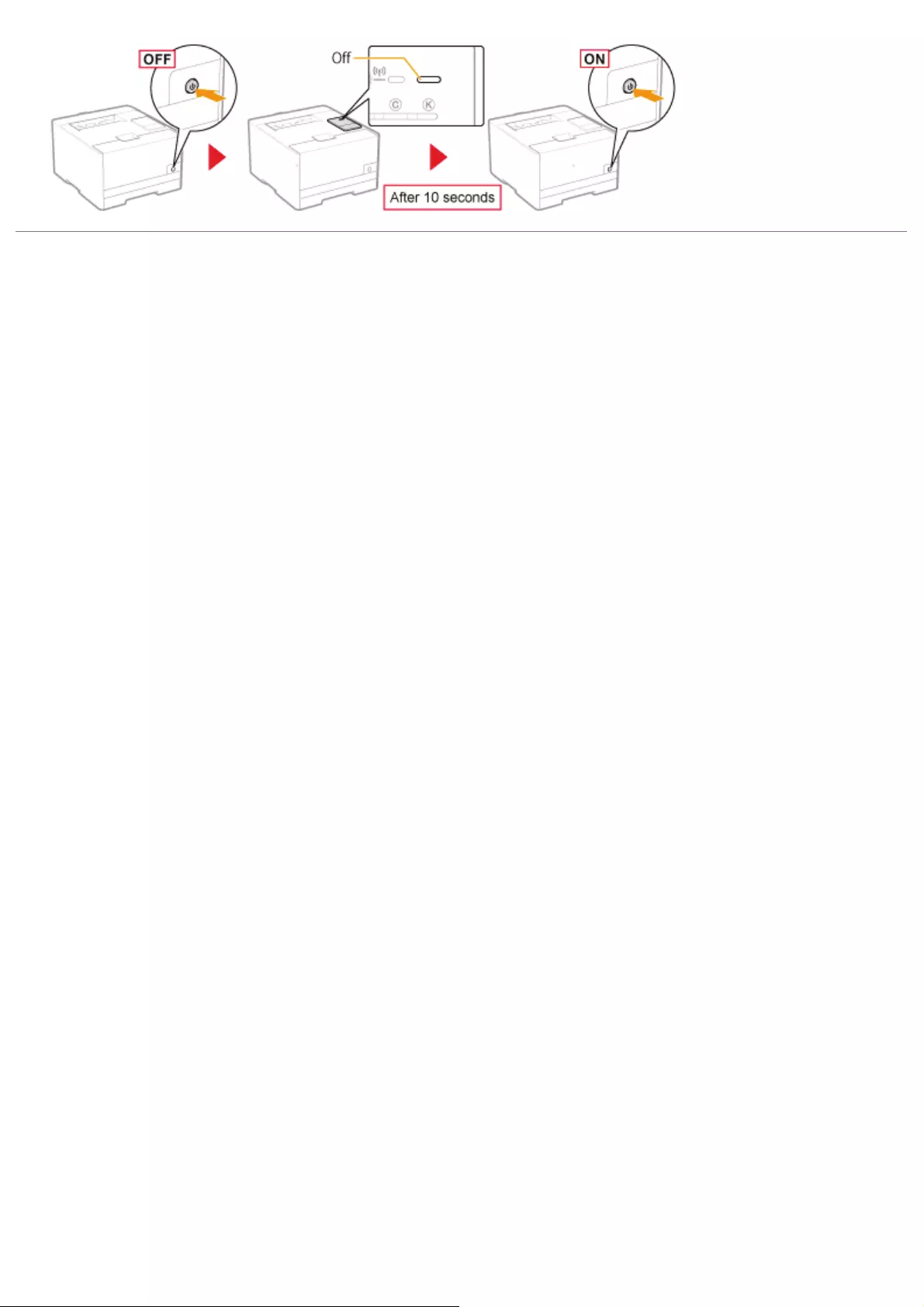
㻟㻤㻥㻌㻛㻌㻡㻝㻠

0F40-077
IMPORTANT
When using the SSL encrypted communication function
Specify the time information for the printer.
You can obtain the time information using either of the following methods.
Notifying the printer of the time information using the NTP server (Specifying SNTP)
"Other Protocol Settings"
Notifying the printer of the time set on the computer using the following procedure
1. Display the Printer Status Window.
"Printer Status Window"
2. Select [Preferences (Administrators)] from the [Options] menu.
3. Select the [Notify the Printer of the Time] check box.
NOTE
SSL encrypted communication function
This function encrypts data between the printer and your computer, for example, when using the Remote UI to manage
the printer with a Web browser. The SSL encrypted communication function can prevent data from being stolen or
tampered, thereby enabling a safer management environment.
To specify SSL encrypted communication
You need to specify keys and certificates to be used for SSL encrypted communication.
"Specifying Keys and Certificates/CA Certificates"
Attention (SSL Encrypted Communication)
㻟㻥㻜㻌㻛㻌㻡㻝㻠

0F40-078
Specify various protocols (TLS, TTLS, or PEAP) for IEEE 802.1X authentication.
Before specifying the settings, see "Attention (IEEE 802.1X Authentication)."
Setting TLS Authentication Information
Setting TTLS/PEAP Authentication Information
Setting TLS Authentication Information
Specify authentication information for using TLS during IEEE 802.1X authentication.
IMPORTANT
To specify TLS authentication
You need to specify keys and their certificates or CA certificates to be used for authentication.
"Specifying Keys and Certificates/CA Certificates"
1
Start the Remote UI, and then log in as Management Mode.
"Starting the Remote UI"
2
Click [Settings/Registration].
3
Display the [IEEE 802.1X Settings] page.
(1) Select [Network Settings].
Setting IEEE 802.1X Authentication
㻟㻥㻝㻌㻛㻌㻡㻝㻠

(2) Click [IEEE 802.1X Settings].
4
Click [Edit].
5
Select the [Use IEEE 802.1X] check box.
㻟㻥㻞㻌㻛㻌㻡㻝㻠
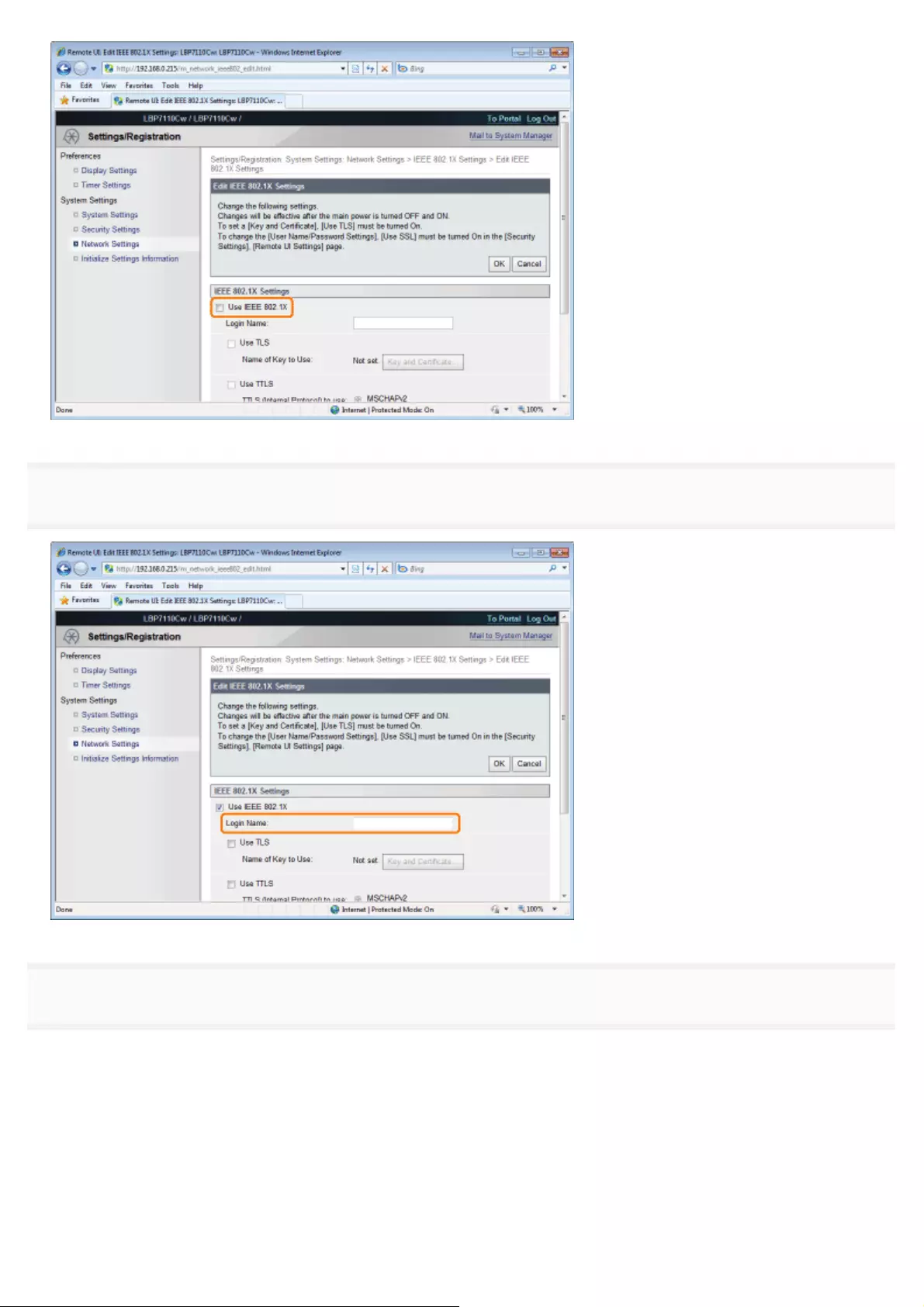
6
Enter a login name.
7
Select the [Use TLS] check box.
㻟㻥㻟㻌㻛㻌㻡㻝㻠

8
Click [Key and Certificate].
9
Specify keys and certificates to be used for authentication.
(1) Select the key to use from a list of registered keys and certificates.
When you click [ ] (Certificate), you can check and verify detailed information of certificates.
"Checking Keys and Certificates/CA Certificates"
(2) Click [Default Key Settings].
㻟㻥㻠㻌㻛㻌㻡㻝㻠

10
Click [OK].
11
Restart the printer.
Turn the printer OFF, make sure that the Main Power indicator is off, wait for 10 seconds or longer, and then turn it ON
again.
ĺAfter the printer is restarted, the settings become effective.
㻟㻥㻡㻌㻛㻌㻡㻝㻠

Setting TTLS/PEAP Authentication Information
Specify authentication information for using TTLS or PEAP during IEEE 802.1X authentication.
IMPORTANT
To specify TTLS/PEAP authentication
You need to specify the SSL encrypted communication function.
"Setting the SSL Encrypted Communication Function"
1
Start the Remote UI, and then log in as Management Mode.
"Starting the Remote UI"
2
Click [Settings/Registration].
3
Display the [IEEE 802.1X Settings] page.
(1) Select [Network Settings].
(2) Click [IEEE 802.1X Settings].
㻟㻥㻢㻌㻛㻌㻡㻝㻠

4
Click [Edit].
5
Select the [Use IEEE 802.1X] check box.
㻟㻥㻣㻌㻛㻌㻡㻝㻠

6
Enter a login name.
7
Select the [Use TTLS] or [Use PEAP] check box.
To use TTLS, select the TTLS internal protocol ([MSCHAPv2] or [PAP]).
㻟㻥㻤㻌㻛㻌㻡㻝㻠
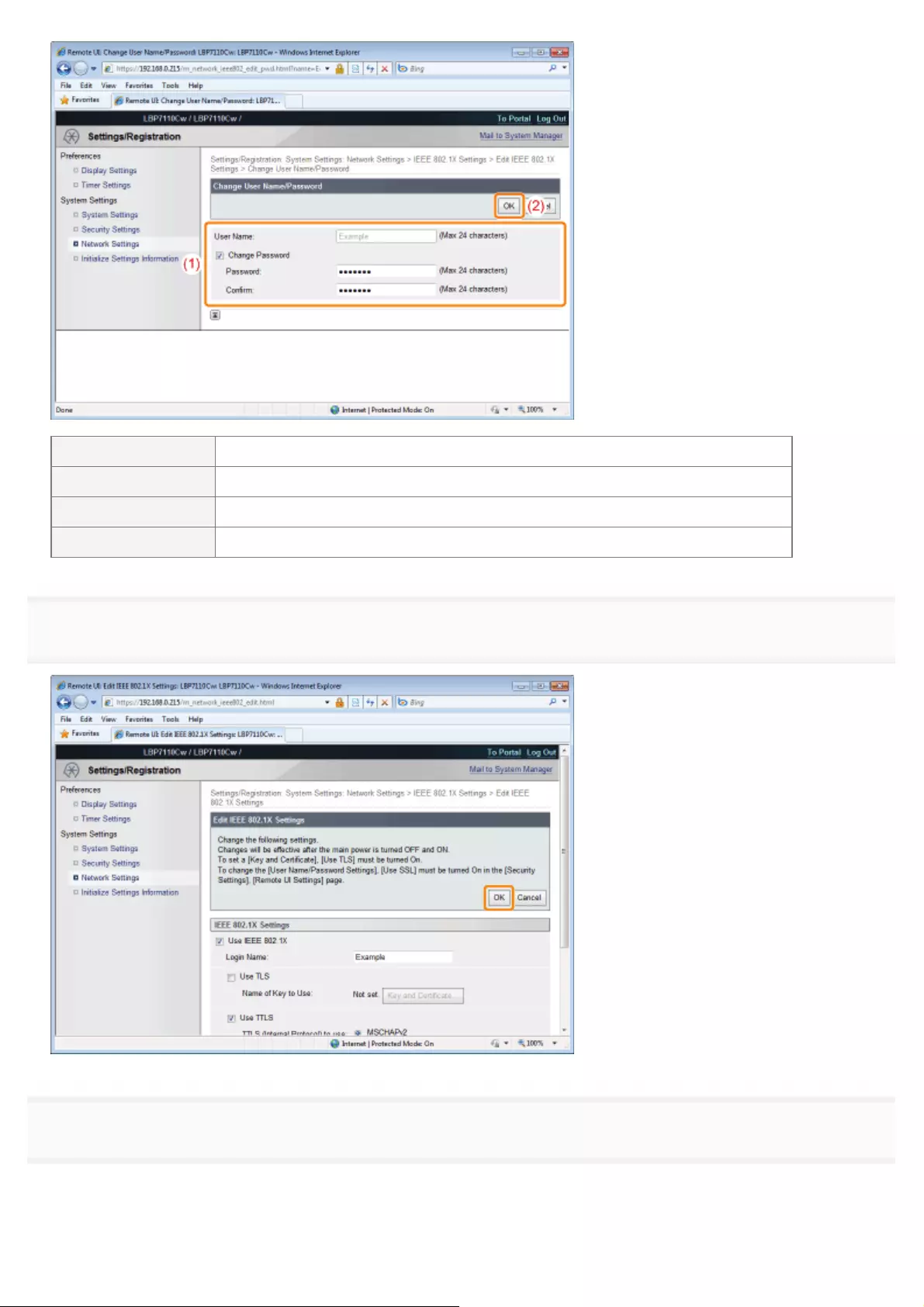
[User Name] Enter a user name. You can enter up to 24 single-byte alphanumeric characters.
[Change Password] Select the check box when changing the password.
[Password] Enter a password. You can enter up to 24 single-byte alphanumeric characters.
[Confirm] To confirm the [Password] you entered, enter it again.
10
Click [OK].
11
Restart the printer.
Turn the printer OFF, make sure that the Main Power indicator is off, wait for 10 seconds or longer, and then turn it ON
again.
ĺAfter the printer is restarted, the settings become effective.
㻠㻜㻜㻌㻛㻌㻡㻝㻠

㻠㻜㻝㻌㻛㻌㻡㻝㻠

0F40-079
IMPORTANT
Conditions for using IEEE 802.1X authentication
In this printer, IEEE 802.1X authentication is available only in wired LAN environments.
To use IEEE 802.1X authentication, you need an authentication server (RADIUS Server).
When using IEEE 802.1X authentication
Specify the time information for the printer.
You can obtain the time information using either of the following methods.
Notifying the printer of the time information using the NTP server (Specifying SNTP)
"Other Protocol Settings"
Notifying the printer of the time set on the computer using the following procedure
1. Display the Printer Status Window.
"Printer Status Window"
2. Select [Preferences (Administrators)] from the [Options] menu.
3. Select the [Notify the Printer of the Time] check box.
NOTE
IEEE 802.1X authentication protocol
This printer supports TLS, TTLS, and PEAP for IEEE 802.1X authentication.
TLS implements cross certification between a certificate sent from an authentication server and a certificate
specified for the printer.
TTLS and PEAP implement cross certification between a certificate sent from an authentication server and a user
name and password specified for the printer.
Setting IEEE 802.1X authentication
We recommend that the settings be performed by the network administrator.
Attention (IEEE 802.1X Authentication)
㻠㻜㻞㻌㻛㻌㻡㻝㻠

0F40-07A
Printer Unit Problems
Printing Cannot Be Performed
The Printer Pauses during Printing, and then Printing Repeatedly Starts and Stops
You Cannot Turn the Printer ON
All the Indicators on the Network Interface Are Off
Driver Problems
You Cannot Install the Printer Driver
You Cannot Uninstall the Printer Driver
The Printer Driver Settings Cannot Be Changed
"Profiles" Cannot Be Selected or Edited
Paper Jams
Paper Jams
Error Display
Indicators on the Printer Are On/Blinking
A Message Appears in the Printer Status Window
Printout Problems
Poor Printout Results
If You Cannot Solve a Problem
Troubleshooting
㻠㻜㻟㻌㻛㻌㻡㻝㻠

0F40-07C
The solutions for when printing cannot be performed vary depending on your environment. See the solutions according to
your environment.
If You Are Using the Printer by Direct Connection
If the printer is connected by USB
"Printing Cannot Be Performed
(USB Connection)"
If the printer is connected by wired LAN
"Printing Cannot Be Performed
(Wired LAN Connection)"
If the printer is connected by wireless LAN (LBP7110Cw Only)
"Printing Cannot Be Performed
(Wireless LAN Connection)
(LBP7110Cw Only)"
If You Are Using the Printer via the Print Server
"Printing Cannot Be Performed (via the Print
Server)"
Printing Cannot Be Performed
㻠㻜㻠㻌㻛㻌㻡㻝㻠

0F40-07E
If you cannot print when the printer is connected to the computer by a USB cable, check the problem following the
questions below.
<Question 1> Is the printer turned ON? (Is the Main Power indicator on?)
ON To <Question 2>
OFF Turn the printer ON.
Cannot be turned ON "You Cannot Turn the Printer ON"
<Question 2> Check the indicators on the printer unit.
(1) The (Ready) indicator
is on. To <Question 3>
(1) The (Ready) indicator
is blinking. The printer is operating. Please wait a moment.
(2) The Toner indicator
is on or blinking.
"Indicators on the Printer Are On/Blinking"
(3) The (Alarm) indicator
is on or blinking.
(4) The (Load Paper) indicator
is blinking.
(5) The (Paper Jam) indicator
is blinking.
(6) The (Go) indicator
is blinking.
<Question 3> Is the USB cable connected properly?
Printing Cannot Be Performed (USB Connection)
㻠㻜㻡㻌㻛㻌㻡㻝㻠

Connected
Try the following point.
If you are using a hub, connect the printer to the computer directly.
If you are using a long USB cable, replace it with the short one.
If you have another USB cable, use it.
If printing is not performed, proceed to <Question 4>.
Unconnected Connect the cable properly.
"Connecting the Printer and Computer"
<Question 4> Can you print a test page in Windows?
"Basic Operations/Various Information for Windows"
Printable There is no problem with the printer and driver.
Check the printing preferences in the application.
Not printable To <Question 5>
<Question 5> Is the port to be used selected correctly?
"Basic Operations/Various Information for Windows"
Selected To <Question 6>
㻠㻜㻢㻌㻛㻌㻡㻝㻠

Not selected Select the correct port.
The port to be used
cannot be found.
Install the printer driver again.
"Uninstalling the Printer Driver"
"Installing the Printer Driver"
<Question 6> Is bi-directional communication enabled?
"Basic Operations/Various Information for Windows"
Enabled To <Question 7>
Not enabled Enable bi-directional communication and restart the computer and printer.
<Question 7> Try the following points.
Make resident software invalid including security software.
If any other devices are connected to your computer by USB connection, disconnect those unneeded.
If drivers or software of any other devices (USB connection) is installed on your computer, uninstall those unneeded.
Connect the USB cable to another USB port on your computer.
Connect the printer to another computer with a USB cable.
If printing does not work, proceed to <Question 8>.
<Question 8> Install the printer driver again.
"Uninstalling the Printer Driver"
"Installing the Printer Driver"
If printing does not work, proceed to <Question 9>.
<Question 9> Uninstall the USB class driver, and then install the printer driver again.
"Uninstalling the USB Class Driver"
"Uninstalling the Printer Driver"
"Installing the Printer Driver"
If printing does not work, contact your local authorized Canon dealer.
㻠㻜㻣㻌㻛㻌㻡㻝㻠

0F40-07F
If you cannot print when the printer is connected to the computer by wired LAN, check the problem following the questions
below.
<Question 1> Is the printer turned ON? (Is the Main Power indicator on?)
ON To <Question 2>
OFF Turn the printer ON.
Cannot be turned ON "You Cannot Turn the Printer ON"
<Question 2> Check the indicators on the printer unit.
(1) The (Ready) indicator
is on. To <Question 3>
(1) The (Ready) indicator
is blinking. The printer is operating. Please wait a moment.
(2) The Toner indicator
is on or blinking.
"Indicators on the Printer Are On/Blinking"
(3) The (Alarm) indicator
is on or blinking.
(4) The (Load Paper) indicator
is blinking.
(5) The (Paper Jam) indicator
is blinking.
(6) The (Go) indicator
is blinking.
<Question 3> Is the printer's (Wi-Fi) indicator on? (LBP7110Cw Only)
Printing Cannot Be Performed (Wired LAN Connection)
㻠㻜㻤㻌㻛㻌㻡㻝㻠
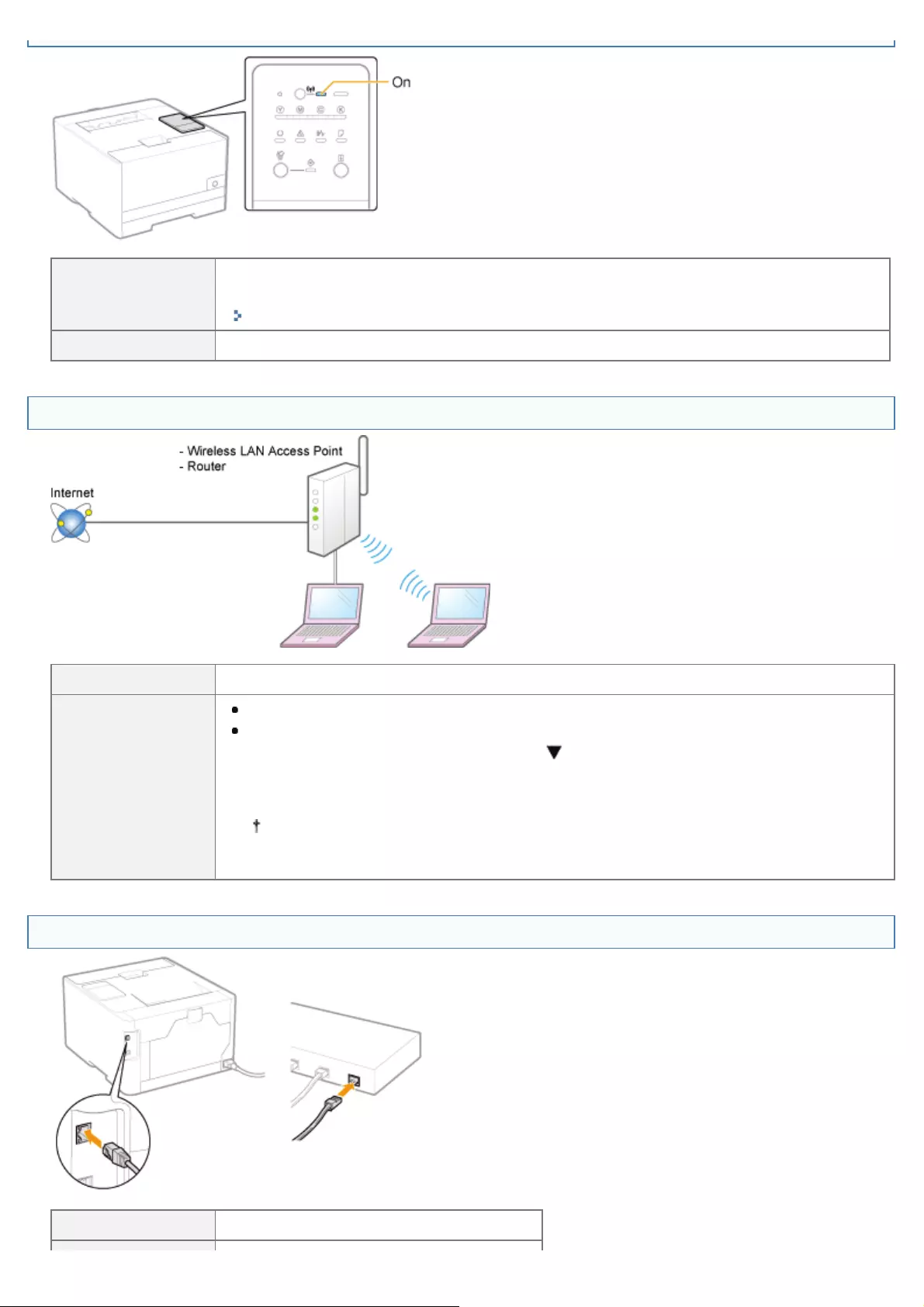
On
The printer is connected by wireless LAN.
Change to a wired LAN connection.
"Switching Between Wireless LAN and Wired LAN for the Connection (LBP7110Cw Only)"
Off To <Question 4>
<Question 4> Can the computer connect to the Internet?
Can connect To <Question 5>
Cannot connect
Properly connect the power cord or LAN cable of the router or other connected device.
Turn on the router or other connected device.
If the computer still cannot connect to the Internet, restart all equipment, wait for a while,
and then try connecting to the Internet again.
For details on the connection method or the procedure for restarting the equipment,
see the instruction manual of each device or contact the manufacturer.
<Question 5> Is the LAN cable connected properly?
Connected To <Question 6>
㻠㻜㻥㻌㻛㻌㻡㻝㻠

Unconnected Connect the cable properly.
"Connecting the Printer and Computer"
<Question 6> Check the indicators on the network interface.
The ACT indicator is on. To <Question 7>
The LNK indicator is on.
All the indicators are off. "All the Indicators on the Network Interface Are Off"
<Question 7> Can you print a test page in Windows?
"Basic Operations/Various Information for Windows"
Printable There is no problem with the printer and driver.
Check the printing preferences in the application.
Not printable To <Question 8>
<Question 8> Is the IP address set properly?
Check that the IP address is set properly using the PING command.
"Basic Operations/Various Information for Windows"
Set To <Question 9>
Not set Set the IP address properly.
"Specifying the Connection Settings"
<Question 9> Is the port to be used selected correctly?
"Basic Operations/Various Information for Windows"
㻠㻝㻜㻌㻛㻌㻡㻝㻠

Selected To <Question 10>
Not selected Select the correct port.
The port to be used
cannot be found.
Create a port.
"Configuring and Changing the Port"
The IP address
was changed.
For MFNP Port
To <Question 10>
The port does not have to be changed because a new IP address is detected
automatically when the printer and computer are on the same subnet.
For Standard TCP/IP Port
Change the port.
"Configuring and Changing the Port"
<Question 10> Check the following points.
The printer is specified as the default printer.
The TCP/IP protocol is running.
The users who can print are not restricted.
"Restricting the Users Who Can Print and Specify Settings"
If printing does not work, proceed to <Question 11>.
<Question 11> Connect the printer and computer directly with the cross-type* LAN cable.
*This is a LAN cable which is used to connect a printer and computer directly without a hub (LAN network).
If printing does not work or if you cannot prepare a cross-type LAN cable, proceed to <Question 12>.
<Question 12> Install the printer driver again.
"Uninstalling the Printer Driver"
"Installing the Printer Driver"
If printing does not work, proceed to <Question 13>.
<Question 13> Can you print from another computer (network connection)?
㻠㻝㻝㻌㻛㻌㻡㻝㻠

Printable Make resident software invalid including security software.
Not printable Contact your local authorized Canon dealer.
㻠㻝㻞㻌㻛㻌㻡㻝㻠
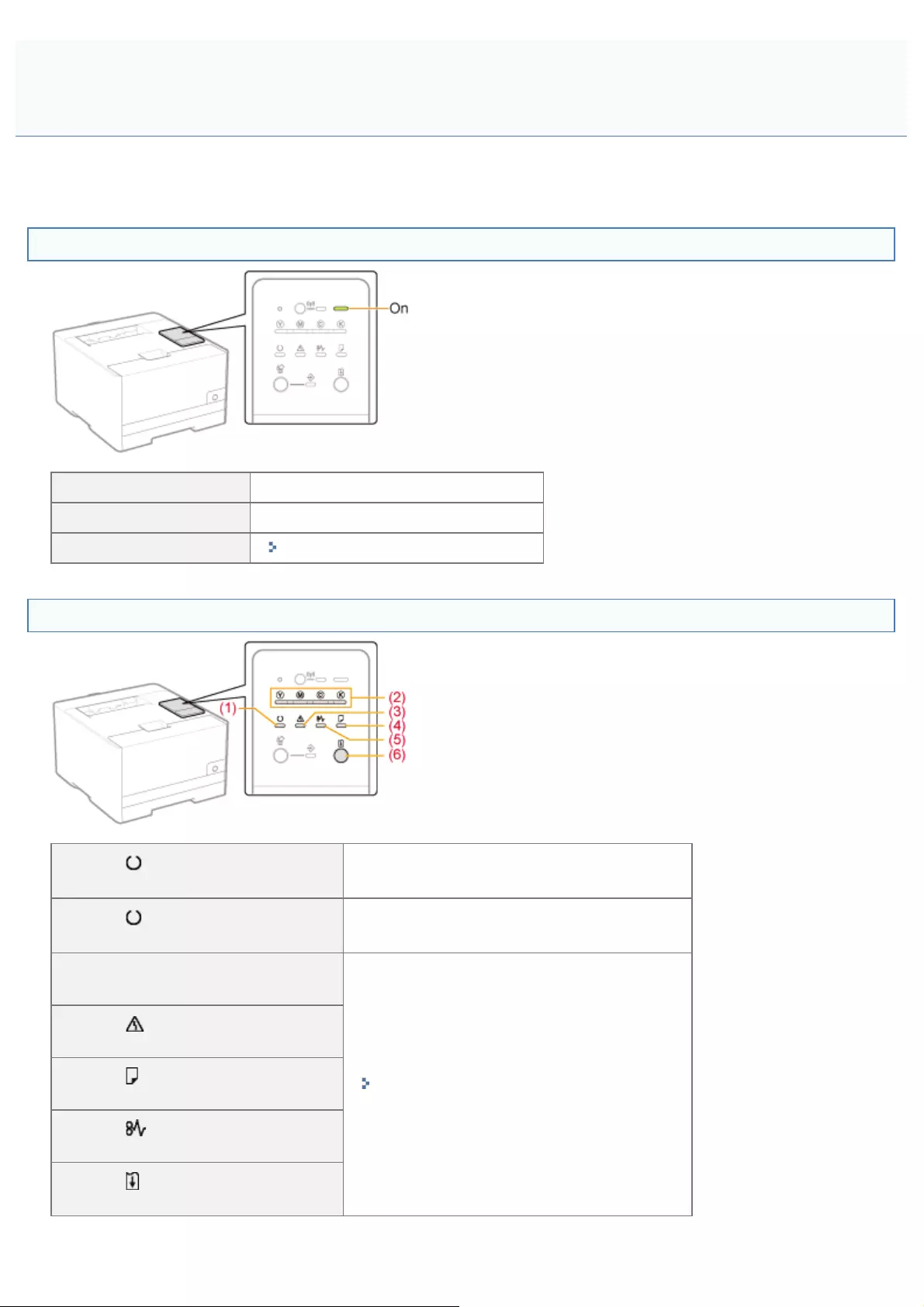
0F40-07H
If you cannot print when the printer is connected to the computer by wireless LAN, check the problem following the
questions below.
<Question 1> Is the printer turned ON? (Is the Main Power indicator on?)
ON To <Question 2>
OFF Turn the printer ON.
Cannot be turned ON "You Cannot Turn the Printer ON"
<Question 2> Check the indicators on the printer unit.
(1) The (Ready) indicator
is on. To <Question 3>
(1) The (Ready) indicator
is blinking. The printer is operating. Please wait a moment.
(2) The Toner indicator
is on or blinking.
"Indicators on the Printer Are On/Blinking"
(3) The (Alarm) indicator
is on or blinking.
(4) The (Load Paper) indicator
is blinking.
(5) The (Paper Jam) indicator
is blinking.
(6) The (Go) indicator
is blinking.
Printing Cannot Be Performed (Wireless LAN Connection) (LBP7110Cw
Only)
㻠㻝㻟㻌㻛㻌㻡㻝㻠

<Question 3> Is the printer's (Wi-Fi) indicator on?
On To <Question 4>
Off
The printer is not connected by wireless LAN.
Change to a wireless LAN connection.
"Switching Between Wireless LAN and Wired LAN for the Connection (LBP7110Cw Only)"
<Question 4> Can the computer connect to the Internet?
Can connect To <Question 5>
Cannot connect
Complete the settings of the computer and wireless LAN access point.
Properly connect the power cord and LAN cable of the wireless LAN access point.
Turn on the wireless LAN access point.
If the computer still cannot connect to the Internet, restart all equipment, wait for a while,
and then try connecting to the Internet again.
For details on the connection method or the procedure for restarting the equipment,
see the instruction manual of each device or contact the manufacturer.
<Question 5> Do the installation locations for the printer and wireless LAN access point meet
the following conditions?
The distance between the printer and the wireless LAN access point is less than 50 m. (The distance may vary
depending on the transmission speed and environmental conditions.)
There is no wall or other obstruction between the printer and wireless LAN access point.
The printer and wireless LAN access point are not located near a microwave oven or refrigerator.
㻠㻝㻠㻌㻛㻌㻡㻝㻠

Yes To <Question 6>
No Relocate to a location that meets these conditions.
<Question 6> Check the connection status (signal strength) of the wireless LAN.
Check the connection status (signal strength) using [Wireless LAN Status] in "User Data List."
"Printing the "User Data List""
[Very Good] : Very good signal strength
[Good] : Good signal strength
[Normal] : Normal signal strength
[Bad] : Poor signal strength
[Very Bad] : Very poor signal strength
Very good signal strength
To <Question 7>Good signal strength
Normal signal strength
Poor signal strength Try the following points.
Change the channel of the wireless LAN access point
(If there are multiple wireless LAN access points, separate the channels by
at least five channels.)
Boost the wireless signal of the wireless LAN access point
(You may not be able to do this depending on your wireless LAN access
point.)
For details on the change method, see the instruction manual of your wireless
LAN access point or contact the manufacturer.
Very poor signal strength
<Question 7> Does the SSID of the printer match that of the computer? (Only when the
computer is connected by wireless LAN)
Check the SSID of the printer using [SSID Settings] in "User Data List."
"Printing the "User Data List""
㻠㻝㻡㻌㻛㻌㻡㻝㻠

See "Basic Operations/Various Information for Windows" and check the SSID of the computer.
Yes To <Question 8>
No
Specify the settings of the wireless LAN connection again.
"Specifying the Connection Settings"
Be careful of the following points when specifying the settings again.
Select [Easy Setup] and [My wireless LAN access point does not have a WPS
button or I cannot find the button], and then change the settings.
Select a wireless LAN access point with the same SSID as that of the computer.
<Question 8> Can you print a test page in Windows?
"Basic Operations/Various Information for Windows"
Printable There is no problem with the printer and driver.
Check the printing preferences in the application.
Not printable To <Question 9>
<Question 9> Is the IP address set properly?
Check that the IP address is set properly using the PING command.
"Basic Operations/Various Information for Windows"
Set To <Question 10>
Not set Set the IP address properly.
"Specifying the Connection Settings"
<Question 10> Is the port to be used selected correctly?
"Basic Operations/Various Information for Windows"
㻠㻝㻢㻌㻛㻌㻡㻝㻠

Selected To <Question 11>
Not selected Select the correct port.
The port to be used
cannot be found.
Create a port.
"Configuring and Changing the Port"
The IP address
was changed.
For MFNP Port
To <Question 11>
The port does not have to be changed because a new IP address is detected
automatically when the printer and computer are on the same subnet.
For Standard TCP/IP Port
Change the port.
"Configuring and Changing the Port"
<Question 11> Check the following points.
The printer is specified as the default printer.
The TCP/IP protocol is running.
The users who can print are not restricted.
"Restricting the Users Who Can Print and Specify Settings"
If printing does not work, proceed to <Question 12>.
<Question 12> Install the printer driver again.
"Uninstalling the Printer Driver"
"Installing the Printer Driver"
If printing does not work, proceed to <Question 13>.
<Question 13> Can you print from another computer (network connection)?
Printable Make resident software invalid including security software.
Not printable Contact your local authorized Canon dealer.
㻠㻝㻣㻌㻛㻌㻡㻝㻠

0F40-07J
If you cannot print when the printer is used via the print server, check the problem following the questions below.
<Question 1> Is the printer turned ON? (Is the Main Power indicator on?)
ON To <Question 2>
OFF Turn the printer ON.
Cannot be turned ON "You Cannot Turn the Printer ON"
<Question 2> Check the indicators on the printer unit.
(1) The (Ready) indicator
is on. To <Question 3>
(1) The (Ready) indicator
is blinking. The printer is operating. Please wait a moment.
(2) The Toner indicator
is on or blinking.
"Indicators on the Printer Are On/Blinking"
(3) The (Alarm) indicator
is on or blinking.
(4) The (Load Paper) indicator
is blinking.
(5) The (Paper Jam) indicator
is blinking.
(6) The (Go) indicator
is blinking.
<Question 3> Is the printer connected to the print server properly?
Printing Cannot Be Performed (via the Print Server)
㻠㻝㻤㻌㻛㻌㻡㻝㻠

Connected To <Question 4>
Unconnected Connect the cable properly.
"Connecting the Printer and Computer"
<Question 4> Can your computer be connected to the print server or the shared printer?
Can be connected To <Question 5>
Cannot be connected "The Print Server for Connection Cannot Be Found"
"The Shared Printer Cannot Be Accessed"
<Question 5> Check the following points.
The print server is connected to the network properly.
The additional driver (alternate driver) is updated properly.
"Configuring the Print Server"
Printing can be performed from the print server.
If printing does not work, proceed to <Question 6>.
<Question 6> Can you print a test page in Windows?
"Basic Operations/Various Information for Windows"
Printable There is no problem with the printer and driver.
Check the printing preferences in the application.
Not printable To <Question 7>
㻠㻝㻥㻌㻛㻌㻡㻝㻠

<Question 7> Is the printer on the print server displayed on the network?
"Basic Operations/Various Information for Windows"
Displayed To <Question 8>
Not displayed Ask your network administrator about the problem.
<Question 8> Install the printer driver again.
"Uninstalling the Printer Driver"
"Installation on Clients"
When installing the printer driver again, change the installation method.
If you performed the local installation (installing the printer driver with the CD-ROM)
ĺ&KDQJHWKHLQVWDOODWLRQPHWKRGWRWKHGRZQORDGLQVWDOODWLRQLQVWDOOLQJWKHSULQWHUGULYHUZLWKRXWWKH&'520
If you performed the download installation (installing the printer driver without the CD-ROM)
ĺ&KDQJHWKHLQVWDOODWLRQPHWKRGWRWKHORFDOLQVWDOODWLRQLQVWDOOLQJWKHSULQWHUGULYHUZLWKWKH&'520
If printing does not work, proceed to <Question 9>.
<Question 9> Can another client print?
Printable Make resident software invalid including security software.
Not printable Contact your local authorized Canon dealer.
㻠㻞㻜㻌㻛㻌㻡㻝㻠

0F40-07K
Perform one of the following solutions according to the cause.
<Cause 1> The print server and client computer are not connected properly.
Solution Connect the print server and client computer properly.
<Cause 2> The print server has not been started up.
Solution Start up the print server.
<Cause 3> The printer is not specified as a shared printer.
Solution Specify the printer as a shared printer.
"Configuring the Print Server"
<Cause 4> The user does not have permission to access the print server or printer.
Solution Ask your network administrator to change the user permissions.
<Cause 5> [Network discovery] is not enabled. (Windows Vista, 7, and Server 2008)
Solution
Perform the following procedure.
1. From the [Start] menu, select [Control Panel].
2. Click [View network status and tasks].
3. Set [Network discovery] to [On].
1. From the [Start] menu, select [Control Panel].
2. Click [View network status and tasks].
3. Click [Change advanced sharing settings].
4. Specify [Turn on network discovery] in [Network discovery].
1. From the [Start] menu, select [Control Panel].
2. Double-click [Network and Sharing Center].
3. Set [Network discovery] to [On].
The Print Server for Connection Cannot Be Found
㻠㻞㻝㻌㻛㻌㻡㻝㻠
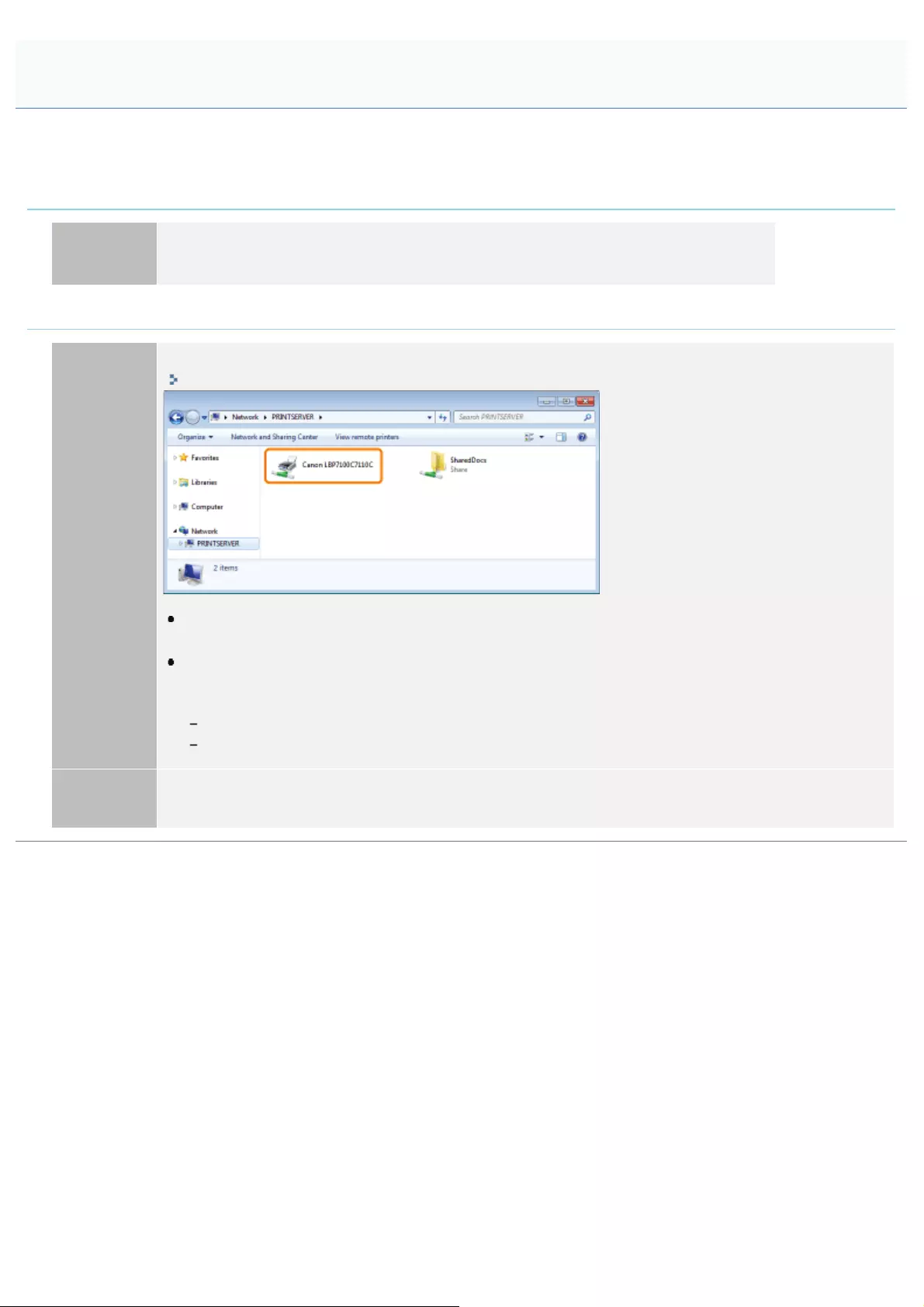
0F40-07L
Perform one of the following solutions according to the cause.
<Cause 1> The user of the computer to be used is not registered, or the password is not
specified.
Solution Register the user of the computer to be used or specify the password on the print server.
For more details, ask your network administrator.
<Cause 2> The path to the network is not correct.
Solution 1
Check printers in the print server.
"Basic Operations/Various Information for Windows"
If the icon for this printer is not displayed
Ask your network administrator about the problem.
If the icon for this printer is displayed
You can install the printer driver by performing either of the following procedures and following the
instructions on the screen.
Double-clicking the icon for this printer
Dragging and dropping the icon for this printer into the printer folder
Solution 2 If you want to specify the network path directly, check if the network path is specified correctly as "\\the
print server name (the computer name of the print server)\the printer name."
The Shared Printer Cannot Be Accessed
㻠㻞㻞㻌㻛㻌㻡㻝㻠
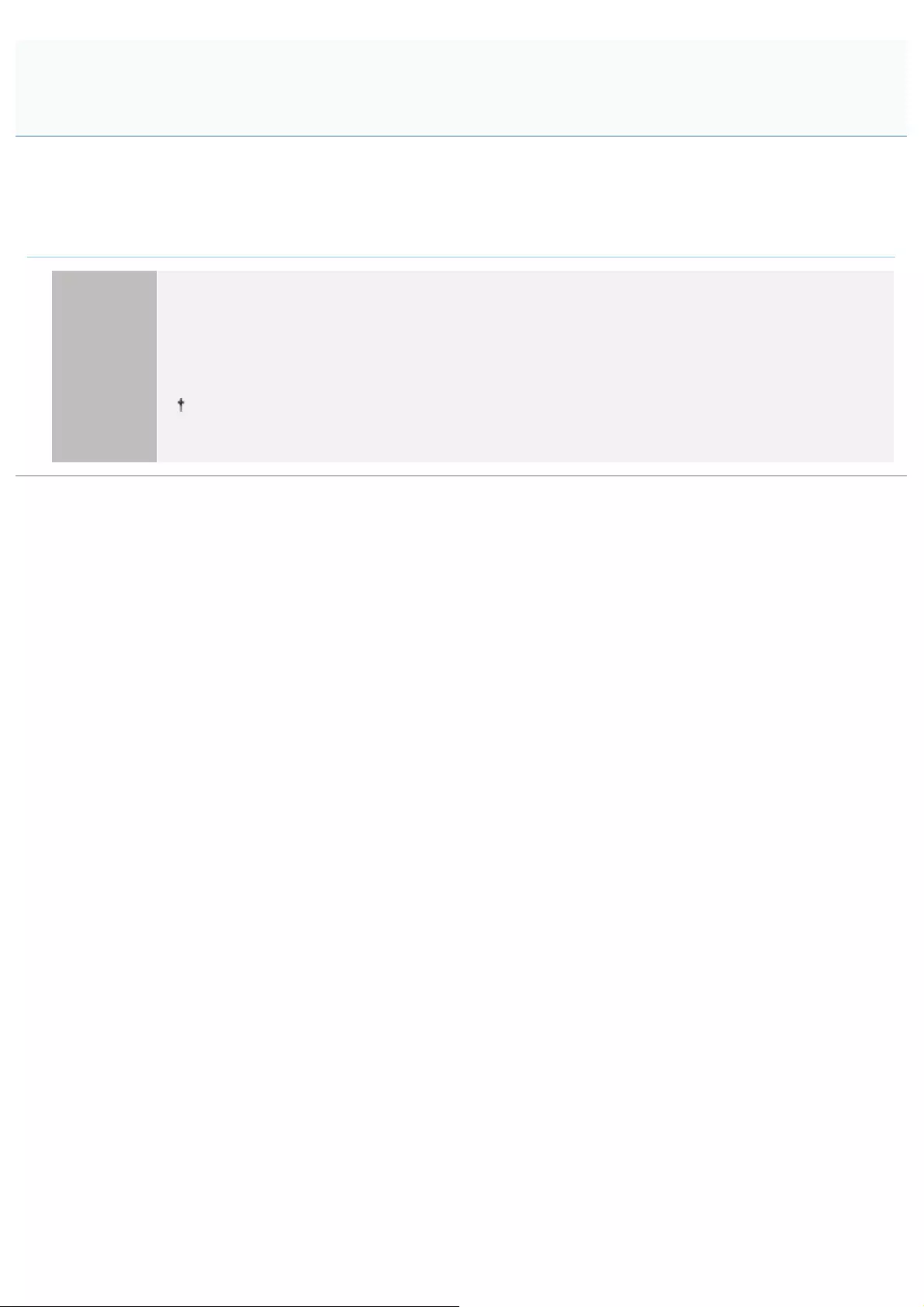
0F40-07R
Perform the following procedure.
<Cause> If the printer is used continuously for an extended period of time, the internal
temperature of the printer increases, activating a safety mechanism and pausing printing
temporarily.
Solution
Please wait a moment.
When the inside of the printer cools down, printing resumes.
If the internal temperature of the printer has not decreased sufficiently, the safety mechanism is
reactivated and printing is paused temporarily. When the inside temperature cools down sufficiently, the
printer resumes the normal printing speed.
The time until the safety mechanism activates or until the printer resumes the normal printing speed
varies depending on the printer usage conditions.
The Printer Pauses during Printing, and then Printing Repeatedly Starts
and Stops
㻠㻞㻟㻌㻛㻌㻡㻝㻠

0F40-07S
Perform one of the following solutions according to the cause.
<Cause 1> The power plug is unplugged from the AC power outlet.
Solution Plug the power plug into the AC power outlet.
<Cause 2> The printer is plugged to an extension cord or multiple power strip.
Solution Plug the power plug directly into an AC power outlet.
<Cause 3> The breakers have tripped.
Solution Reset the breakers on the switch board.
<Cause 4> There is a break in the power cord.
Solution If the printer can be turned on after replacing the power cord with one that is of the same type, then
purchase a new power cord and replace the broken one.
You Cannot Turn the Printer ON
㻠㻞㻠㻌㻛㻌㻡㻝㻠

0F40-07U
Perform one of the following solutions according to the cause.
<Cause 1> The LAN cable is not connected properly or broken.
Solution 1 Remove the LAN cable once, then connect it again.
Solution 2 Replace the LAN cable with another one, then connect it.
<Cause 2> The cable is connected to the UP-LINK (cascade) port on the hub.
Solution 1 Connect the LAN cable to the port on the hub with an " X " mark.
Solution 2 If the hub has an UP-LINK (cascade) switch, switch to " X ".
<Cause 3> A cross LAN cable is being used.
Solution 1 Replace the cable with a straight LAN cable.
Solution 2 Connect the cross LAN cable to the UP-LINK (cascade) port on the hub. If the hub has an UP-LINK
(cascade) switch, switch to the " = " side.
<Cause 4> Cannot communicate with the hub.
Solution 1 Make sure that the power of the hub is on.
Solution 2 Specify the transmission speed and transfer mode of the printer to match those of the connected hub.
"Specifying the Wired LAN Communication Mode and Transmission Speed"
<Cause 5> The hardware of the printer is in an abnormal condition.
Solution Contact your local authorized Canon dealer to request service.
<Cause 6> If the printer is connected by wireless LAN (LBP7110Cw Only)
Solution Change to a wired LAN connection.
"Switching Between Wireless LAN and Wired LAN for the Connection (LBP7110Cw Only)"
NOTE
You cannot use a wired LAN and wireless LAN at the same time
When using the printer with a wireless LAN connection, do not connect a LAN cable to the printer. This may result in
malfunction.
All the Indicators on the Network Interface Are Off
㻠㻞㻡㻌㻛㻌㻡㻝㻠

0F40-07W
If a problem occurs during the installation
Select a problem during the installation from any of the following.
USB connection
"The Printer Is Not Recognized
Automatically"
Network connection
"The Printer Cannot Be Searched for"
Connection via the print server
"The Print Server for Connection Cannot Be
Found"
"The Shared Printer Cannot Be Accessed"
If the printer driver is not installed properly
Perform the following procedure.
Solution 1
Install the printer driver again.
"Uninstalling the Printer Driver"
"Installing the Printer Driver"
Solution 2
(Only when connecting with USB)
Uninstall the USB class driver, and then install the printer driver again.
"Uninstalling the USB Class Driver"
"Uninstalling the Printer Driver"
"Installing the Printer Driver"
You Cannot Install the Printer Driver
㻠㻞㻢㻌㻛㻌㻡㻝㻠

0F40-07X
Perform one of the following solutions according to the cause.
<Cause 1> The printer is not turned ON.
Solution Turn the printer ON.
<Cause 2> The USB cable is not connected properly.
Solution Make sure that the printer and computer are properly connected with the USB cable.
"Connecting the Printer and Computer"
<Cause 3> The USB cable was already connected and the printer was turned ON before the
printer driver was installed.
Solution
Perform the following procedure.
1. Turn the printer OFF.
2. Disconnect the USB cable.
3. Connect the USB cable again.
4. While the following screen appears, turn the printer ON.
<Cause 4> An inappropriate USB cable is being used.
Solution
Use a USB cable that is appropriate for the USB interface environment of the printer and has the following
symbol.
The following is the USB interface environment of this printer.
Hi-Speed USB
USB
<Cause 5> The USB class driver is installed.
Solution Uninstall the USB class driver.
"Uninstalling the USB Class Driver"
The Printer Is Not Recognized Automatically
㻠㻞㻣㻌㻛㻌㻡㻝㻠
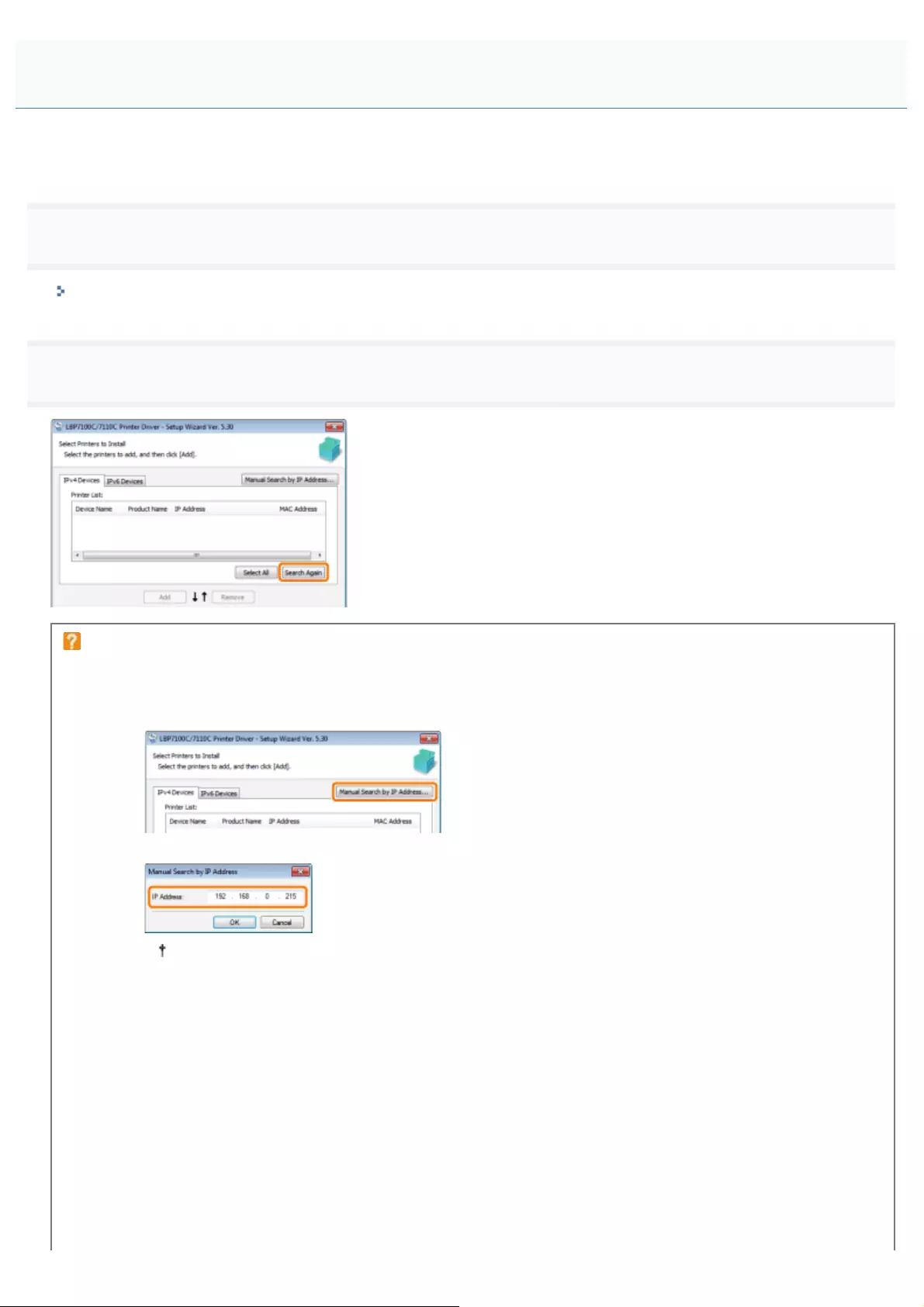
0F40-07Y
If the printer cannot be searched for (no devices are displayed in [Printer List]) at the time of installation, perform the
following procedure.
1
Make sure that the printer and computer are connected properly, and the printer is turned ON.
"Connecting the Printer and Computer"
2
Click [Search Again], to search for the printer on the network again.
If the printer cannot be searched for (no devices are displayed) even by performing the above
procedure
<Solution 1> (Only when [IPv4 Devices] is selected)
1. Click [Manual Search by IP Address].
2. Enter the IP address of the printer to be installed.
If you are not sure about the IP address of the printer, see "Checking the IP Address of the
Printer."
3. Click [OK].
<Solution 2>
1. Click [Back] to go back to the [Printer Installation] screen.
2. Select [Manually Set Port to Install].
The Printer Cannot Be Searched for
㻠㻞㻤㻌㻛㻌㻡㻝㻠

0F40-080
Perform the following procedure.
Solution 1
Start the uninstaller directly from the supplied CD-ROM, and then uninstall
the printer driver.
"Starting the Uninstaller from the CD-ROM"
"Uninstalling the Printer Driver"
Solution 2
(Only when connecting with USB)
Uninstall the USB class driver.
"Uninstalling the USB Class Driver"
NOTE
If a user without administrative rights installed the printer driver
You may not be able to uninstall the printer driver successfully depending on your operating system.
In this case, uninstall the printer driver using the following procedure.
1. Open the printer folder.
"Basic Operations/Various Information for Windows"
2. Right-click the icon for this printer, then select [Delete] or [Remove device] from the pop-up menu.
3. Click [Yes].
4. Uninstall the printer driver using the uninstaller.
"Uninstalling the Printer Driver"
You Cannot Uninstall the Printer Driver
㻠㻟㻜㻌㻛㻌㻡㻝㻠

0F40-081
1
Insert the supplied CD-ROM "User Software" into the CD-ROM drive of your computer.
When the following screen appears, click [Exit].
If the [AutoPlay] dialog box appears
Select [Open folder to view files], and then proceed to Step 4.
2
Display [Computer] or [My Computer].
"Basic Operations/Various Information for Windows"
3
Right-click the CD-ROM icon, then select [Open] from the pop-up menu.
Starting the Uninstaller from the CD-ROM
㻠㻟㻝㻌㻛㻌㻡㻝㻠

4
Open the folder in which the uninstaller is included.
For a 32-bit operating system
Open the [English] - [32bit] - [MISC] folders.
For a 64-bit operating system
Open the [English] - [x64] - [MISC] folders.
5
Double-click [UNINSTAL.exe].
㻠㻟㻞㻌㻛㻌㻡㻝㻠
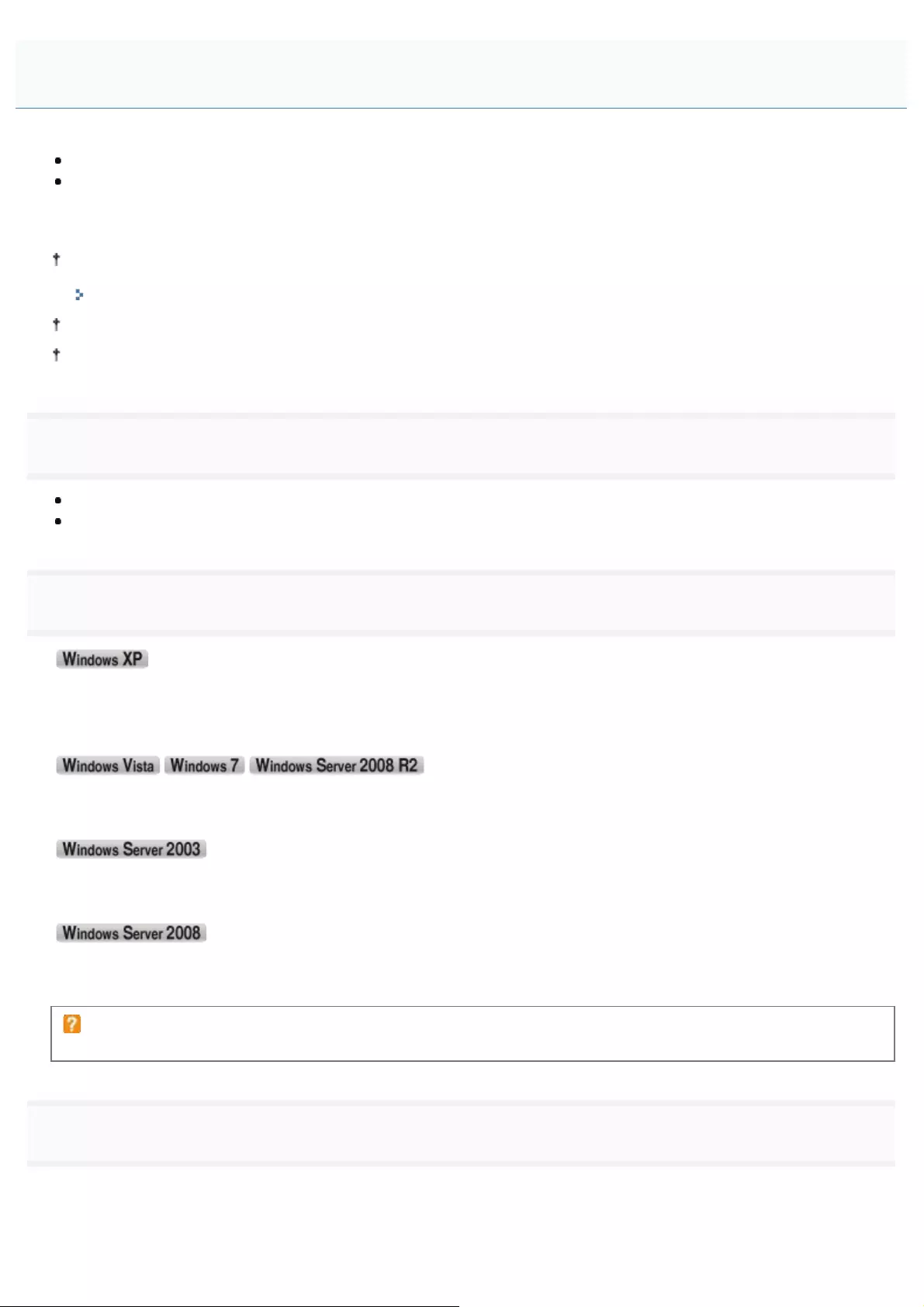
0F40-082
Uninstall the USB class driver under the following circumstances.
If the printer driver installed using a USB connection cannot be uninstalled properly
If you cannot install the printer driver properly even after reinstalling it
When uninstalling the USB class driver, be sure to perform the following procedure.
If the printer driver could not be installed properly, be sure to uninstall the printer driver before deleting the USB class
driver.
"Uninstalling the Printer Driver"
If you delete the USB class driver, it is automatically installed again by USB connection.
Deleting the USB class driver is not supported for Macintosh.
1
Check the following.
The printer and computer are connected using a USB cable.
The printer is turned ON.
2
Display [Device Manager].
1. From the [Start] menu, select [Control Panel].
2. &OLFN>3HUIRUPDQFHDQG0DLQWHQDQFH@ĺ>6\VWHP@
3. &OLFNWKH>+DUGZDUH@WDEĺ>'HYLFH0DQDJHU@
1. From the [Start] menu, select [Control Panel].
2. &OLFN>+DUGZDUHDQG6RXQG@RU>+DUGZDUH@ĺ>'HYLFH0DQDJHU@
1. )URPWKH>6WDUW@PHQXVHOHFW>&RQWURO3DQHO@ĺ>6\VWHP@
2. &OLFNWKH>+DUGZDUH@WDEĺ>'HYLFH0DQDJHU@
1. From the [Start] menu, select [Control Panel].
2. Double-click [Device Manager].
If the [User Account Control] dialog box appears
Click [Yes] or [Continue].
3
Double-click [Universal Serial Bus controllers].
Uninstalling the USB Class Driver
㻠㻟㻠㻌㻛㻌㻡㻝㻠

4
Right-click [USB Printing Support], then select [Uninstall] from the pop-up menu.
Do not uninstall any drivers for other devices. If you uninstall them by mistake, Windows may not operate properly.
If the USB class driver is not installed properly, [USB Printing Support] is not displayed. Then, click [ ] to close the
[Device Manager] dialog box.
If the USB class driver is under [Other Devices]
Select the USB class driver which is displayed as [Unknown device], and then uninstall it.
5
Click [OK].
6
Click [ ] to close the [Device Manager] dialog box.
㻠㻟㻡㻌㻛㻌㻡㻝㻠

7
Disconnect the USB cable from the computer, then restart Windows.
㻠㻟㻢㻌㻛㻌㻡㻝㻠
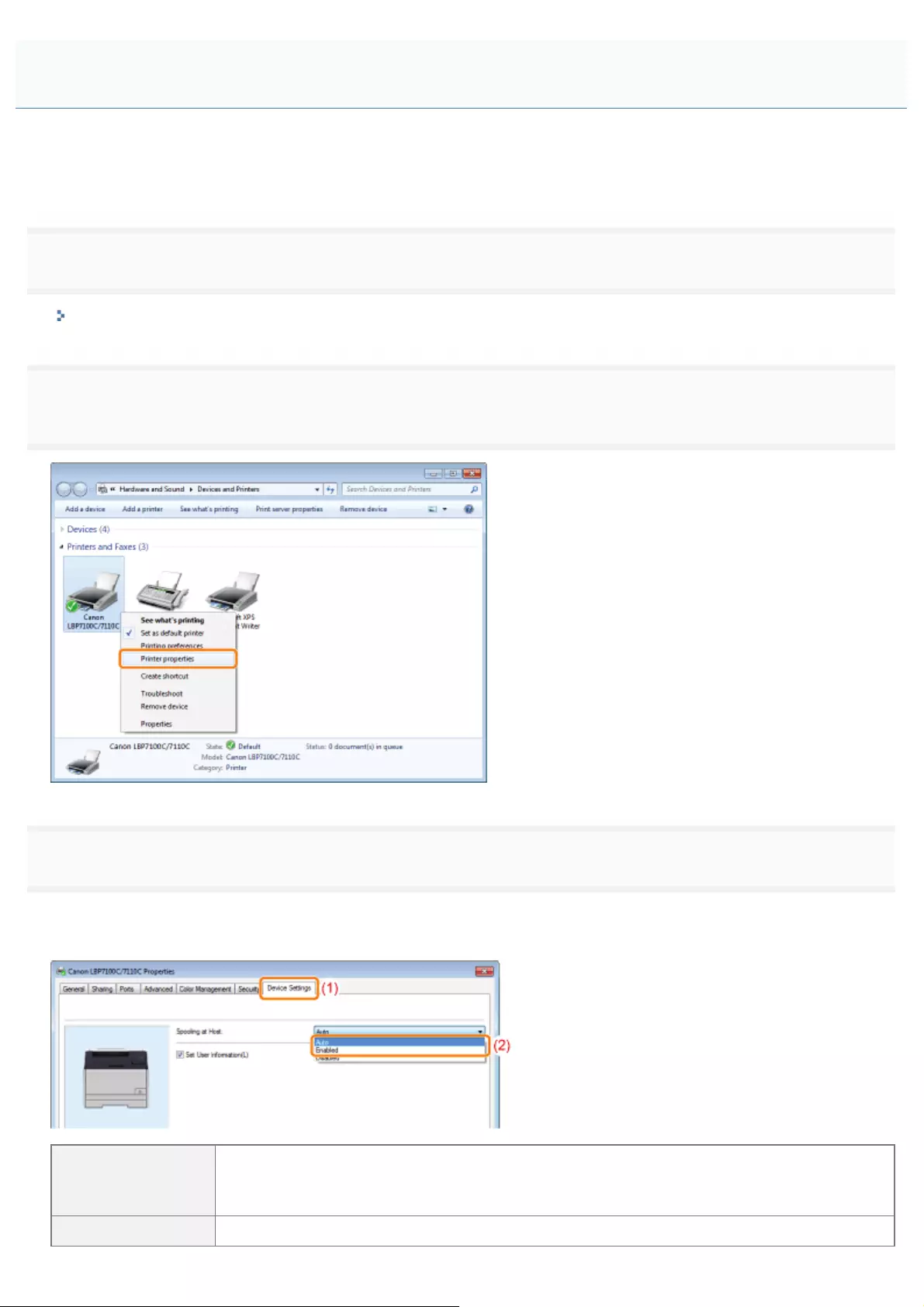
0F40-083
If [Spooling at Host] (whether the print data are processed in the computer) is set to [Disabled], you cannot change the
driver settings because some options are unavailable.
To change the settings, set [Spooling at Host] to [Auto] or [Enabled] using the following procedure.
1
Open the printer folder.
"Basic Operations/Various Information for Windows"
2
Right-click the icon for this printer, and then select [Printer properties] or [Properties] from the pop-
up menu.
3
Change the setting for [Spooling at Host].
(1) Display the [Device Settings] sheet.
(2) Select [Auto] or [Enabled] for [Spooling at Host].
[Auto]
The printer selects automatically whether or not print data is processed on the host (computer).
When processing can be performed only with the functions of the printer, processing is
performed only on the printer to enable faster printing.
[Enabled] All print data is processed by the host (computer).
The Printer Driver Settings Cannot Be Changed
㻠㻟㻣㻌㻛㻌㻡㻝㻠

If you cannot change the setting
You need administrative rights to change the setting.
Contact your system administrator.
4
Click [OK].
㻠㻟㻤㻌㻛㻌㻡㻝㻠

0F40-084
When the [Allow Profile Selection] and [Allow Setting Edition] check boxes are cleared, selecting and editing a "Profile" are
restricted.
To select or edit a "Profile", select the check box using the following procedure.
1
Open the printer folder.
"Basic Operations/Various Information for Windows"
2
Right-click the icon for this printer, and then select [Printer properties] or [Properties] from the pop-
up menu.
3
Change the settings for [Define Document Property].
(1) Display the [Profile] sheet.
(2) Select the [Allow Profile Selection] and [Allow Setting Edition] check boxes.
"Profiles" Cannot Be Selected or Edited
㻠㻟㻥㻌㻛㻌㻡㻝㻠
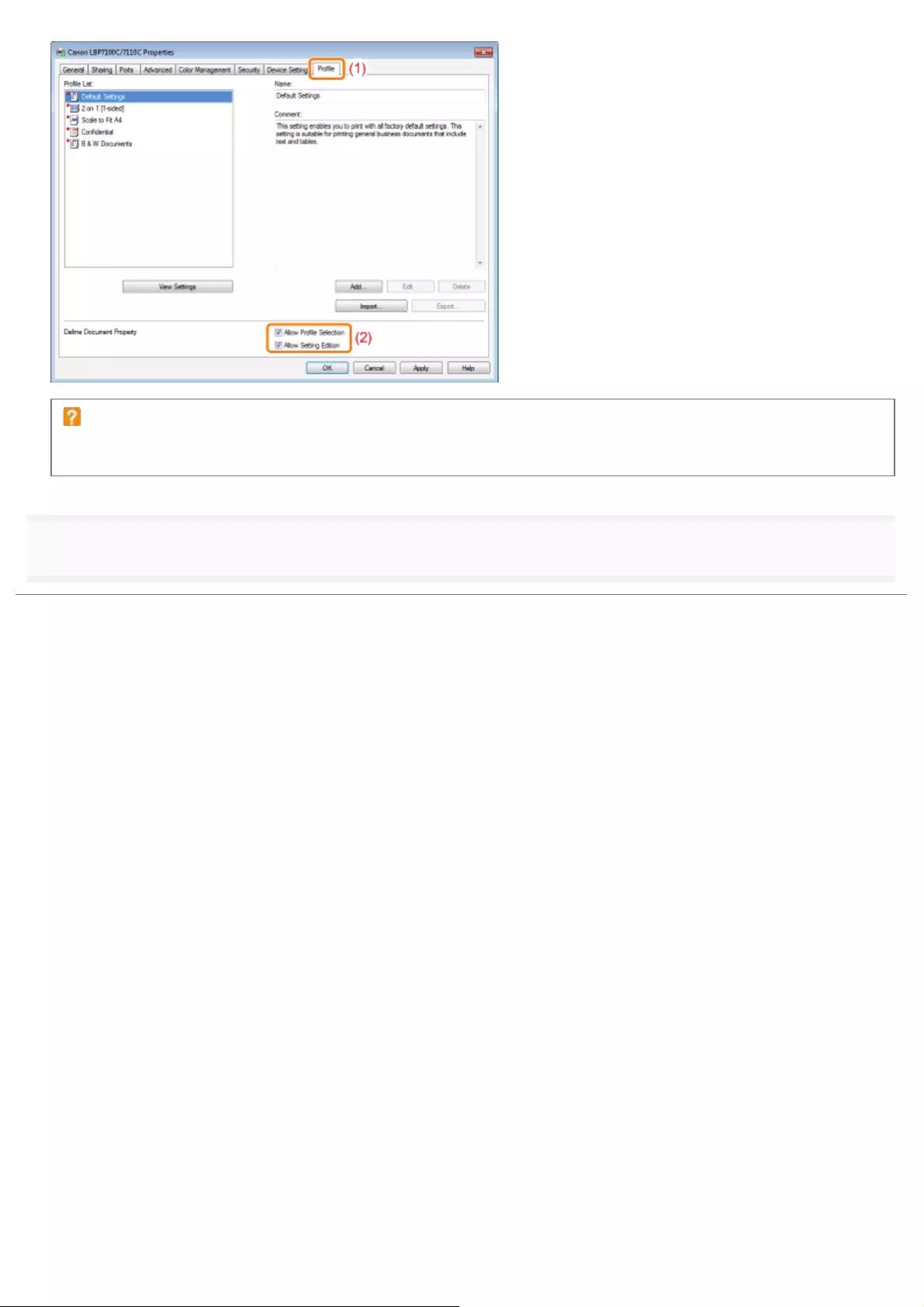
If you cannot change the setting
You need administrator rights to change the setting.
Contact your system administrator.
4
Click [OK].
㻠㻠㻜㻌㻛㻌㻡㻝㻠
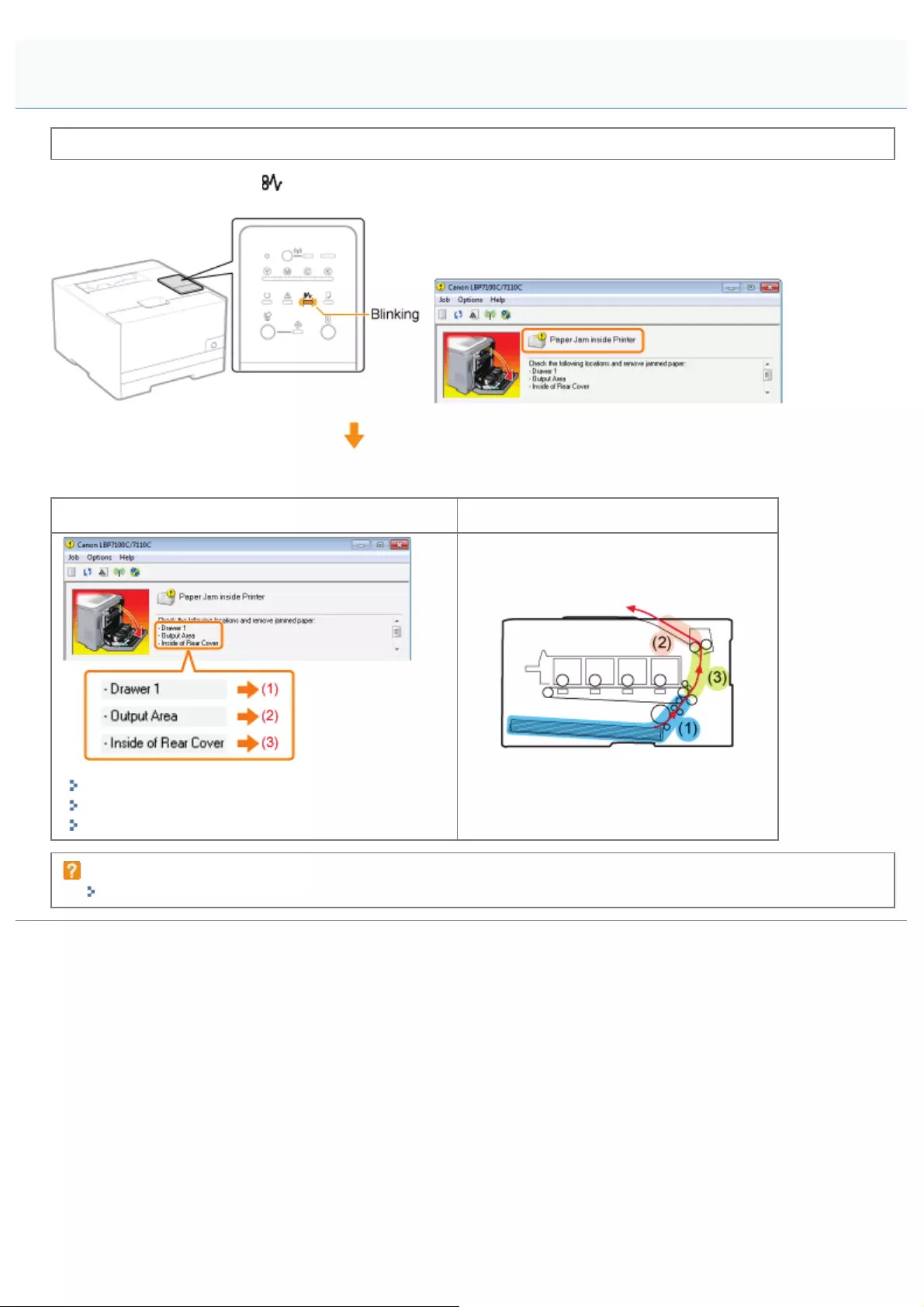
0F40-085
Before removing jammed paper, see "Attention (Paper Jams)."
When a paper jam occurs, the (Paper Jam) indicator (orange) blinks, and messages appear in the Printer Status
Window.
Remove paper jammed in each area in the order of the displayed areas in the message.
Message and Clearance Procedure Paper Jam Area
(1) "Clearing Paper Jams (Paper Drawer)"
(2) "Clearing Paper Jams (Output Area)"
(3) "Clearing Paper Jams (Inside the Rear Cover)"
(Side View)
If the Printer Status Window is not displayed
"Printer Status Window"
Paper Jams
㻠㻠㻝㻌㻛㻌㻡㻝㻠
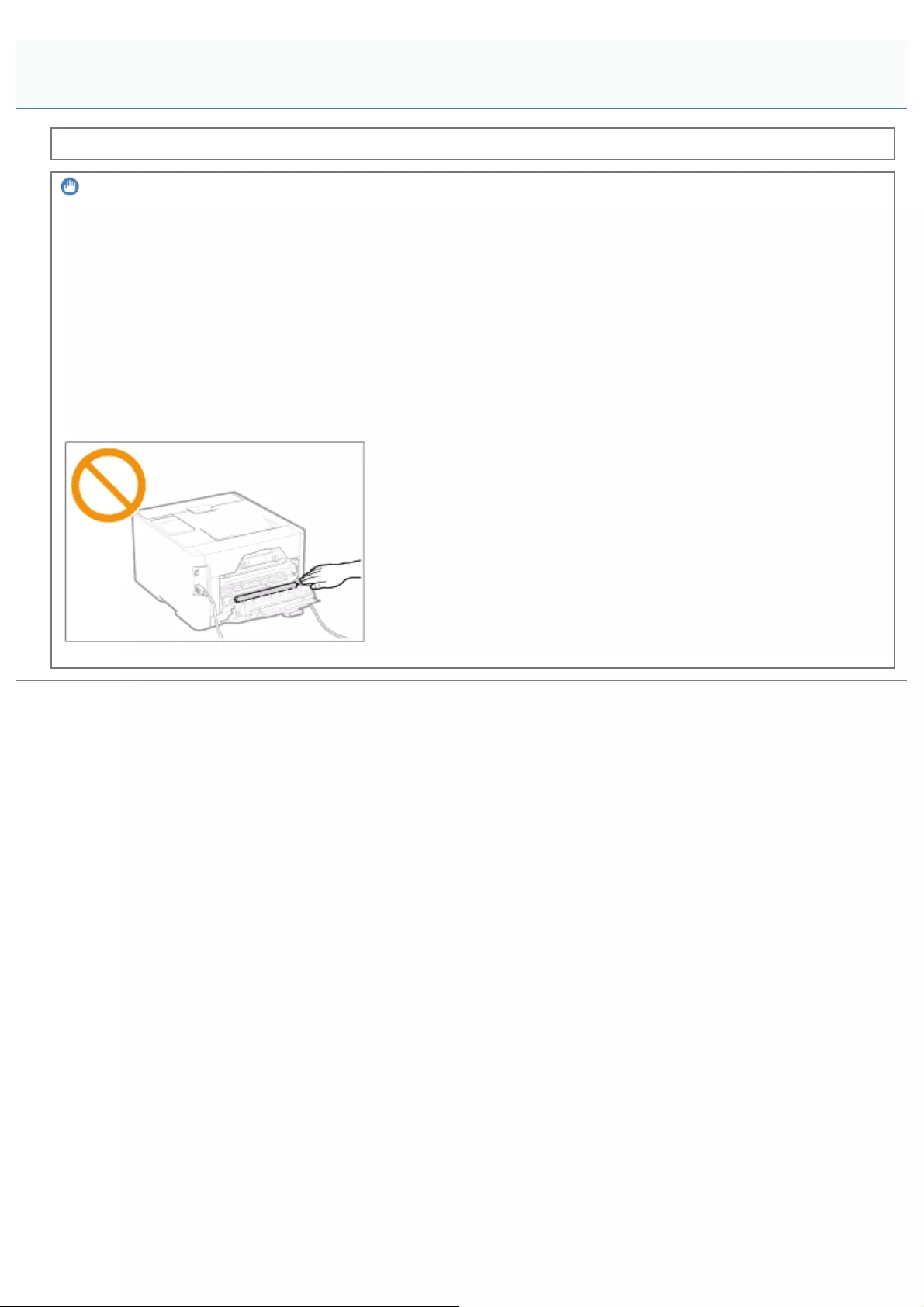
0F40-086
See "Important Safety Instructions" also.
IMPORTANT
Leave the printer ON when removing the jammed paper.
If the power is turned off, the data being printed will be deleted.
Do not remove the jammed paper forcefully.
Removing jammed paper with excess force may cause the paper to tear or damage the inside of the printer. Remove the
paper by pulling it gently.
If the paper is torn
Remove all remaining pieces of paper.
Do not touch the transfer roller.
Print quality may deteriorate.
Attention (Paper Jams)
㻠㻠㻞㻌㻛㻌㻡㻝㻠

0F40-087
1
Pull out the paper drawer.
2
Open the drawer top cover.
3
Remove the paper by pulling it gently.
If you cannot remove the paper easily, do not try to remove it forcefully but proceed to Step 4 and perform the clearing
procedure for another area which is displayed in the message.
4
Close the drawer top cover.
Clearing Paper Jams (Paper Drawer)
㻠㻠㻟㻌㻛㻌㻡㻝㻠
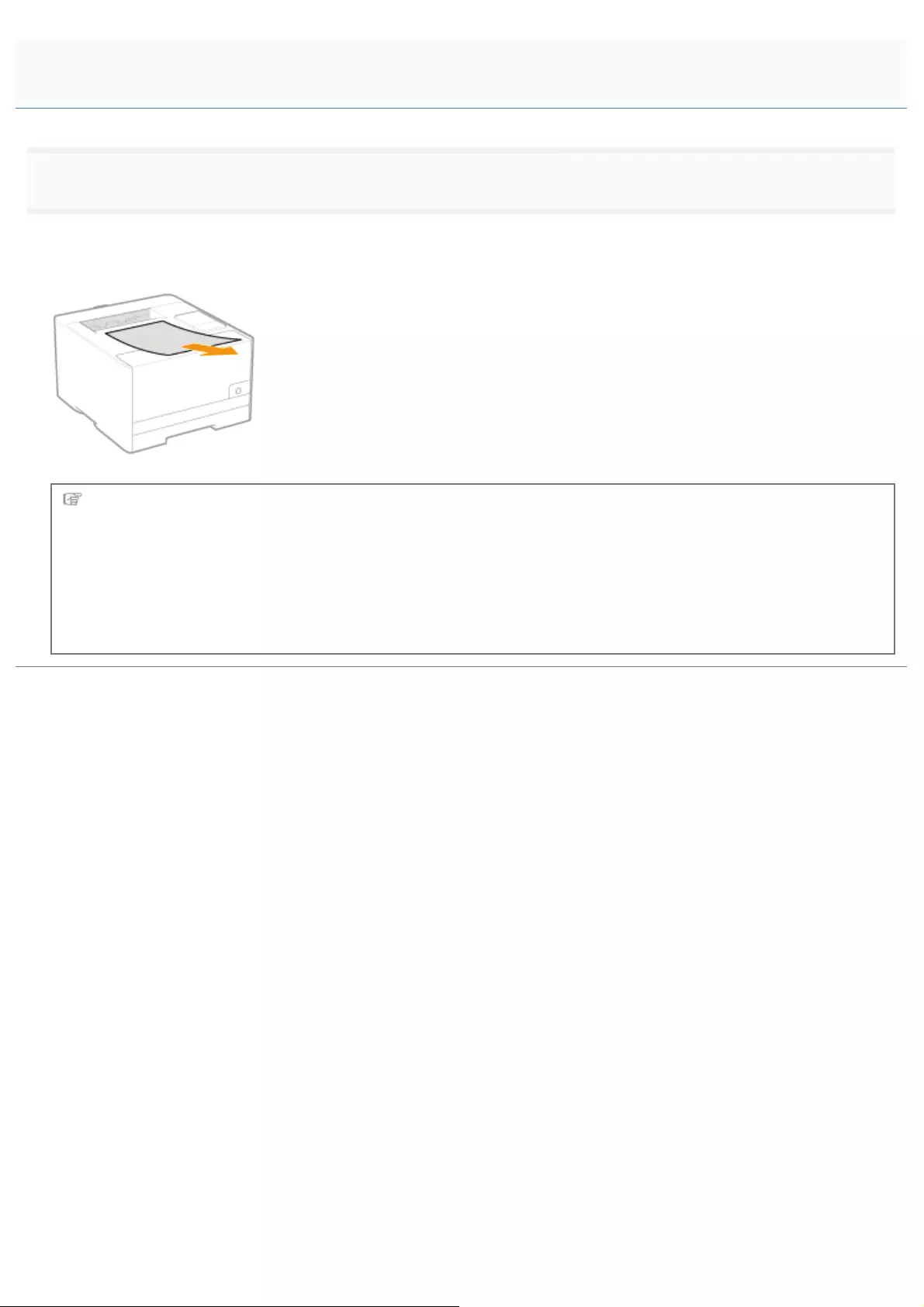
0F40-088
1
Remove the paper by pulling it gently.
If you cannot remove the paper easily, do not try to remove it forcefully but perform a procedure for another area which is
displayed in a message.
Next, proceed to the procedure for clearing the paper jam which is occurred in another area displayed in the
message.
(1) "Clearing Paper Jams (Paper Drawer)"
(2) "Clearing Paper Jams (Output Area)"
(3) "Clearing Paper Jams (Inside the Rear Cover)"
Clearing Paper Jams (Output Area)
㻠㻠㻡㻌㻛㻌㻡㻝㻠
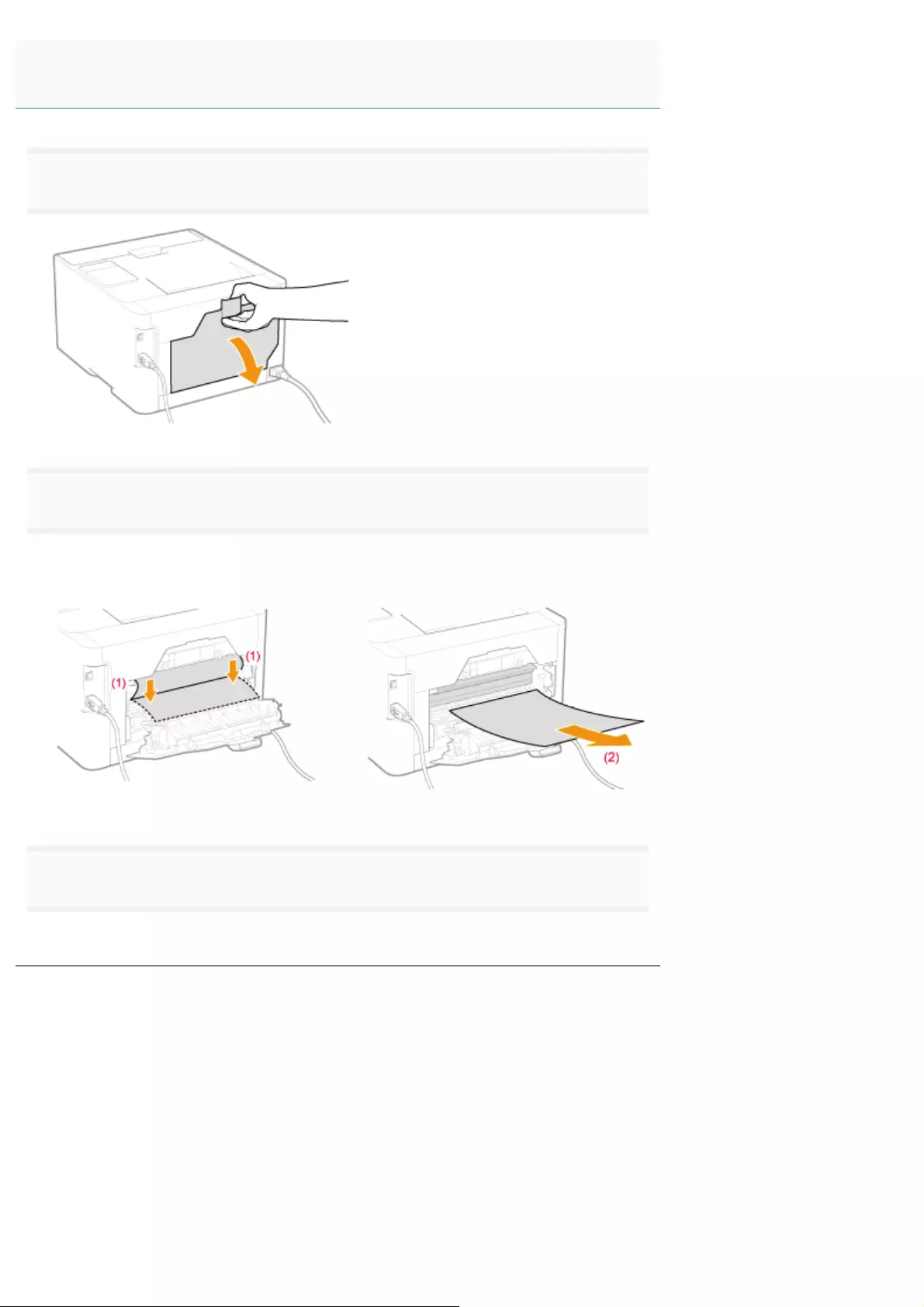
0F40-089
1
Open the rear cover.
2
Remove the jammed paper.
(1) Hold both sides of the paper and slowly pull them down.
(2) Remove the paper by pulling it gently.
3
Close the rear cover.
ĺThe paper jam message disappears, and the printer is ready to print.
Clearing Paper Jams (Inside the Rear Cover)
㻠㻠㻢㻌㻛㻌㻡㻝㻠
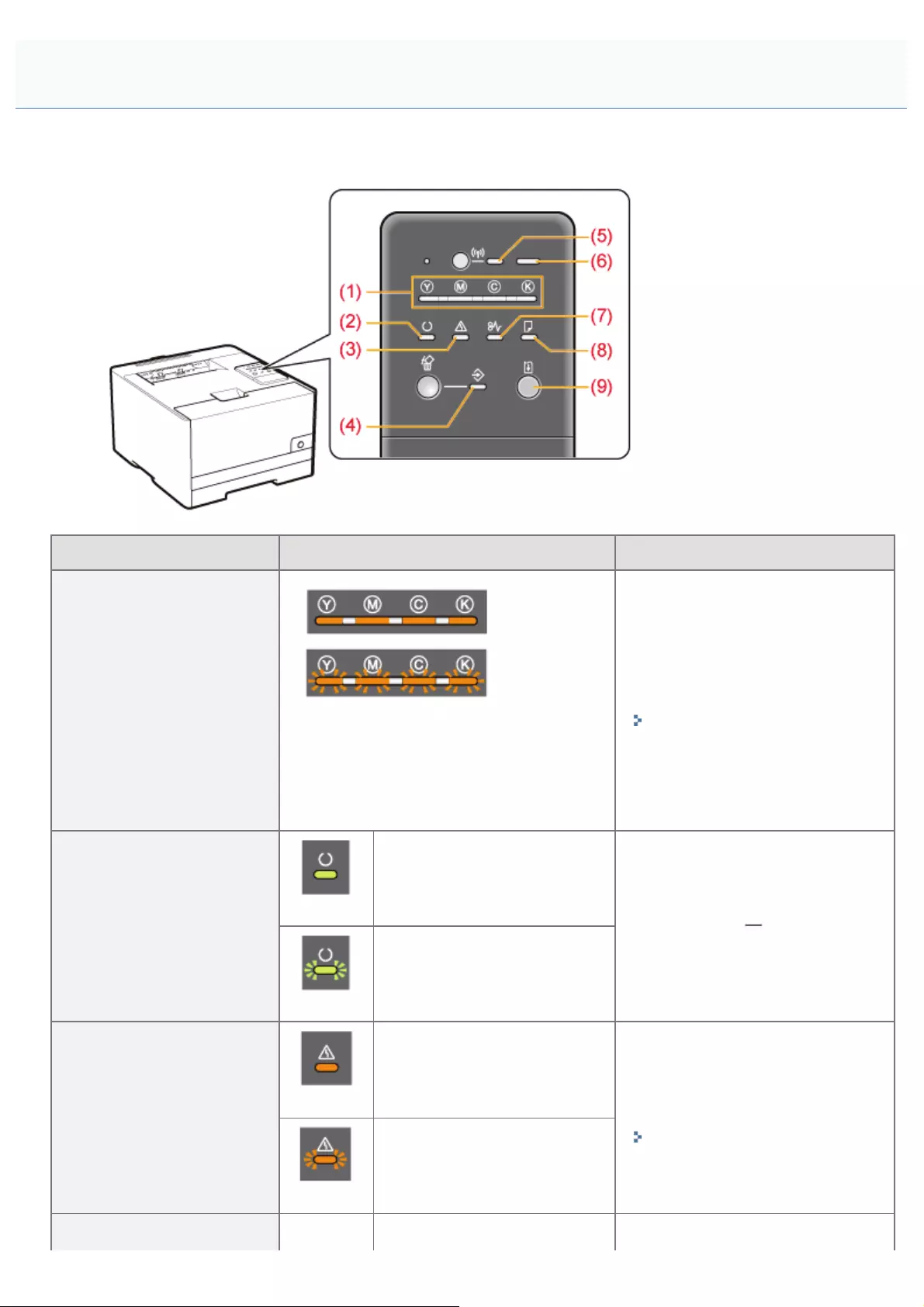
0F40-08A
The indicators on the printer display the printer status as follows.
Perform solutions according to the indicators are on/blinking.
Name Status Solution
(1) Toner Indicator
(On or Blinking)
An error is occurring for the toner
cartridges.
(Such as when the toner cartridges have
reached the end of their life)
Solve the problem following the
message displayed in the Printer
Status Window.*1
"A Message Appears in the
Printer Status Window"
(2) Ready Indicator
(On)
The printer is ready to print.
(Blinking)
The printer is busy printing,
preparing to print, or cleaning.
(3) Alarm Indicator (On)
A service error is occurring. Solve the problem following the
message displayed in the Printer
Status Window.*1
"A Message Appears in the
Printer Status Window"
(Blinking)
An error is occurring.
Indicators on the Printer Are On/Blinking
㻠㻠㻣㻌㻛㻌㻡㻝㻠

(4) Job Indicator
(On)
A job is being printed or is
waiting to be printed.
(Blinking)
A job is being canceled.
(5) Wi-Fi Indicator
(LBP7110Cw Only)
(On)
The printer is connected by
wireless LAN.
(Blinking)
The wireless LAN is configured.
(6) Main Power Indicator
(On)
The printer is turned ON.
(Blinking)
The printer is being turned
OFF.
(7) Paper Jam Indicator
(Blinking)
A paper jam is occurring. Remove the paper jam.
"Paper Jams"
(8) Load Paper Indicator
(Blinking)
Paper needs to be checked.
(Such as when paper runs out
and when paper cannot be fed
properly)
Load the paper properly.
"Loading Paper"
(9) Go Indicator
(Blinking)
An error occurred, but you can
ignore the error and continue
printing.
To skip the error and continue
printing, press the [ ] (Go) key.*2
*1 For details on the procedure for displaying the Printer Status Window, see "Printer Status Window."
*2 Skipping the error and continuing printing (by pressing the [ ] (Go) key) may cause unexpected print results.
㻠㻠㻤㻌㻛㻌㻡㻝㻠

0F40-08C
Perform solutions according to the displayed message.
The message type varies depending on the icon.
A service call is occurring.
" Service Error"
Communication cannot be performed with the printer.
" Cannot Communicate with Printer"" Incompatible Printer"
" Cannot Communicate with Server"" Incorrect Port"
" Communication Error"" Network Communication Error"
The printer problems need to be corrected.
" Check the Printed Output"" Paper Jam inside Printer"
" Check the Toner Cartridges"" Printer Not Ready"
" Cover Open"" Replace Toner Cartridges"
" Insufficient Printer Memory"" Specified Paper Different from Set Paper"
" No Toner Cartridge"" Toner Cartridge Replacement Recommended"
" Out of Paper"" Updating Firmware"
" Packing Material on Toner Cartridges"" Wrong Color Toner Cartridges"
Service Error
<Cause> The printer is in an abnormal condition.
Solution Perform the described solutions in "When <Service Error> Is Displayed."
Cannot Communicate with Printer
<Cause 1> Because the bi-directional communication function is not enabled, the computer cannot
communicate with the printer.
Solution Enable bi-directional communication and restart the computer and printer.
"Basic Operations/Various Information for Windows"
<Cause 2> The computer cannot communicate with the printer redirected in the terminal connection
environment.
A Message Appears in the Printer Status Window
㻠㻠㻥㻌㻛㻌㻡㻝㻠
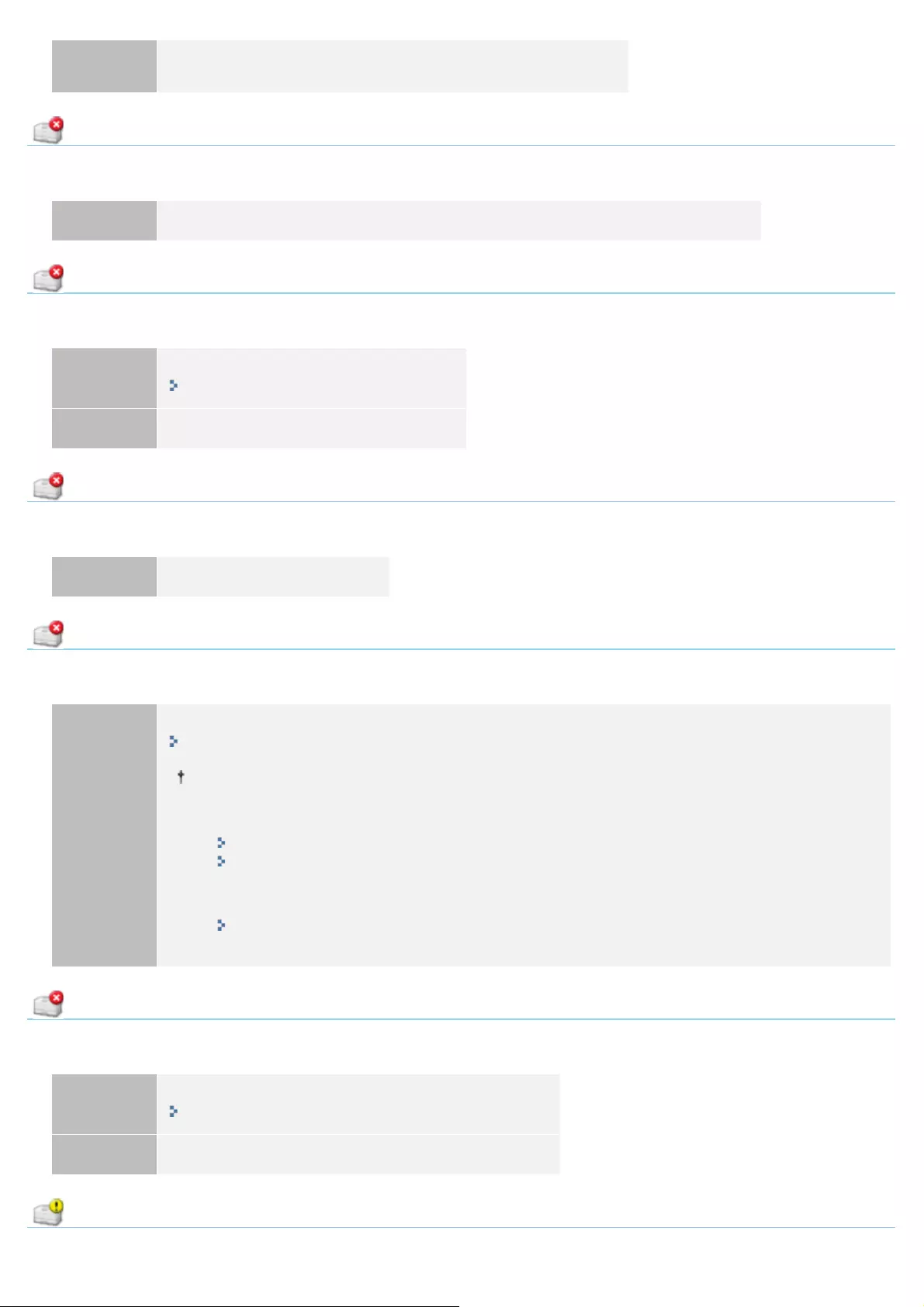
Solution The Firewall settings and so on may be the cause.
Check the communication settings for the server, clients, and so on.
Cannot Communicate with Server
<Cause> The client computer cannot communicate with the print server.
Solution Perform the described solutions in "The Print Server for Connection Cannot Be Found."
Communication Error
<Cause> The USB cable is not connected, or the printer is not turned ON.
Solution 1 Connect the USB cable properly.
"Connecting the Printer and Computer"
Solution 2 Turn the printer ON.
Incompatible Printer
<Cause> The connected printer cannot be used.
Solution Connect to the supported printer.
Incorrect Port
<Cause> The printer is connected to a port which the printer does not support.
Solution
Check the port.
"Basic Operations/Various Information for Windows"
When there is no port to use, perform one of the following solutions according to your environment.
When connecting by USB
Install the printer driver again.
"Uninstalling the Printer Driver"
"Installing the Printer Driver"
When connecting to a network
Create a port.
"Configuring and Changing the Port"
Network Communication Error
<Cause> The printer and computer are not connected, or the printer is not turned ON.
Solution 1 Connect the printer and computer to the network properly.
"Connecting the Printer and Computer"
Solution 2 Turn the printer ON.
Check the Printed Output
㻠㻡㻜㻌㻛㻌㻡㻝㻠

<Cause> You may not be able to obtain appropriate printout results.
Solution 1 Clicking [ ] (Resolve Error) continues printing.
However, the error message may appear again.
Solution 2 Cancel the print job, and then print again.
"Canceling a Job"
Check the Toner Cartridges
<Cause 1> The toner cartridges of the indicated colors are not installed properly.
Solution 1 Reinstall the toner cartridges while referring to "Replacing the Toner Cartridge."
Solution 2
Turn the printer OFF, make sure that the Main Power indicator is off, wait for 10 seconds or longer, and
then turn it ON again.
<Cause 2> The toner cartridges of the indicated colors are damaged.
Solution Replace the toner cartridges with new ones.
"Replacing the Toner Cartridge"
Cover Open
<Cause> The indicated cover is open.
Solution Close the cover firmly.
Insufficient Printer Memory
<Cause> There are pages that include large amounts of data in the current job.
Solution The data cannot be printed by the printer. Click [ ] (Cancel Job) to cancel printing.
No Toner Cartridge
<Cause> The toner cartridge is not installed.
Solution Install the toner cartridge while referring to "Replacing the Toner Cartridge."
Out of Paper
<Cause> The paper to be printed is not loaded.
㻠㻡㻝㻌㻛㻌㻡㻝㻠
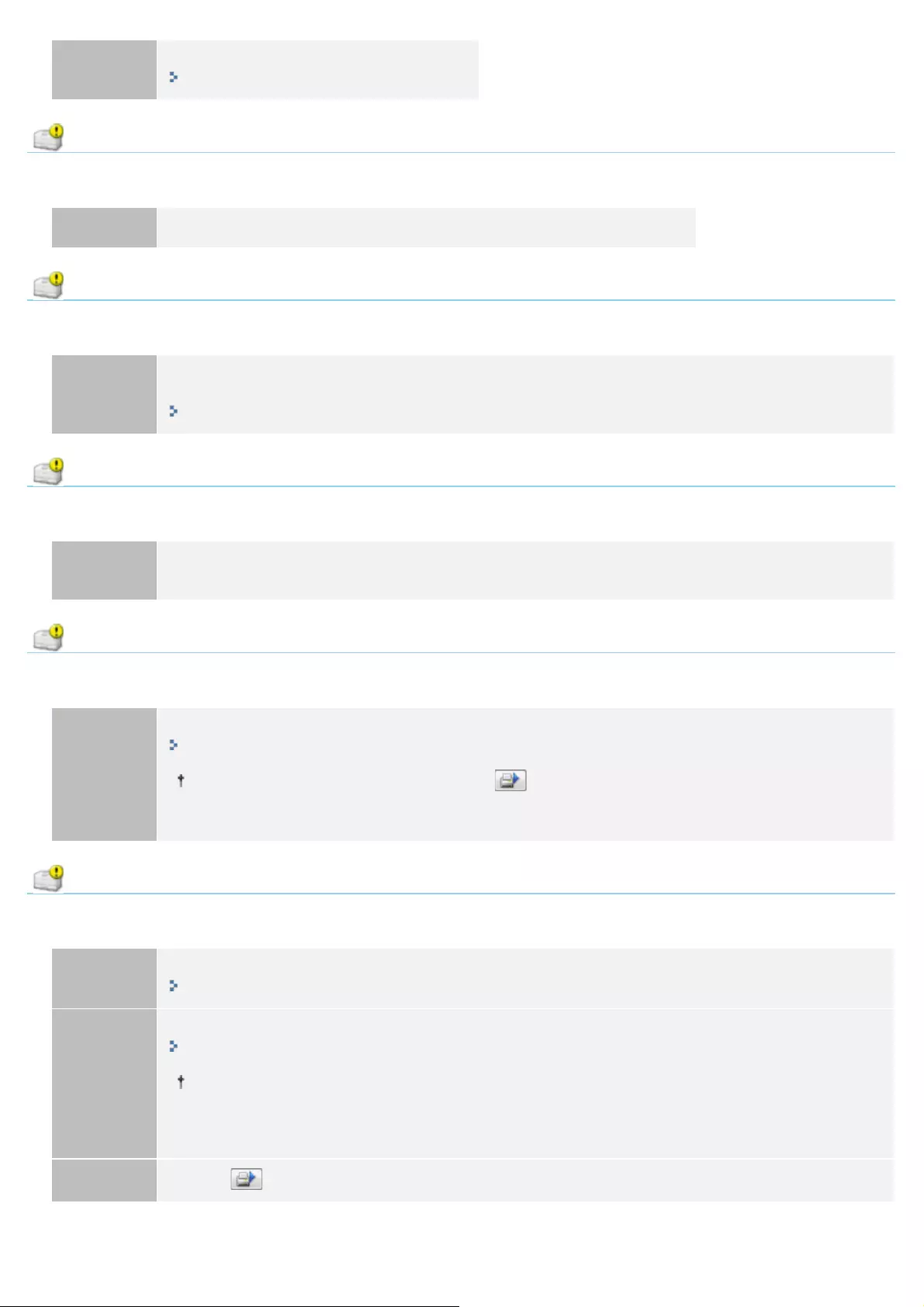
Solution Load the indicated paper in the paper drawer.
"Loading Paper"
Packing Material on Toner Cartridges
<Cause> The sealing tape is attached to the toner cartridge of the indicated color.
Solution Remove the sealing tape while referring to "Removing the Packing Materials."
Paper Jam inside Printer
<Cause> A paper jam is occurring.
Solution
Do not forcefully remove the jammed paper. Remove the jammed paper according to the procedure in the
e-Manual.
"Paper Jams"
Printer Not Ready
<Cause> The packing materials are left in the printer.
Solution Turn the printer OFF, remove all packing materials while referring to "Removing the Packing Materials,"
and then turn ON again.
Replace Toner Cartridges
<Cause> The toner cartridges of the indicated colors have reached the end of their life.
Solution
Replace the toner cartridges with new ones.
"Replacing the Toner Cartridge"
You can continue printing as is by clicking [ ] (Resolve Error), however, this may result in
damage to the printer.
Specified Paper Different from Set Paper
<Cause> Paper that is different from that of the paper setting of the job is loaded.
Solution 1 Load the indicated paper in the paper drawer.
"Loading Paper"
Solution 2
If the indicated paper is loaded, register the paper setting of the paper drawer again.
"Registering the Paper Size and Type"
If loading A5, Statement, or custom size paper in landscape orientation, select the [Feed A5
Horizontally], [Feed Statement Horizontally], or [Feed Custom Paper Horizontally] check box on the
[Paper Source] sheet of the printer driver when printing.
Solution 3 Clicking [ ] (Resolve Error) allows the printer to print on the currently loaded paper.
Toner Cartridge Replacement Recommended
㻠㻡㻞㻌㻛㻌㻡㻝㻠
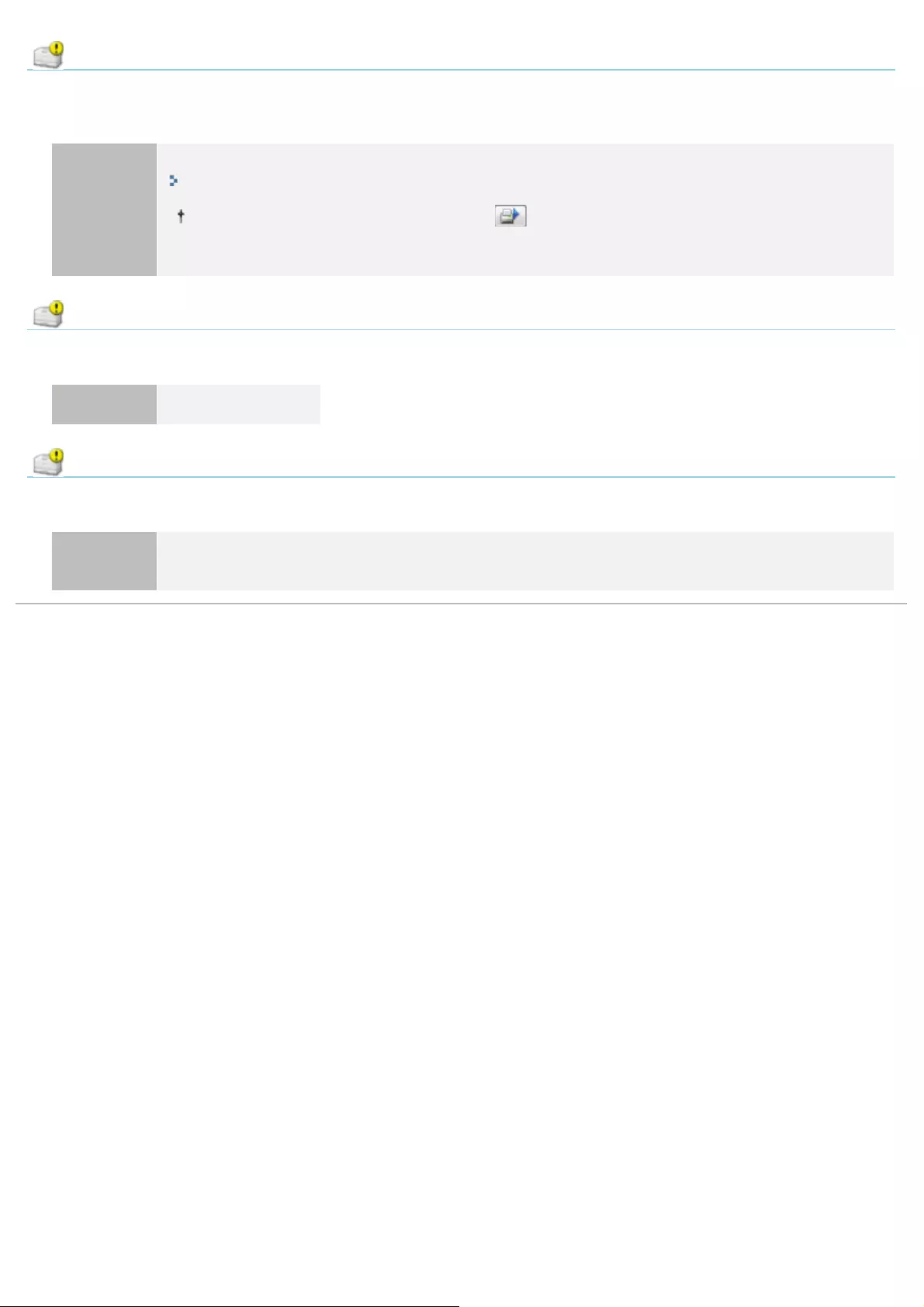
<Cause> Printing quality cannot be guaranteed due to the toner cartridges of the indicated colors
reaching the end of their life and so on.
Solution
It is recommended that you replace the toner cartridges with new ones.
"Replacing the Toner Cartridge"
You can continue printing as is by clicking [ ] (Resolve Error), however, print quality may
deteriorate.
Updating Firmware
<Cause> The firmware is being updated.
Solution Please wait a moment.
Wrong Color Toner Cartridges
<Cause> Wrong color toner cartridges are installed at the loading position for the indicated colors.
Solution Install the toner cartridges to the appropriate positions for each color while referring to "Replacing the
Toner Cartridge."
㻠㻡㻟㻌㻛㻌㻡㻝㻠
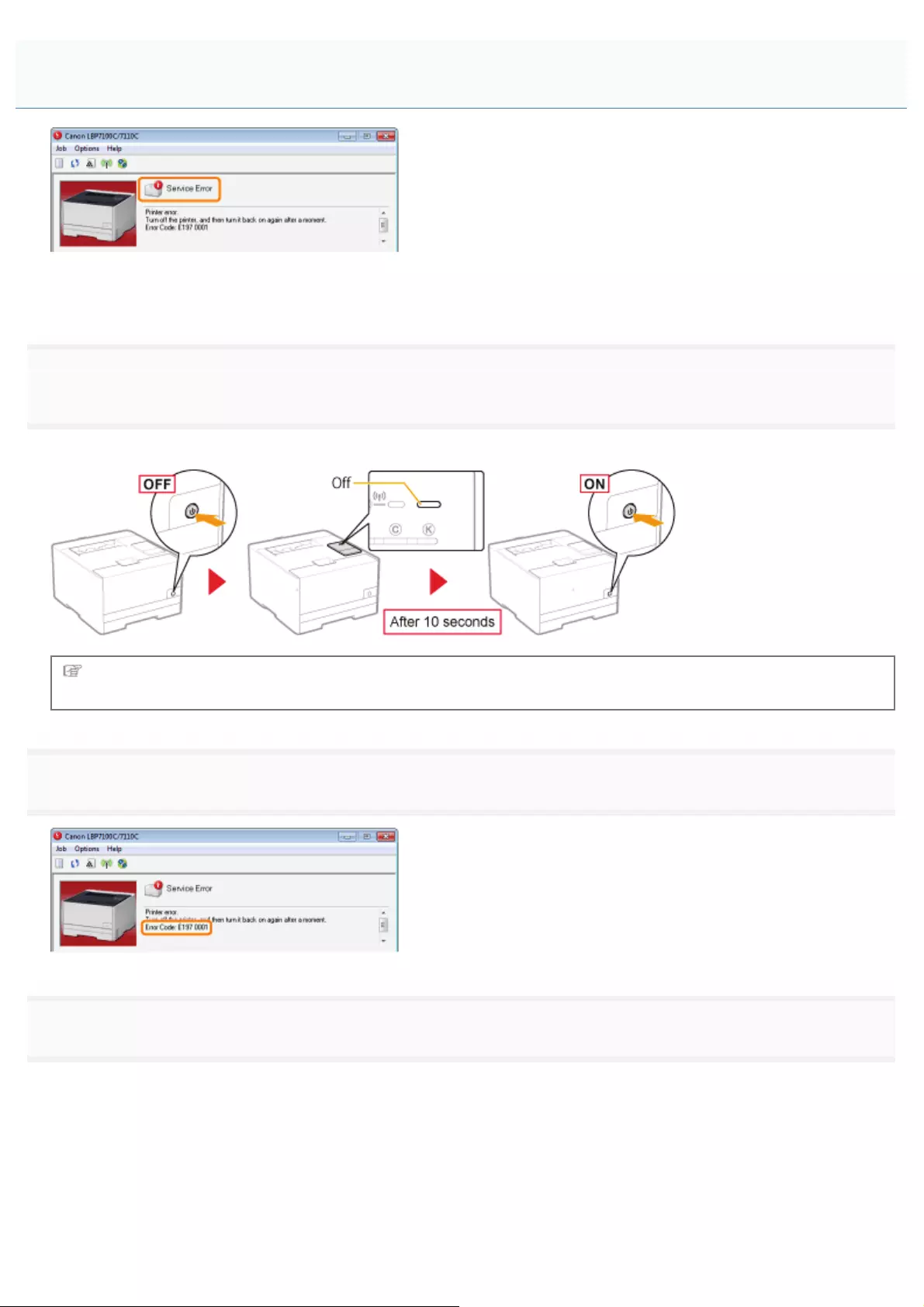
0F40-08E
If <Service Error> is displayed in the Printer Status Window, perform the following procedure to cycle the power of the
printer.
1
Turn the printer OFF, make sure that the Main Power indicator is off, wait for 10 seconds or longer,
and then turn it ON again.
If the message does not reappear, the printer is ready.
If the message reappears, you need to request service.
Follow the procedure below, and then contact your local authorized Canon dealer to request service.
2
Note down the error code displayed in the Printer Status Window.
3
Turn the printer OFF, then disconnect the cables or cords from the printer.
When <Service Error> Is Displayed
㻠㻡㻠㻌㻛㻌㻡㻝㻠
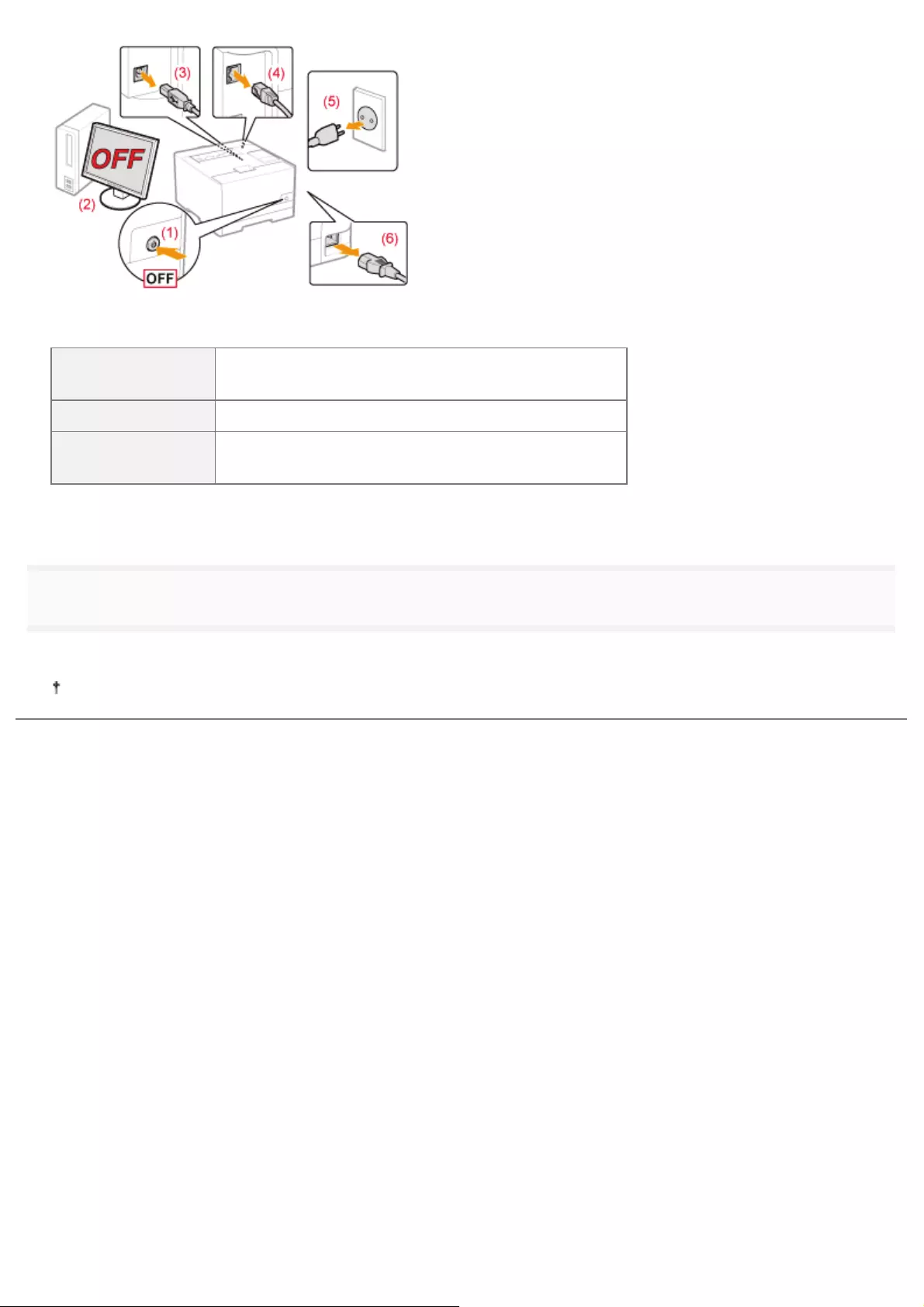
<How to disconnect the cable or cord>
USB cable*(2) Turn the computer off.
(3) Disconnect the cable from the printer.
LAN cable*(4) Disconnect the cable from the printer.
Power cord (5) Disconnect the power plug from the AC power outlet.
(6) Disconnect the cable from the printer.
*Whether the cable is connected or not varies depending on your environment.
4
Contact your local authorized Canon dealer to request service.
When contacting your Canon dealer, please report also the error code which you noted down in Step 2.
If you are not sure what the problem is, contact your local authorized Canon dealer.
㻠㻡㻡㻌㻛㻌㻡㻝㻠
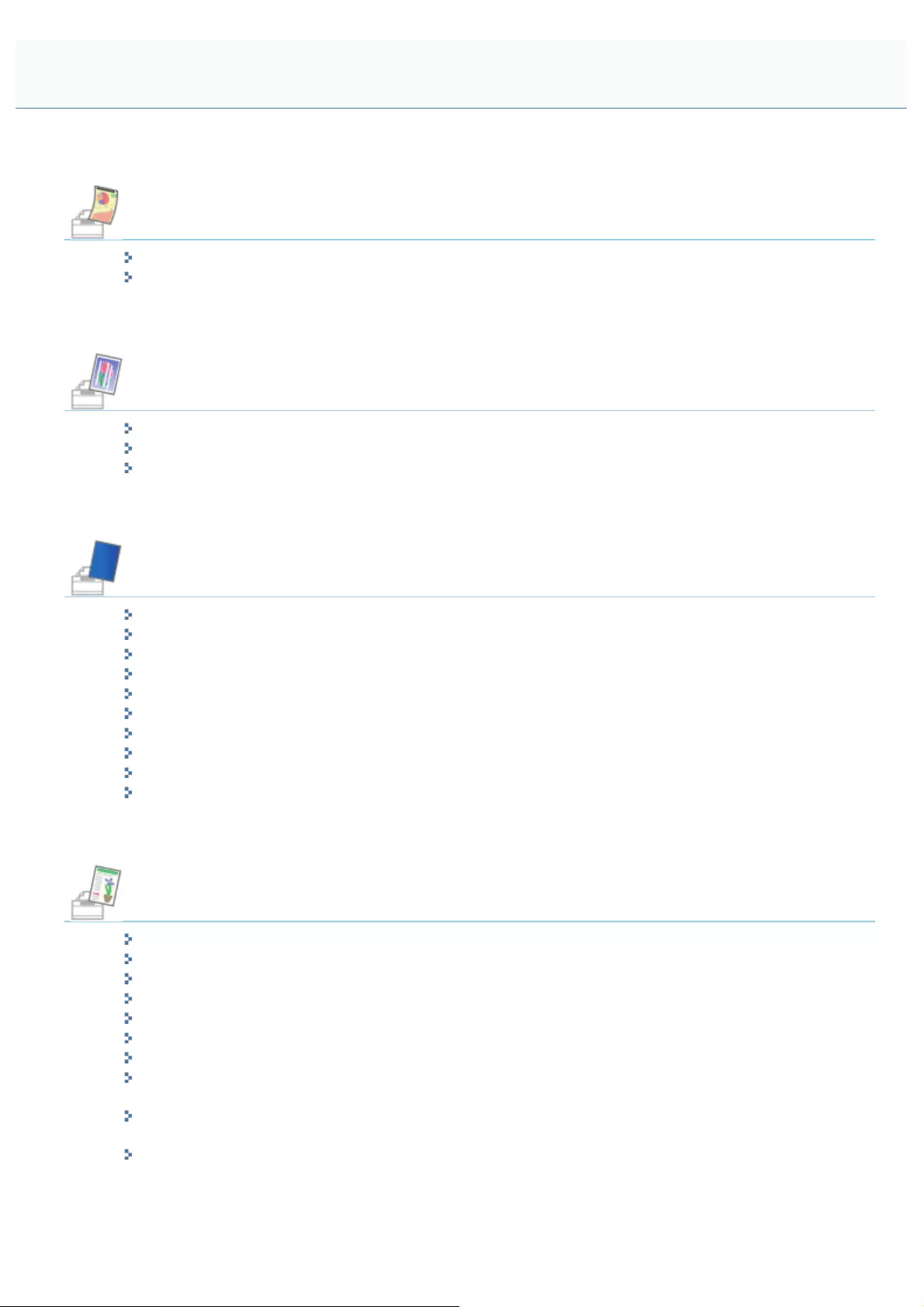
0F40-08F
Paper curls or creases.
Paper Curls
Paper Creases
Streaks (lines) appear.
White Streaks (Lines) Appear
Streaks (lines) Appear in Gradated Portions
Thin Lateral Streaks (Lateral Lines) Appear
Unevenness or smudge marks appear.
Printing Is Uneven
Printed Pages Have White Specks
Colors Are Uneven or Not Printed Smoothly
The Toner Does Not Fix onto the Paper Well
The Printed Paper Has Smudge Marks
Smudge Marks of Spattering Toner Appear around the Text or Patterns
The Back of the Printed Paper Has Smudge Marks
The Overall Print Result Is Dark
Residual Images Appear on Non-printed Areas
White Dust Is Attached to the Printed Transparencies
Printing is faint, is faded, has a problem with color, and so on.
The Overall Print Result Is Faint
Printing Is Faded
Colored Text Appears Blurred
Data Is Not Printed in the Correct Color (Specified Color) Due to Color Mismatches
Thin Lines or Fill Patterns Are Not Printed with the Specified Colors or Do Not Appear At All
Shaded Patterns Are Not Printed in the Correct Color (Specified Color)
Photographs and so on Are Printed in Different Colors from Those Displayed on the Monitor
Fill Patterns and Borders Are Not Printed in the Correct Color (Specified Color) Even When the Same
Color Is Specified for Them
Square Areas That Cannot Be Seen on the Display Appear around Lines or Text and Are Printed in a
Different Color from the Other Areas
Adjusting the Color and so on for Printing
Poor Printout Results
㻠㻡㻢㻌㻛㻌㻡㻝㻠
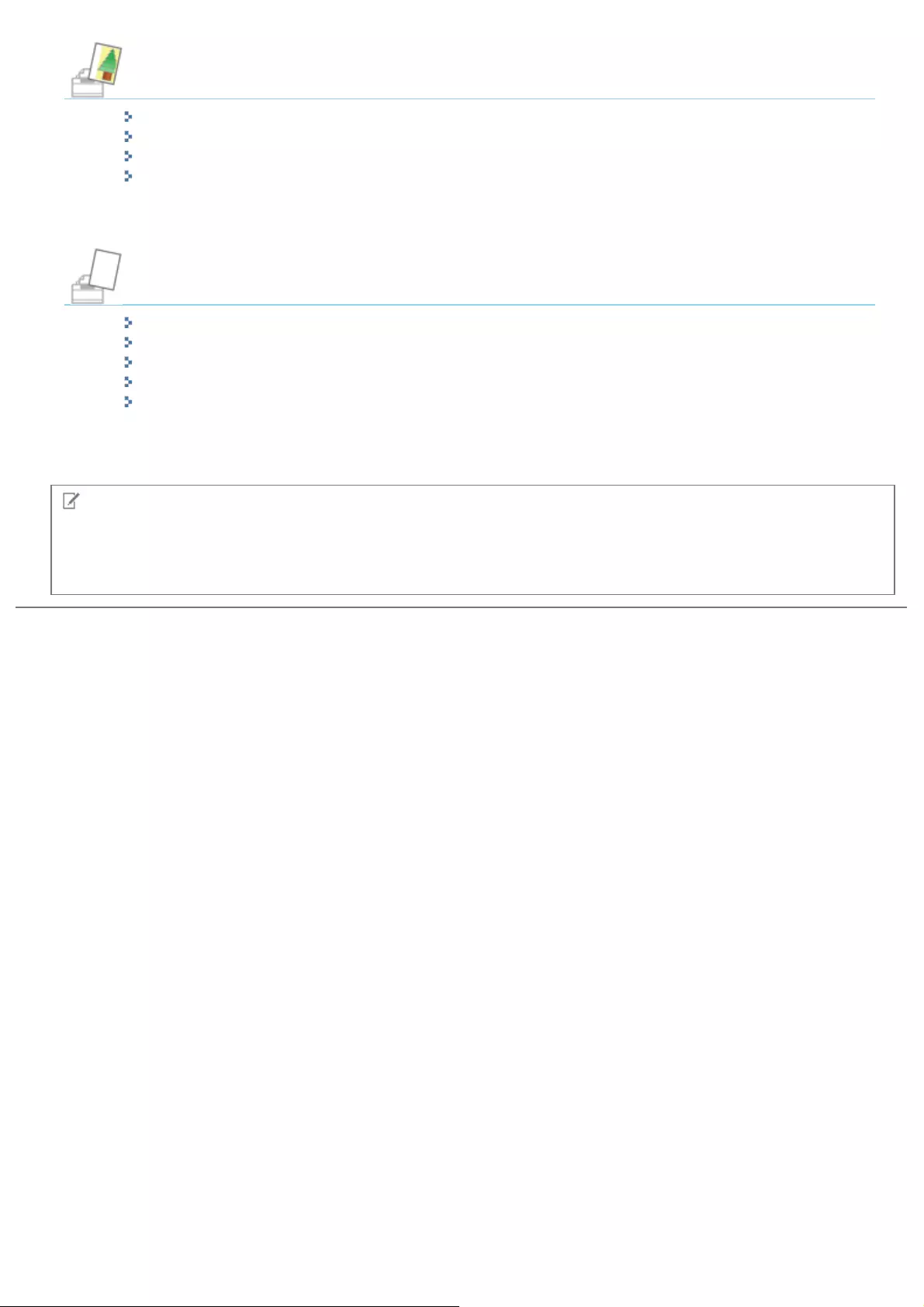
Printout is skewed, missing, or has unneeded space.
The Printing Position Is Skewed
A Portion of the Page Is Not Printed (Printed Data Lies Outside Paper)
Data Is Reduced and Printed
The Next Page Is Printed from Halfway across the Previous Page
Others
Blank Paper Is Output (Nothing Is Printed on the Paper)
The Overall Surface of the Paper Is Printed in a Particular Color
The Flap of the Printed Envelope Sticks
Multiple Sheets of Paper Are Fed at a Time
Printed Bar Codes Cannot Be Scanned
NOTE
Contacting your local authorized Canon dealer
If a problem that is not indicated in the e-Manual occurs, if none of the suggested measures solve the problem, or if you
cannot determine the problem, contact your local authorized Canon dealer.
㻠㻡㻣㻌㻛㻌㻡㻝㻠

0F40-08H
Perform one of the following solutions according to the cause.
<Cause 1> Damp paper is used.
Solution Replace the paper with new paper in an unopened package.
"Precautions for Paper"
<Cause 2> Appropriate paper is not being used.
Solution Replace the paper with that which can be used with this printer.
"Usable Paper"
<Cause 3> 60 g/m² paper is being used.
Solution
Perform the following procedure in the printer driver.
1. Display the [Paper Source] sheet.
2. Set [Paper Type] to [Thin 2].
<Cause 4> When 60 to 74 g/m² paper is printed, depending on the operating environment
(especially in a high-humidity environment), the paper may curl as either of the following.
Side View Front View
Solution 1
Perform the following procedure in the printer driver.
1. Display the [Paper Source] sheet.
2. Set [Paper Type] to [Thin 2].
If you change the settings, the toner may not fix onto paper well, and the printing may come out
faint.
Perform the following procedure in the Printer Status Window.
1. Display the Printer Status Window.
Paper Curls
㻠㻡㻤㻌㻛㻌㻡㻝㻠
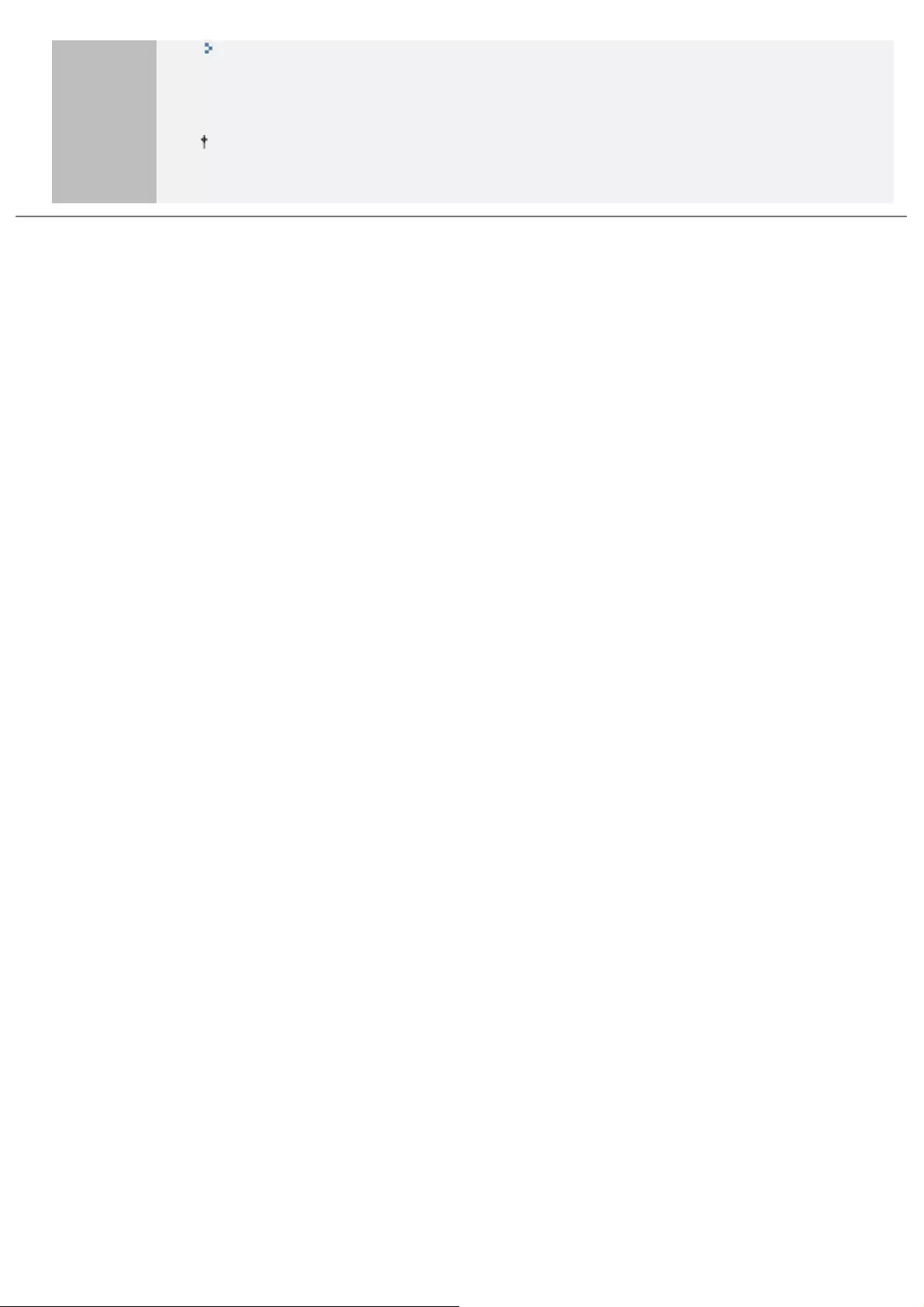
Solution 2
"Printer Status Window"
2. )URPWKH>2SWLRQV@PHQXVHOHFW>'HYLFH6HWWLQJV@ĺ>$VVLVWLQJ3ULQW6HWWLQJV@
3. Select the [Perform Curl Correction for Output Paper] check box.
[Perform Curl Correction for Output Paper] is enabled only when [Paper Type] in the [Paper
Source] sheet in the printer driver is set to [Thin 1].
㻠㻡㻥㻌㻛㻌㻡㻝㻠

0F40-08J
Perform one of the following solutions according to the cause.
<Cause 1> The paper is not loaded properly.
Solution Load the paper properly.
"Loading Paper"
<Cause 2> Damp paper is used.
Solution Replace the paper with new paper in an unopened package.
"Precautions for Paper"
<Cause 3> Appropriate paper is not being used.
Solution Replace the paper with that which can be used with this printer.
"Usable Paper"
<Cause 4> There is a foreign object inside the printer.
Solution Remove the foreign object inside the printer.
<Cause 5> When 60 to 74 g/m² paper is printed, depending on the operating environment
(especially in a high-humidity environment), the paper may be creased.
Solution 1
Perform the following procedure in the printer driver.
1. Display the [Paper Source] sheet.
2. Set [Paper Type] to [Thin 2].
If you change the settings, the toner may not fix onto paper well, and the printing may come out
faint.
Solution 2
Perform the following procedure in the Printer Status Window.
1. Display the Printer Status Window.
"Printer Status Window"
2. )URPWKH>2SWLRQV@PHQXVHOHFW>'HYLFH6HWWLQJV@ĺ>$VVLVWLQJ3ULQW6HWWLQJV@
3. Select the [Perform Curl Correction for Output Paper] check box.
[Perform Curl Correction for Output Paper] is enabled only when [Paper Type] in the [Paper
Source] sheet in the printer driver is set to [Thin 1].
Paper Creases
㻠㻢㻜㻌㻛㻌㻡㻝㻠
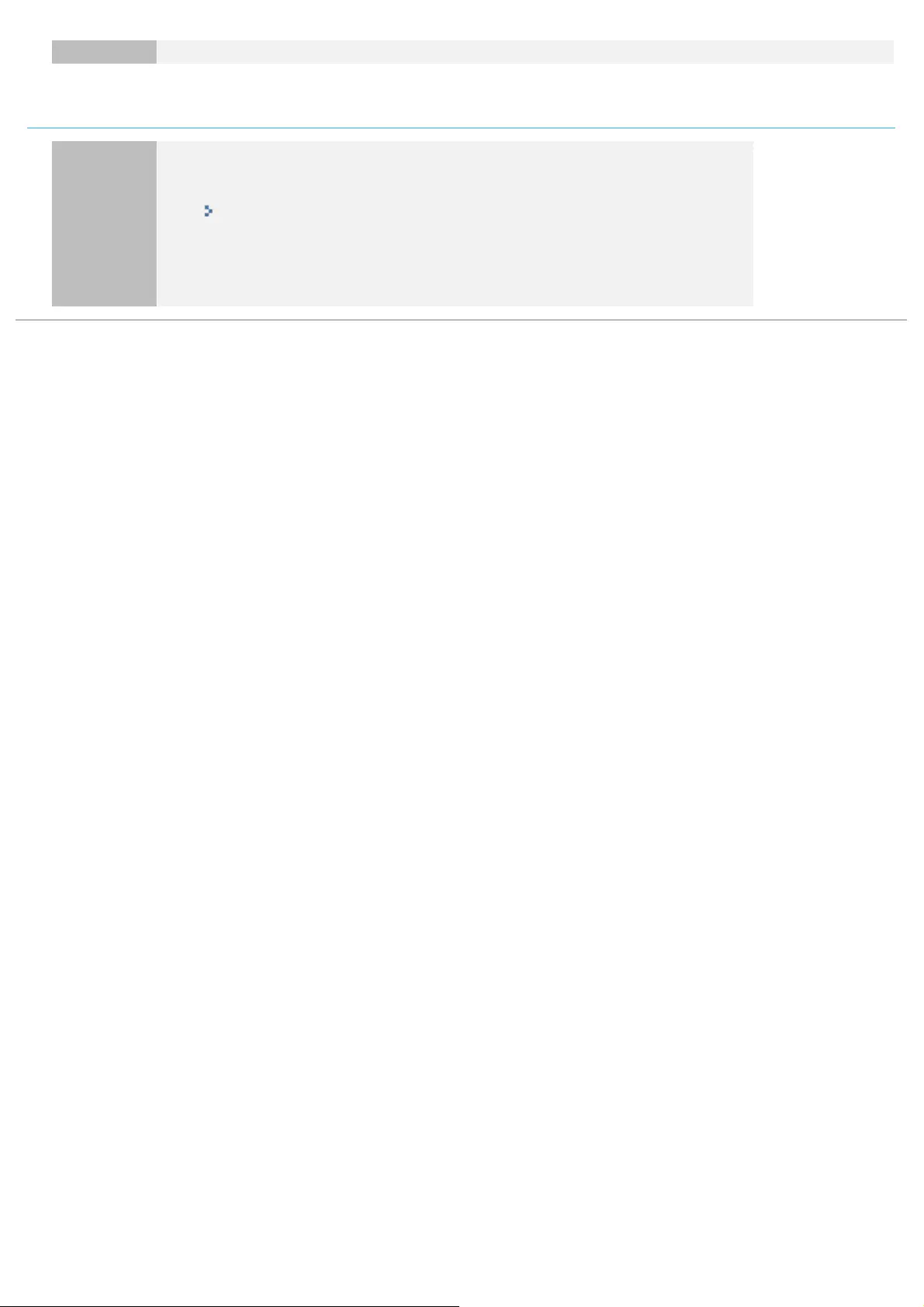
<Cause 6> When printing envelopes, the envelopes may crease depending on the type of the
envelopes or the operating environment (especially in a high-humidity environment).
Solution
Perform the following procedure in the Printer Status Window.
1. Display the Printer Status Window.
"Printer Status Window"
2. )URPWKH>2SWLRQV@PHQXVHOHFW>'HYLFH6HWWLQJV@ĺ>$VVLVWLQJ3ULQW6HWWLQJV@
3. Select the [Perform Envelope Wrinkle Reduction When Printing] check box.
㻠㻢㻝㻌㻛㻌㻡㻝㻠

0F40-08L
Perform the following procedure.
<Cause> [Gray Compensation] is applied to the gray color portions of the streaks (lines) in the
diagram.
Solution
Perform the following procedure in the printer driver.
1. Display the [Quality] sheet.
2. Click [Advanced Settings].
3. Set [Gray Compensation] to [Never].
Streaks (lines) Appear in Gradated Portions
㻠㻢㻟㻌㻛㻌㻡㻝㻠
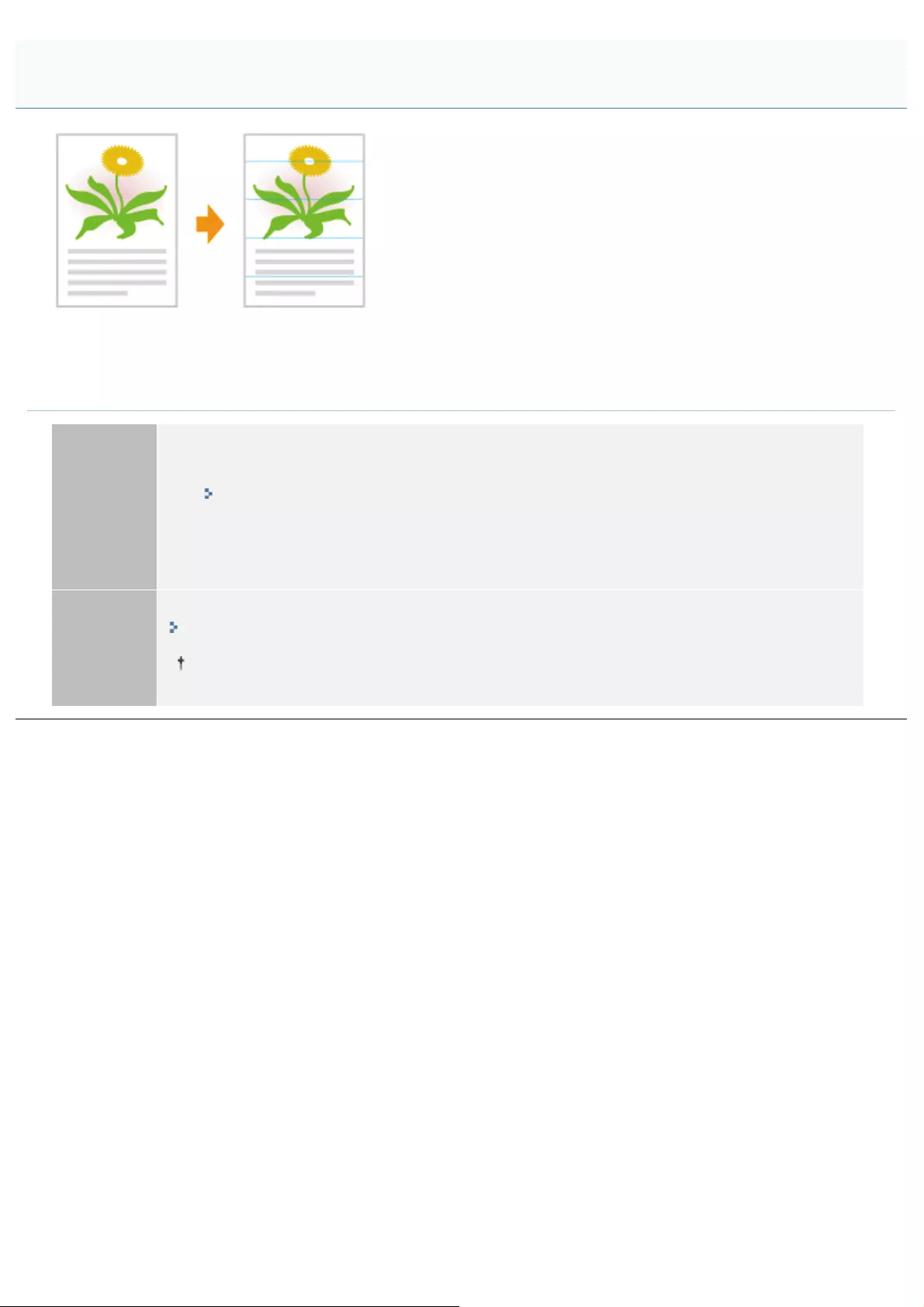
0F40-08R
Perform the following procedure.
<Cause> After the printer has been idling for a long time or depending on the paper type, thin
lateral streaks (lateral lines) may appear in halftone areas and white paper areas.
Solution 1
Perform the following procedure in the Printer Status Window.
1. Display the Printer Status Window.
"Printer Status Window"
2. )URPWKH>2SWLRQV@PHQXVHOHFW>'HYLFH6HWWLQJV@ĺ>$VVLVWLQJ3ULQW6HWWLQJV@
3. Select the [Prevent Poor Quality after Long Idle] check box.
Solution 2
Replace the toner cartridges with new ones.
"Replacing the Toner Cartridge"
Use the printer with the [Prevent Poor Quality after Long Idle] check box selected in Solution 1.
Thin Lateral Streaks (Lateral Lines) Appear
㻠㻢㻠㻌㻛㻌㻡㻝㻠
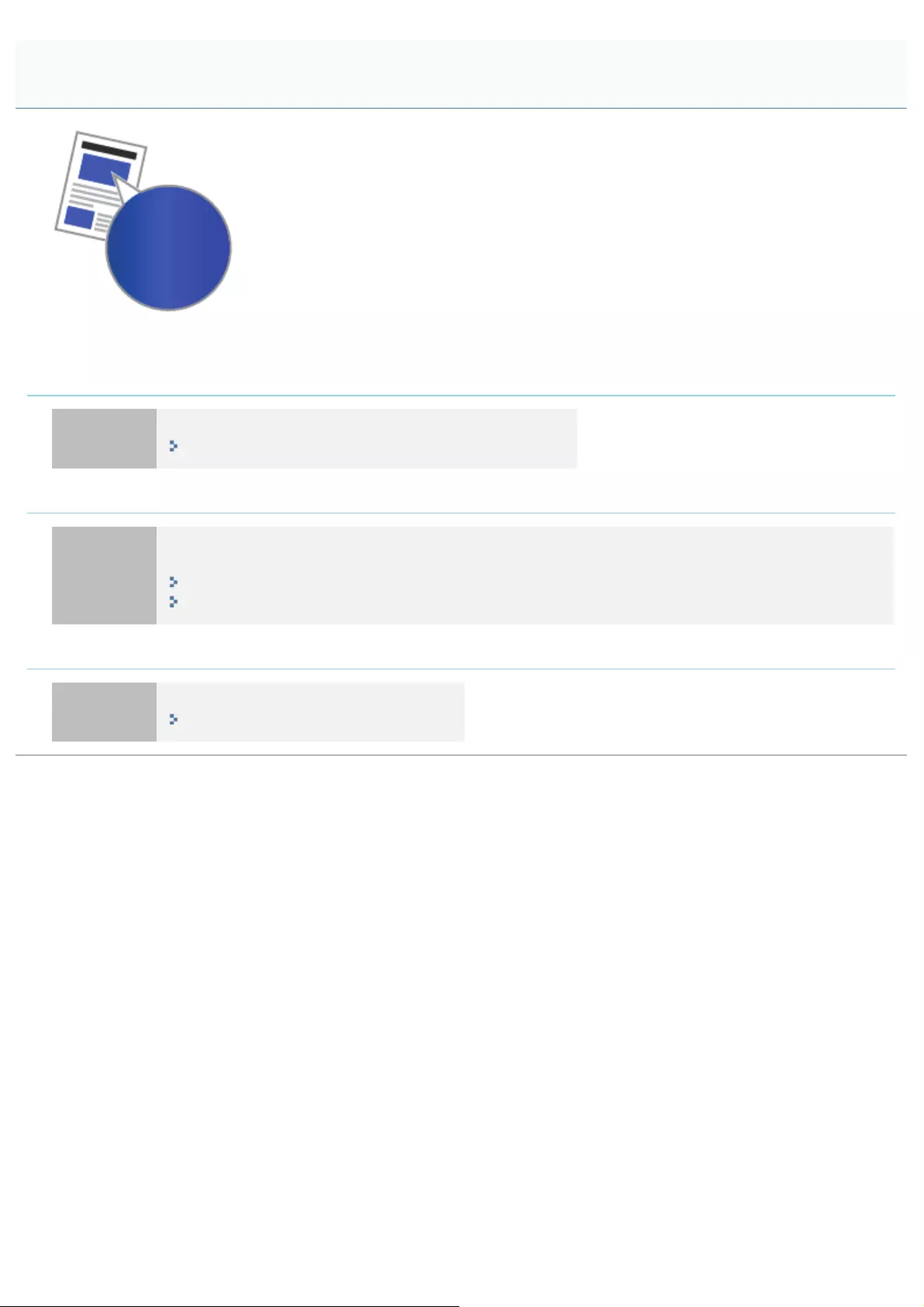
0F40-08S
Perform one of the following solutions according to the cause.
<Cause 1> Paper is too moist or too dry.
Solution Replace the paper with new paper in an unopened package.
"Precautions for Paper"
<Cause 2> The toner cartridges are almost out of toner.
Solution
Check the toner cartridges status and replace the toner cartridges of the colors are nearing the end of
their life.
"Checking the Consumables Status"
"Replacing the Toner Cartridge"
<Cause 3> The drum in any of the toner cartridges has deteriorated.
Solution Replace the toner cartridges with new ones.
"Replacing the Toner Cartridge"
Printing Is Uneven
㻠㻢㻡㻌㻛㻌㻡㻝㻠
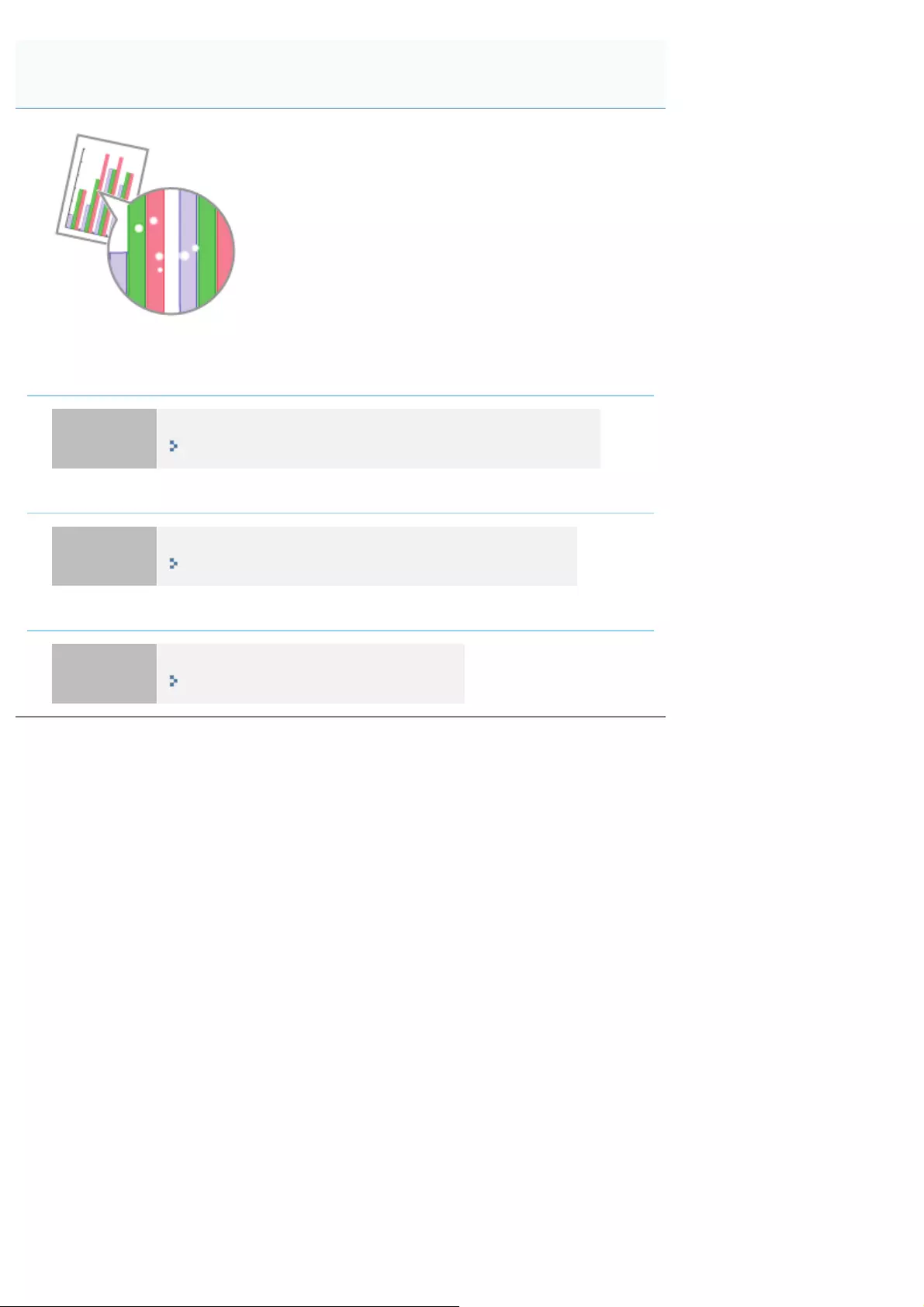
0F40-08U
Perform one of the following solutions according to the cause.
<Cause 1> Appropriate paper is not being used.
Solution Replace the paper with that which can be used with this printer.
"Usable Paper"
<Cause 2> Damp paper is used.
Solution Replace the paper with new paper in an unopened package.
"Precautions for Paper"
<Cause 3> The drum in any of the toner cartridges has deteriorated.
Solution Replace the toner cartridges with new ones.
"Replacing the Toner Cartridge"
Printed Pages Have White Specks
㻠㻢㻢㻌㻛㻌㻡㻝㻠
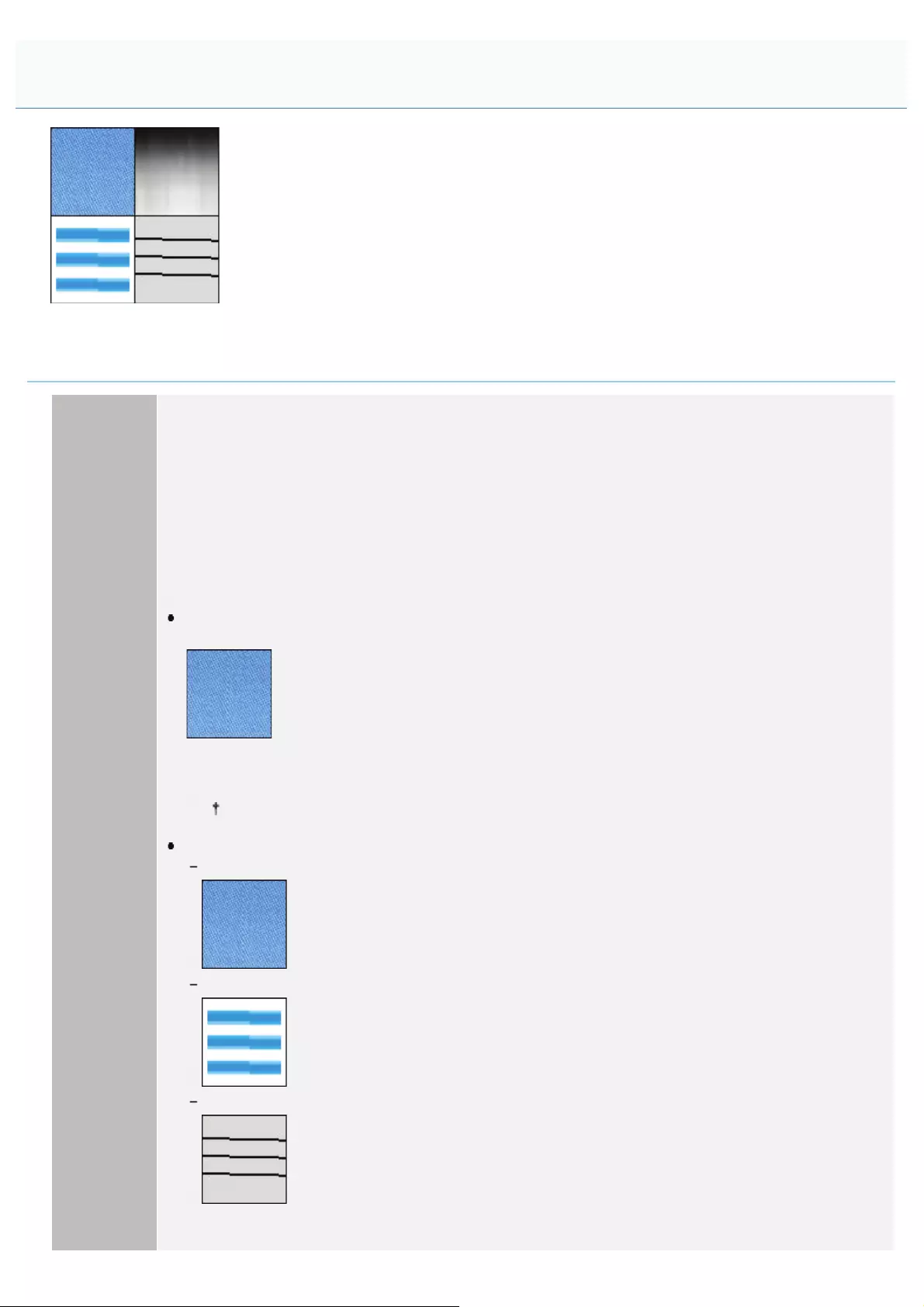
0F40-08W
Perform the following procedure.
<Cause> Large characters, wide lines, or diagrams with high color density were printed.
Solution
Perform the following procedure in the printer driver.
1. Display the [Finishing] sheet.
2. Click [Advanced Settings].
3. Select the appropriate mode for [Special Smoothing Mode].
Normally, select [Mode 1] for [Special Smoothing Mode].
If the following conditions occur when [Mode 1] is selected, select any setting between [Mode 2] and
[Mode 6].
When the inside of dense graphics, large characters, or thick lines are not printed
smoothly
Select [Mode 2].
When [Mode 2] is selected, color unevenness may be found in light areas.
If the following problems occur at the same time
The inside of dense graphics, large characters, or thick lines are not printed smoothly.
Outlines of light graphics, characters, and lines are not printed smoothly.
Characters and lines against a filled background are not printed smoothly.
Select [Mode 3].
Colors Are Uneven or Not Printed Smoothly
㻠㻢㻣㻌㻛㻌㻡㻝㻠
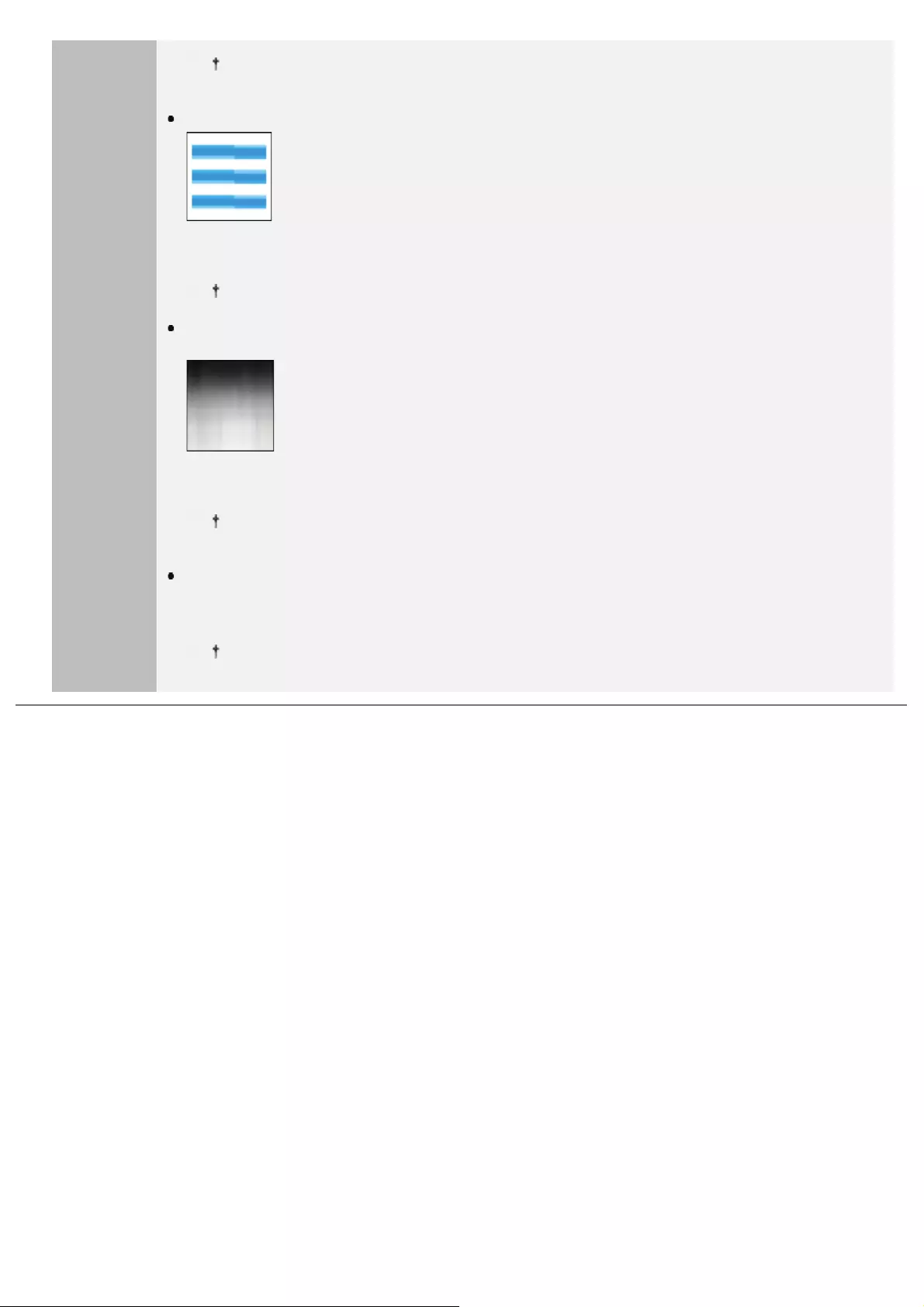
When [Mode 3] is selected, color unevenness may be found in light areas and shaded
patterns.
When outlines of light graphics, characters, and lines are not printed smoothly
Select [Mode 4].
When [Mode 4] is selected, color unevenness may be found in light areas.
When strip-shaped unevenness appears on images (photographic images),
graphics, gradations, and shaded patterns
Select [Mode 5].
When [Mode 5] is selected, characters, lines, and areas around graphics may not be printed
smoothly.
When the entire document is not printed smoothly
Select [Mode 6].
When [Mode 6] is selected, color unevenness may be appear.
㻠㻢㻤㻌㻛㻌㻡㻝㻠

0F40-08X
Perform one of the following solutions according to the cause.
<Cause 1> The setting for [Paper Type] is not specified properly.
Solution
Specify [Paper Type] properly.
If you are using envelopes, specify [Envelope H].
"Basic Printing Procedure"
<Cause 2> Appropriate paper is not being used.
Solution Replace the paper with that which can be used with this printer.
"Usable Paper"
<Cause 3> Depending on the paper type, toner fixation may deteriorate.
Solution
Perform the following procedure in the printer driver.
1. Display the [Quality] sheet.
2. Click [Advanced Settings].
3. Set [Gray Compensation] to [Always].
<Cause 4> A problem is occurring inside the printer.
Solution If <Service Error> is displayed in the Printer Status Window, perform the solution using the procedure in
"When <Service Error> Is Displayed."
The Toner Does Not Fix onto the Paper Well
㻠㻢㻥㻌㻛㻌㻡㻝㻠
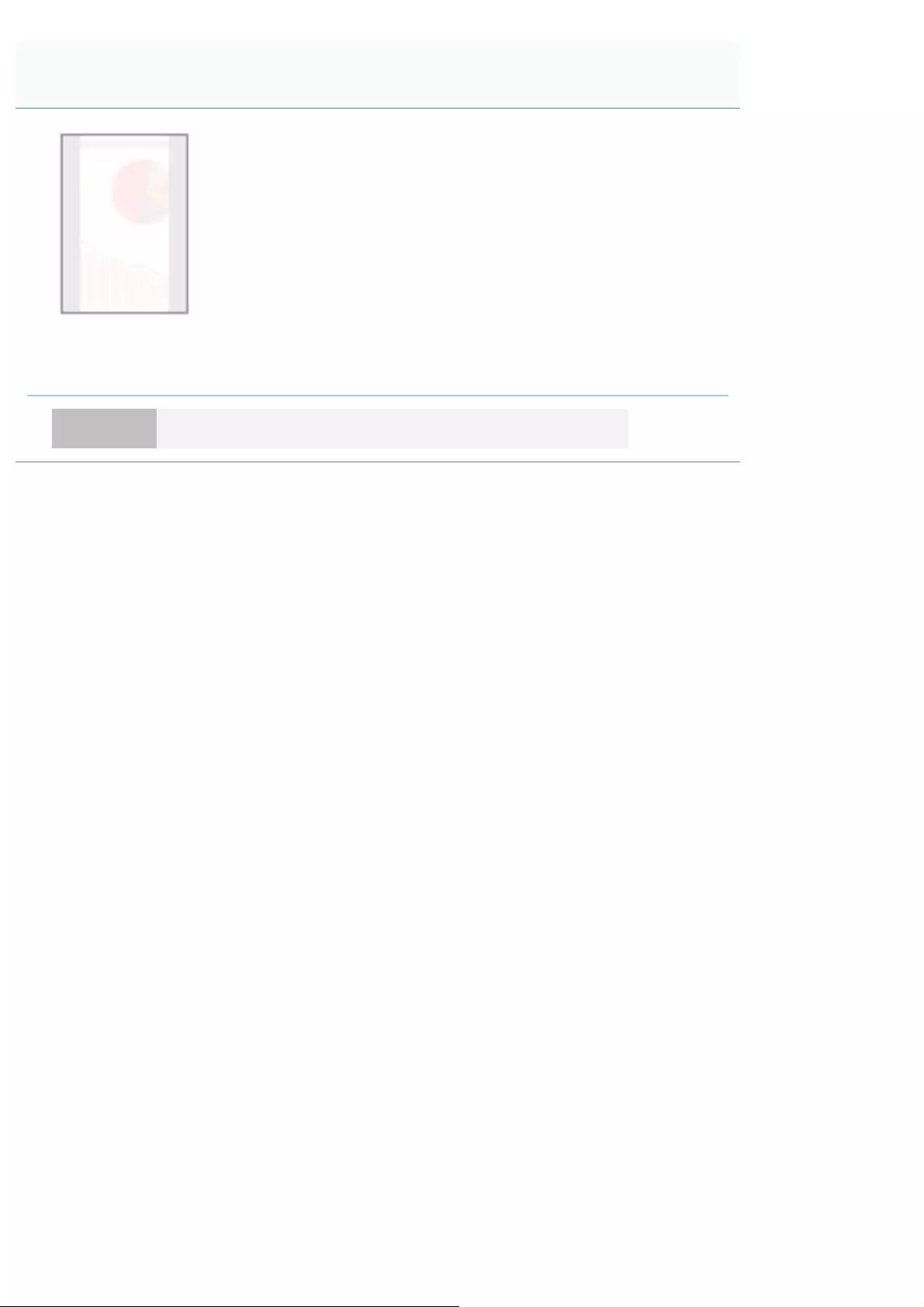
0F40-091
Perform the following procedure.
<Cause> The size of the print data was larger than that of the loaded paper.
Solution Check if the size of the print data matches that of the loaded paper.
The Back of the Printed Paper Has Smudge Marks
㻠㻣㻞㻌㻛㻌㻡㻝㻠
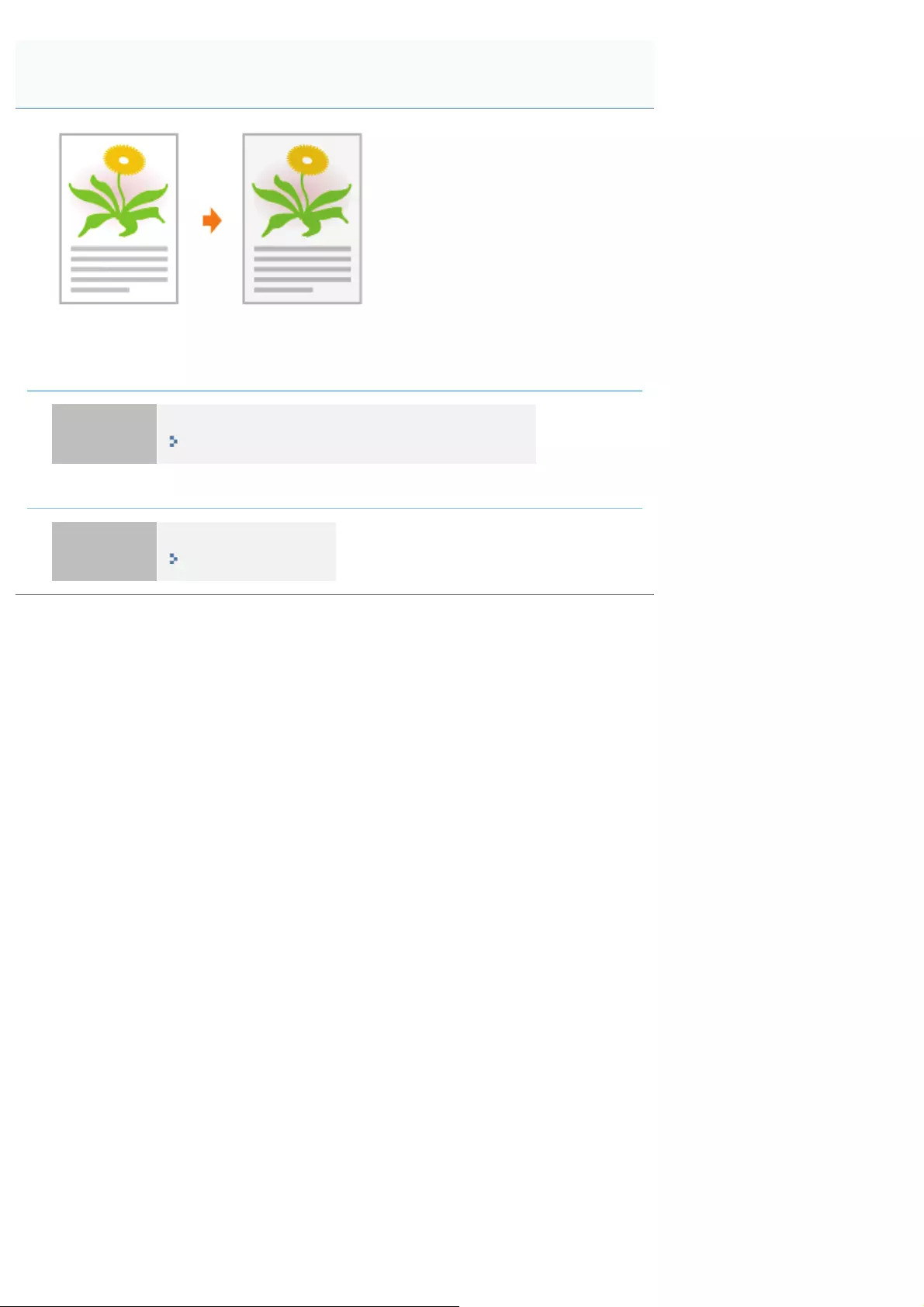
0F40-092
Perform one of the following solutions according to the cause.
<Cause 1> The setting for the toner density is not appropriate.
Solution Adjust the toner density for printing to a lighter setting.
"Adjusting the Toner Density"
<Cause 2> The printer is exposed to direct sunlight or strong light.
Solution Move the printer.
"Moving the Printer"
The Overall Print Result Is Dark
㻠㻣㻟㻌㻛㻌㻡㻝㻠
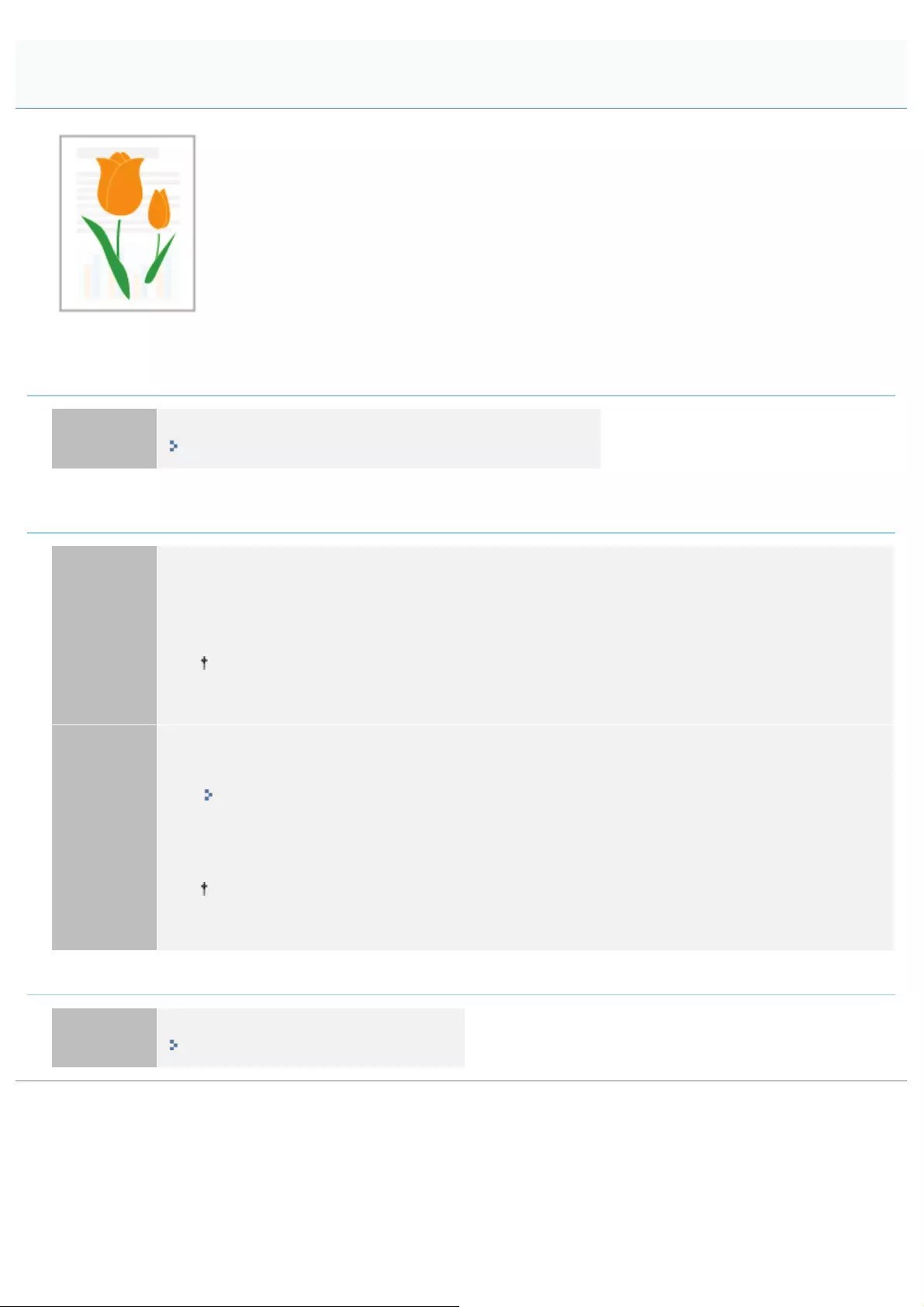
0F40-093
Perform one of the following solutions according to the cause.
<Cause 1> Appropriate paper is not being used.
Solution Replace the paper with that which can be used with this printer.
"Usable Paper"
<Cause 2> When 60 to 74 g/m² paper is printed, depending on the operating environment
(especially in a high-humidity environment), residual images may appear.
Solution 1
Perform the following procedure in the printer driver.
1. Display the [Paper Source] sheet.
2. Set [Paper Type] to [Thin 2].
If you change the settings, the toner may not fix onto paper well, and the printing may come out
faint.
Solution 2
Perform the following procedure in the Printer Status Window.
1. Display the Printer Status Window.
"Printer Status Window"
2. )URPWKH>2SWLRQV@PHQXVHOHFW>'HYLFH6HWWLQJV@ĺ>$VVLVWLQJ3ULQW6HWWLQJV@
3. Select the [Perform Curl Correction for Output Paper] check box.
[Perform Curl Correction for Output Paper] is enabled only when [Paper Type] in the [Paper
Source] sheet in the printer driver is set to [Thin 1].
<Cause 3> The drum in any of the toner cartridges has deteriorated.
Solution Replace the toner cartridges with new ones.
"Replacing the Toner Cartridge"
Residual Images Appear on Non-printed Areas
㻠㻣㻠㻌㻛㻌㻡㻝㻠
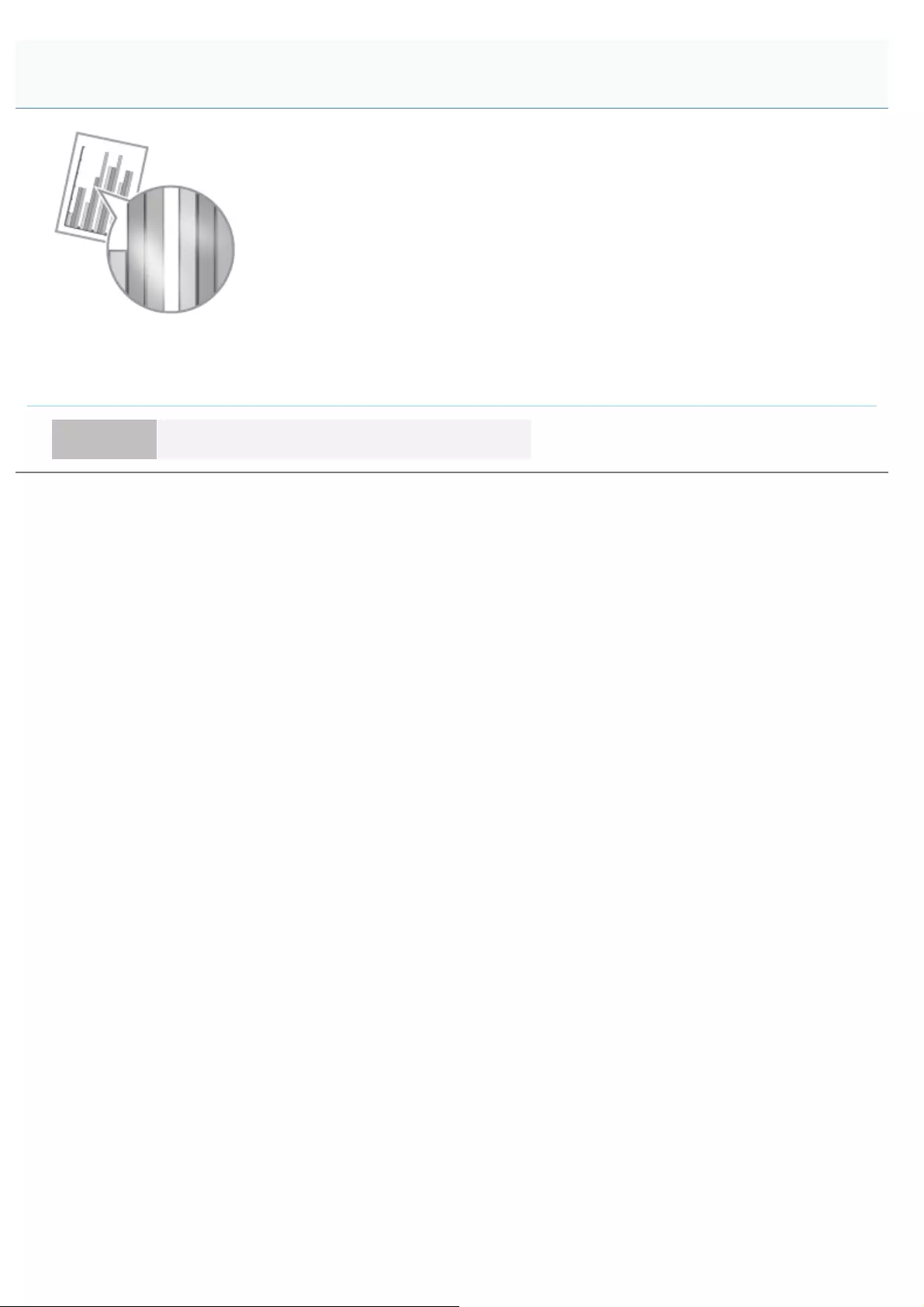
0F40-094
Perform the following procedure.
<Cause> You print transparencies after printing paper other than transparency continuously.
Solution Wipe and remove the chipped paper with a soft cloth.
White Dust Is Attached to the Printed Transparencies
㻠㻣㻡㻌㻛㻌㻡㻝㻠
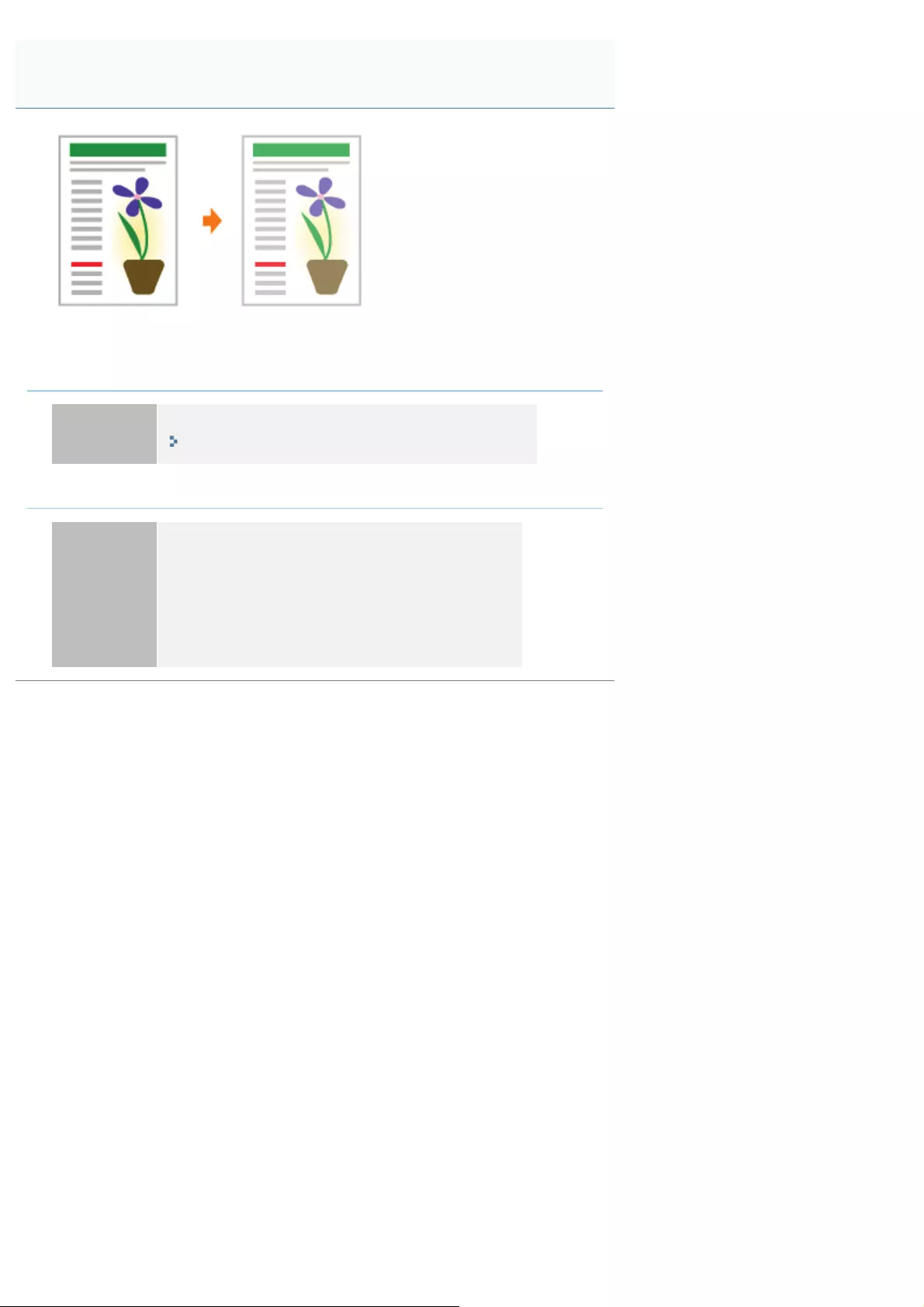
0F40-095
Perform one of the following solutions according to the cause.
<Cause 1> The setting for the toner density is not appropriate.
Solution Adjust the toner density for printing to a darker setting.
"Adjusting the Toner Density"
<Cause 2> [Toner Save] is enabled.
Solution
Perform the following procedure in the printer driver.
1. Display the [Quality] sheet.
2. Click [Advanced Settings].
3. Set [Toner Save] to [Off].
The Overall Print Result Is Faint
㻠㻣㻢㻌㻛㻌㻡㻝㻠

0F40-096
Perform one of the following solutions according to the cause.
<Cause 1> The setting for [Paper Type] is not specified properly.
Solution
Specify [Paper Type] properly.
If you are using envelopes, specify [Envelope H].
"Basic Printing Procedure"
<Cause 2> Appropriate paper is not being used.
Solution Replace the paper with that which can be used with this printer.
"Usable Paper"
<Cause 3> The toner cartridges have reached the end of their life.
Solution
Check the toner cartridges status and replace the toner cartridges of the colors have reached the end of
their life.
"Checking the Consumables Status"
"Replacing the Toner Cartridge"
<Cause 4> When coarse paper is used, the toner does not fix onto paper well, and the print
may come out faint.
Solution
Perform the following procedure in the Printer Status Window.
1. Display the Printer Status Window.
"Printer Status Window"
2. )URPWKH>2SWLRQV@PHQXVHOHFW>'HYLFH6HWWLQJV@ĺ>3DSHU6RXUFH6HWWLQJV@
3. Select the [Use Rough Paper] check box.
<Cause 5> Thin lines or text was printed.
Solution
Perform the following procedure in the printer driver.
1. Display the [Finishing] sheet.
2. Click [Advanced Settings].
3. Set [Special Fine Line Processing] to [On].
Printing Is Faded
㻠㻣㻣㻌㻛㻌㻡㻝㻠
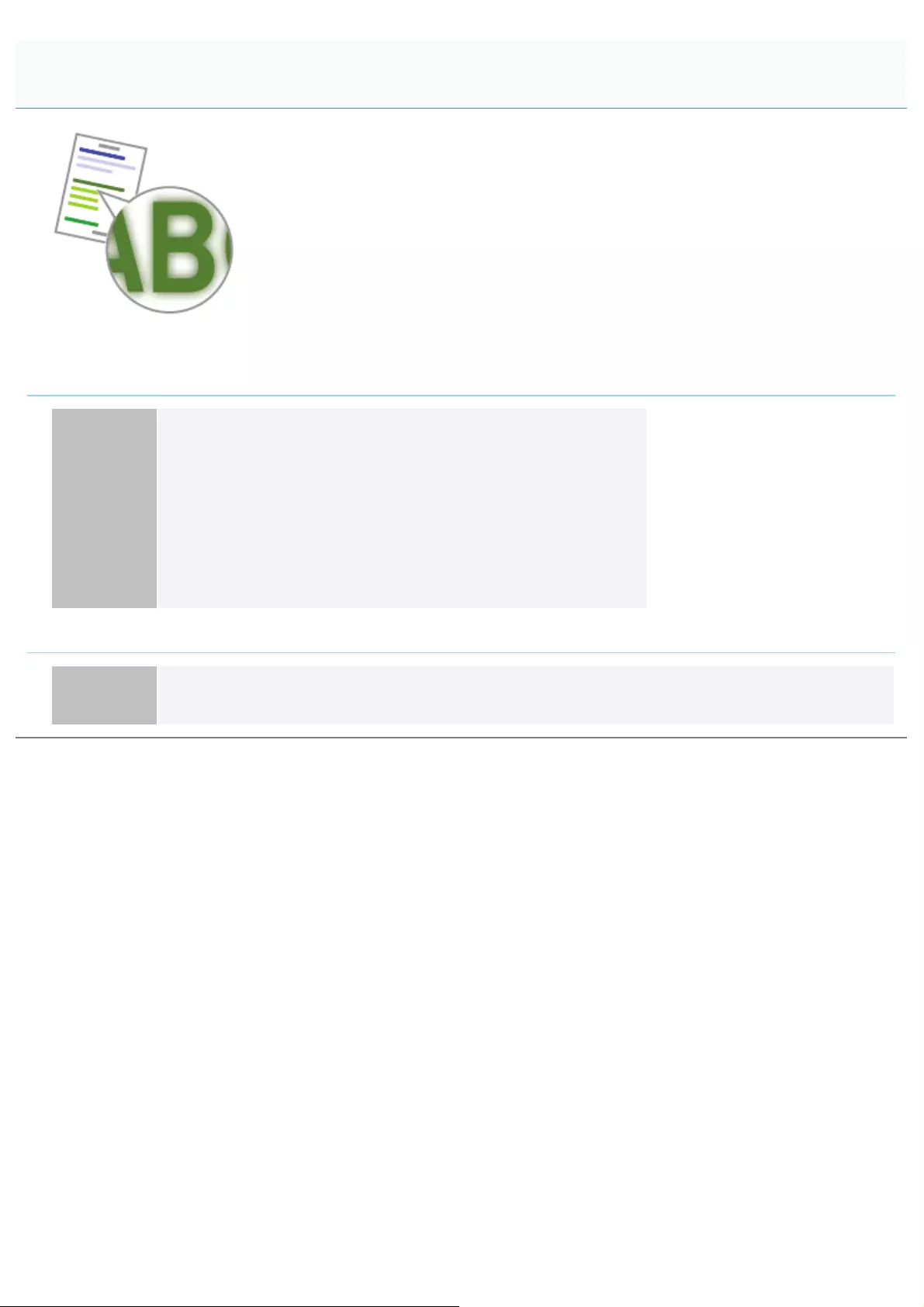
0F40-097
Perform one of the following solutions according to the cause.
<Cause 1> A bold font is being used for the colored text.
Solution
Perform the following procedure in the printer driver.
1. Display the [Quality] sheet.
2. Select the [Manual Color Settings] check box.
3. Click [Color Settings].
4. Display the [Matching] sheet.
5. Set [Matching Method] to [Perceptual [Monitor Color Matched]].
<Cause 2> Colored text appears blurred due to color mismatches.
Solution Perform the described solutions in "Data Is Not Printed in the Correct Color (Specified Color) Due to Color
Mismatches."
Colored Text Appears Blurred
㻠㻣㻤㻌㻛㻌㻡㻝㻠
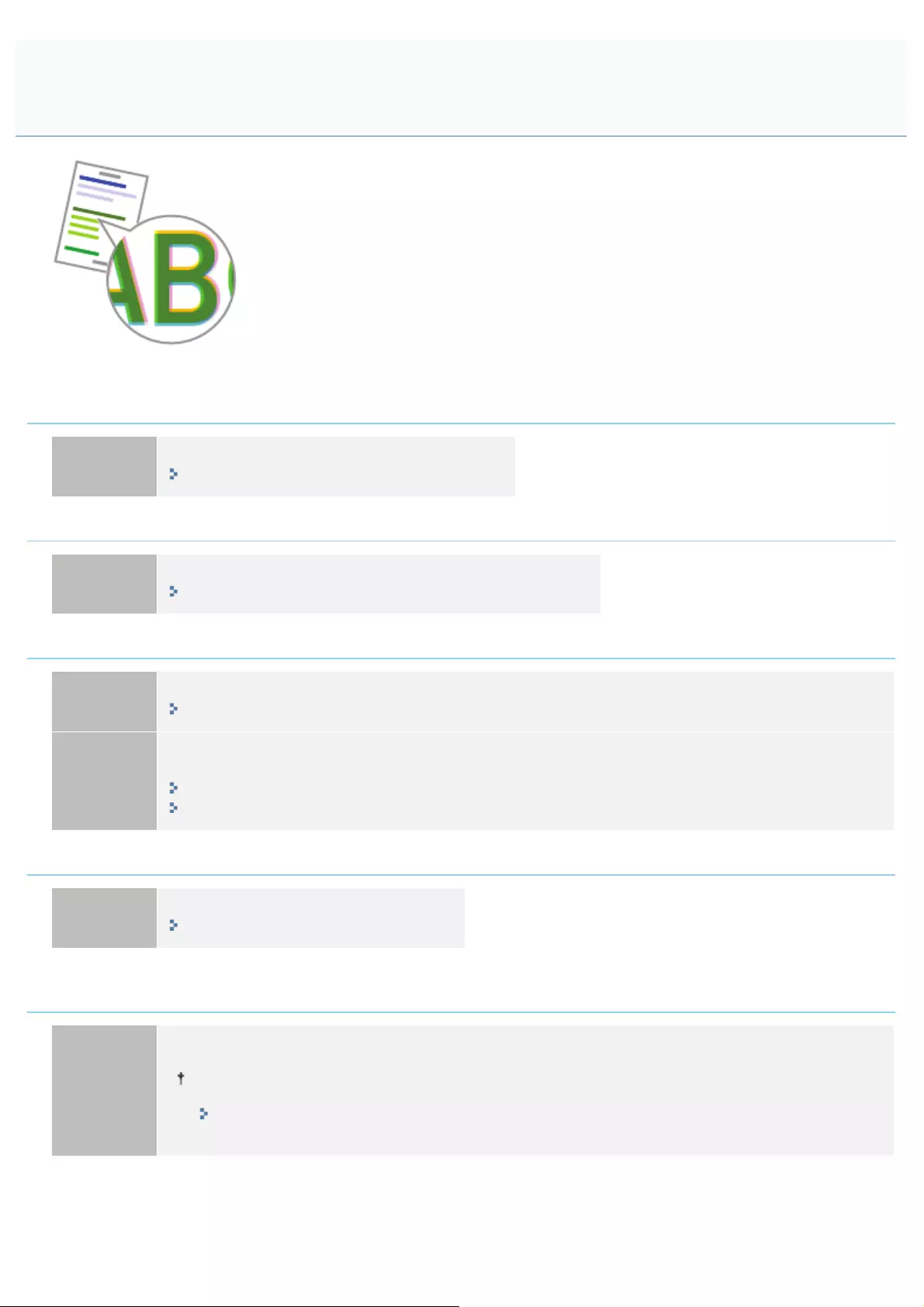
0F40-098
Perform one of the following solutions according to the cause.
<Cause 1> The toner cartridges are not installed properly.
Solution Check the installation status of the toner cartridges.
"Replacing the Toner Cartridge"
<Cause 2> Appropriate paper is not being used.
Solution Replace the paper with that which can be used with this printer.
"Usable Paper"
<Cause 3> The toner cartridges are almost out of toner.
Solution 1 Correct color mismatches.
"Correcting Color Mismatches (Color Mismatch Correction)"
Solution 2
Check the toner cartridges status and replace the toner cartridges of the colors are nearing the end of
their life.
"Checking the Consumables Status"
"Replacing the Toner Cartridge"
<Cause 4> The drum in any of the toner cartridges has deteriorated.
Solution Replace the toner cartridges with new ones.
"Replacing the Toner Cartridge"
<Cause 5> Printed before performing calibration or color mismatch correction immediately
after the printer is turned ON and so on.
Solution
Make sure that calibration or color mismatch correction is completed before sending data to the printer.
Specify whether calibration or color mismatch correction should be performed immediately after the
printer is turned ON.
"Auto Image Quality Adjustment Settings"
<About color mismatch>
Laser printers are manufactured with technology of high precision. A color mismatch may be slightly conspicuous
Data Is Not Printed in the Correct Color (Specified Color) Due to Color
Mismatches
㻠㻣㻥㻌㻛㻌㻡㻝㻠
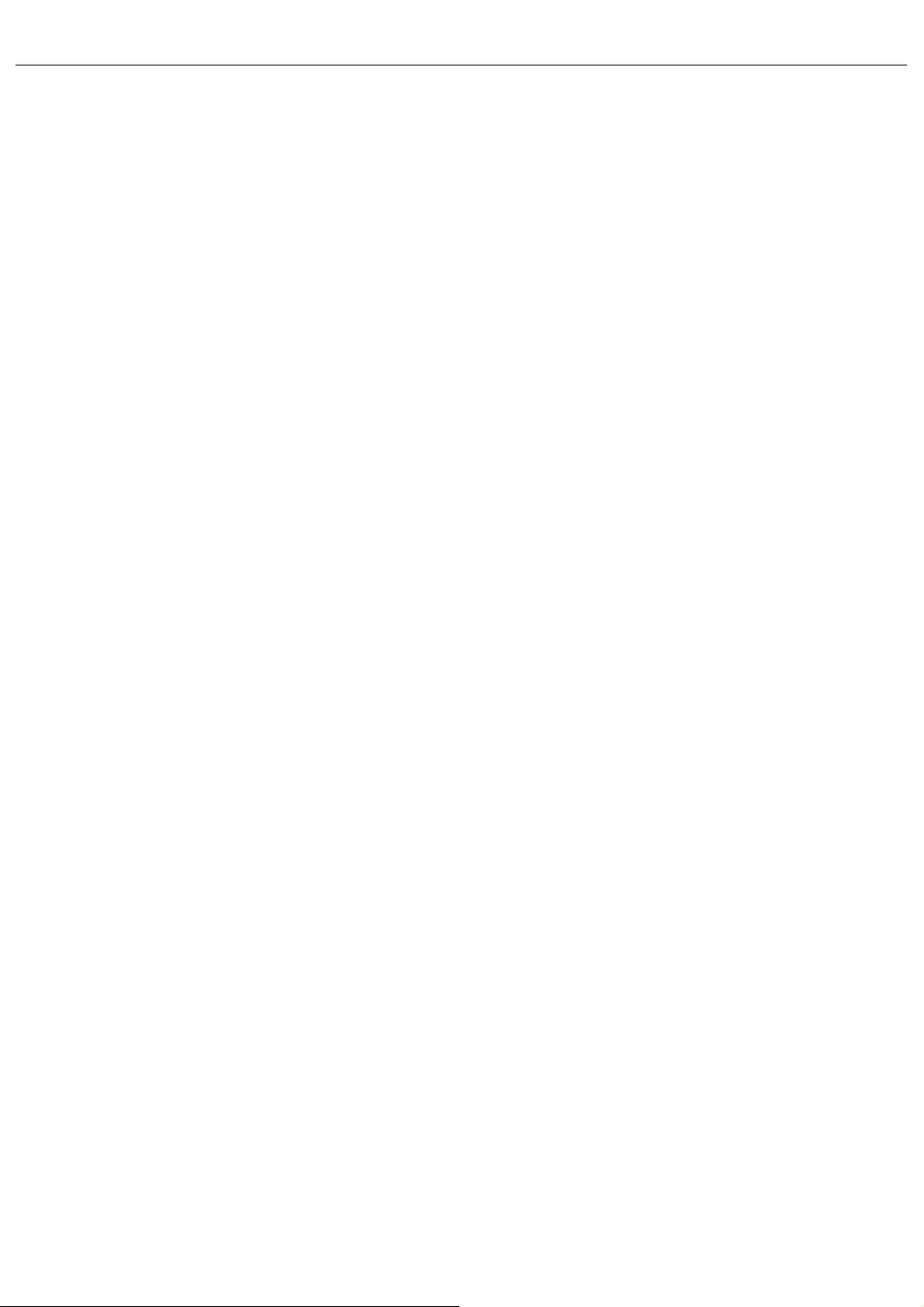
depending on the print image. Please note that this is due to the structure of laser printers and is not a printer malfunction.
㻠㻤㻜㻌㻛㻌㻡㻝㻠

0F40-099
Perform one of the following solutions according to the cause.
<Cause 1> Some of the colors cannot be reproduced because of the combination of colors or
patterns.
Solution 1 Adjust the colors in the application and print again.
See the instruction manual supplied with the application.
Solution 2 Change the patterns in the application and print again.
See the instruction manual supplied with the application.
<Cause 2> The colors may appear different depending on the halftone pattern.
Solution 1 Readjust to a darker color and print again.
See the instruction manual supplied with the application.
Solution 2 Reload paper to change the feeding direction, then print again.
Thin Lines or Fill Patterns Are Not Printed with the Specified Colors or
Do Not Appear At All
㻠㻤㻝㻌㻛㻌㻡㻝㻠
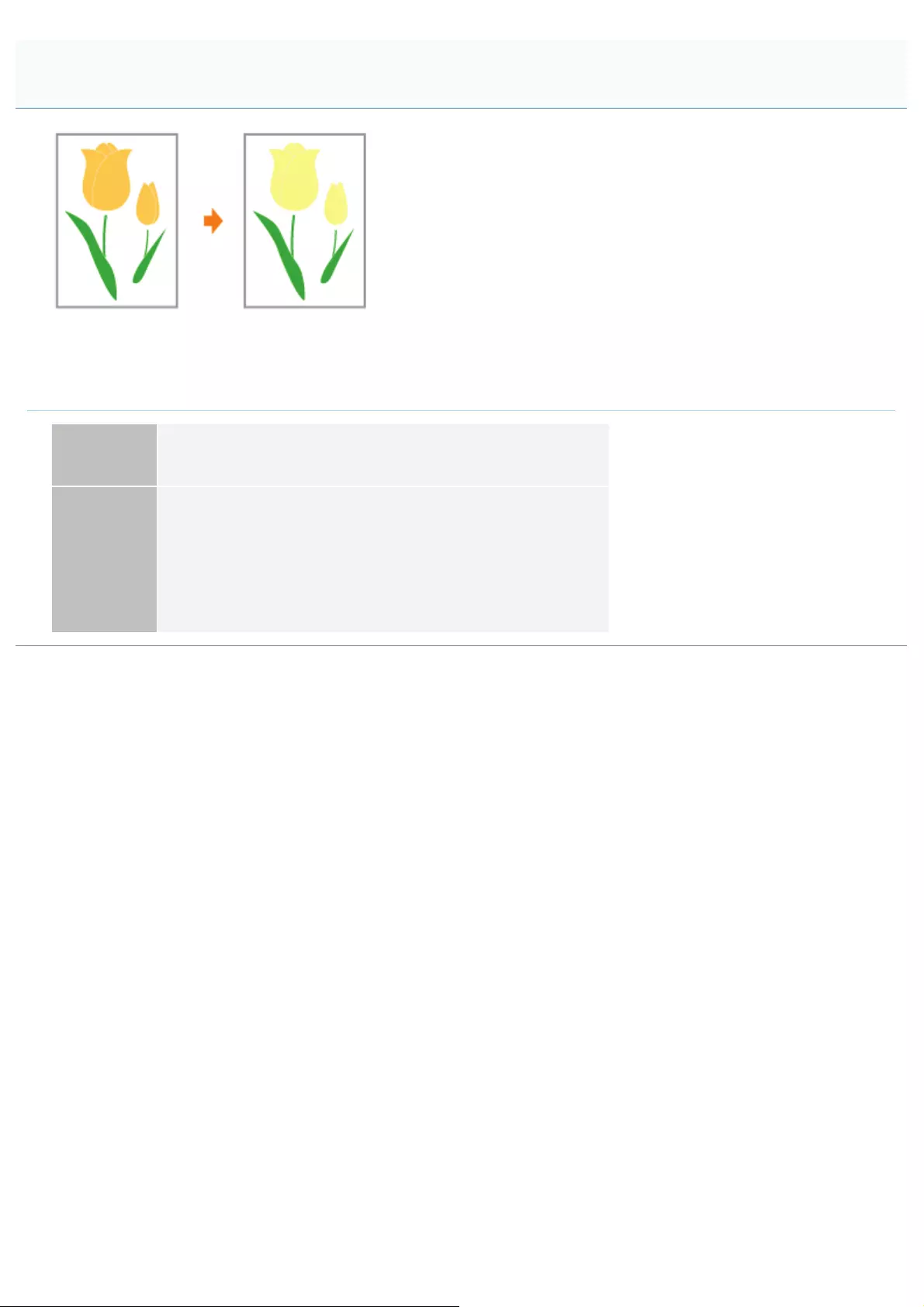
0F40-09A
Perform the following procedure.
<Cause> The shaded pattern of the print data and the dither pattern of the printer are
interfering with one another.
Solution 1 Print again without specifying a shaded pattern in the application.
See the instruction manual supplied with the application.
Solution 2
Perform the following procedure in the printer driver.
1. Display the [Quality] sheet.
2. Click [Advanced Settings].
3. Change the [Halftones] setting.
Shaded Patterns Are Not Printed in the Correct Color (Specified Color)
㻠㻤㻞㻌㻛㻌㻡㻝㻠
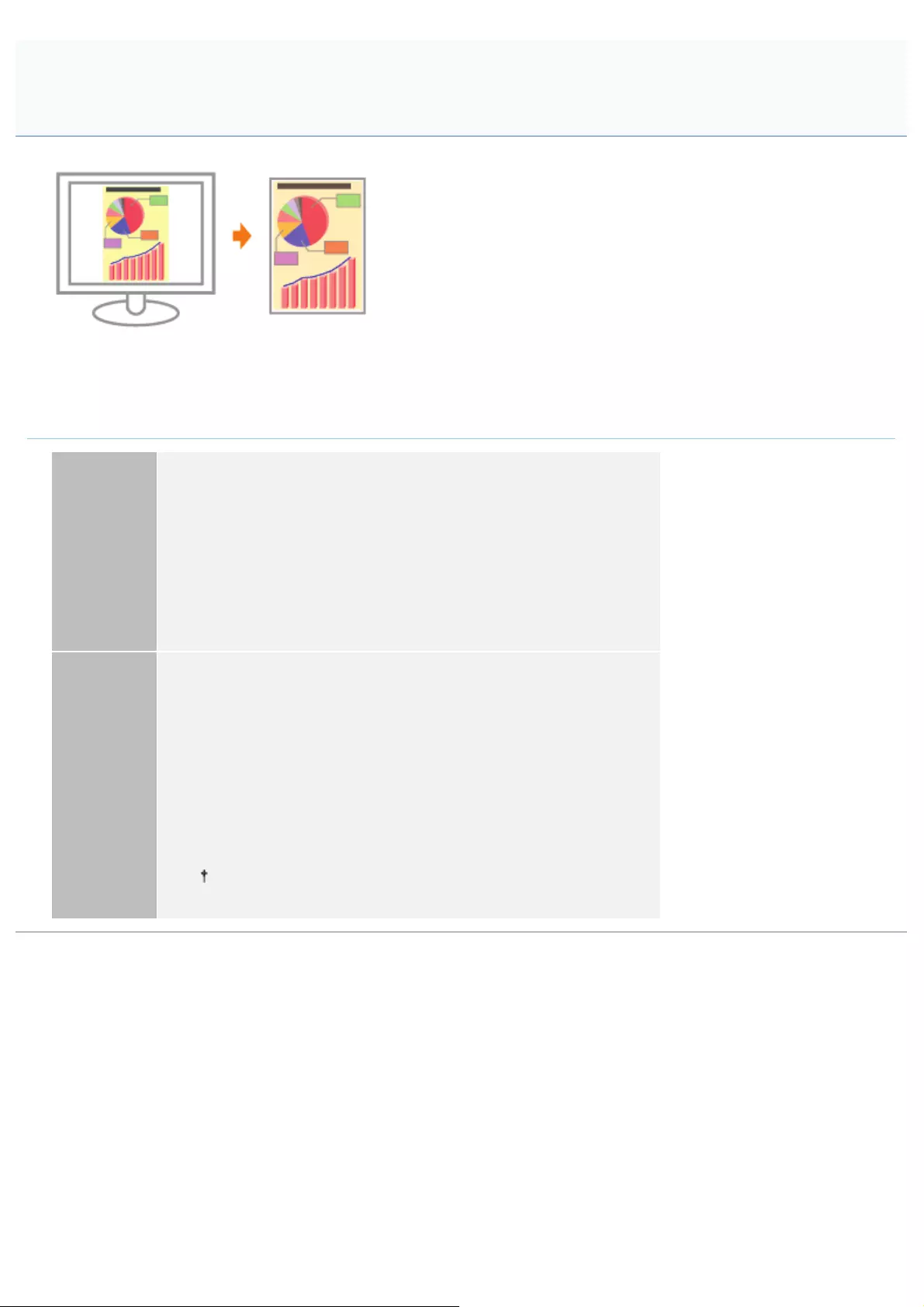
0F40-09C
Perform the following procedure.
<Cause> The methods for adjusting the color on the screen (RGB) and in the printer (YMC) are
different. Therefore, the color on the screen may not be printed out exactly as it appears.
Solution 1
Perform the following procedure in the printer driver.
1. Display the [Quality] sheet.
2. Select the [Manual Color Settings] check box.
3. Click [Color Settings].
4. Display the [Matching] sheet.
5. Set [Matching Method] to [Perceptual [Monitor Color Matched]].
Solution 2
Perform the following procedure in the printer driver.
1. Display the [Quality] sheet.
2. Select the [Manual Color Settings] check box.
3. Click [Color Settings].
4. Display the [Matching] sheet.
5. Select [Gamma Adjustment] in [Matching Mode].
6. Change the gamma value for [Gamma].
The larger the value is, the darker in color the data is printed.
Photographs and so on Are Printed in Different Colors from Those
Displayed on the Monitor
㻠㻤㻟㻌㻛㻌㻡㻝㻠
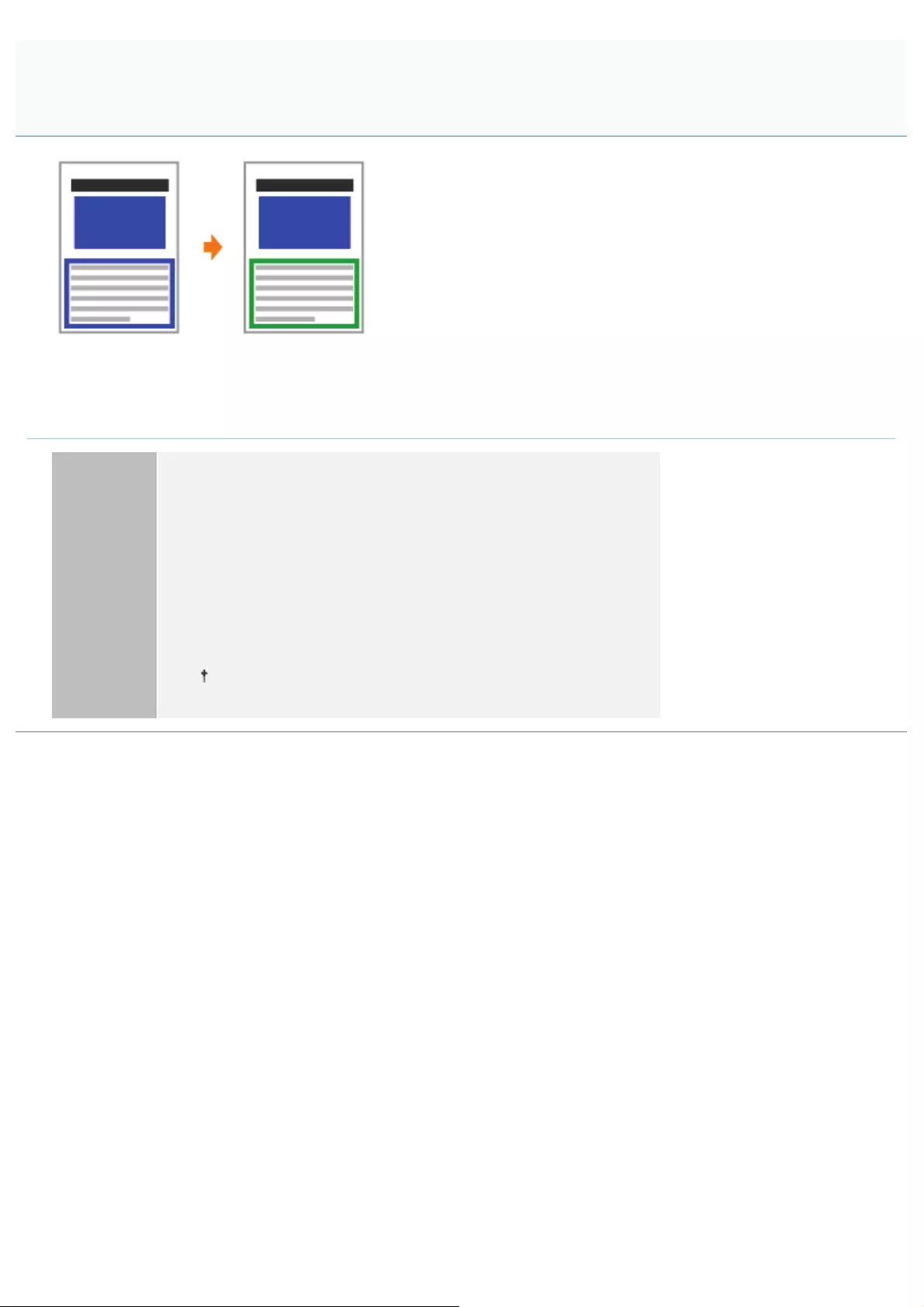
0F40-09E
Perform the following procedure.
<Cause> A special process may be applied depending on the line width of the border so that
thin lines are printed clearly.
Solution
Perform the following procedure in the printer driver.
1. Display the [Quality] sheet.
2. Select the [Manual Color Settings] check box.
3. Click [Color Settings].
4. Display the [Matching] sheet.
5. Select [Gamma Adjustment] in [Matching Mode].
6. Change the gamma value for [Gamma].
The larger the value is, the darker in color the data is printed.
Fill Patterns and Borders Are Not Printed in the Correct Color (Specified
Color) Even When the Same Color Is Specified for Them
㻠㻤㻠㻌㻛㻌㻡㻝㻠
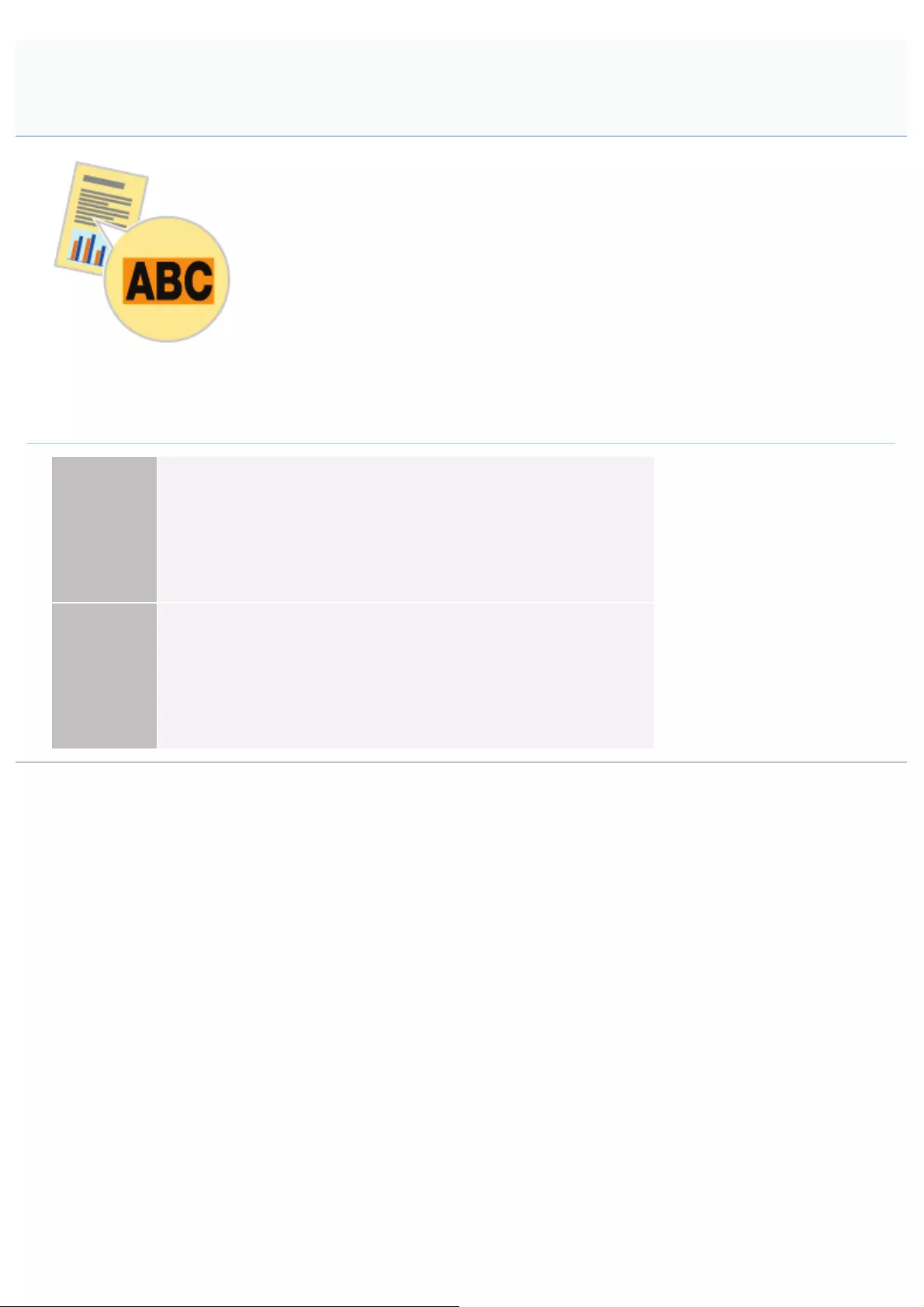
0F40-09F
Perform the following procedure.
<Cause> A process that is different from the specified halftone process or color process may
be applied depending on the operating system or application.
Solution 1
Perform the following procedure in the printer driver.
1. Display the [Quality] sheet.
2. Click [Advanced Settings].
3. Set [Gray Compensation] to [Always] or [Never].
Solution 2
Perform the following procedure in the printer driver.
1. Display the [Quality] sheet.
2. Click [Advanced Settings].
3. Set [Halftones] to [Resolution], [High Resolution], or [Gradation].
Square Areas That Cannot Be Seen on the Display Appear around Lines
or Text and Are Printed in a Different Color from the Other Areas
㻠㻤㻡㻌㻛㻌㻡㻝㻠
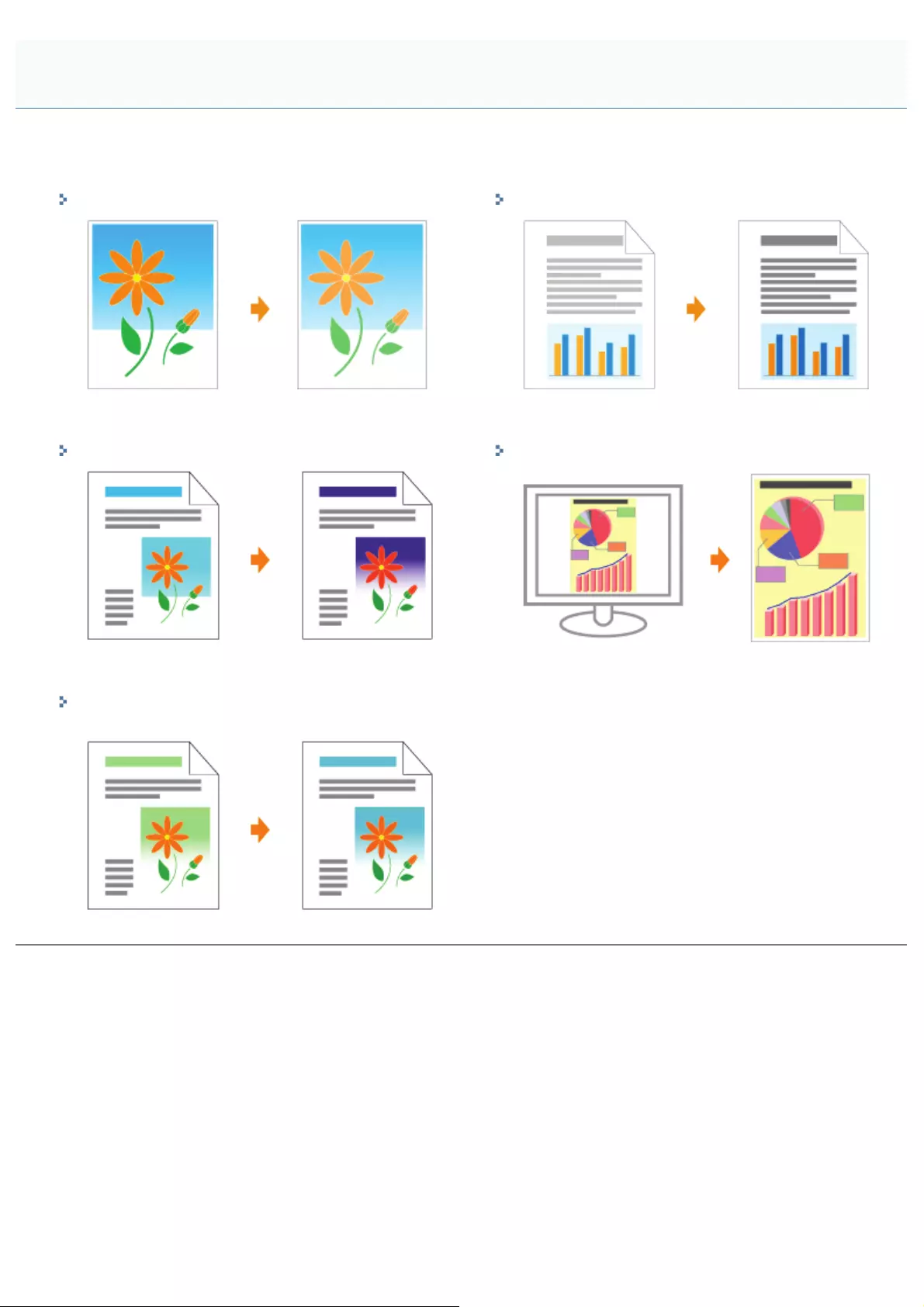
0F40-09H
This printer allows you to print with performing the following adjustments and corrections.
Adjusting the Toner Density Printing with Brightness and Contrast Adjusted
Adjusting the Color Matching the Color with the Screen
Adjusting Colors and Correcting Color Mismatches
(Calibration/Color Mismatch Correction)
Adjusting the Color and so on for Printing
㻠㻤㻢㻌㻛㻌㻡㻝㻠

0F40-09J
Perform one of the following solutions according to the cause.
<Cause 1> [Gutter] is specified.
Solution
Perform the following procedure in the printer driver.
1. Display the [Finishing] sheet.
2. Click [Gutter].
3. Set [Gutter] to "0."
<Cause 2> "Top Margin" and "Paper Position" in the application are not specified properly.
Solution Specify the settings for "Top Margin" and "Paper Position" in the application properly.
See the instruction manual supplied with the application.
The Printing Position Is Skewed
㻠㻤㻣㻌㻛㻌㻡㻝㻠
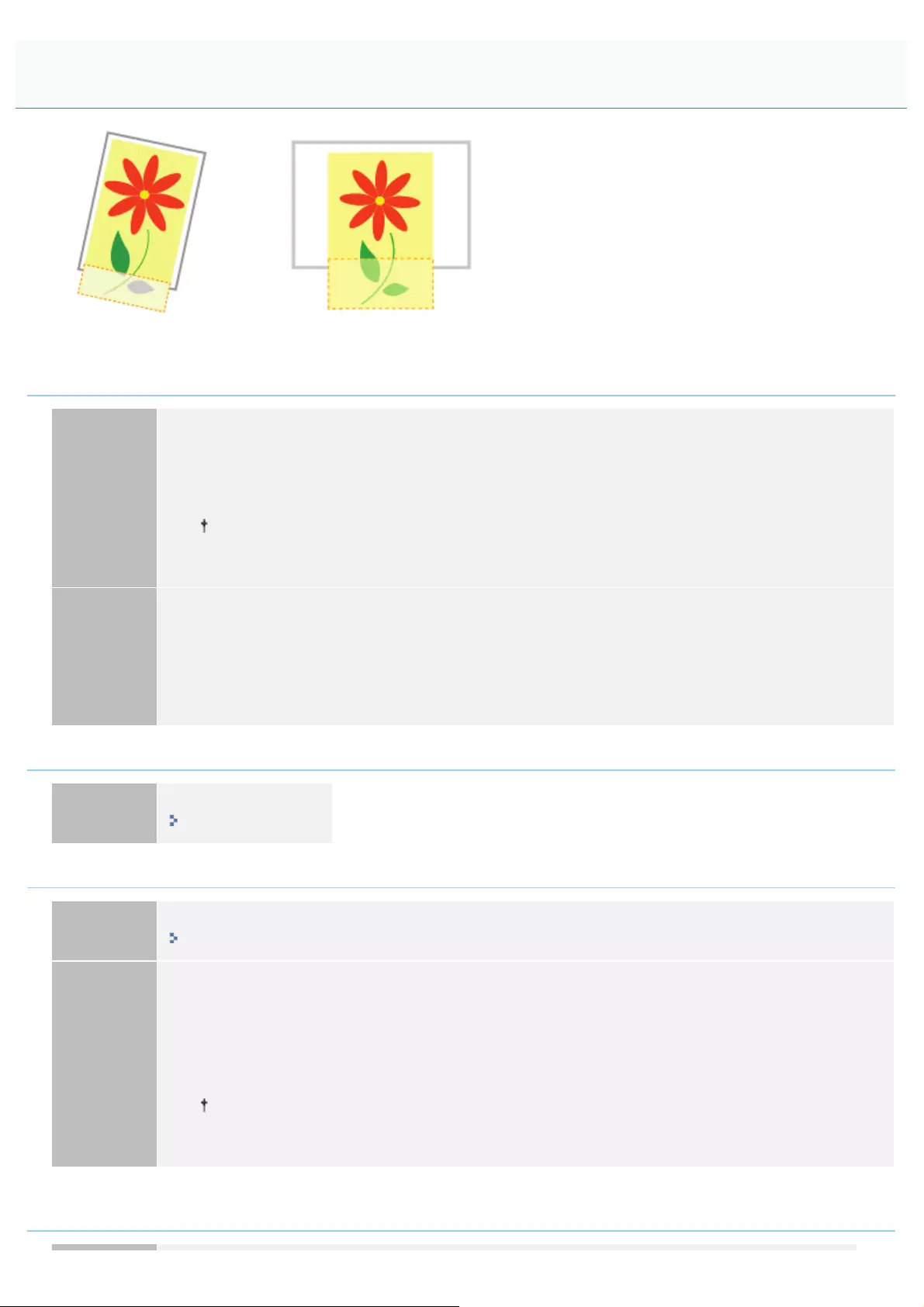
0F40-09K
Perform one of the following solutions according to the cause.
<Cause 1> The setting for the scaling factor is not appropriate.
Solution 1
Perform the following procedure in the printer driver.
1. Display the [Page Setup] sheet.
2. Clear the [Manual Scaling] check box.
If the [Manual Scaling] check box is cleared, the scale factor will be set according to [Page
Size] and [Output Size] automatically.
Solution 2
Perform the following procedure in the printer driver.
1. Display the [Page Setup] sheet.
2. Select the [Manual Scaling] check box, then specify an appropriate scale factor according to the
paper size to be used.
<Cause 2> The position of the paper is incorrect.
Solution Load the paper properly.
"Loading Paper"
<Cause 3> A document with no margins was printed.
Solution 1 Data is printed with a margin of 5 mm (10 mm for envelopes). Provide a margin around the data.
"Printable Area"
Solution 2
Perform the following procedure in the printer driver.
1. Display the [Finishing] sheet.
2. Click [Advanced Settings].
3. Set [Expand Print Region and Print] to [On].
Depending on the print data to be printed, the edge of paper may be missing partly during
printing or may blot during color printing.
<Cause 4> The loaded paper is smaller than the paper drawer or the paper size setting for the
job.
A Portion of the Page Is Not Printed (Printed Data Lies Outside Paper)
㻠㻤㻤㻌㻛㻌㻡㻝㻠

Solution
Load paper that matches the paper size setting, or change the paper size setting to match the paper.
"Loading Paper"
"Registering the Paper Size and Type"
<Cause 5> When printing the following paper, the paper is loaded with an orientation (feed
direction) that differs from that of the paper drawer or the paper setting for the job.
A5 paper
Statement paper
Custom size paper with a width and length (height) between 127.0 and 215.9 mm
Solution
Load paper with the orientation (feed direction) that matches the paper setting, or change the setting of
the paper feed direction to match the paper.
"Loading Paper"
"Registering the Paper Size and Type"
㻠㻤㻥㻌㻛㻌㻡㻝㻠
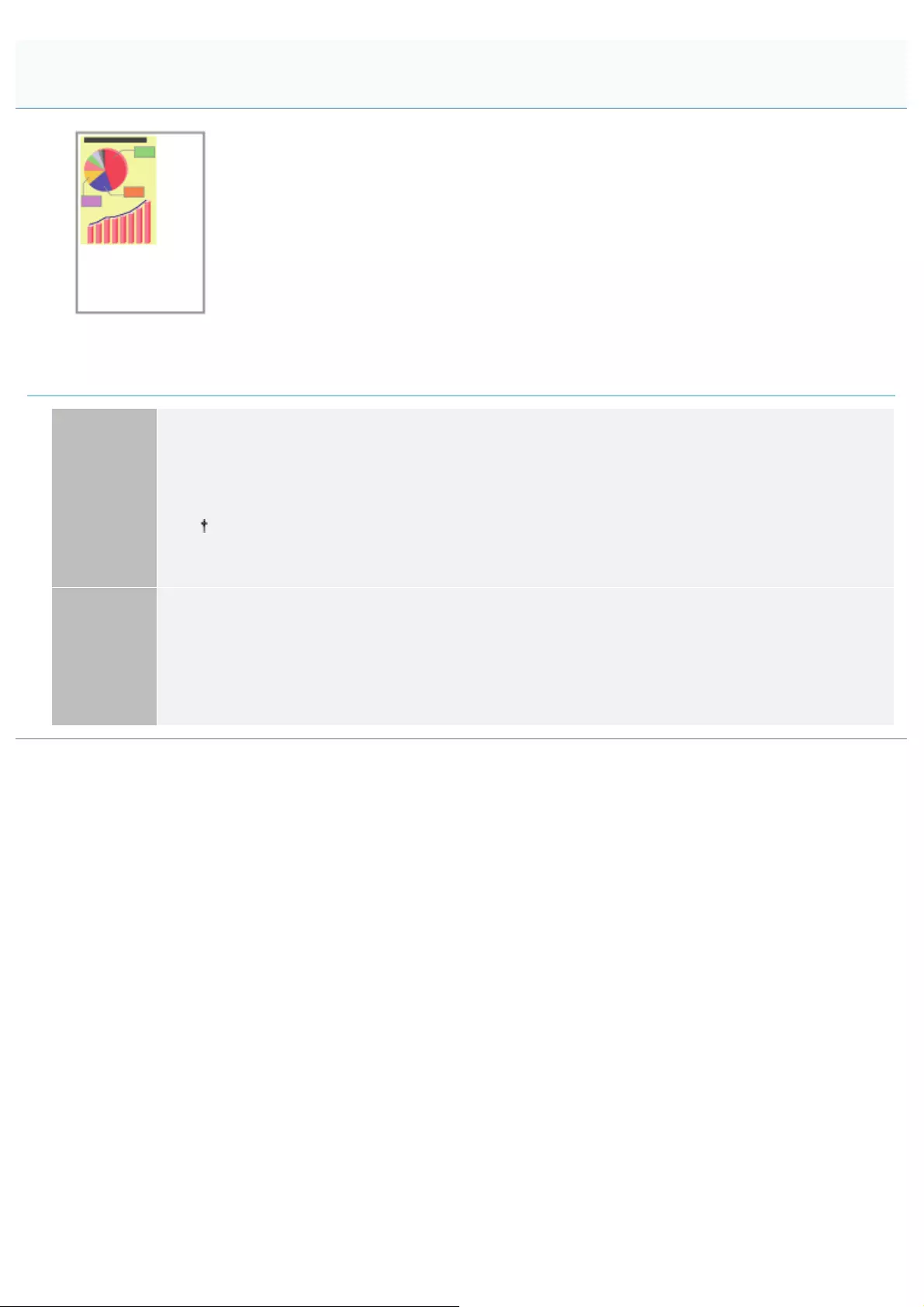
0F40-09L
Perform the following procedure.
<Cause> The setting for the scaling factor is not appropriate.
Solution 1
Perform the following procedure in the printer driver.
1. Display the [Page Setup] sheet.
2. Clear the [Manual Scaling] check box.
If the [Manual Scaling] check box is cleared, the scale factor will be set according to [Page
Size] and [Output Size] automatically.
Solution 2
Perform the following procedure in the printer driver.
1. Display the [Page Setup] sheet.
2. Select the [Manual Scaling] check box, then specify an appropriate scale factor according to the
paper size to be used.
Data Is Reduced and Printed
㻠㻥㻜㻌㻛㻌㻡㻝㻠
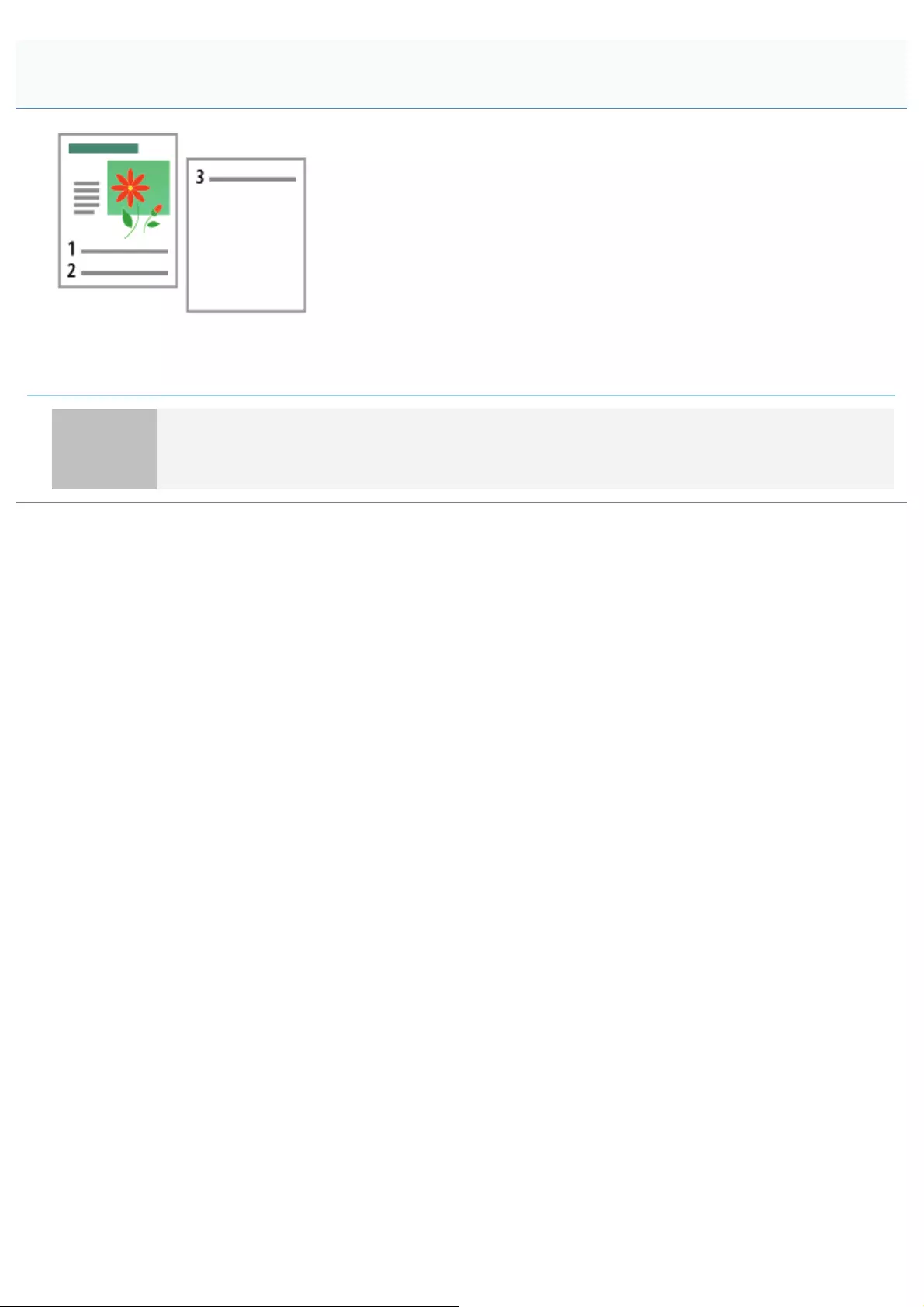
0F40-09R
Perform the following procedure.
<Cause> "Line Spacing" or "Lines/Page" in the application is not specified properly.
Solution
Specify the settings for "Line Spacing" or "Lines/Page" in the application so that the data fits in one page,
and then print again.
See the instruction manual supplied with the application.
The Next Page Is Printed from Halfway across the Previous Page
㻠㻥㻝㻌㻛㻌㻡㻝㻠
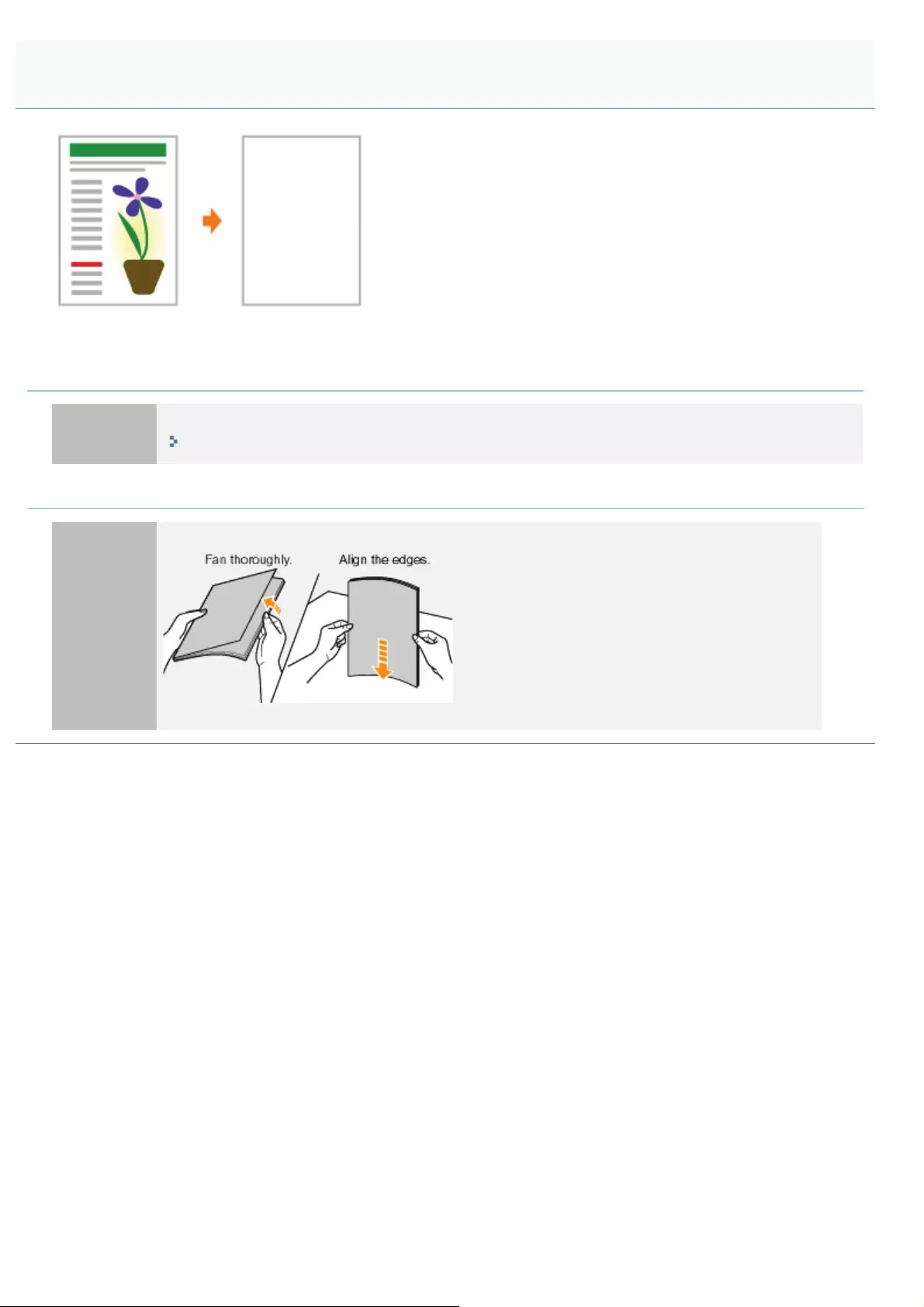
0F40-09S
Perform one of the following solutions according to the cause.
<Cause 1> The toner cartridges were installed with the sealing tape still attached.
Solution Take the toner cartridges out of the printer, pull out the sealing tape, and reinstall the toner cartridges.
"Replacing the Toner Cartridge"
<Cause 2> Multiple sheets of paper are fed at a time.
Solution
Fan the paper thoroughly, and then align the edges of the stack properly on a hard, flat surface.
Blank Paper Is Output (Nothing Is Printed on the Paper)
㻠㻥㻞㻌㻛㻌㻡㻝㻠
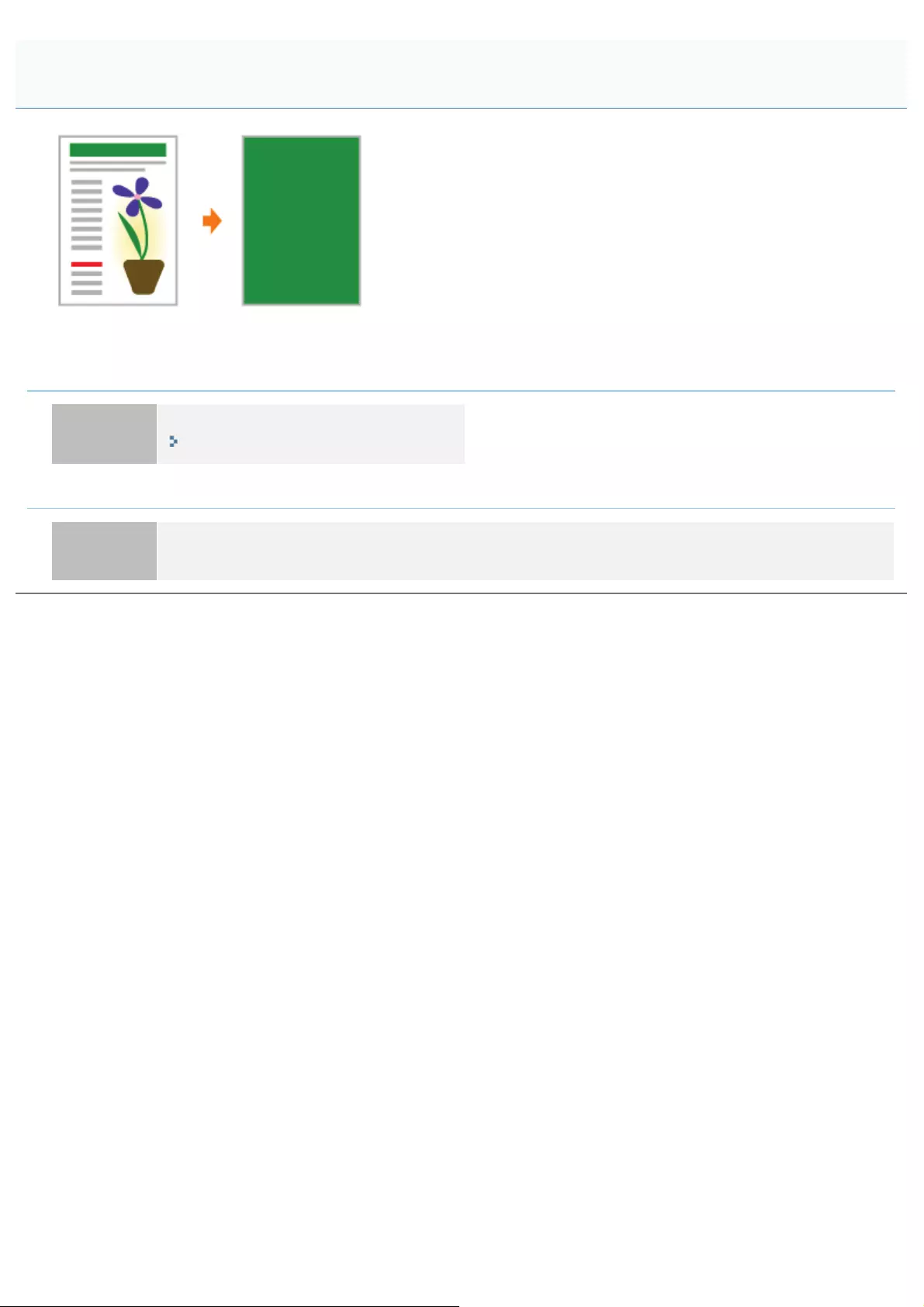
0F40-09U
Perform one of the following solutions according to the cause.
<Cause 1> The drum in any of the toner cartridges has deteriorated.
Solution Replace the toner cartridges with new ones.
"Replacing the Toner Cartridge"
<Cause 2> A problem is occurring inside the printer.
Solution When <Service Error> is displayed in the Printer Status Window, perform the solution using the procedure
in "When <Service Error> Is Displayed."
The Overall Surface of the Paper Is Printed in a Particular Color
㻠㻥㻟㻌㻛㻌㻡㻝㻠
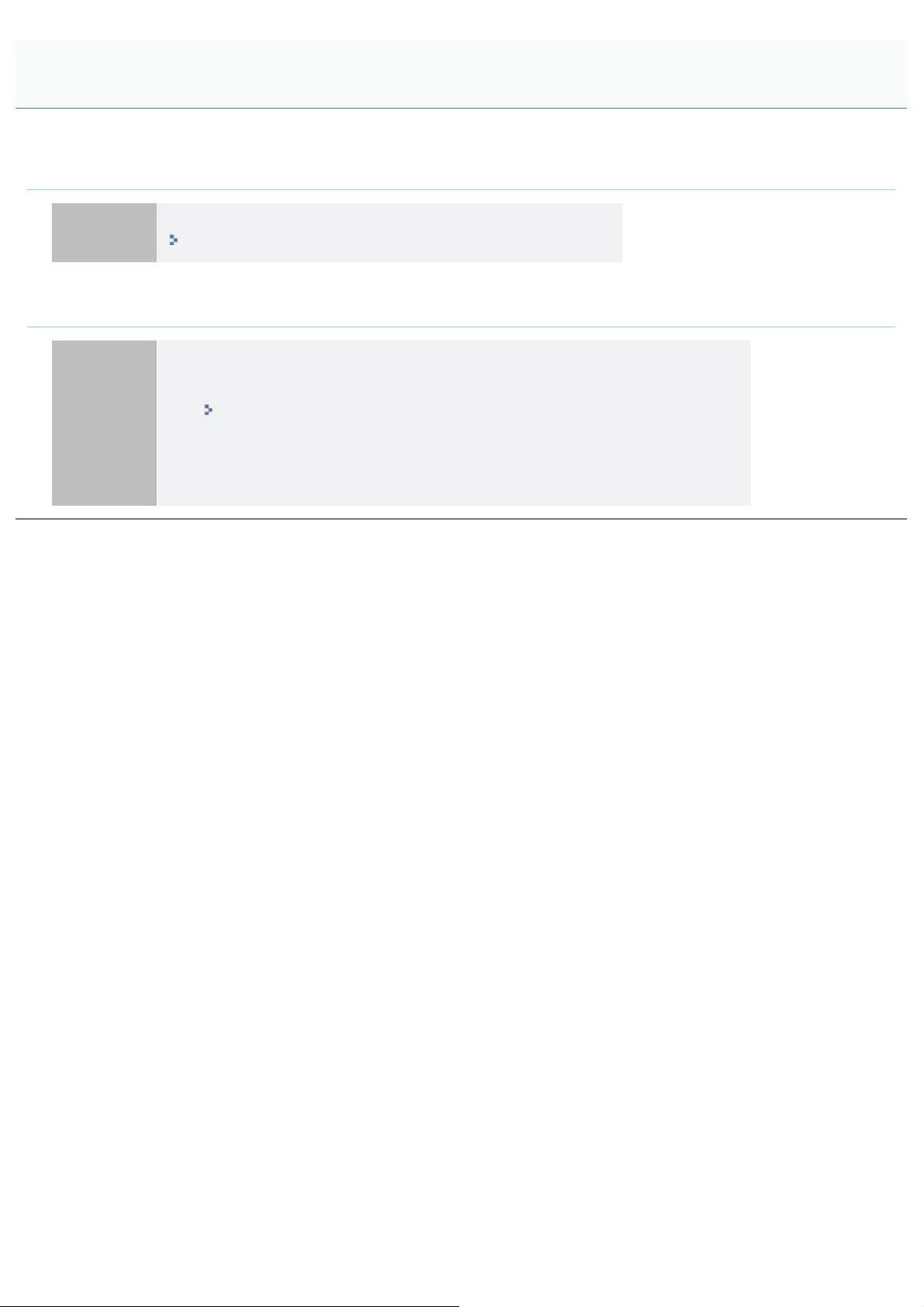
0F40-09W
Perform one of the following solutions according to the cause.
<Cause 1> The envelope is inappropriate.
Solution Replace the envelope with that which can be used with this printer.
"Usable Paper"
<Cause 2> Depending on the type of the envelopes or the operating environment (especially in
a high-humidity environment), the flaps may stick to the body of the envelopes.
Solution
Perform the following procedure in the Printer Status Window.
1. Display the Printer Status Window.
"Printer Status Window"
2. )URPWKH>2SWLRQV@PHQXVHOHFW>'HYLFH6HWWLQJV@ĺ>3DSHU6RXUFH6HWWLQJV@
3. Select the [Perform Envelope Cling Prevention When Printing] check box.
The Flap of the Printed Envelope Sticks
㻠㻥㻠㻌㻛㻌㻡㻝㻠
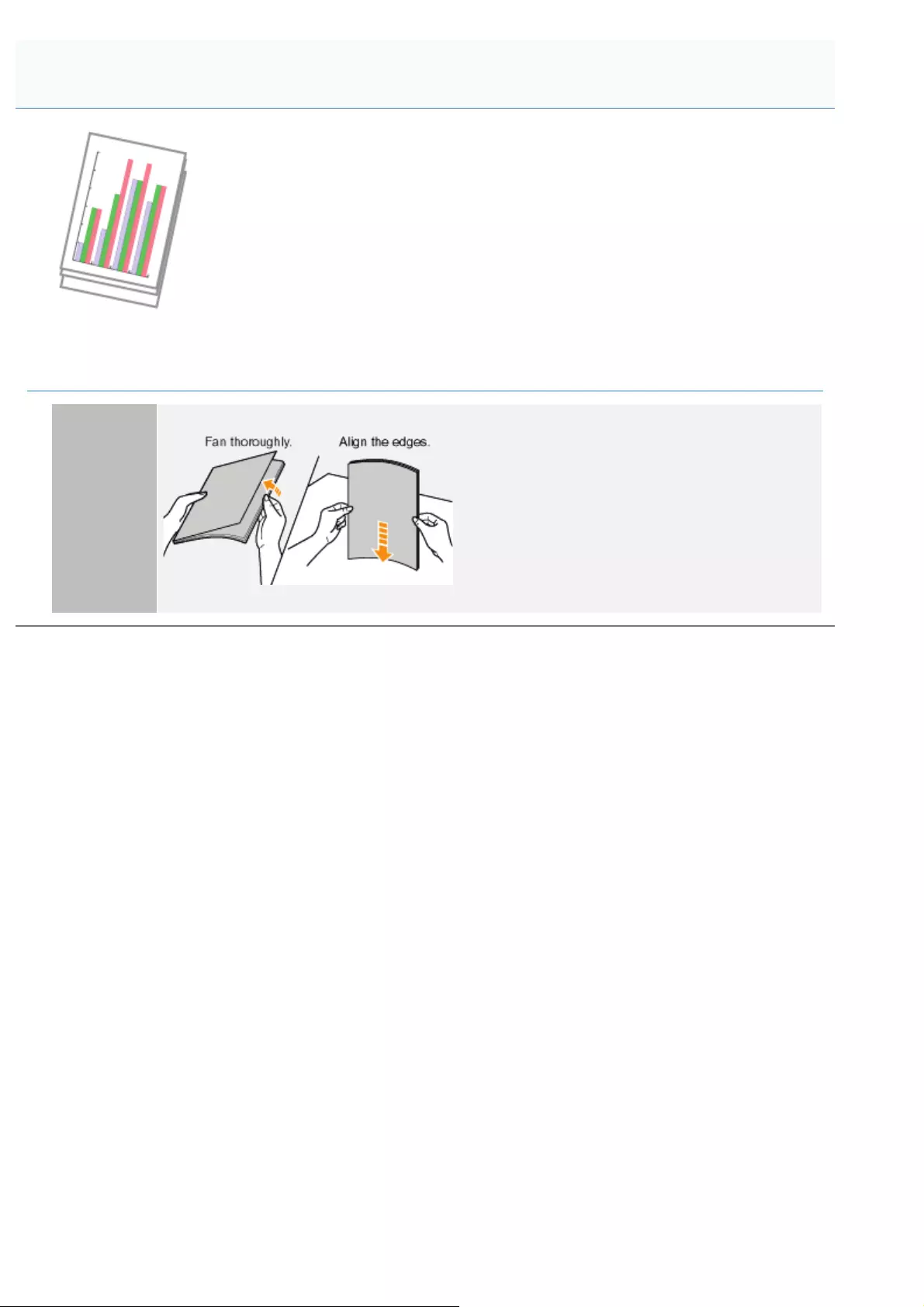
0F40-09X
Perform the following procedure.
<Cause> You are using paper which tends to be fed at a time.
Solution
Fan the paper thoroughly, and then align the edges of the stack properly on a hard, flat surface.
Multiple Sheets of Paper Are Fed at a Time
㻠㻥㻡㻌㻛㻌㻡㻝㻠
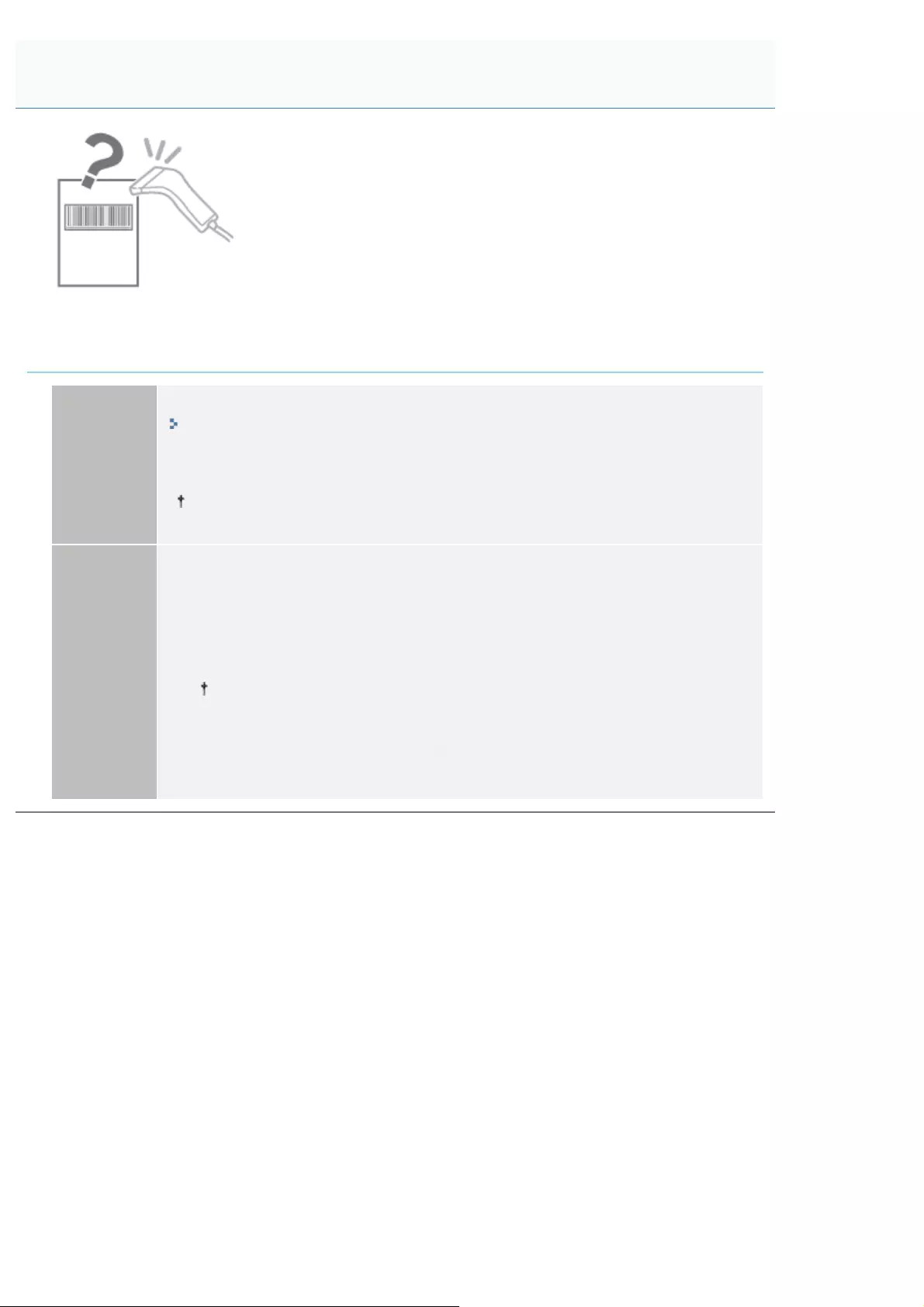
0F40-09Y
Perform the following procedure.
<Cause> Depending on the type or size of bar code, scanning may be difficult.
Solution 1
Set [Black]* in [Toner Density] in the printer driver to a lighter setting ([-2] or [-1]).
"Adjusting the Toner Density"
*Adjust the color used to print a bar code.
When printing with a lighter toner density, the print may come out faint.
Solution 2
Perform the following procedure in the printer driver.
1. Display the [Finishing] sheet.
2. Click [Advanced Settings].
3. Change the [Special Settings 1] setting.
Improving effectiveness for bar code printing increases in the following order.
>2II@ĺ>0RGH@ĺ>0RGH@ĺ>0RGH@ĺ>0RGH@ĺ>0RGH@
(Effect: Low) (Effect: High)
Printed Bar Codes Cannot Be Scanned
㻠㻥㻢㻌㻛㻌㻡㻝㻠

0F40-0A0
If the problem cannot be solved by referring to the e-Manual, contact your local authorized Canon dealer or Canon help
line ( "Office Locations").
Please have the following information ready when contacting the Canon:
Product name (LBP7100Cn/LBP7110Cw)
Serial number (see the following illustrations to find the location of the serial number.)
Place of purchase
Nature of the problem
Steps you have taken to solve the problem and the results
WARNING
If the machine makes strange noises or emits smoke or an odd odor
Turn OFF the power switch immediately, disconnect the power cord, and contact the Canon Customer Care Center. Do
not attempt to disassemble or repair the machine yourself.
IMPORTANT
If you attempt to repair the machine by yourself
It may void the limited warranty.
If You Cannot Solve a Problem
㻠㻥㻣㻌㻛㻌㻡㻝㻠

0F40-0A2
You can maximize the use of the printer by familiarizing with software tasks and functions supplied with the printer.
Printer Driver
The printer driver is software allows you to control the printer with
the printing instructions from the computer.
The printer driver is equipped with a useful printing function and you
can use it with freely combining the settings.
Displaying the Setting Screen
<Pick Up>
Saving Paper Layout Printing (N-page Print)
Using Functions for Internal
Documents
Adding a Watermark to a Document to Be Printed
(Watermark Printing)
Being Particular About the Image
Quality or Colors
Adjusting the Image Quality or Colors
Printer Status Window
The Printer Status Window is software allows you to check the
printer status, specify the settings for the printer unit, and so on.
The Printer Status Window is convenient because it simply notifies
the printer status such as paper jams, life of the toner cartridges,
and paper-out conditions with messages, animations, and so on.
Printer Status Window
<Pick Up>
Canceling a Job Canceling a Job Being Printed or Waiting to Be Printed from the
Computer
Periodical Cleaning Cleaning the Printer
Saving Power
Consumption
Energy-saving Mode
Points to Make Full Use of the Printer
㻠㻥㻥㻌㻛㻌㻡㻝㻠

Network Utilities
Useful utilities are available to perform the printer management and so
on.
Because the items you can manage differ depending on the software,
use the software according to your environment or the item you want
to manage.
Introduction of the Utilities
Software That Can Be Used for Managing the
Printer
㻡㻜㻜㻌㻛㻌㻡㻝㻠
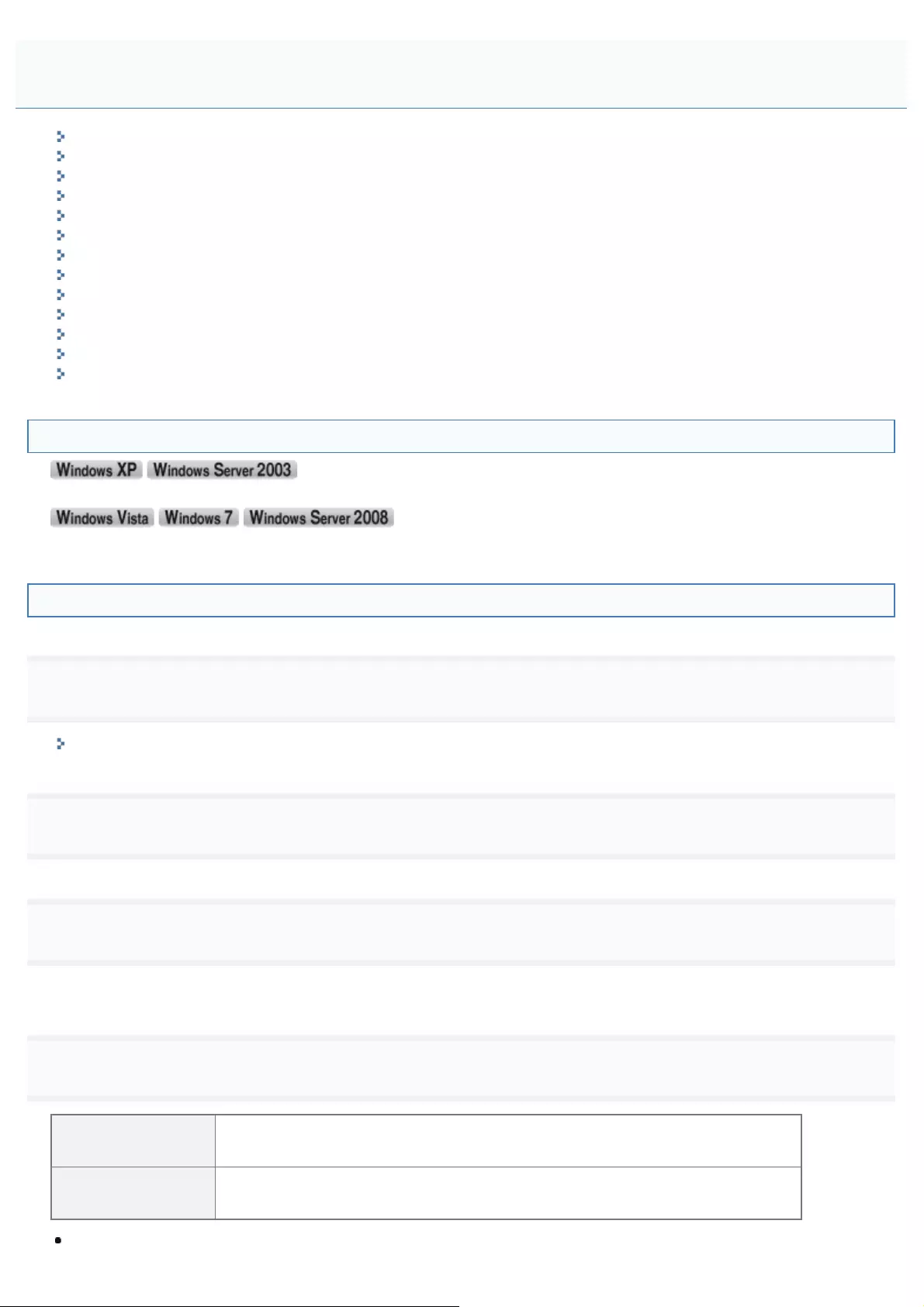
0F40-0A3
Displaying [Computer] or [My Computer]
Setting the IP Address Using the ARP/PING Command
Displaying the CD-ROM Top Page
Checking the IP Address Using the PING Command
Checking the Processor Version of Windows Vista, 7, or Server 2008
Printing a Test Page in Windows
Checking the Bi-directional Communication
Installing with Plug and Play
Displaying the Printer Folder
Checking Printers in the Print Server
Checking the Port
Values for Setting a Port
Setting for [Device Type] when Setting a Port
Displaying [Computer] or [My Computer]
From the [Start] menu, select [My Computer].
From the [Start] menu, select [Computer].
Setting the IP Address Using the ARP/PING Command
1
Make sure that the printer and computer are connected properly, and the printer is turned ON.
"Connecting the Printer and Computer"
2
Turn the computer on, and then log on to Windows as a user with administrative rights.
3
Run Command Prompt.
)URPWKH>6WDUW@PHQXVHOHFW>$OO3URJUDPV@ĺ>$FFHVVRULHV@ĺ>&RPPDQG3URPSW@
4
Enter "arp -s <IP address> <MAC address>", then press the [ENTER] key on your keyboard.
<IP address> Enter the IP address to assign to the printer.
Specify the address with four numbers (from 0 to 255) separated with a period (.).
<MAC address> Enter the MAC address of the printer.
Separate the number every two digits with a hyphen (-).
Input Example: "arp -s 192.168.0.215 00-1E-8F-05-70-31"
Basic Operations/Various Information for Windows
㻡㻜㻝㻌㻛㻌㻡㻝㻠
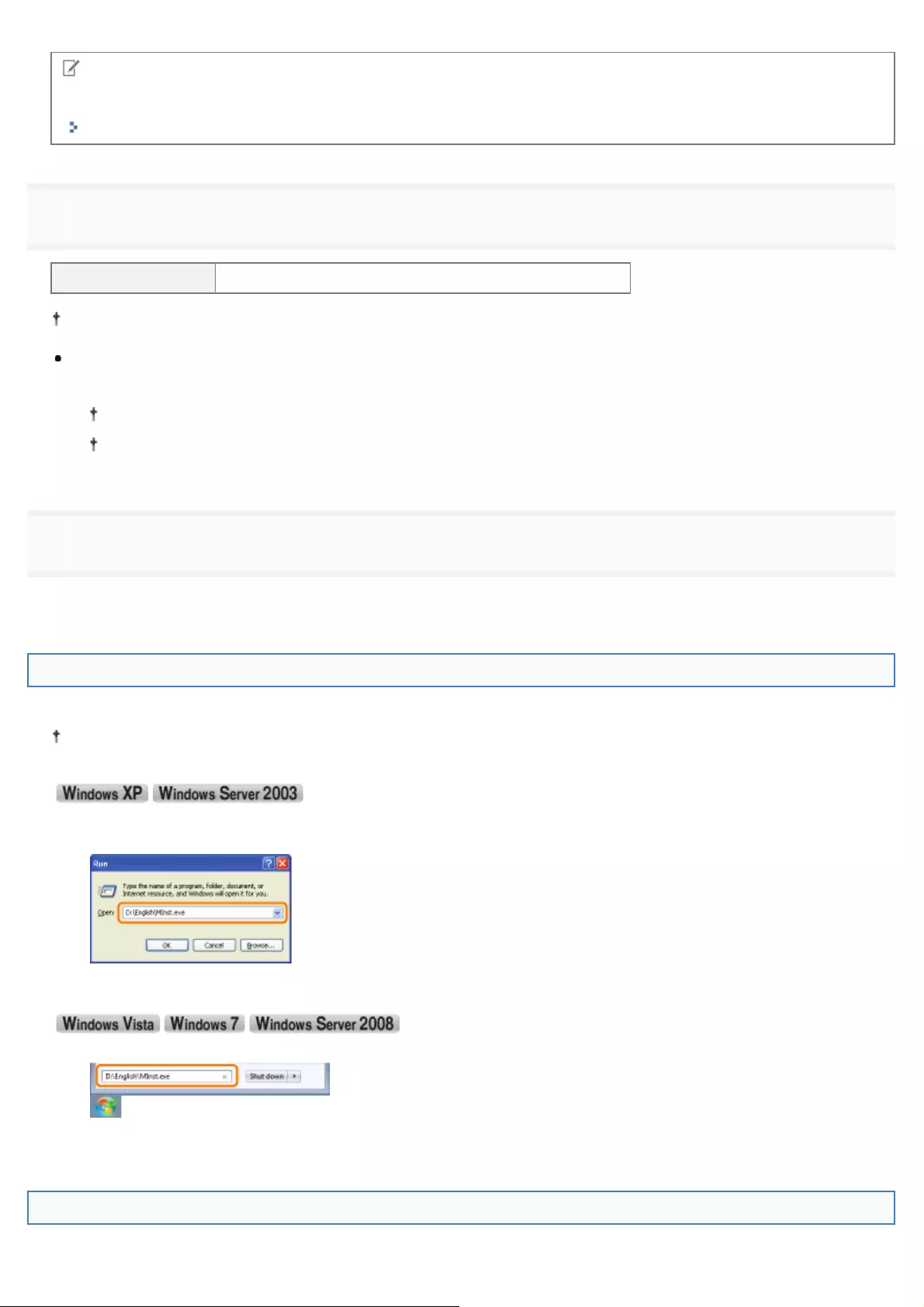
NOTE
Checking the MAC address
"Checking the MAC Address of the Printer"
5
Enter "ping <IP address> -l 479", then press the [ENTER] key on your keyboard.
<IP address> Enter the same IP address as the one entered in Step 4.
Enter a lowercase "L" for "-l".
Input Example: "ping 192.168.0.215 -l 479"
ĺThe IP address is set for the printer.
The subnet mask is set automatically according to the IP address.
The gateway address is set to [0.0.0.0].
6
Enter "exit", then press the [ENTER] key on your keyboard.
ĺCommand Prompt closes.
Displaying the CD-ROM Top Page
If the CD-ROM top page does not appear even after inserting the CD-ROM, perform the following procedure.
The CD-ROM drive name is indicated as "D:" in this manual. The CD-ROM drive name may differ depending on the
computer you are using.
1. From the [Start] menu, select [Run].
2. Enter "D:\English\MInst.exe."
3. Click [OK].
1. Enter "D:\English\MInst.exe" in [Search programs and files] or [Start Search] under the [Start] menu.
2. Press the [ENTER] key on the keyboard.
Checking the IP Address Using the PING Command
㻡㻜㻞㻌㻛㻌㻡㻝㻠
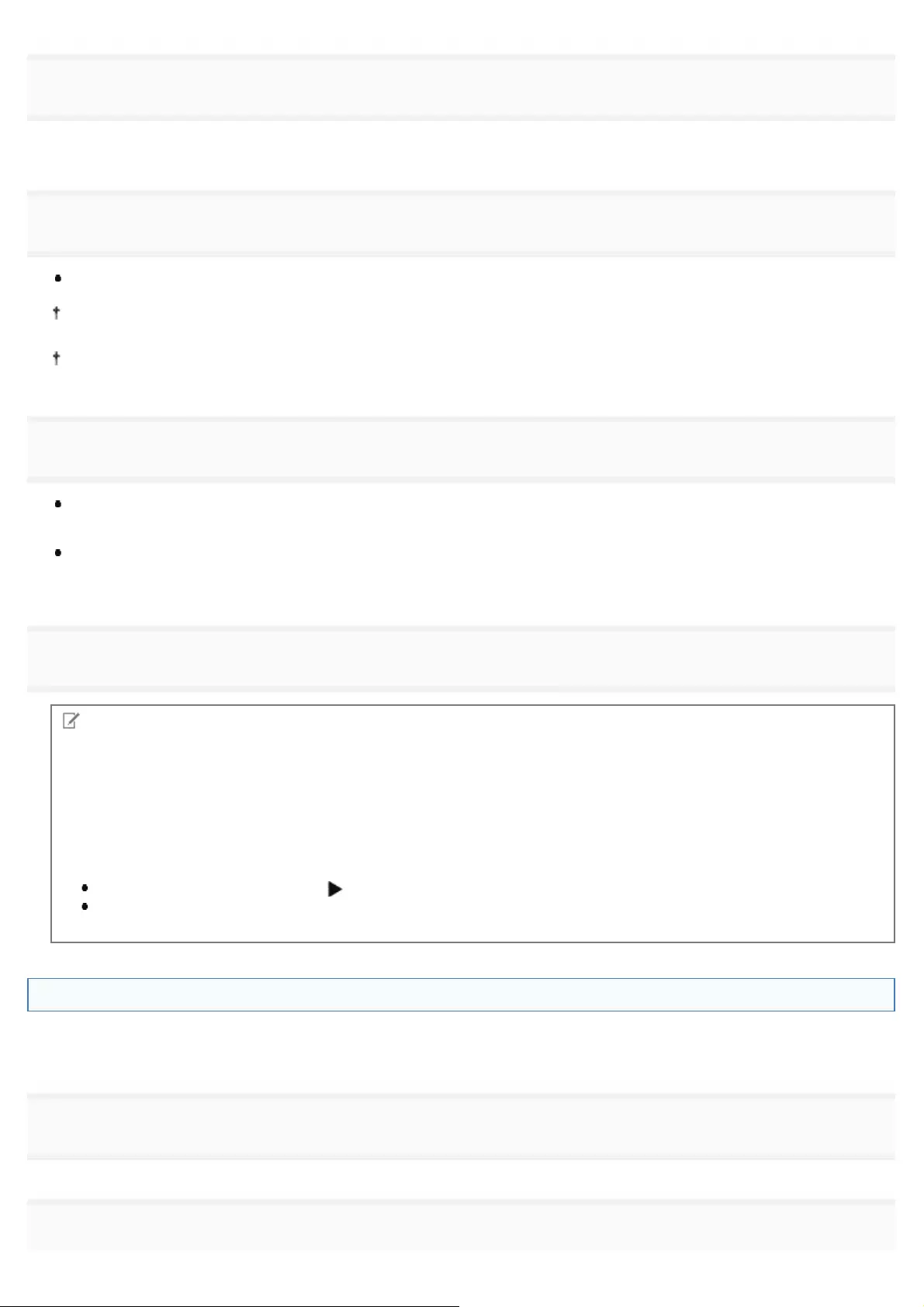
1
Run Command Prompt.
)URPWKH>6WDUW@PHQXVHOHFW>$OO3URJUDPV@ĺ>$FFHVVRULHV@ĺ>&RPPDQG3URPSW@
2
Enter "ping <the IP address of the printer>", then press the [ENTER] key on your keyboard.
Input Example: "ping 192.168.0.215"
Correctly enter the IP address which is set for the printer. If the wrong IP address is entered, you cannot obtain an
appropriate check result.
If you are not sure about the IP address of the printer, see "Checking the IP Address of the Printer."
3
Check the displayed result.
When "Packets: Sent = 4, Received = 4, Lost = 0 (0% loss)," is displayed
The IP address is set properly.
When "Packets: Sent = 4, Received = 0, Lost = 4 (100% loss)," is displayed
Ask your network administrator about the problem.
4
Enter "exit", and then press [ENTER] on the keyboard to exit Command Prompt.
NOTE
Checking and configuring the subnet
Enter "ipconfig" as a command in Command Prompt.
The network setting information of the computer appears. Confirm that the computer and printer are on the same subnet.
<Example>
Setting in a computer
Subnet mask: "255.255.255.0"
IP Address: "192.168.0.10"
The IP address of the printer needs to be "192.168.0.xxx". (xxx indicates an
arbitrary number.)
Checking the Processor Version of Windows Vista, 7, or Server 2008
If you are not sure whether you are using 32-bit Windows Vista/7/Server 2008 or 64-bit Windows Vista/7/Server 2008, you
can check that using the following procedure.
1
From the [Start] menu, select [Control Panel].
2
Display [System].
㻡㻜㻟㻌㻛㻌㻡㻝㻠
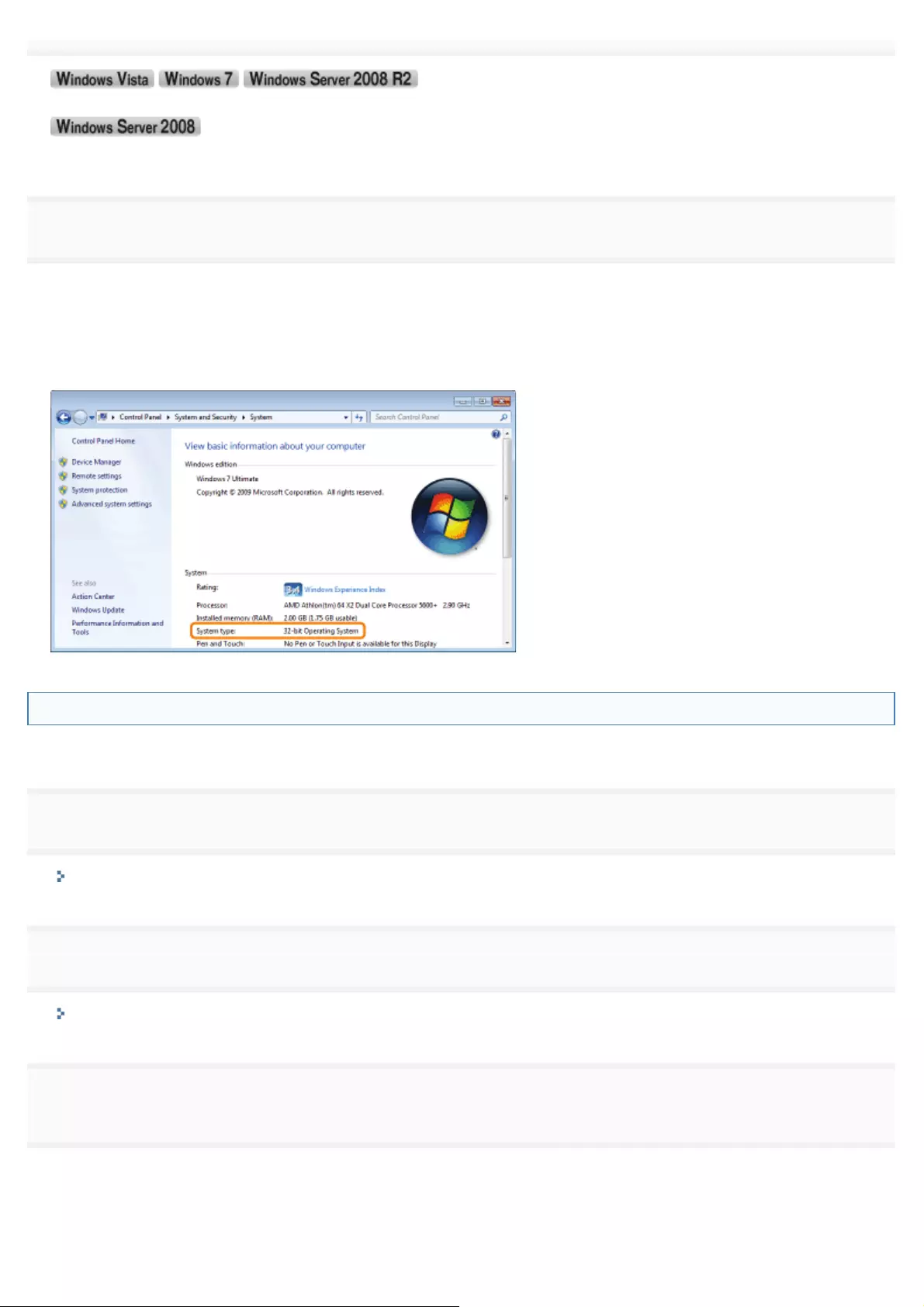
&OLFN>6\VWHPDQG6HFXULW\@RU>6\VWHPDQG0DLQWHQDQFH@ĺ>6\VWHP@
Double-click [System].
3
Check the processor version.
For a 32-bit operating system
[32-bit Operating System] is displayed.
For a 64-bit operating system
[64-bit Operating System] is displayed.
Printing a Test Page in Windows
You can check the operations of the printer driver by printing a test page in Windows.
1
Load A4 paper in the paper drawer.
"Loading Paper"
2
Open the printer folder.
"Displaying the Printer Folder"
3
Right-click the icon for this printer, and then select [Printer properties] or [Properties] from the pop-
up menu.
㻡㻜㻠㻌㻛㻌㻡㻝㻠
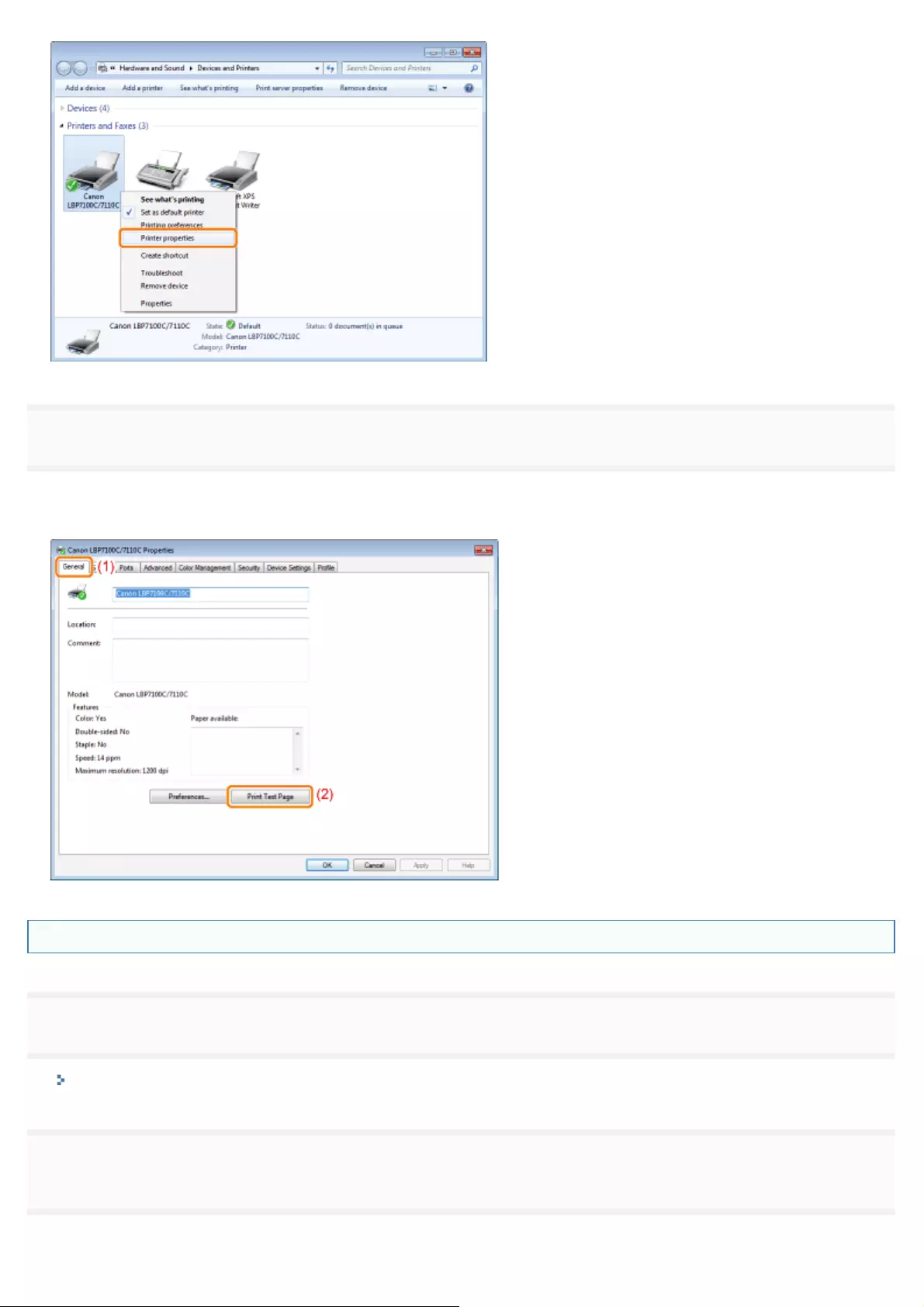
4
Print a test page.
(1) Display the [General] sheet.
(2) Click [Print Test Page] to print a test page.
Checking the Bi-directional Communication
1
Open the printer folder.
"Displaying the Printer Folder"
2
Right-click the icon for this printer, and then select [Printer properties] or [Properties] from the pop-
up menu.
㻡㻜㻡㻌㻛㻌㻡㻝㻠
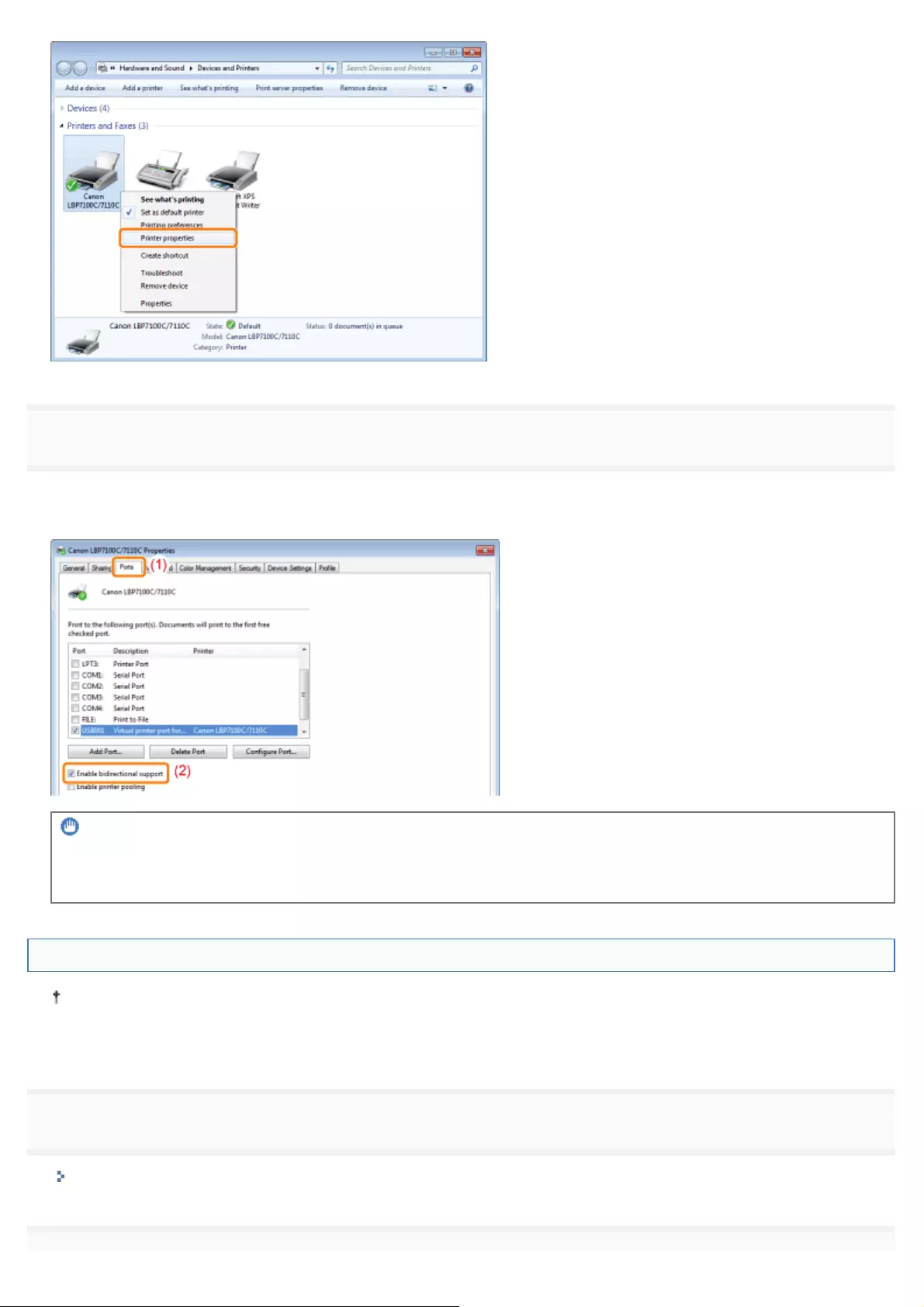
3
Check the bi-directional communication.
(1) Display the [Ports] sheet.
(2) Check the [Enable bidirectional support] check box is selected.
IMPORTANT
Do not clear the [Enable bidirectional support] check box.
If the check box is cleared, you cannot perform printing.
Installing with Plug and Play
If you are using Windows 7 or Server 2008 R2, install the printer driver in "Easy Installation."
(You may not be able to install the printer driver properly due to the Windows restriction even after detecting the printer
with Plug and Play.)
1
Connect the USB cable.
"Connecting the Printer and Computer"
㻡㻜㻢㻌㻛㻌㻡㻝㻠
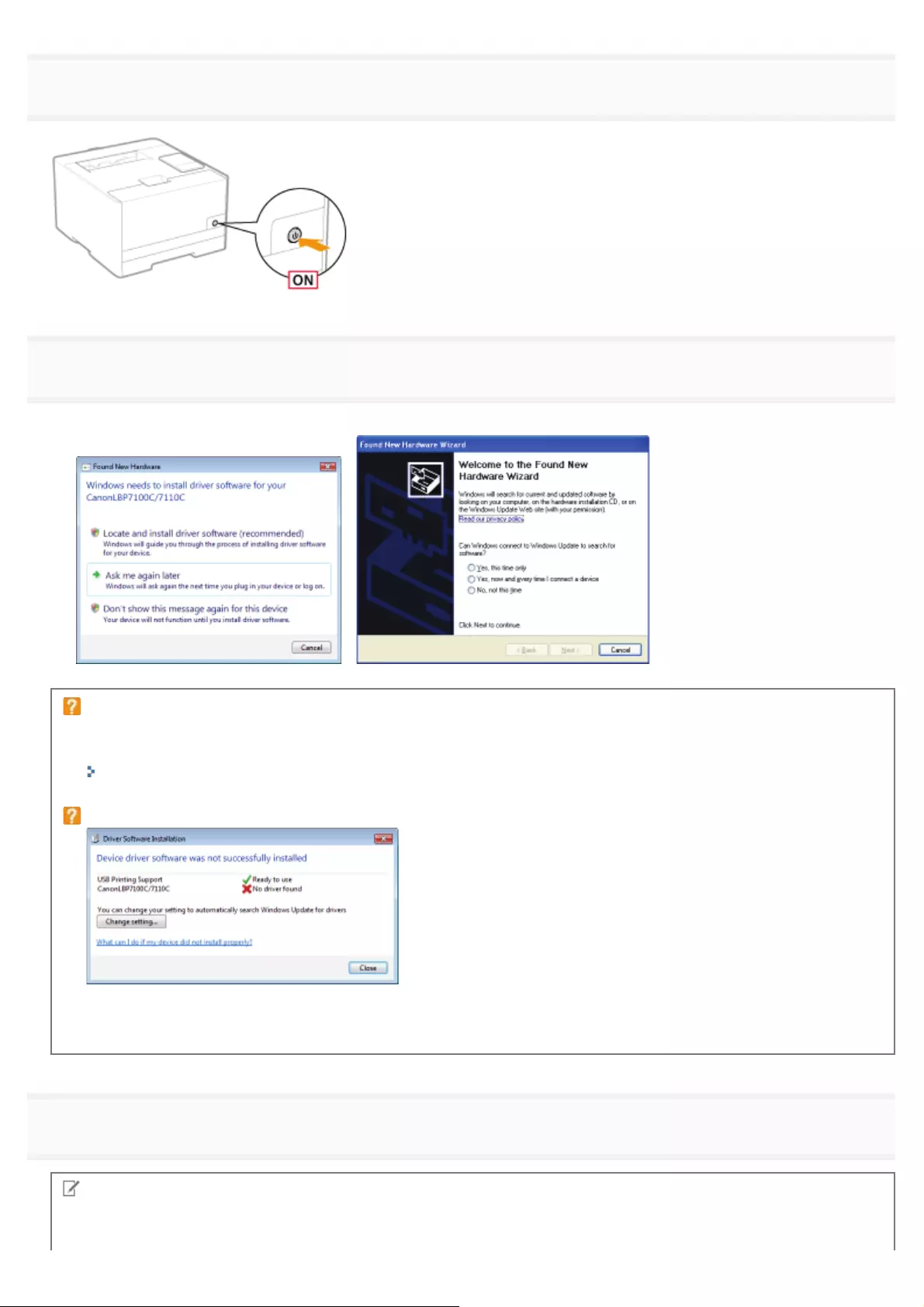
2
Turn the printer ON.
3
Turn the computer on, and then log on to Windows as a user with administrative rights.
ĺThe automatic setup screen of Plug and Play appears.
If the printer driver is installed automatically
If you installed the printer driver for this printer previously, the driver is installed automatically.
If you want to update the printer driver (or want to install it manually), install the printer driver after uninstalling it once.
"Uninstalling the Printer Driver"
If the following screen appears
You may not be able to install the printer driver properly due to the Windows restriction even after detecting the
printer with Plug and Play.
Click [Close], and then reinstall the printer driver in "Easy Installation."
4
Follow the on-screen instructions to install the printer driver.
NOTE
When selecting the folder in which the printer driver is included.
㻡㻜㻣㻌㻛㻌㻡㻝㻠
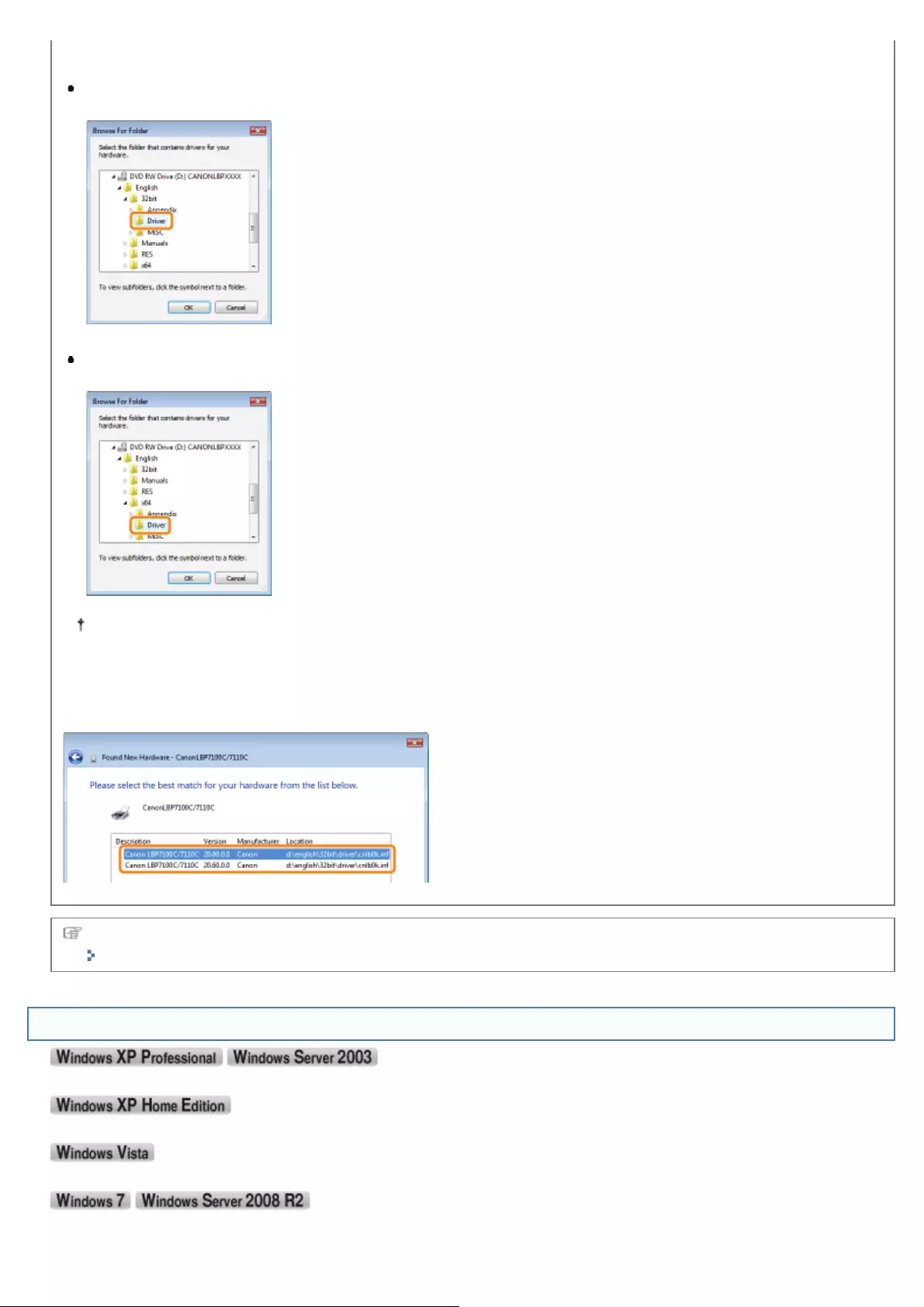
Select one of the following folders.
For a 32-bit operating system
Select the folders in the supplied CD-ROM: [English] - [32bit] - [Driver].
For a 64-bit operating system
Select the folders in the supplied CD-ROM: [English] - [x64] - [Driver].
If you are not sure whether you are using 32-bit Windows Vista/Server 2008 or 64-bit Windows Vista/Server 2008,
see "Checking the Processor Version of Windows Vista, 7, or Server 2008."
If the screen for selecting the printer driver appears
Even if which printer driver is selected, there is no problem with the installation because the same printer driver is
installed.
When the installation is complete, an icon for this printer will be created.
"After Installation"
Displaying the Printer Folder
From the [Start] menu, select [Printers and Faxes].
)URPWKH>6WDUW@PHQXVHOHFW>&RQWURO3DQHO@DQGWKHQFOLFN>3ULQWHUVDQG2WKHU+DUGZDUH@ĺ>3ULQWHUVDQG)D[HV@
From the [Start] menu, select [Control Panel], and then click [Printer].
From the [Start] menu, select [Devices and Printers].
㻡㻜㻤㻌㻛㻌㻡㻝㻠
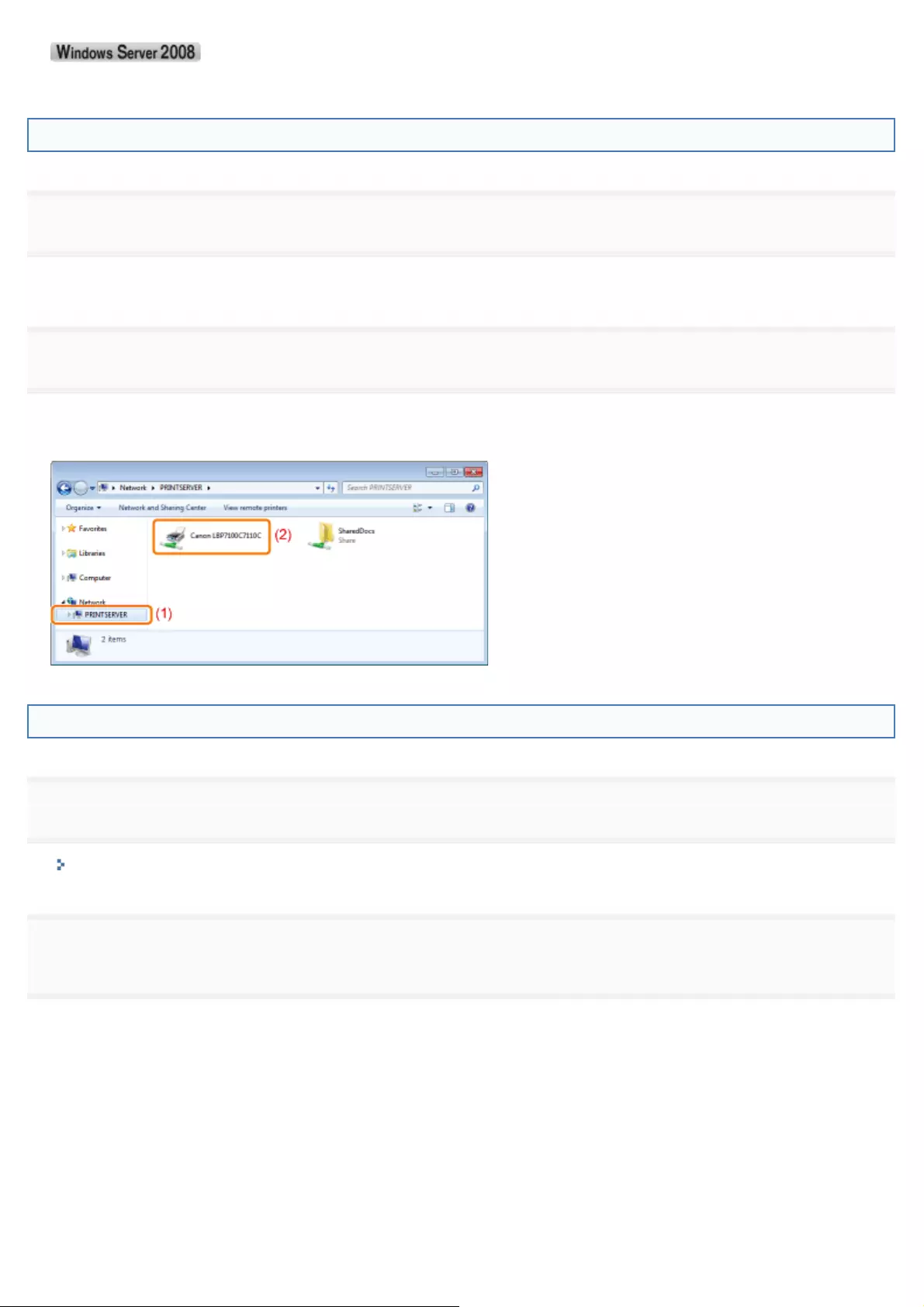
From the [Start] menu, select [Control Panel], and then double-click [Printers].
Checking Printers in the Print Server
1
Display [Windows Explorer].
)URPWKH>6WDUW@PHQXVHOHFW>$OO3URJUDPV@ĺ>$FFHVVRULHV@ĺ>:LQGRZV([SORUHU@
2
Check printers in the print server.
(1) Select the print server from [Network] or [My Network Places].
(2) Check the icon for this printer is displayed.
Checking the Port
1
Open the printer folder.
"Displaying the Printer Folder"
2
Right-click the icon for this printer, and then select [Printer properties] or [Properties] from the pop-
up menu.
㻡㻜㻥㻌㻛㻌㻡㻝㻠
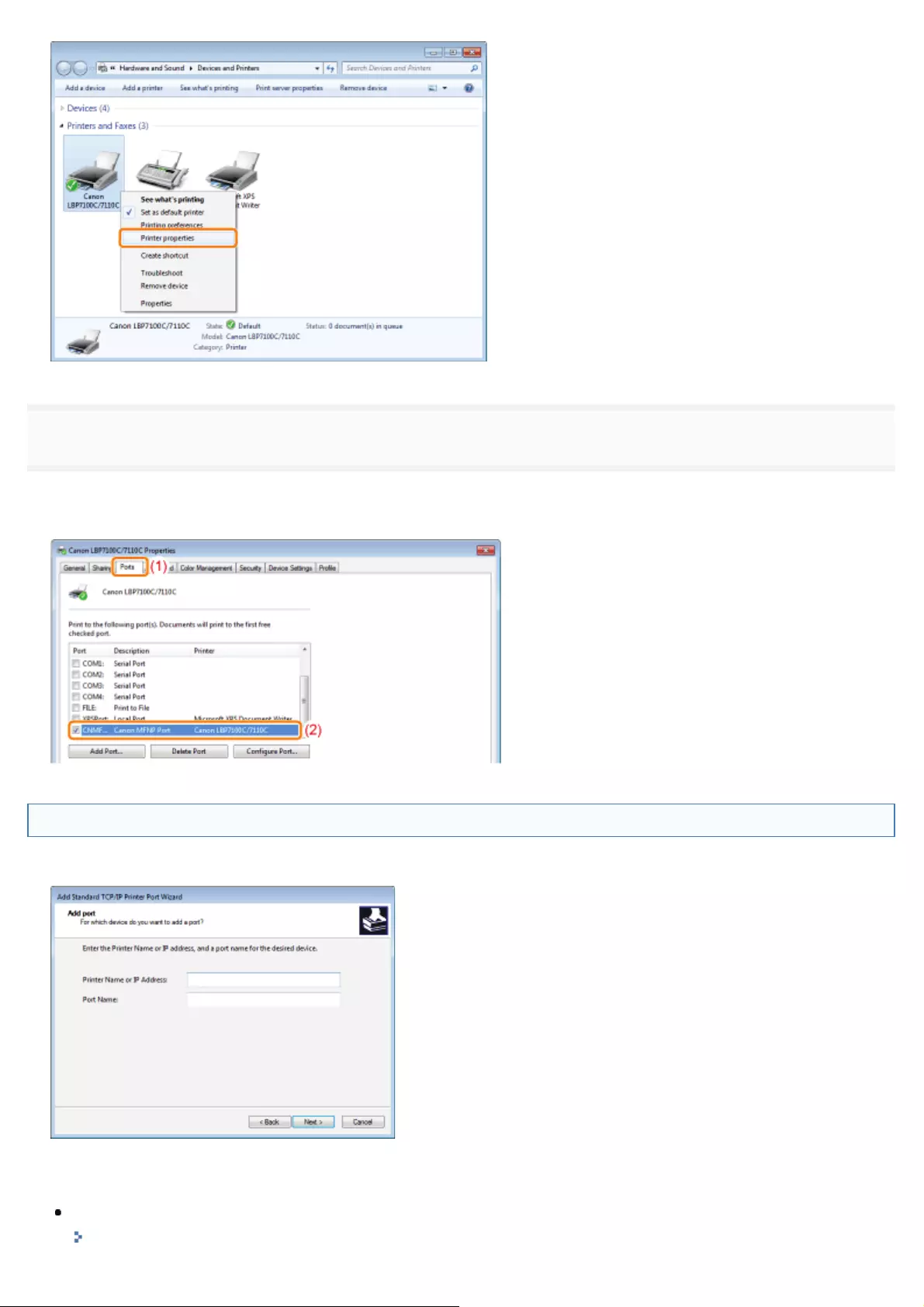
3
Check a port.
(1) Display the [Ports] sheet.
(2) Check the port that is being used.
Values for Setting a Port
Depending on the method for setting the IP address of the printer, the value to be entered in [Printer Name or IP Address]
on the following screen displayed in the process of port setting varies.
If you want to set the IP address to be assigned to the printer manually (If you know the IP address
to use)
Enter the IP address in [Printer Name or IP Address].
"Checking the IP Address of the Printer"
㻡㻝㻜㻌㻛㻌㻡㻝㻠
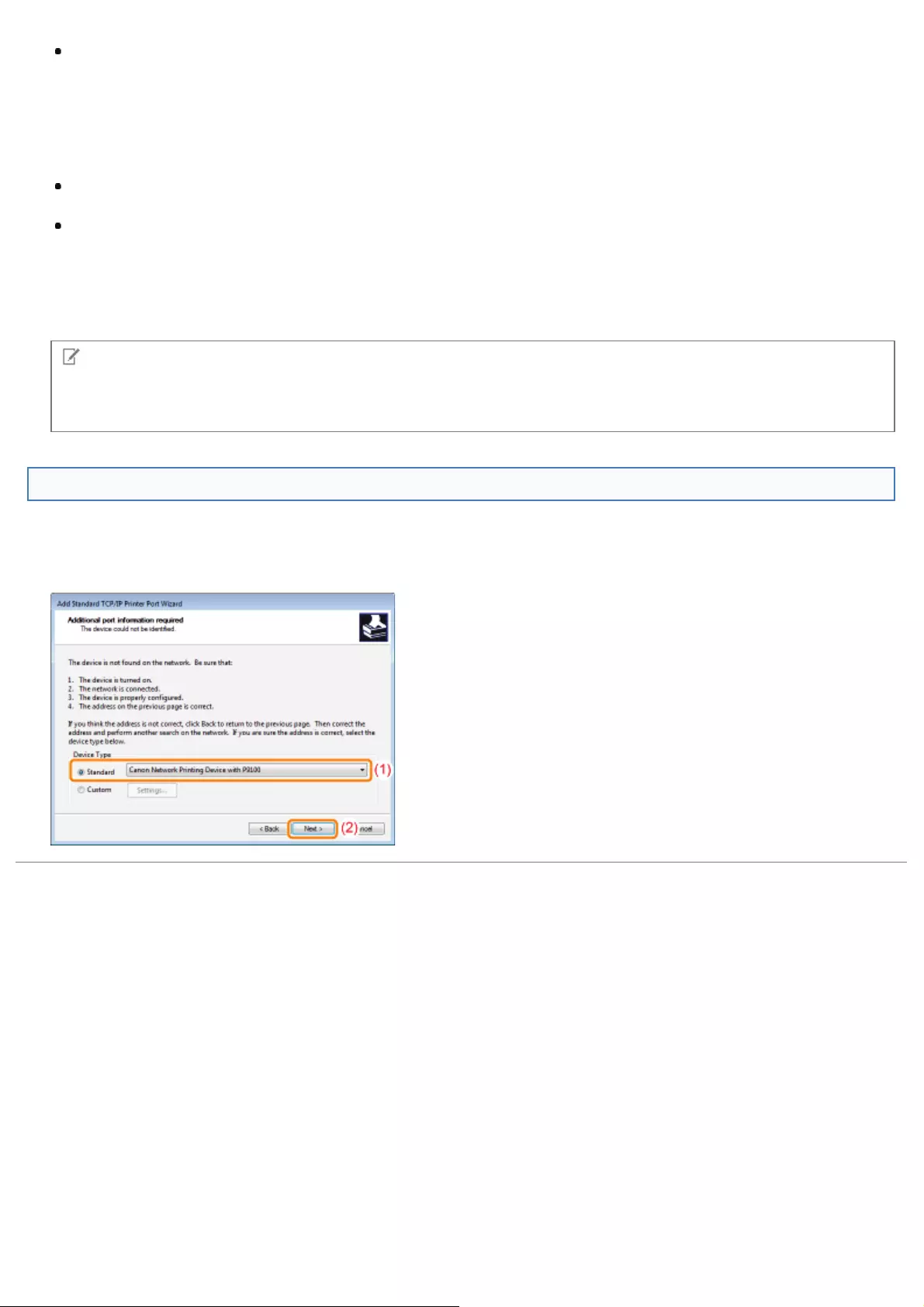
If you want to set the IP address using the DNS server, specify the DNS settings for the printer. Then, enter the printer
name (the DNS name registered on the DNS server) within up to 78 characters in [Printer Name or IP Address].
For example, enter the printer name as "AAA.BBB.com" if you specified the host name as "AAA" and the domain name
as "BBB.com". However, enter "AAA.CCC.com" if you can obtain the domain name (CCC.com) simultaneously when
you obtain the IP address from DHCP and so on.
If you want to set the IP address to be assigned to the printer using DHCP and so on
Specify the settings such as the DHCP settings so that the same IP address is always assigned to the printer when you
start the printer. For more details, see "If you want to set the IP address to be assigned to the printer manually" above.
If a different IP address is assigned to the printer each time the printer starts, specify the DNS settings for the printer
first. Then, enter the printer name (the DNS name registered on the DNS server) within up to 78 characters in [Printer
Name or IP Address].
For example, enter the printer name as "AAA.BBB.com" if you specified the host name as "AAA" and the domain name
as "BBB.com". However, enter "AAA.CCC.com" if you can obtain the domain name (CCC.com) simultaneously when
you obtain the IP address from DHCP and so on.
NOTE
About the DNS settings
See "Configuring the Protocol Settings."
Setting for [Device Type] when Setting a Port
If the printer cannot be detected when setting a port, set [Device Type] as follows.
(1) Select [Standard], and then select [Canon Network Printing Device with P9100].
(2) Click [Next].
㻡㻝㻝㻌㻛㻌㻡㻝㻠
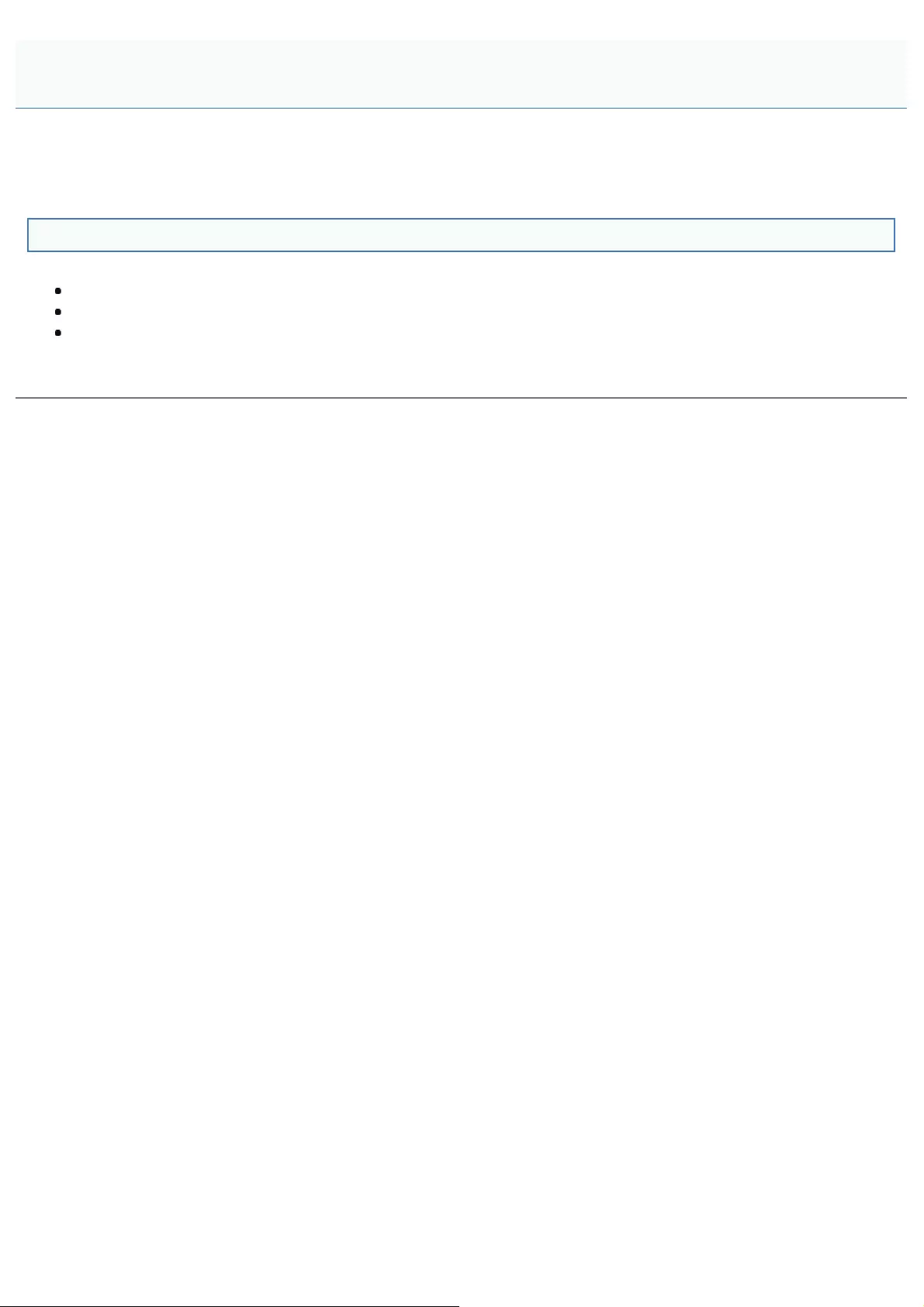
0F40-0A5
This printer supports Windows 8/Server 2012 operating system. For operation and description on Windows 8/Server 2012,
refer to Windows Vista/7 sections. This section describes notes on using this printer with Windows 8/Server 2012. Read
this section carefully before using the printer.
Precautions
Use the desktop mode when performing the followings.
Installing/Uninstalling the printer driver
Displaying the Printer Status Window
Setting the printer driver *
*Please note that the setting specified on the desktop may not be reflected to all Windows Store applications.
For Windows 8/Server 2012 Users
㻡㻝㻞㻌㻛㻌㻡㻝㻠
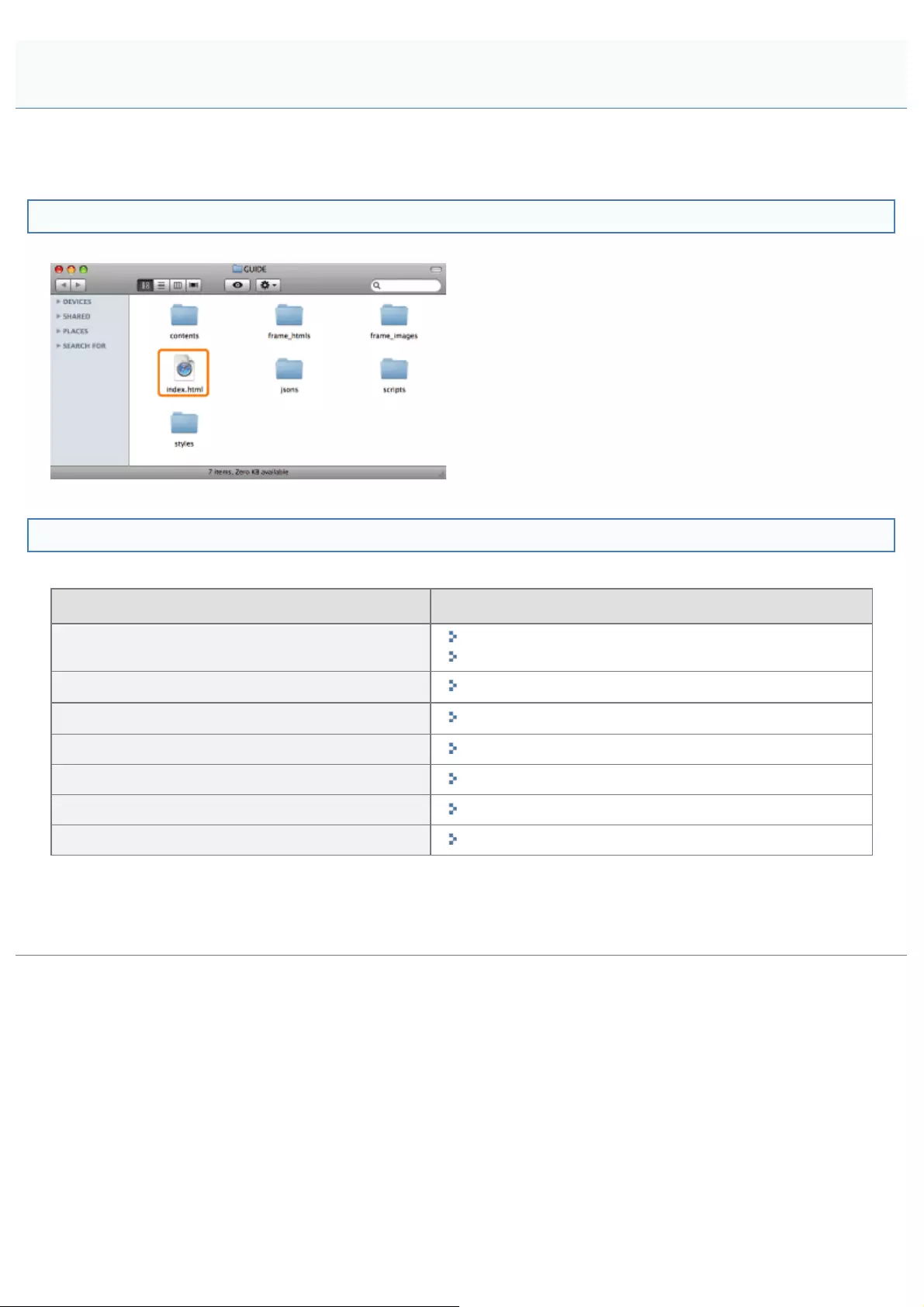
0F40-0A6
In the e-Manual, methods to operate in the Windows environment are explained as examples. To view how to use printer
drivers or utilities for Macintosh, see the "Printer Driver Guide for Macintosh."
Displaying the "Printer Driver Guide for Macintosh"
Double-click [index.html] in the [SFP] - [Documents] - [uk_eng] - [GUIDE] folder in the supplied CD-ROM.
Content of the e-Manual about Features that Are Unavailable on the Macintosh
Among the features explained in the e-Manual, the followings are unavailable on the Macintosh.
Contents Not Available for Macintosh Reference in the e-Manual
Installing and uninstalling the e-Manual "Installing the e-Manual"
"Uninstalling the e-Manual"
Printer Status Window*1 "Printer Status Window"
Parts of the print setting items*2 "Useful Printing Functions"
Changing the default values for printing preferences "Changing the Default Values for Printing Preferences"
Notifying the printer of the time "Configuring the Protocol Settings"
Operating in the print server environment "If You Use the Printer in the Print Server Environment"
Deleting the USB class driver "Uninstalling the USB Class Driver"
*1 If you are using Macintosh, use the Statusmonitor. (For details on the Statusmonitor, see the "Printer Driver Guide for
Macintosh.")
*2 For items that you can specify in the printer driver for Macintosh, see the "Printer Driver Guide for Macintosh" or Help.
For Macintosh Users
㻡㻝㻟㻌㻛㻌㻡㻝㻠

0F40-0A4
CANON INC.
30-2, Shimomaruko 3-chome, Ohta-ku, Tokyo 146-8501, Japan
CANON MARKETING JAPAN INC.
16-6, Konan 2-chome, Minato-ku, Tokyo 108-8011, Japan
CANON U.S.A., INC.
One Canon Park, Melville, NY 11747, U.S.A.
CANON EUROPA N.V.
Bovenkerkerweg 59, 1185 XB Amstelveen, The Netherlands
CANON CHINA CO. LTD.
15F Jinbao Building No.89, Jinbao Street, Dongcheng District, Beijing 100005, PRC
CANON SINGAPORE PTE LTD
1 HarbourFront Avenue, #04-01 Keppel Bay Tower, Singapore 098632
CANON AUSTRALIA PTY LTD
1 Thomas Holt Drive, North Ryde, Sydney NSW 2113, Australia
CANON GLOBAL WORLDWIDE SITES
http://www.canon.com/
Office Locations
㻡㻝㻠㻌㻛㻌㻡㻝㻠


































